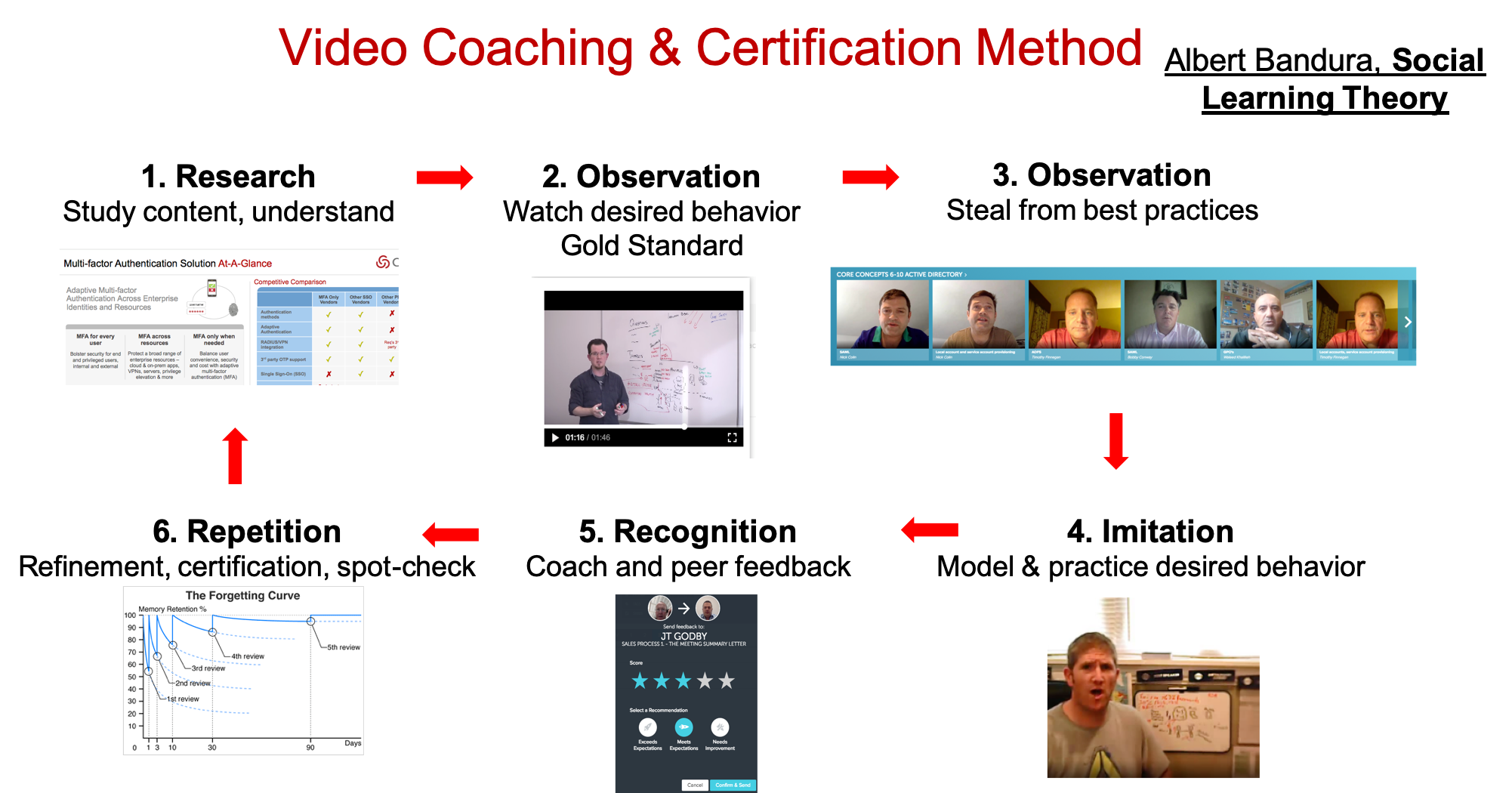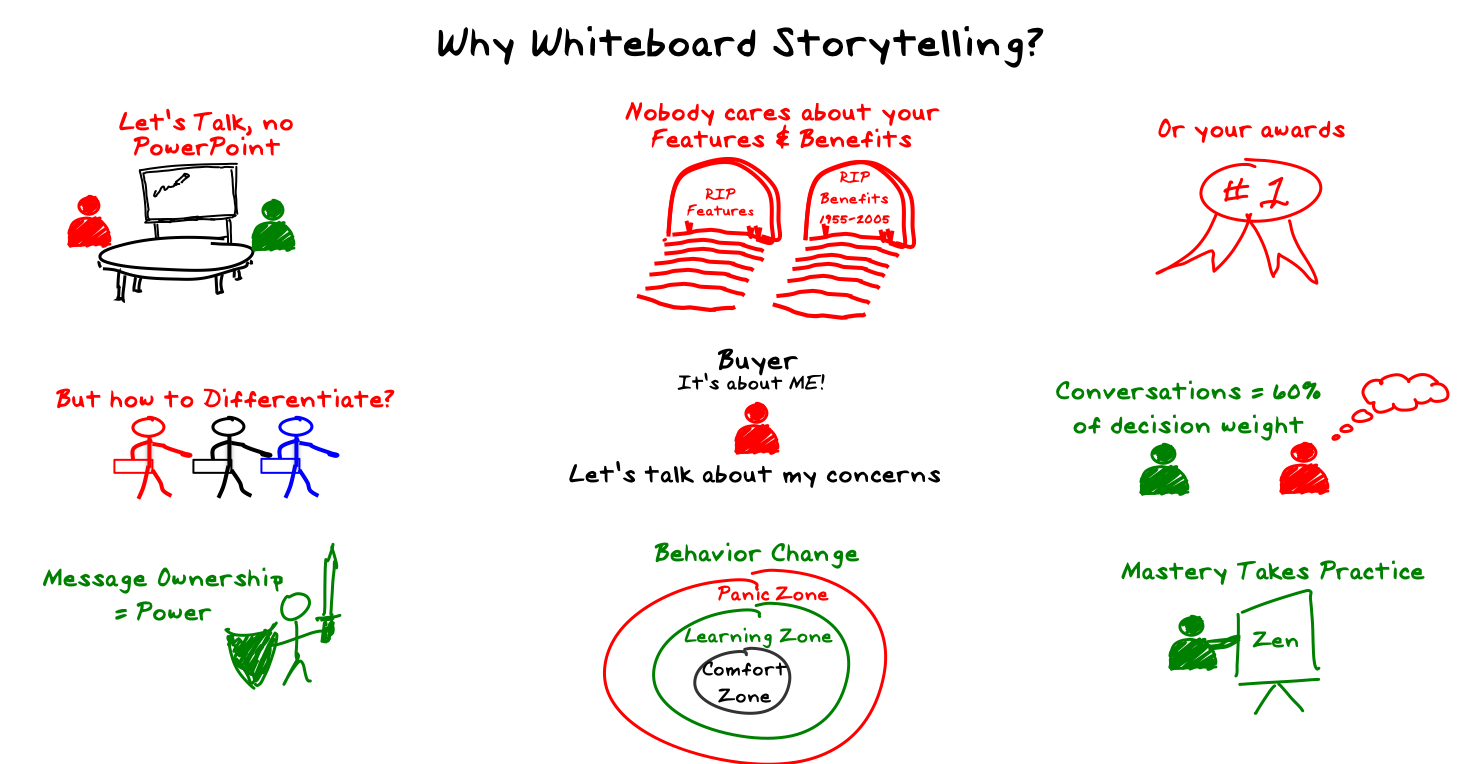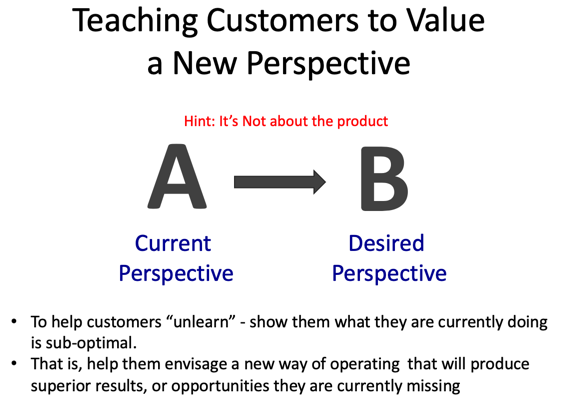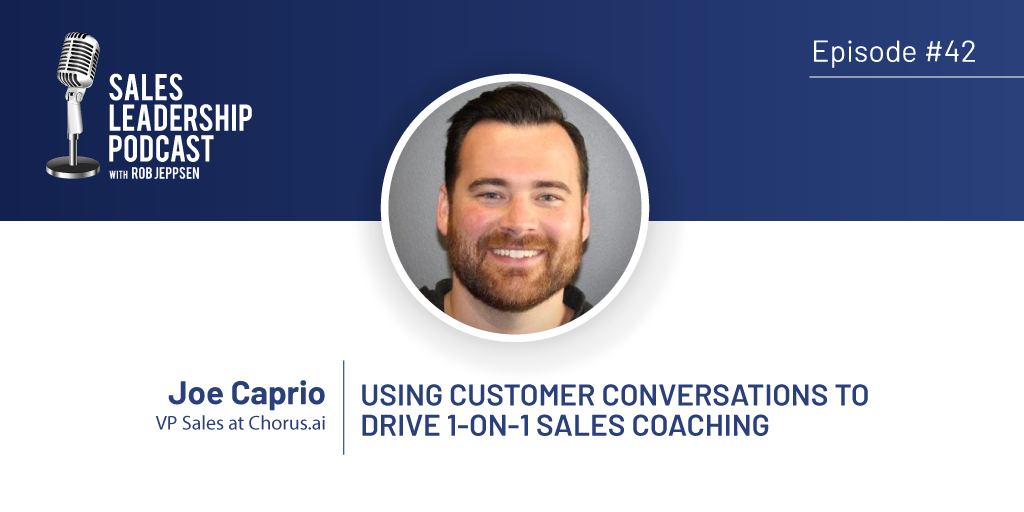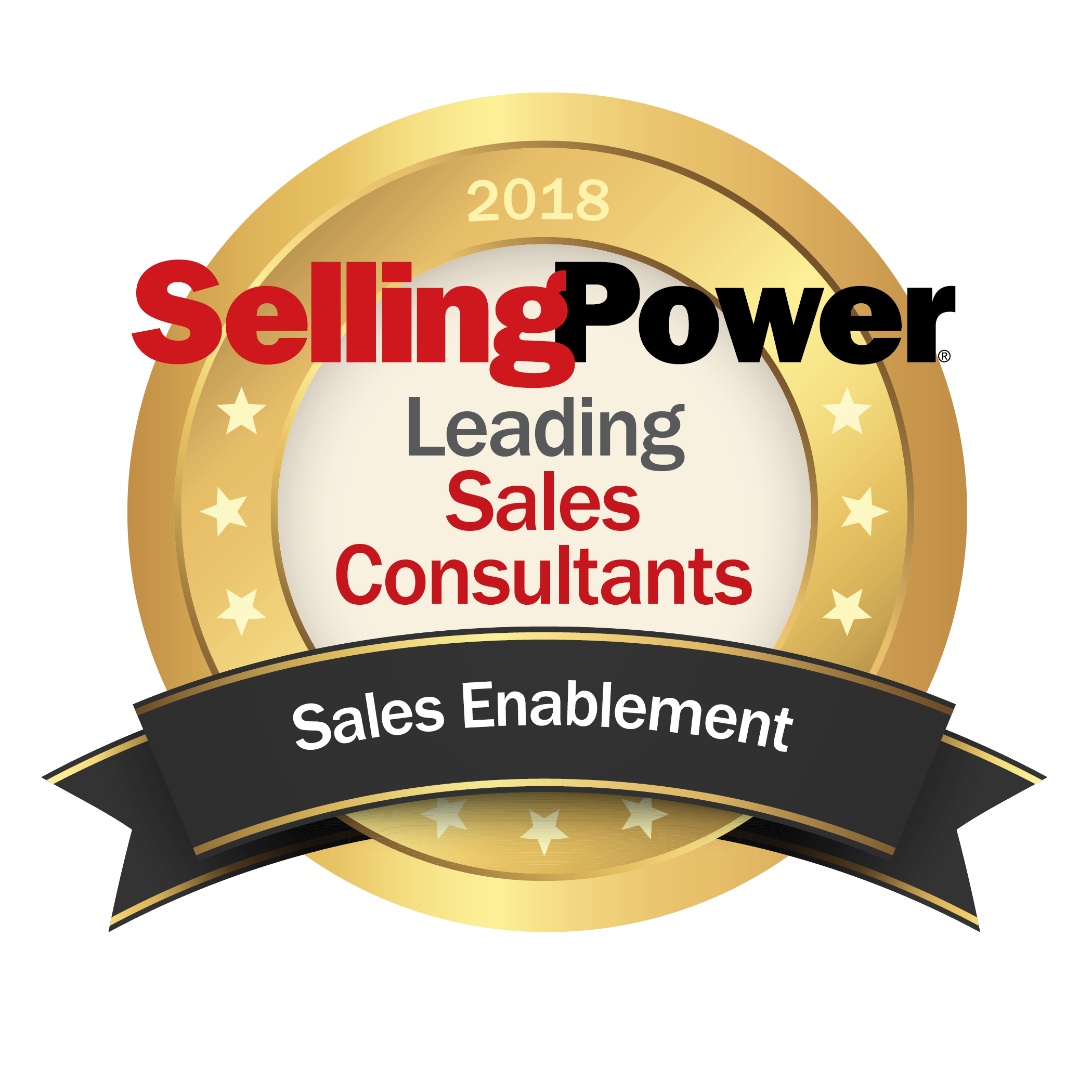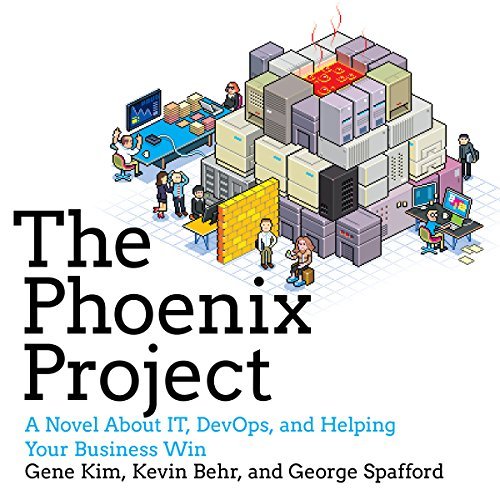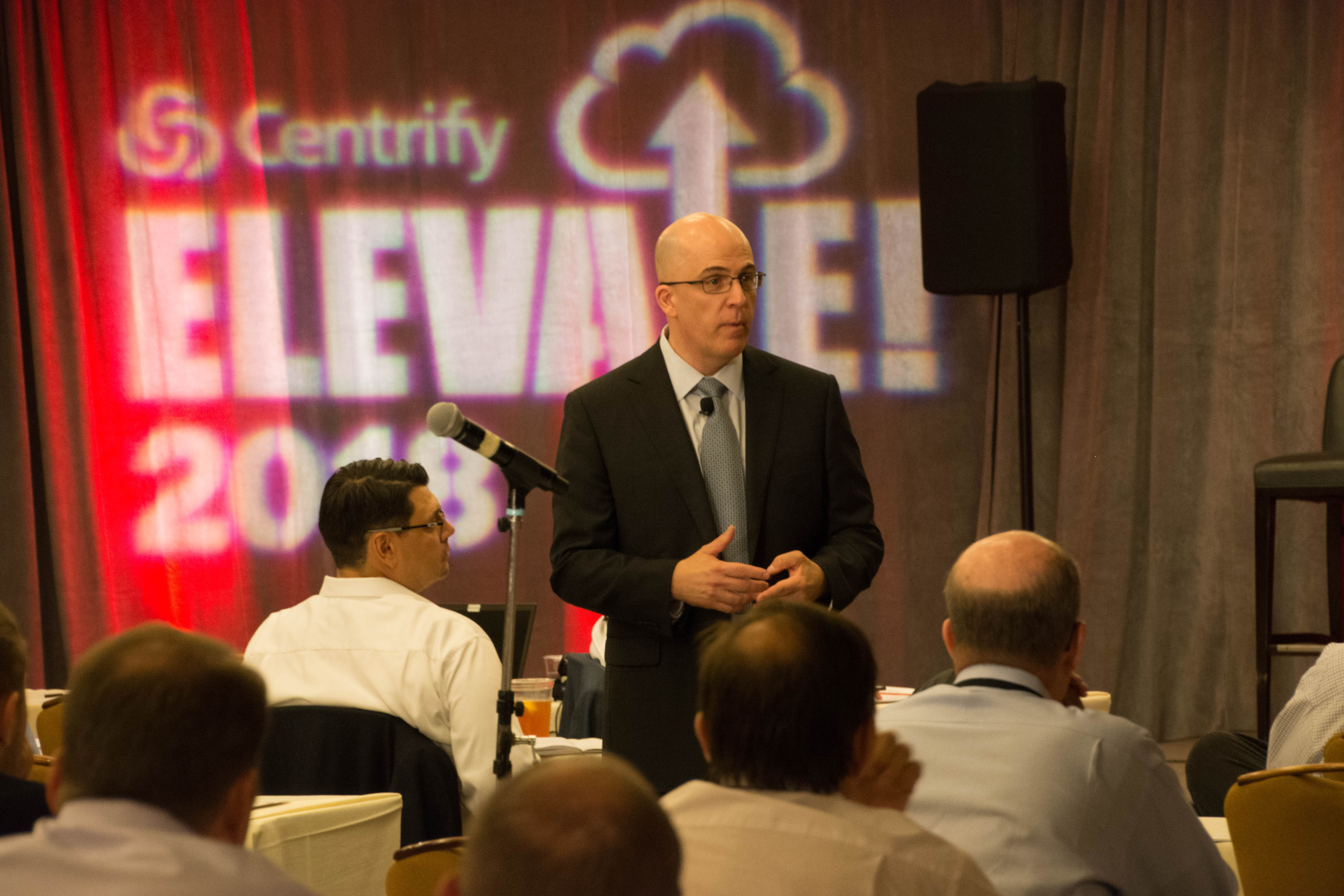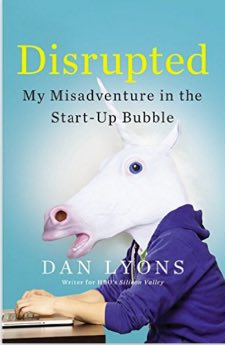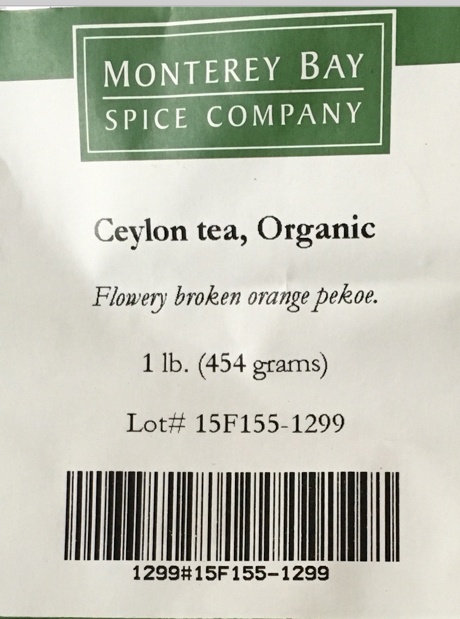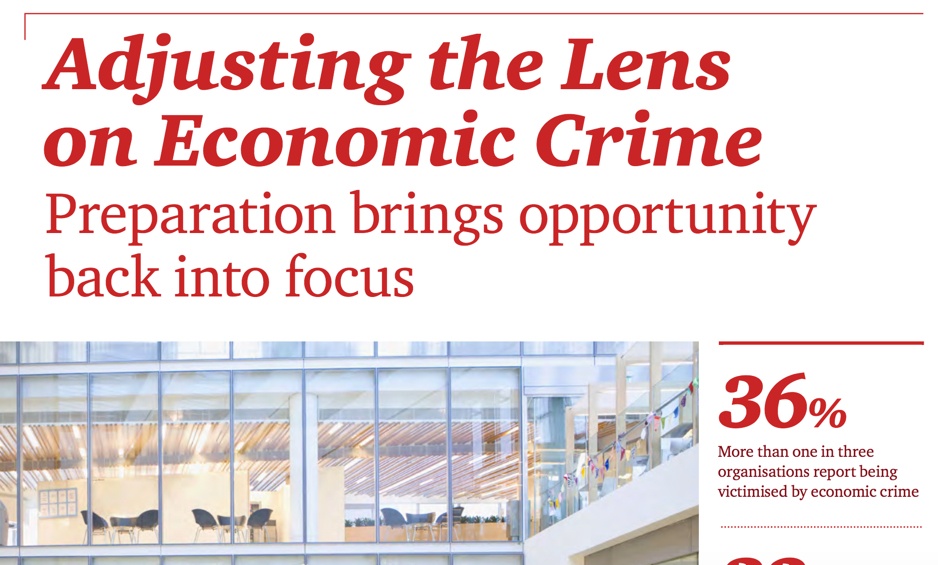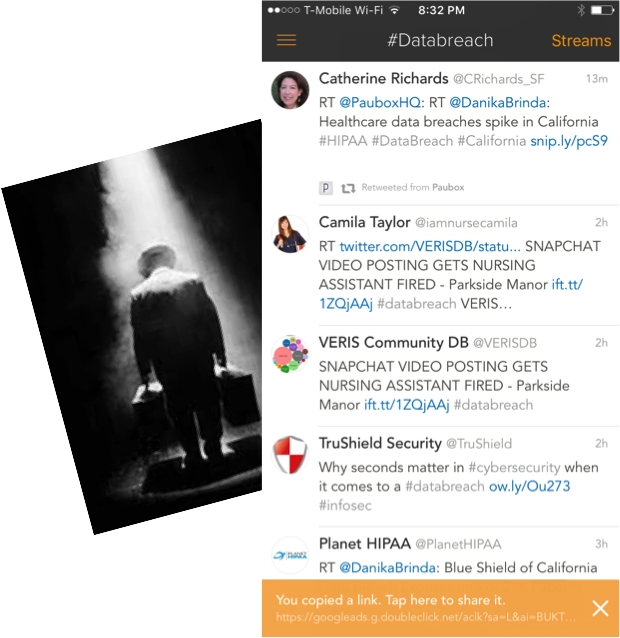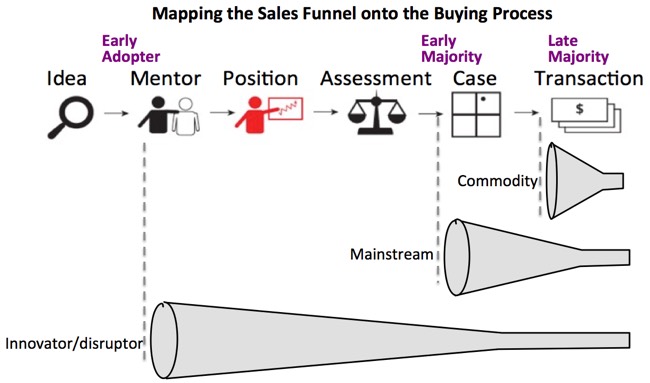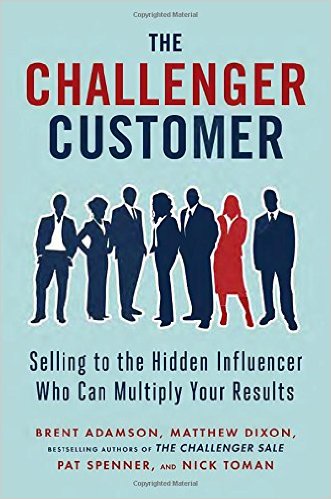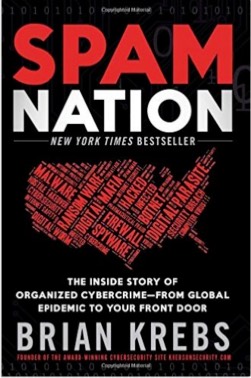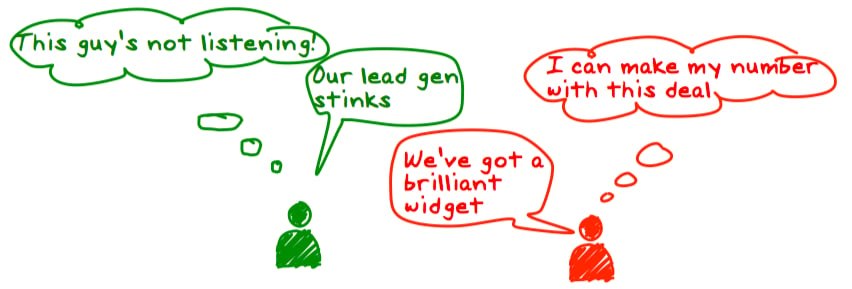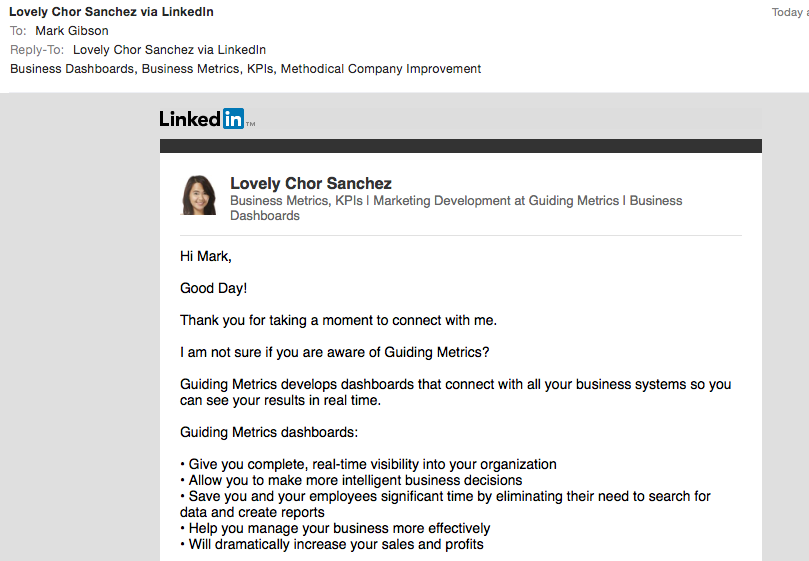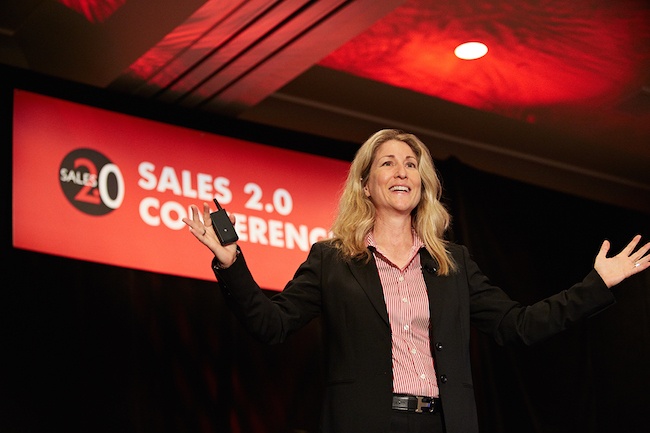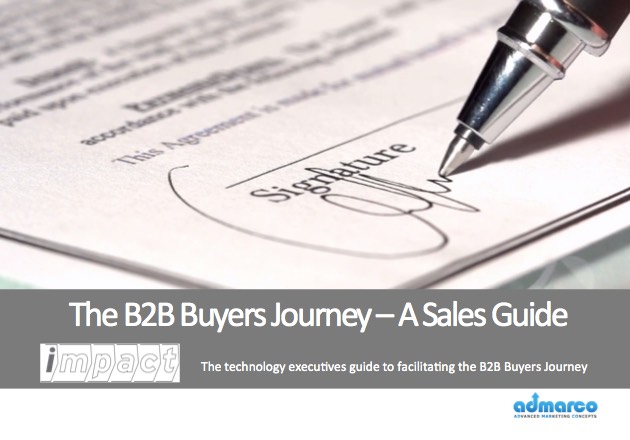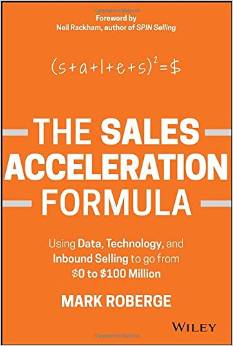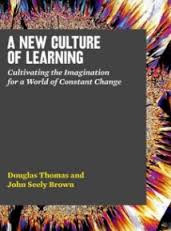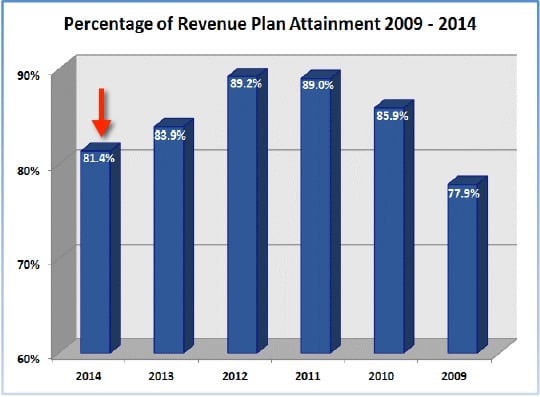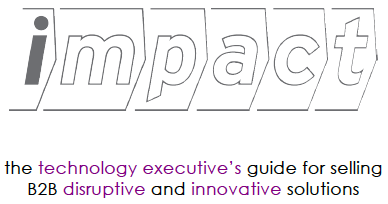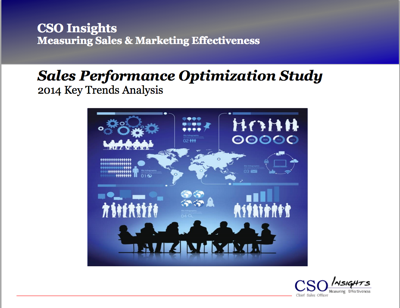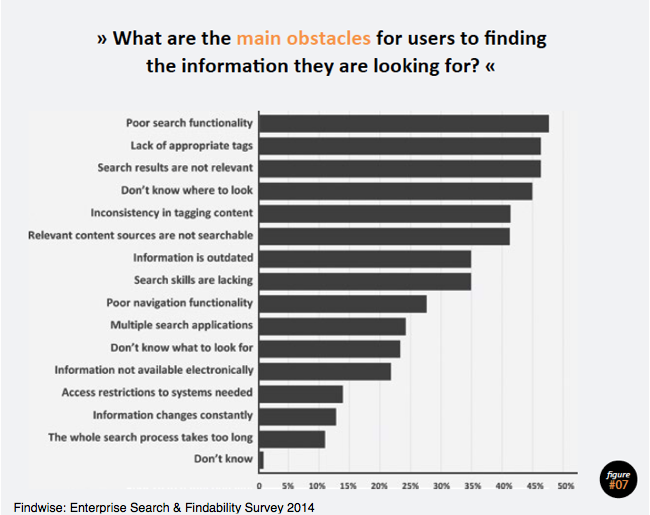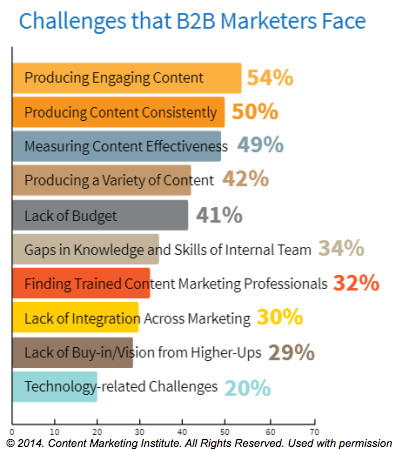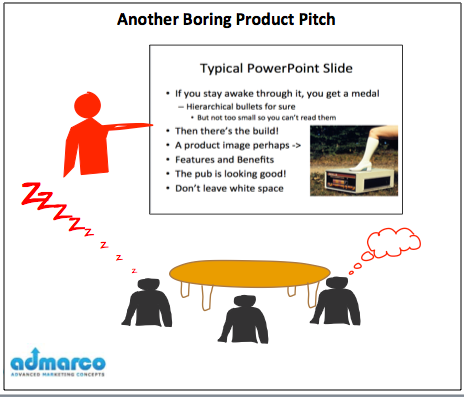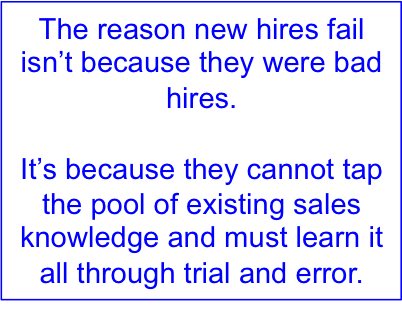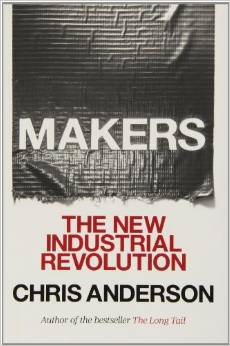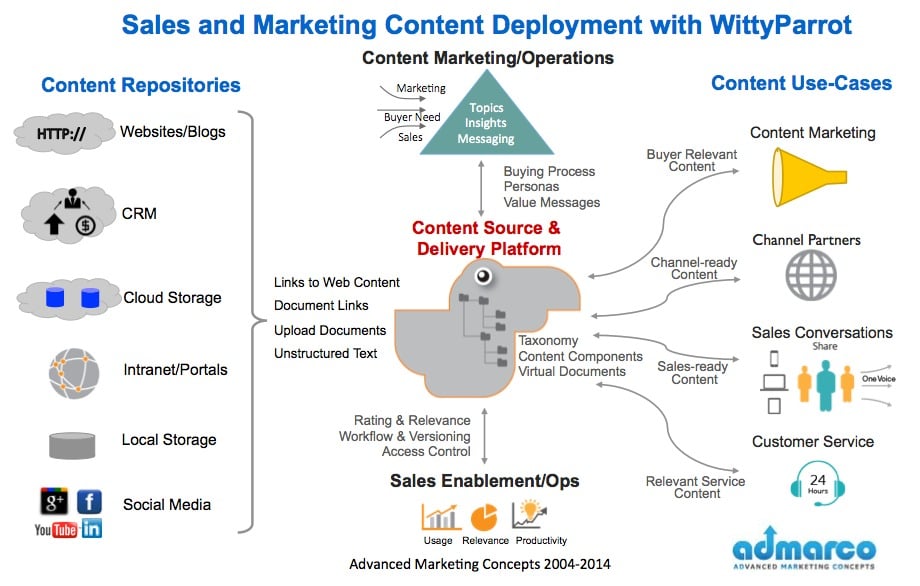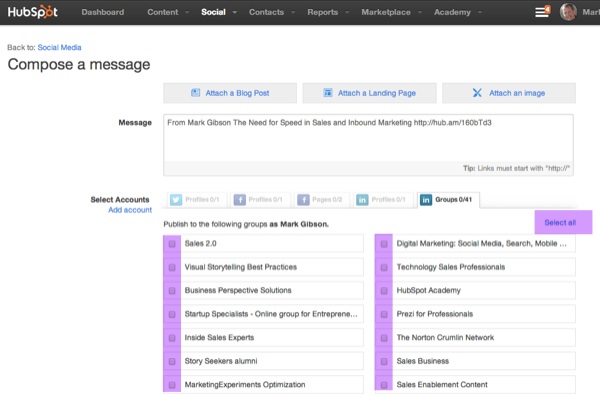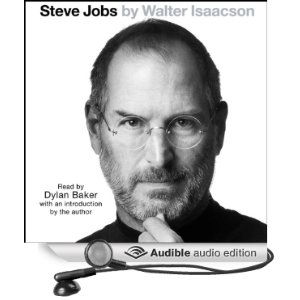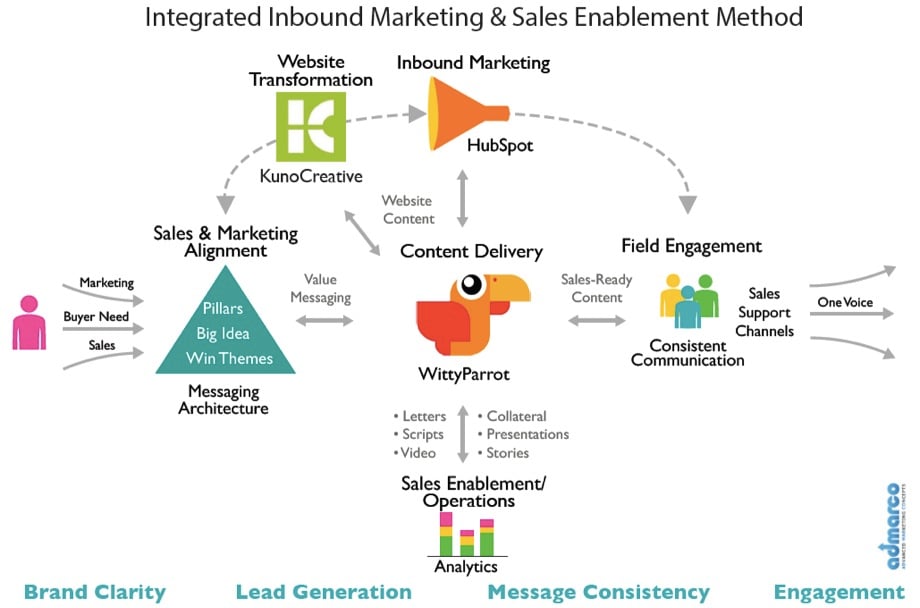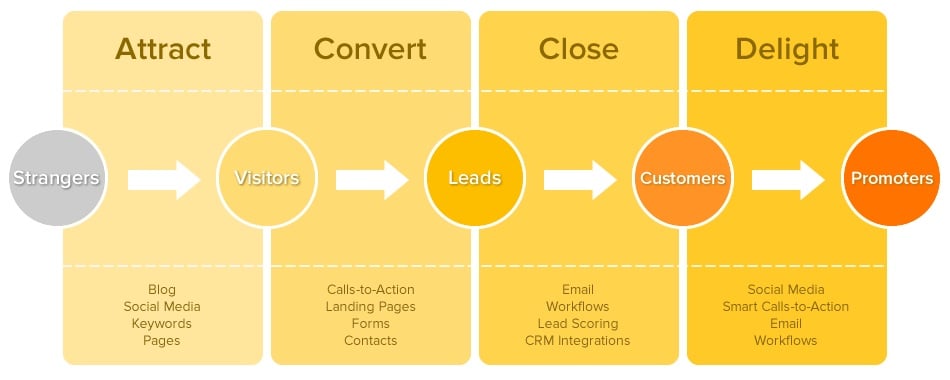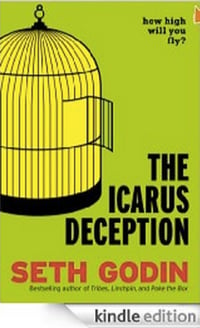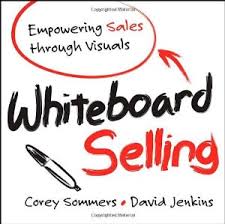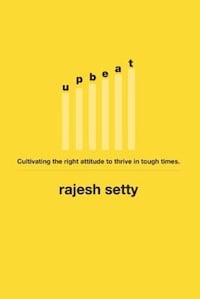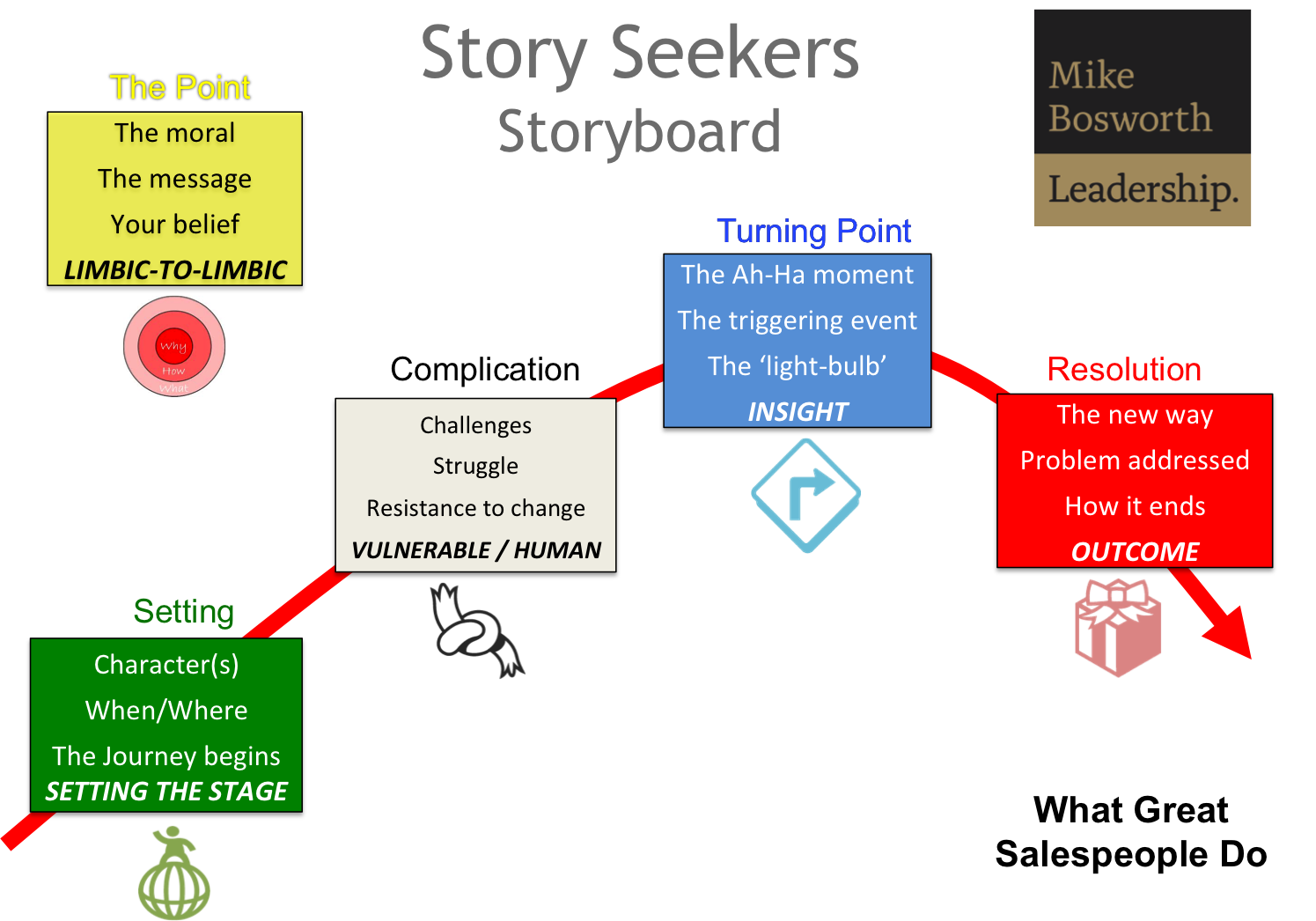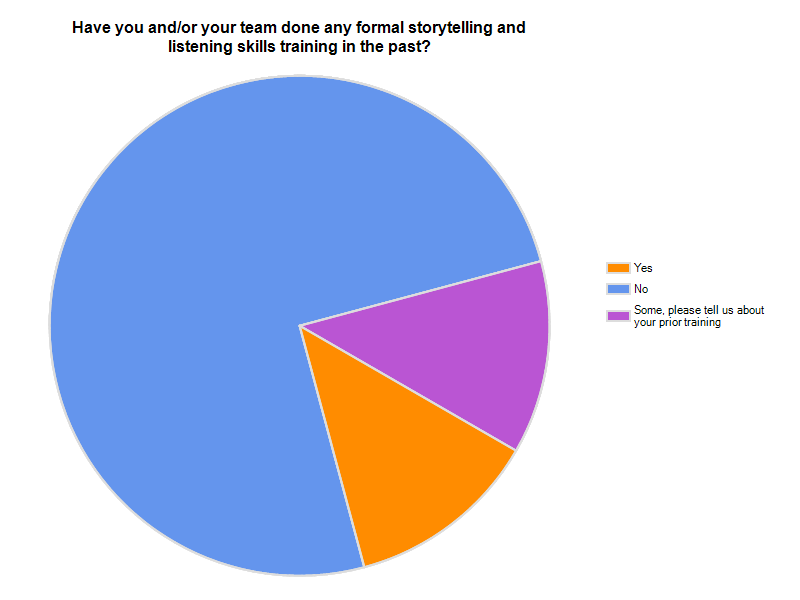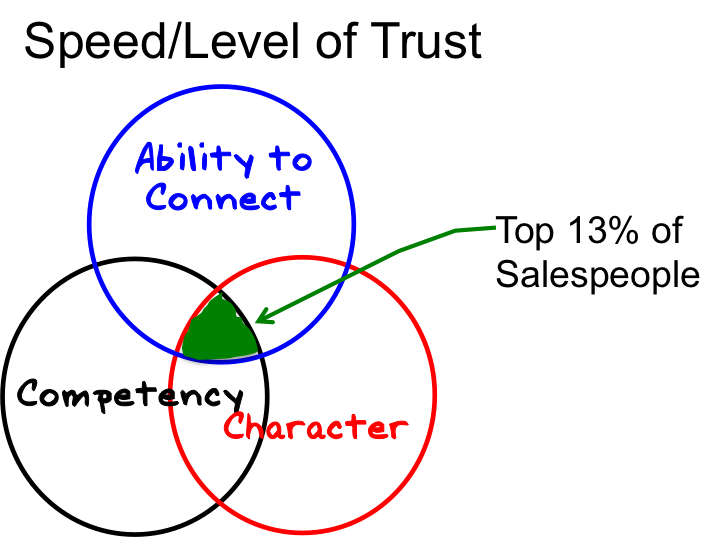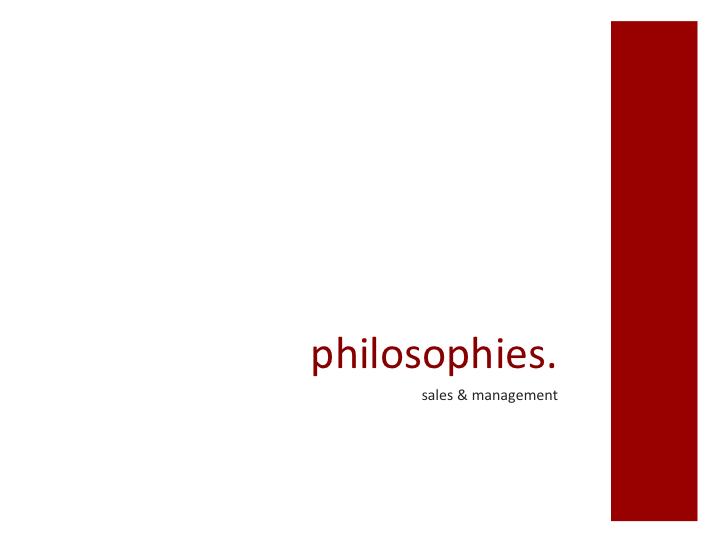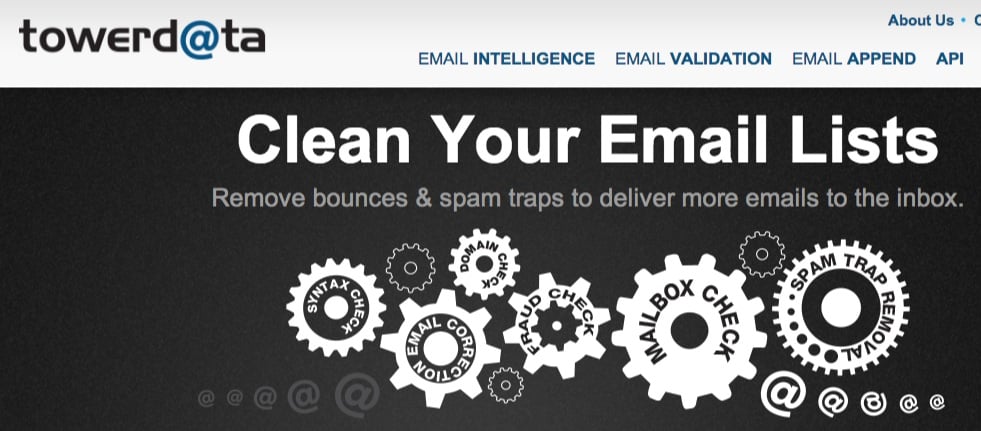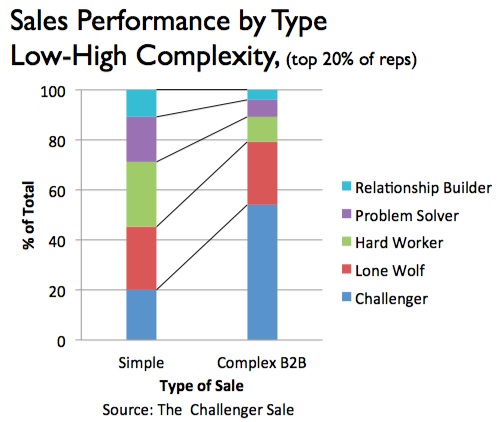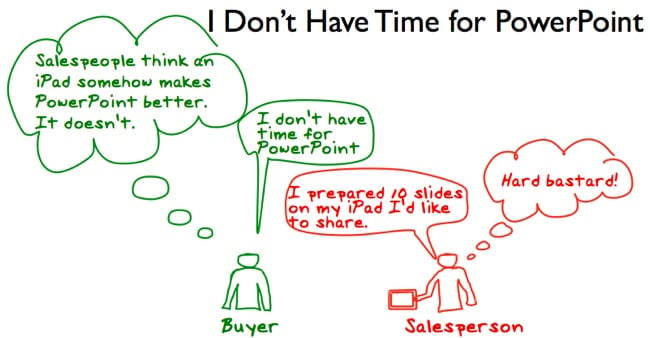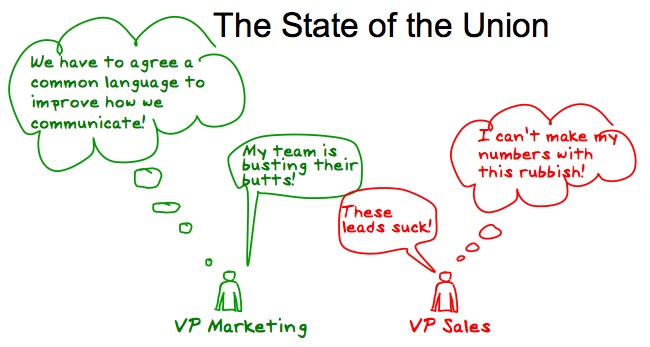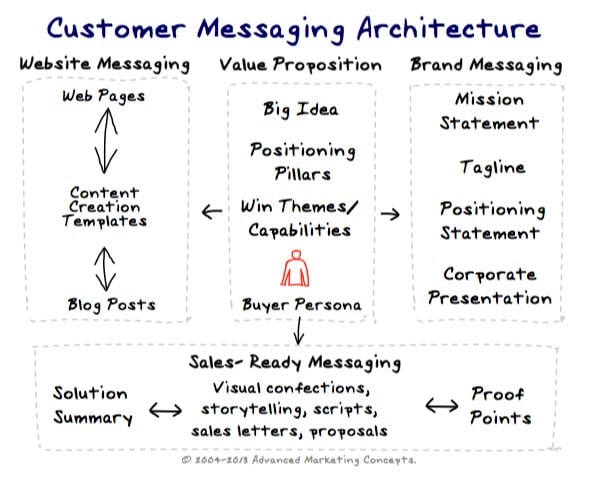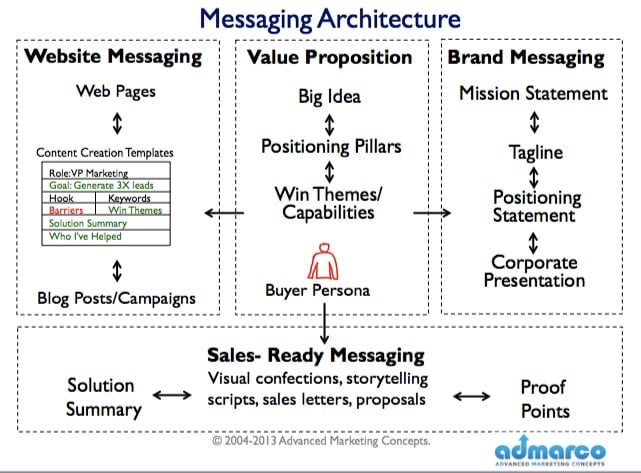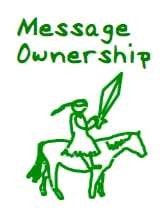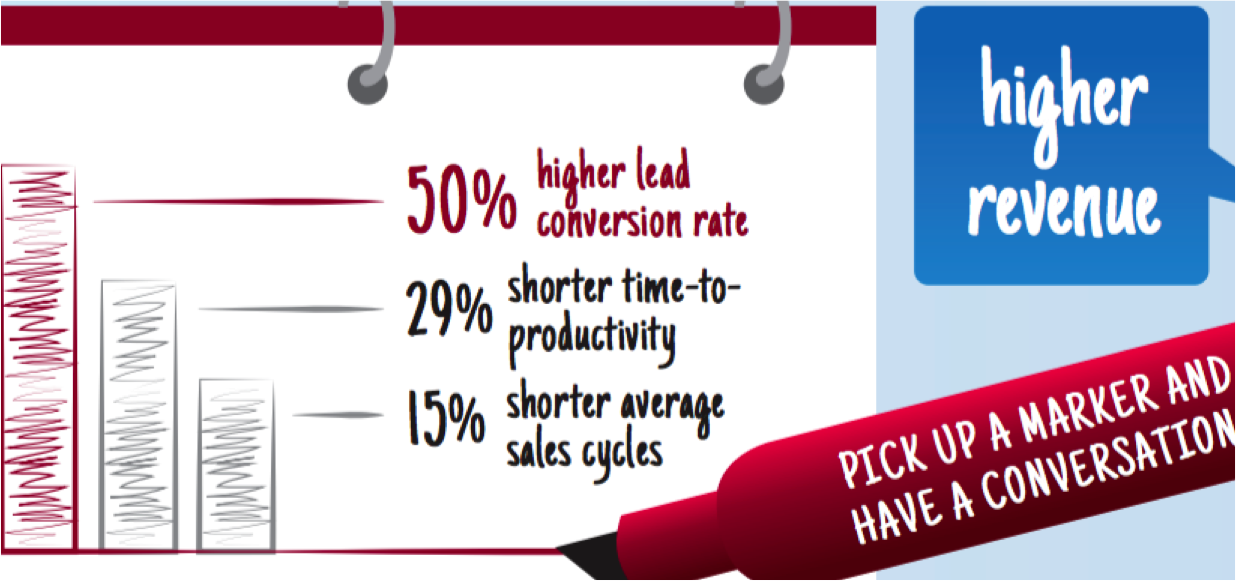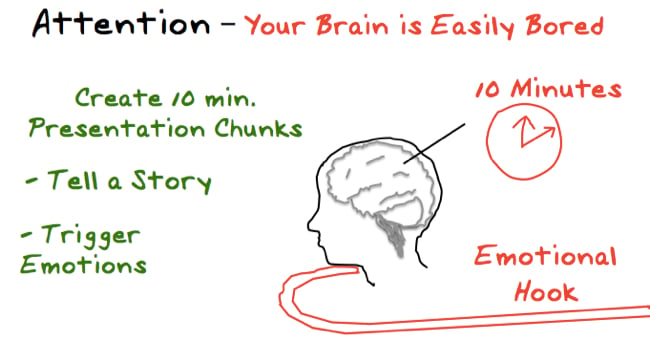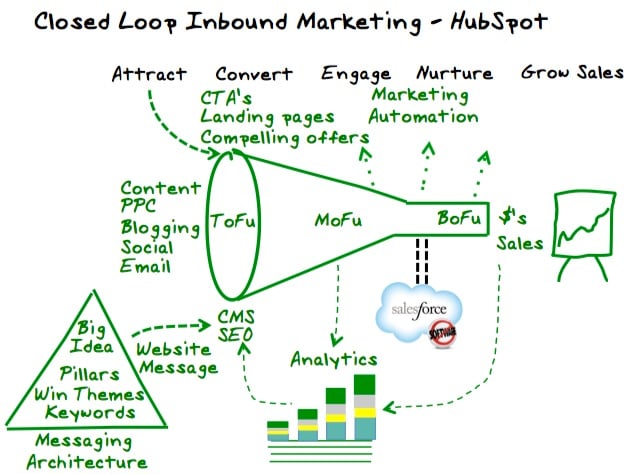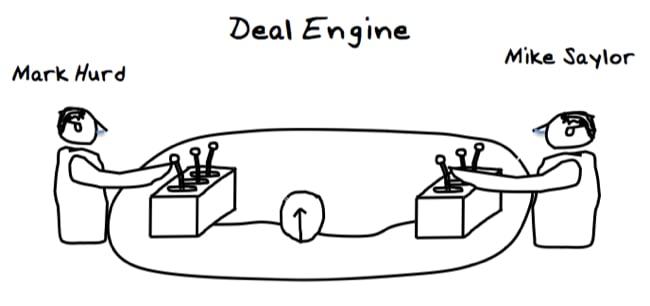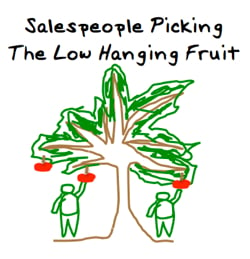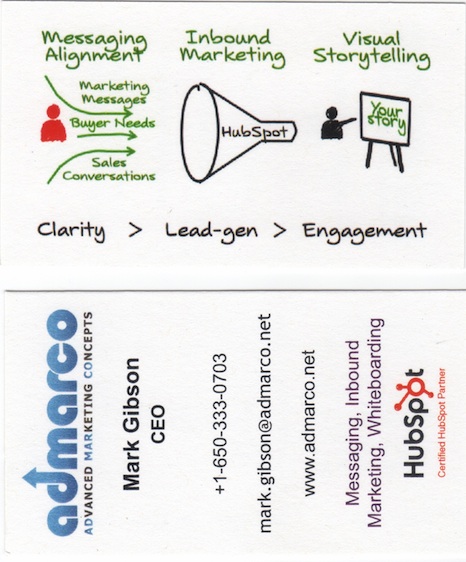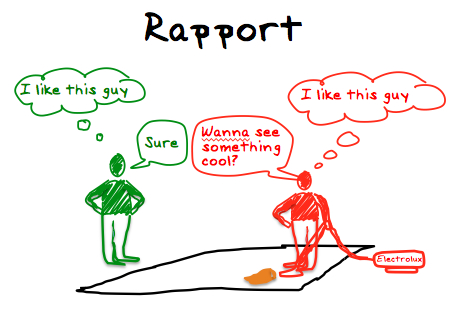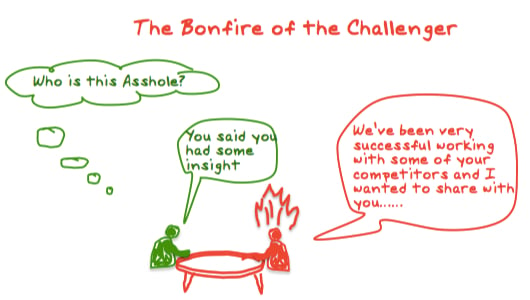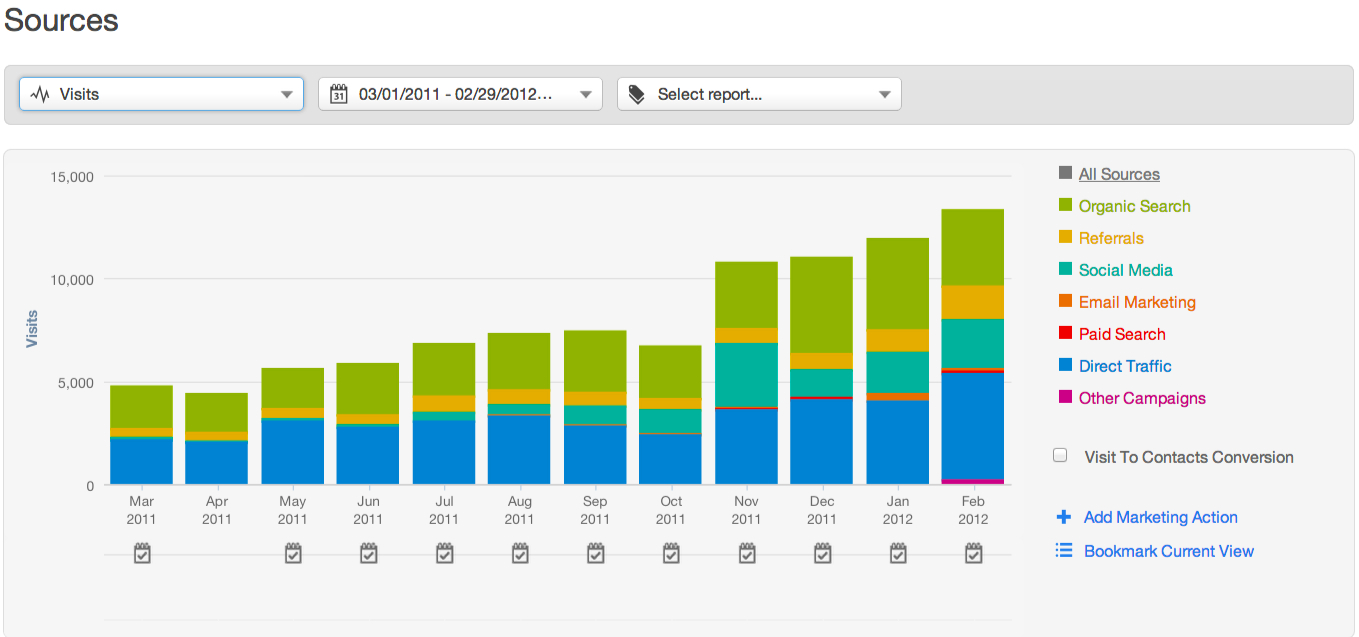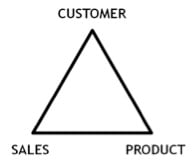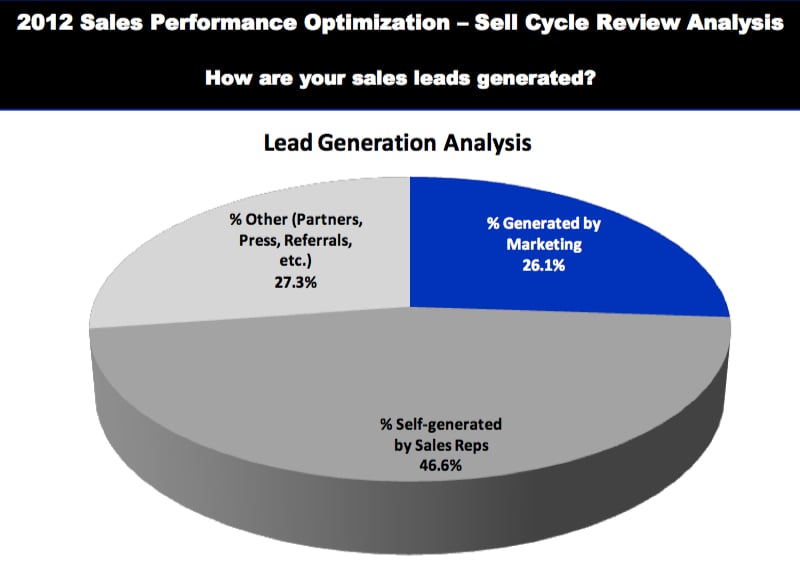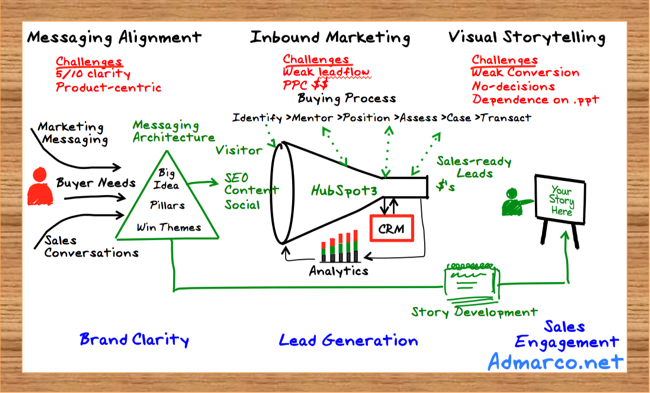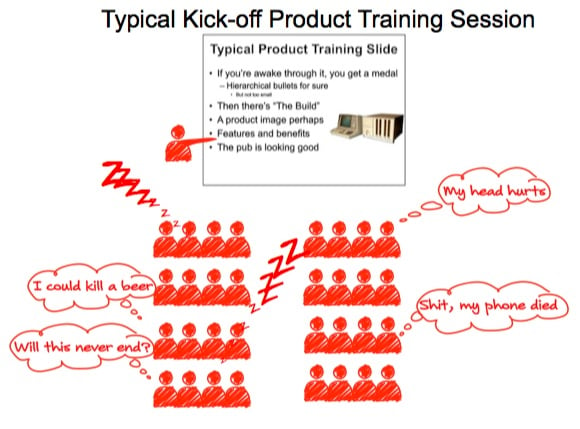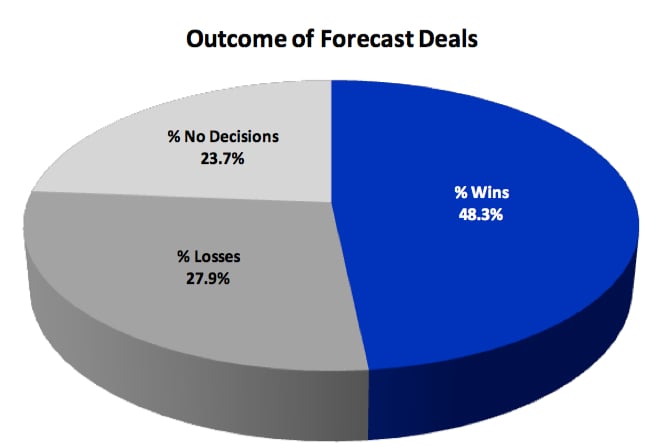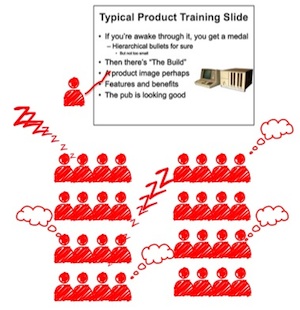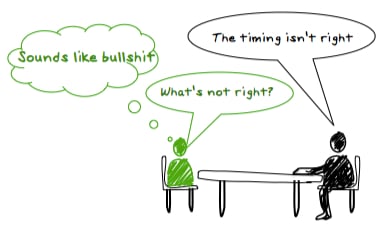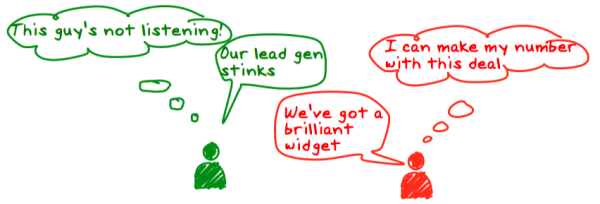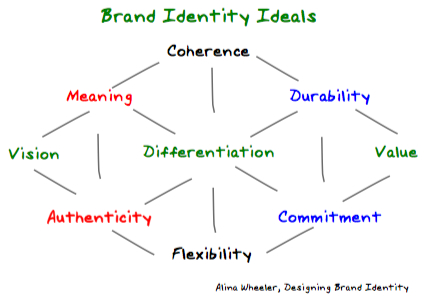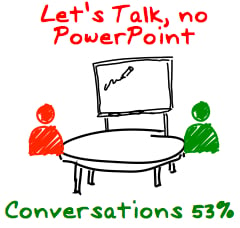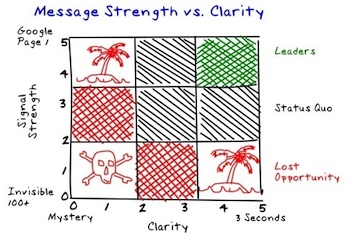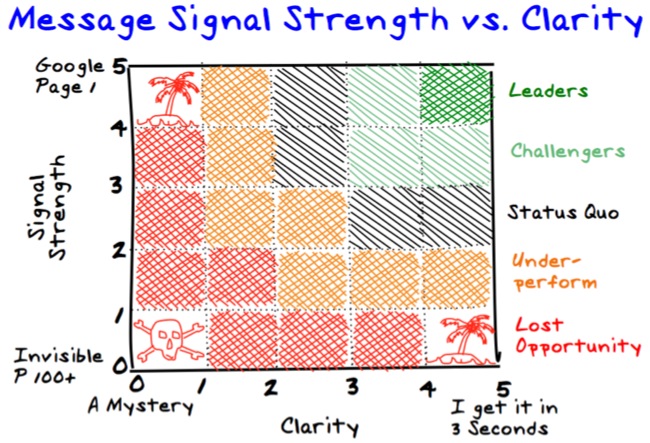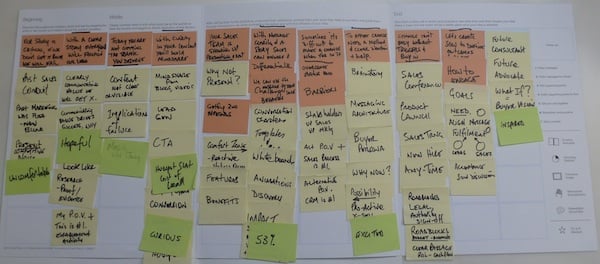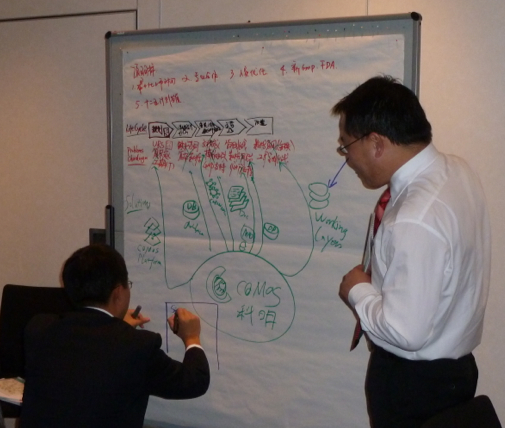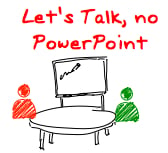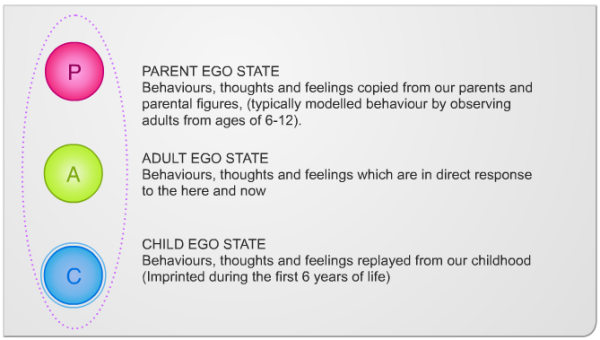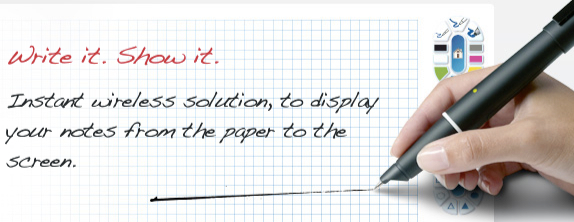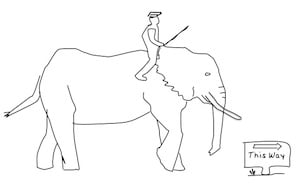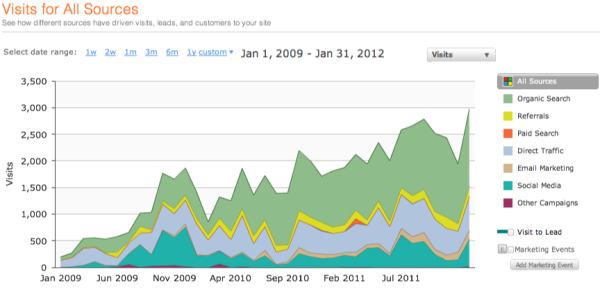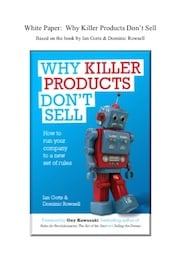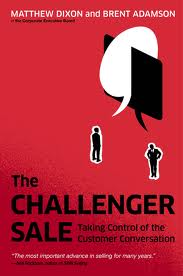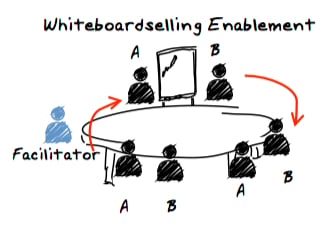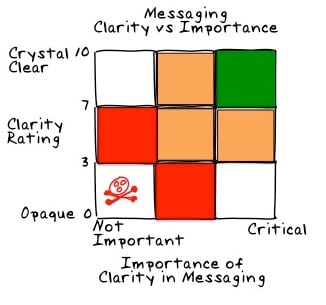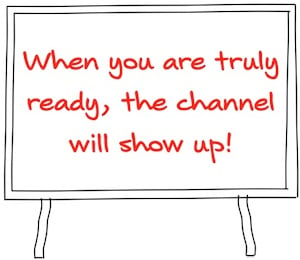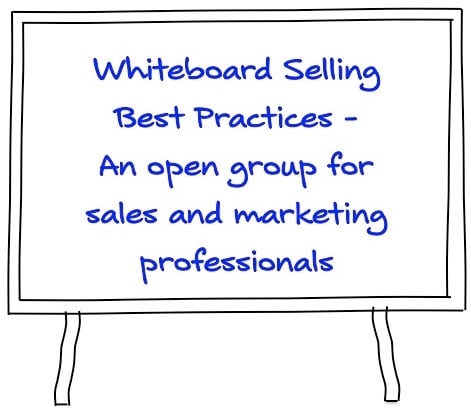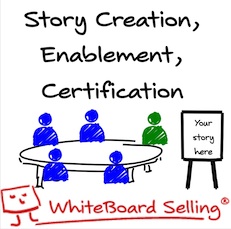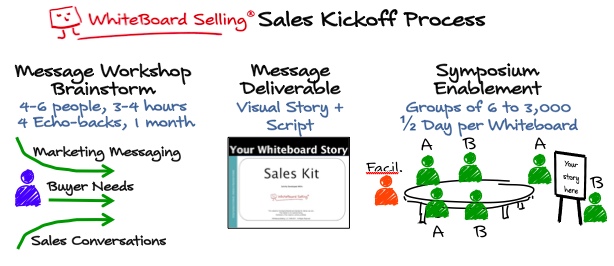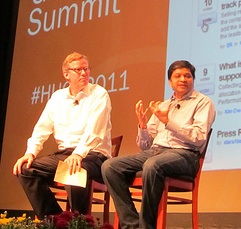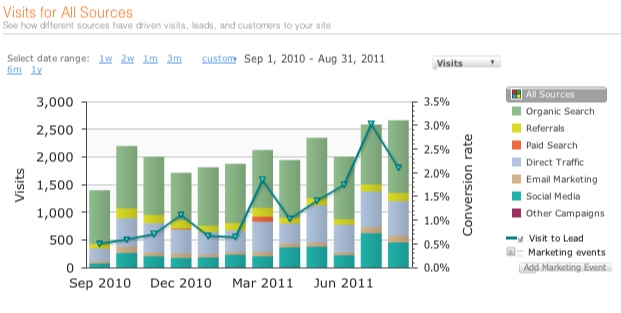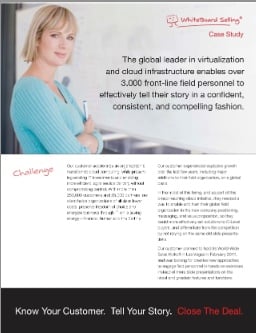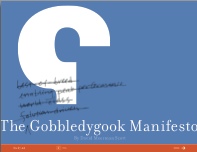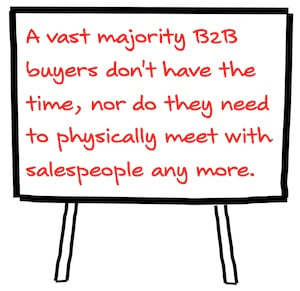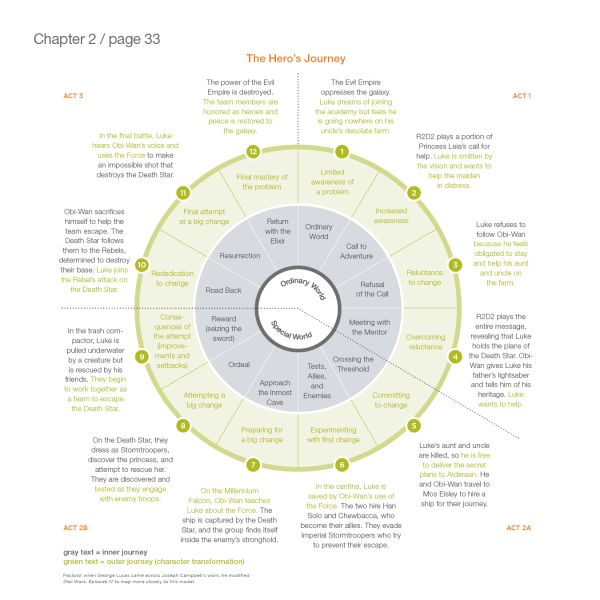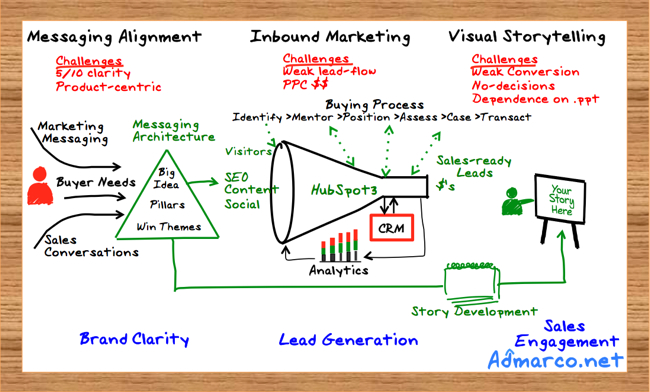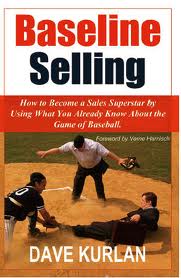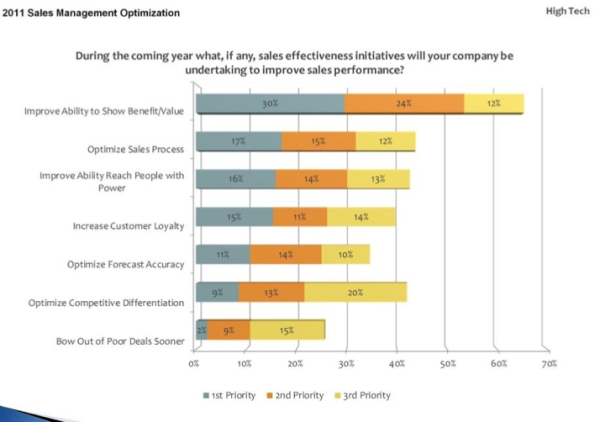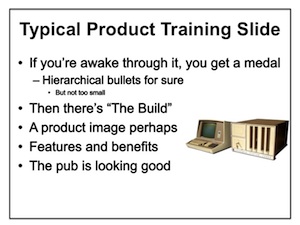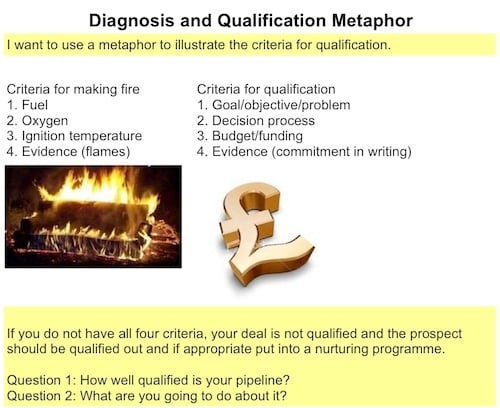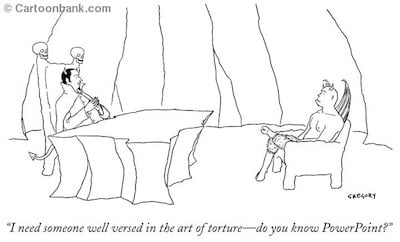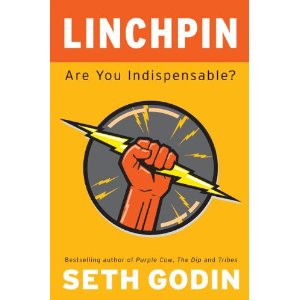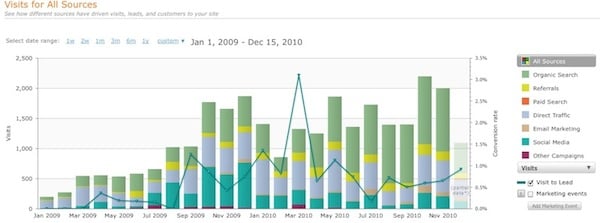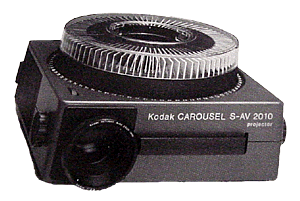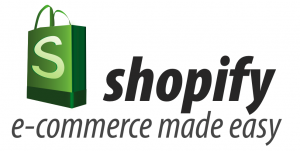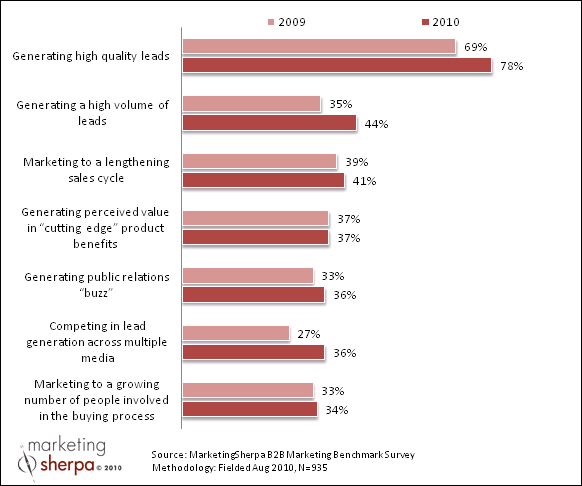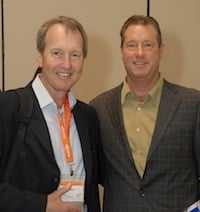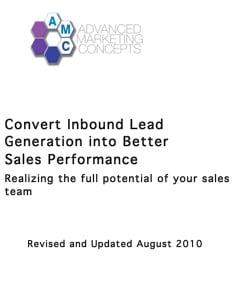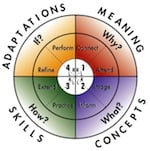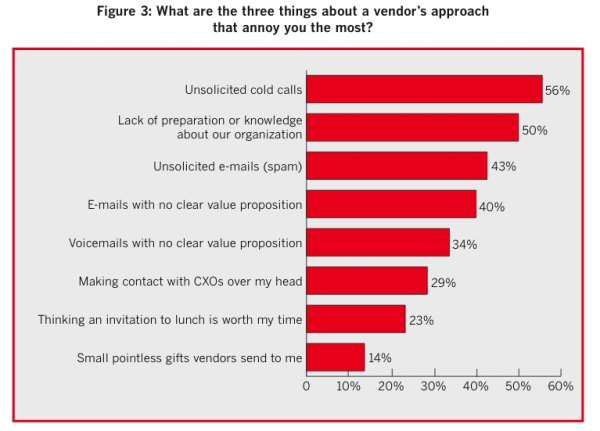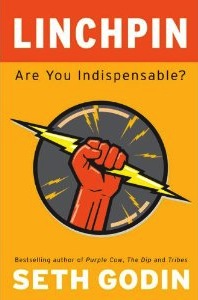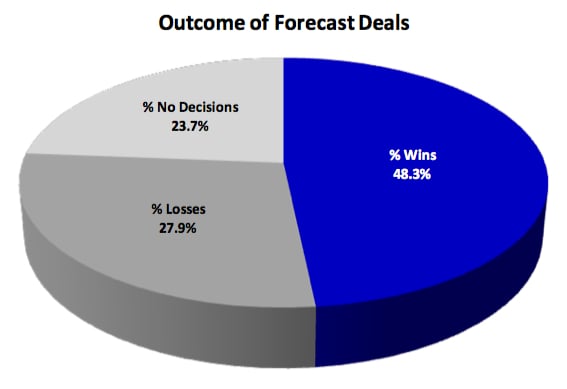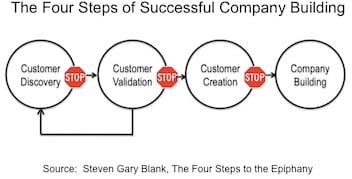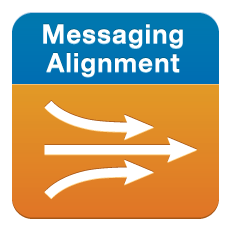In my previous post, How Much Does a Whiteboard Story Cost to Create?, I discussed the cost elements associated with developing various types of whiteboard story.
7 min read
What is the most Effective Whiteboard Storytelling Training Method?
By Mark Gibson on Thu, Oct 10, 2019
Topics: whiteboard storytelling virtual training
8 min read
Whiteboard Storytelling vs. PowerPoint - a Comparison
By Mark Gibson on Tue, Oct 01, 2019
Microsoft PowerPoint has been installed a billion times on Mac and Windows systems since launching in 1990. With an estimated 95% market share of the presentation market and more than 500 million users, Microsoft PowerPoint is a behemoth in the market and their collective competitors, mere minnows.
Topics: storytelling powerpoint whiteboard storytelling baseline selling
4 min read
How Much Does a Whiteboard Story Cost to Create?
By Mark Gibson on Mon, Sep 30, 2019
People ask me this question when they are curious about creating whiteboards, and the truth is that it depends on your purpose and desired outcome. In this article, I discuss whiteboard types and their purpose and a process for creating a whiteboard story.
Topics: consultative selling challenger selling storytelling whiteboard storytelling commercial insight
8 min read
2019 Verizon DBIR- Lessons Not Learned
By Mark Gibson on Thu, Sep 26, 2019
Verizon's Data Breach Investigation Report turns 12 this year. This year’s report contains data from more than 41,686 security incidents, of which more than 2,000 confirmed breaches submitted by 73 data sources spanning 86 countries and analyzed by Verizon security experts.
Topics: #cybersecurity verizon DBIR
3 min read
Getting into High-growth Mode - Sales Leadership Podcast #42 notes
By Mark Gibson on Sat, Apr 20, 2019
Just listened to Rob Jeppsen's Sales Leadership Podcast episode #42, with Joe Caprio of Chorus.ai. This was excellent and I took notes which I'm happy to share below.
Topics: call recording Rob Jeppsen sales coaching chorus.ai
2 min read
Mark Gibson Recognized as Sales Enablement Leader
By Mark Gibson on Wed, Dec 12, 2018
FREDERICKSBURG, VA. (PRWEB) DECEMBER 05, 2018
Topics: consultative selling process b2b buying process messaging methodology
1 min read
The Phoenix Project - A book about IT, Dev-ops and Helping your Business Win - review
By Mark Gibson on Tue, Nov 14, 2017
"A must read for IT salespeople"
Millions of salespeople sell into IT around the world, but few of them actually understand what it's like to be on the other side of the table. This book changes that.
Topics: #agile #dev-ops
6 min read
The Lost Art of Closing - A Modern Sales Classic
By Mark Gibson on Wed, Nov 01, 2017
This post is a review of Anthony's excellent second book, The Lost Art of Closing.
Topics: consultative selling anthony iannarino the lost art
1 min read
Disrupted - Misadventures in the Startup Bubble
By Robin Russell on Thu, Apr 14, 2016
What could be better to drive book sales than a super successful tech company not so secretly trying to squelch your muckraking, hilarious and soon to be published book.
Answer, nothing; and all the more fodder for the amusement and delight of supporters on both sides. Disrupted has already hit the NY Times top 5 best seller list on its first week.
Topics: startups
4 min read
The art of making tea - a lot like making a good sales call
By Mark Gibson on Sun, Feb 28, 2016
Making a great cup of tea has nothing to do with making a sales call, does it?
Drinking a great cup of tea has a lot to do with the daily enjoyment of life and like many things worth doing, it requires an appropriate set of tools, a process and it takes time to achieve the desired result. So does making a great sales call - doesn't it?
Topics: communication
1 min read
Cybercrime: Global Economic Crime Survey 2016: PwC
By Mark Gibson on Thu, Feb 25, 2016
Originally published on Linkedin 2/25/16
Today PwC published their global 2016 economic crime survey.
This is a comprehensive 56 page survey and will be of interest to senior executives in every company.
Cybercrime is sophisticated, organized and it can bring down your company.
Nobody is immune to the threats posed by organized cybercriminals, activists, terrorists, nation states and a variety of miscreants including your own employees.
Excerpt from article introducing report, "This year’s global economic crime survey points to the disquieting fact that too many organisations are leaving first response to their IT teams without adequate intervention or support from senior management and other key players. What’s more, the composition of these response teams is often fundamentally flawed, which ultimately affects the handling of breaches.
From our firm-wide work on digital strategy and execution with thousands of companies globally, we’ve identified practices that distinguish leaders in the digital age. Chief among these is a proactive stance when it comes to cybersecurity and privacy. This necessitates that everyone in the organisation – from the board and C-suite to middle management and hourly workers – sees it as their responsibility."
We, at Centrify believe in creating least privilege, least access policy as an immediate first step in reducing risk. Policy coupled with MFA across cloud, mobile and data center can eliminate the cause of the majority of malicious #cybercrime and #databreaches.
Here is a link to the summary pagehttp://www.pwc.com/gx/en/services/advisory/consulting/forensics/economic-crime-survey/cybercrime.html
To directly download the article
http://www.pwc.com/gx/en/economic-crime-survey/pdf/GlobalEconomicCrimeSurvey2016.pdf
Topics: security, #databreach #cybersecurity
2 min read
2016 Sales Productivity Tips from the Experts
By Mark Gibson on Fri, Jan 22, 2016
I've been consulting on sales productivity for 12 years and published my first blog on the subject, Sales Performance Tools for Getting Started on Sales Effectiveness on my new HubSpot website in early 2008.
Topics: sales productivity
7 min read
Reducing Sales Ramp Time to Accelerate Growth Part 2.
By Mark Gibson on Tue, Dec 15, 2015
Reducing Sales Ramp 2.
Ramping new hires quickly in a SaaS business is key to accelerating business growth.
In part 1 of this post I discussed the high cost of a slow ramp and the causes of the slow sales ramp problem. I shared some ideas on hiring better quality sales talent excerpted from Mark Roberge's new book, The Sales Acceleration Formula and discussed 21st. Century learning concepts.
In this post I will examine specific high value steps to accelerate sales competency, including;
- Understanding how your customers buy.
- Capturing your "Why Change" Story that everyone can tell.
- The Whiteboard Storytelling Secret.
- Making it Stick, Social Learning and Certification.
Topics: sales enablement sales ramp whiteboarding
3 min read
The Challenger Customer - Book Review
By Mark Gibson on Mon, Nov 16, 2015
Long awaited and an even more useful book for sales enablement and marketing professionals than The Challenger Sale.
“The Challenger Customer, Selling to the hidden influencers who can multiply your results” is a “must-read” for all B2B marketing, sales and sales enablement professionals.
Topics: the challenger sale the challenger customer
4 min read
SPAM Nation - Book Review: The Inside Story of #Cybercrime
By Mark Gibson on Mon, Nov 09, 2015
Brian Krebs is an investigative journalist and former Washington Post staff reporter, where he covered Internet security, technology policy, cybercrime and privacy issues for the newspaper and website.
His first book SPAM Nation chronicles the activities of two leading Russian figures of the Pharmaceutical SPAM racket, Igor Gusev and Victor Vrublevsky, who leaked detailed information about the other in an effort to destroy the other.
3 min read
Experian - T-Mobile hack #databreach gets personal
By Mark Gibson on Sat, Oct 03, 2015
I read with great irritation this morning of the Experian T-Mobile hack
I just bought a new iPhone from T-Mobile and as part of the lease process, they ran credit with Experian
Immediate thoughts were of unauthorized credit card transactions, canceled cards. Identity theft. Inconvenience and the sense of violation from a “trusted” 3rd. party, Experian.
Topics: security
3 min read
A Fortunate Life
By Mark Gibson on Mon, Aug 10, 2015
The following is my Icebreaker talk delivered at my maiden Toastmasters speech in June this year. I will comment on the value for salespeople in completing the 10 projects in Toastmasters "Competent Communicator" manual in another post.
Topics: personal development
4 min read
Moving the Needle and other Sales Enablement Challenges
By Mark Gibson on Fri, Aug 07, 2015
Recently I met with a top sales enablement professional whom I'll call Bob, to exchange ideas.
During the meeting I was introduced to the concept of the Three Humped Camel. Bob wishes to remain nameless as he started a new job and does not wish the camel phenomena to be tied back his prior employer.
13% of Salespeople produce 87% of Revenue
I raised a question which prompted the discussion after reading Mike Bosworth's recent book, " What Great Salespeople Do". In it, Mike quotes a study of 1100 B2B companies by Greg Alexander of Sales Benchmark Index, which reveals that the old maxim of 20% of salespeople selling 80% of the business is no longer true.According to Sales Benchmark Index, now 13% of salespeople are selling 87% of the business.
When I asked Bob to draw the quota distribution graph for his old firm, he drew something that looked like this.
This is obviously just a quick hand-drawn sketch from memory, but the point Bob was making is that the majority of the sales team were not making their numbers and were dispersed around 40% of quota achievement, with a smaller hump around 100% and another hump at around 150% of quota achievement.
Topics: mike bosworth sales training sales enablement
11 min read
Escape your Wine Comfort Zone - Trader Joe's 30 Wines under $10 Tasting
By Mark Gibson on Fri, Jul 31, 2015
Trader Joe's Thirty Wines under $10.00 Tasting
Trader Joe's is a privately held supermarket chain with over 450 stores around the USA, in business since 1967.
You need to know that when it comes to wine, TJ's has some of the biggest wholesale clout (and that translates direclty into lower prices) on the planet as they are owned by European mega-supermarket chain Aldi.
Topics: wine
5 min read
The Essence of Listening - and Success in Sales
By Mark Gibson on Thu, Jul 30, 2015
This article "The Essence of Listening" was written and delivered as a recent Toastmasters speech - Project 2 in the Competent Communicators Handbook. It was a project to organize a speech, with clear transitions, opening, closing, for delivery in 5-7 minutes.
At the bottom of this post is a game to test your linguistic skills in handling sales objections.
Topics: listening skills consultative selling skills
2 min read
It's Sales Kick-off Time - Plan More than a Hangover!
By Mark Gibson on Tue, Jul 07, 2015
I wrote this article having attended a sales kick-off and sales enablement event for a major technology company.
This event, while similar in many aspects to a traditional kick-off, varied greatly in the take-aways for each individual sales attendee.
Topics: sales enablement sales kick-off whiteboard story
2 min read
Social Selling - The Wrong Way
By Mark Gibson on Fri, Jun 26, 2015
How NOT to use LinkedIn
This article is a lesson for sales newbies and people who are new to LinkedIn.
Anyone who has been using LinkedIn for a while will be familiar with the problem outlined in this story and tired of being on the other end of SPAMMY connection requests.
Topics: linkedIn for business social selling
3 min read
The 10 Worst Email Opening Lines
By Mark Gibson on Wed, Jun 17, 2015
To reach new B2B Buyers and connect via email is a low probability game, but the marginal cost of sending email is close to zero, so don't expect volume to decline.
Email is a science, with every element from the senders name to the signature analyzed and dissected for optimal performance. If you want to read the current research, follow this link to directly read the 2014 report.
This article is about the opening sentence and will be of interest to sales and marketing professionals.
Topics: B2B selling
7 min read
Solutions for ADD and AD-HD Salespeople - Advice from Experts
By Mark Gibson on Thu, Jun 04, 2015
Dear prospective customer,
Apologies for the many times we salespeople have sat in front of you - selectively (not) listening, interrupting you and telling you what you needed, before you had finished your sentence.

Image by Aoki Tetsuo
2 min read
Rules for Salespeople at Tradeshows
By Mark Gibson on Fri, May 22, 2015
This article was publsihed in full, yesterday on Linkedin pulse, you can find it under "What not to do at Trade Shows".
Topics: trade-show
2 min read
The 19th Century called - they want their buying process back
By Mark Gibson on Mon, May 11, 2015
In 2003 I was working in a Silicon Valley tech startup. Google was just 5 years old, the iPhone was a glint in Steve Jobs’ eye, and Blackberry was the king of the smart-phone market.
I’ll never forget one meeting at the disc drive manufacturer Maxtor; the buyers in the meeting knew nearly as much as we did about our product and they knew more about our competitors product (Google search) than we did.
Topics: b2b buying process
5 min read
Hot New Apps and Cool Speakers at Sales 2.0
By Mark Gibson on Fri, May 01, 2015
Topics: sales 2.0
7 min read
Reducing Sales Ramp to Accelerate Growth - Pt. 1.
By Mark Gibson on Mon, Apr 13, 2015
Recently I attended a Sales Hacker forum and one of the questions from the group was “We have a very complex product, it takes 12-18 months for salespeople to become fully productive, how can we reduce the time it takes to get salespeople up to speed?”
The answer to this question takes more than a few minutes and it varies, depending on the complexity of the product and the learning culture of the organization.
But ramping new hires quickly in a SaaS business is key to accelerating business growth.
Part 1 of this two-part blog post examines the causes of the slow sales ramp and explores ways to reduce it.
Topics: sales ramp whiteboard storytelling
8 min read
The Half Life of a Learned Skill is 5 years - Toward a New Culture of Learning
By Mark Gibson on Sat, Apr 11, 2015
Topics: sales training sales learning knowledge john seely brown peter denning
8 min read
The Great Sales & Marketing Divide - CSO Insights 2015 Report
By Mark Gibson on Thu, Feb 26, 2015
The CSO insights 2015 Sales Performance Optimization survey of more than 1000 Chief Sales Officers in companies Worldwide was published last month and the findings are alarming.
Salespeople are struggling to hit their numbers and marketing is not contributing enough value!
This article contains links to resources to answer some of the "How can I improve sales performance?" questions
Article Length: 1960 words
Reading Time: 10 Minutes
Topics: b2b sales and marketing
4 min read
Your Brain on Story
By Guest Blogger - Deborah Braun on Tue, Dec 02, 2014
Remember the old egg in the frying pan image for the big
anti-drugs campaign in the late 80’s, this is your brain, and now this is your brain on drugs?
Your brain on story is the complete opposite, as both hemispheres are engaged, neurons are firing, and listening and retention of information are at peak levels.
Topics: story seekers
3 min read
Cave-Man, Selling and the Art of Visual Storytelling
By Mark Gibson on Fri, Nov 21, 2014
Are you familiar with the Paleolithic cave paintings of Lascaux or Chauvet Caves in France? If you are not, please click on this link to the Chauvet Cave Paintings.
Topics: visual storytelling whiteboarding visual perception cave-art
3 min read
Selling with IMPACT: a guide to selling disruptive technology.
By Mark Gibson on Thu, Nov 06, 2014
If you subscribe to current research, buyers are contacting vendors at somewhere between 60-70% of the way through their buying process. What this research fails to mention is this only applies to mainstream technology that is in established markets and where there is an identified and known set of competitors.
Buyers enter the buying process depending on technology maturity and buyer risk tolerance. I like to use the IMPACT mnemonic to describe buying cycles because I think it more accurately reflects what is actually going on in the buying organization
IMPACT The six phases of the buying process are easy to remember as they will have an enormous IMPACT on your company’s performance:
There are the Early Adopters (EA) who are happy buying innovative solutions. There are the Early Majority (EM) who want to buy the market leader. And there are the Late Majority (LM) who want to buy a commodity at the cheapest price. Here is where the buyer starts to engage in terms of the IMPACT process.
Early adopters will enter the buying process at 10-20% of the way through a buying process and laggards will wait till they are 90% of the way - and all they care about is price or the service discount.
Successful entrepreneurs, marketers and salespeople selling disruptive technology must learn to recognize early adopters, understand how early adopters engage with innovative technology vendors and how they manage a buying process.
This is the subject of a new eBook from authors of “Why Killer Products Don’t Sell”, Ian Gotts and Dominic Rowsell, and Adrian King, entitled “IMPACT - the technology executive’s guide for selling B2B disruptive and innovative solutions”.
Topics: killer products selling early adopters lean startups
2 min read
CSO Insights 2015 Sales Performance Optimization Survey
By Mark Gibson on Thu, Nov 06, 2014
Why bother?
2015 is all about revenue growth. Achieve this, and shareholder value will increase. Fail to do so, miss your number, and investors will punish you!
To help companies determine the right strategies to increase sales in the coming year, CSO Insights' 21st Sales Performance Optimization study will focus on four key themes:
- Find More—by optimizing lead generation
- Win More—by closing more forecast deals
- Keep More—by minimizing customer churn
- Grow More—by maximizing customer wallet share
The research report will retail for $795.
Be a part of the research project and get the results early in February at no charge.
Please feel free to forward this to your colleagues whom you think would like to participate and receive the 2015 CSO Insights Sales Performance Optimization Survey in February free of charge.
Click here to take the survey
Topics: CSO Insights sales performance 3d printing SPO
1 min read
Why Marketing must lead in making content findable
By Mark Gibson on Tue, Nov 04, 2014
This article why-marketers-must-lead-in-making-content-findable was published on Inbound.org today.
Finding, using and reusing sales, marketing and technical information resources should be simple and quick.
But isn’t in most companies.
64% of enterprise search practitioners in Findwise 2014 Survey believe information is hard to find. In Findwise 2013 survey, 79% believe that finding the right information is critical to business success.
Topics: content reuse
1 min read
Don't Just Curate Content - Harvest it
By Mark Gibson on Mon, Nov 03, 2014
Sandhill.com, published "Don't Just Curate Content - Harvest it" last week, which I co-wrote with Jim Burns of Avitage.
Topics: Content Curation
2 min read
Visual Storytelling for Salespeople - Video
By Mark Gibson on Sun, Nov 02, 2014
Visual Storytelling is part 3 of the Your PowerPoint Sucks Webinar Series.
Part 1 of the series Visual Perception outlines why images are so essential to communication and for your ideas and story to be recalled.
Part 2. of the series, Basic Storytelling discusses the elements of story and how engaging emotions and adding contrast are what makes a story memorable.
Topics: visual storytelling
1 min read
The Hero's Journey and Basic Storytelling - Video
By Mark Gibson on Wed, Oct 15, 2014
You can view other posts here
Topics: storytelling powerpoint the heros journey joseph campbell
1 min read
Your PowerPoint Presentations Suck Pt. 1 Visual Perception -Video
By Mark Gibson on Thu, Oct 09, 2014
If they look anything like the spoof slide below, then this series of three 10-minute videos will be of interest.
PowerPoint is ubiquitous, often maligned and most often misused... but as a presentation medium it has great utility.
We just need to get better at using PowerPoint and to improve the stories and visual elements that we use to create our presentations.
Your PowerPoint Sucks and what you can do about it
Part 1. Your Powerpoint Sucks - Visual PerceptionPart 2. The Hero's Journey and basic storytelling.
Part 3. Visual storytelling for salespeople
If you or your sales enablement or marketing team needs help with the underlying messaging and storyline to bring your presentations to life, please contact us.
Topics: storytelling powerpoint visual storytelling story
4 min read
I'm Blushing - I Sent a Piece of Naked Content
By Mark Gibson on Wed, Oct 01, 2014
A content header is an explanatory summary that precedes the content body or link, to help the reader to quickly determine if the content fits their requirement, is useful in other ways, or will work for their customer use-case.
The job of content is to get shared and passed along. A content header multiplies the likelihood that a piece of content will get shared, by an order of magnitude.
A Content Header has 3 Purposes
- It helps the person creating or preparing the content to think clearly about the purpose of the content, the audience and the key themes so it will resonate with the content consumer.
- It helps when requisitioning content from marketers, agencies, and external writers.
- It helps people to deploy the content more effectively, so that it will get shared and read.
When content is prepared in a collaborative content ecosystem, it gets created once with a content header, and is available for consumption and reuse by marketing, demand management, sales, channels and support.
Content header enables a fast and convenient, single point of access to enterprise content, regardless of content type or where it is located.
While there are no standards for content headers, this is the one that we use... feel free to use it in your content operations.
Content Header Template:
Thanks to Jim Burns of Avitage for this short content header.Content Type and Title:
Author:
Source:
Date:
Topics:
Target Audiences (Segments/Roles):
Topics: Deloitte content header naked content
3 min read
Rules for Buyers During a B2B Sales Call
By Mark Gibson on Wed, Sep 24, 2014
It will also serve to minimize the inconvenience and continuing lost profits the buyer's company is making without your solutions.
The Rules
- When a salesperson calls you on the phone, you will stop what you are doing, pick up the phone and smile when you say, "Hello, this is (Your Name), how are you?"
- You will be amused with the variety blurting-out, fumbling, 90-second introductions without breathing, awkward silences and obvious lack of preparation, professionalism and nervousness of the salesperson.
- After they have finished their intro, you will ask, "how can I help you"?
- You will refrain from hanging up, giving excuses about being in a meeting, or chastising your administrator, who let this call slip through.
- If the salesperson is planning a trip to your location in the near future, you will consider it a stroke-of-luck and make space on your calendar to accommodate an in-person call.
- You will hear the salesperson out and never ask them to send more information in an email or to call back at a more convenient time for them, because what they have to say could save you and your company serious money.... even get you promoted!
- You will answer all questions the salesperson asks to the best of your ability, regardless of their nature, how many they ask or the irrelevance to your role and business.
- You will disclose any pain or discomfort in your physical condition, even a minor back-ache, because salespeople ar looking for pain and may have something in their bag that can help.
- You will inquire about the features of their products and be curious about who else is using them and the benefits they are getting and welcome any opportunity to see the product in action in a live demo.
- You will smile knowingly as the sales rep plugs in the Lap-top, fumbles with the LCD technology, or these days, more coolly passes you the iPad and brings up the PowerPoint presentation or video clip.
- Most importantly, during the presentation you will refrain from playing with your smart-phone and stay focused on the bullets and message, because there is infinite wisdom, somewhere in the presentation.
- You will wait until the salesperson has emptied your bucket of potential objections and enjoy the festival of the salesperson digging holes for themselves while trying to counter them.
- You will never promise to get back to the salesperson unless you truly mean it.
- You will nod and promise not to smirk when the salesperson asks any question beginning with "If we could show you a way...."
- You will be grateful when the salesperson interrupts you before you have finished your sentence (while you are discussing the issues that are important to you) and then tells you what you need to do (use their product), because the sooner you find out, the better.
- You promise to engage any salesperson with an earnest and professorial look on their face; possibly wearing a chalk-dusted sports coat with leather elbow-pads, carrying a pipe, wearing a sword on their hip or carrying a lance, or even wearing a measuring tape and carrying a pair of scissors. They are Challengers and are going to challenge your assumptions and to teach you about the hidden jewels in your business, that only they can help you discover.
- This is the biggie - never lie to a salesperson- we can tell!
Content to Support Sales Conversations
We can help sales, marketing and sales enablement leaders with content deployment, content strategy and to create the conversational content that your team needs to avoid the above, including:- Ideal customer profiles, including persona's, problems and causes,
- Relevant capabilities and competitive positioning,
- Call preparation guides,
- Why Change and Point of View conversations,
- Inventories of emails and customer stories,
- Key questions to ask and key objections and counters,
- Facts, data, analyst reports, insights,
- Visual support, video, webinars and ebooks,
- Curated 3rd party content to nurture opportunities.
If you found this amusing or have committed any of the sins above, or know someone who needs to read the rules, please pass it on.
Topics: sales enablement sales conversations conversational content
5 min read
The Role of Content in Ramping New Sales Hires
By Mark Gibson on Mon, Sep 22, 2014
Onboarding and Ramping New Hires
Executives responsible for hiring and ramping new marketing and sales hires have a whole host of challenges in finding and hiring good candidates and in getting them productive. For new marketers it's usually a brief, sink or swim induction that starts with a content immersion and then the writing begins.Onboarding new sales hires is a longer process, commencing with indoctrination in the product; demo, presentation, pricing, followed by CRM and sales process training.
After meetings with the sales manager to discuss territory and key accounts, the sales rep is off-and-running.
Unfortunately for sales reps in many companies, from this point on, they are on their own. They have to source their own leads, figure out how their customers buy their product and through trial and error, how to sell the product.
Sound familiar?
It should, this is pretty standard stuff in mainstream technology companies.
For a straightforward product with a 1-month sales cycle time, it might take 3-4 months for a rep to become fully productive. For a complex enterprise solution with a 6-month sales cycle, it will likely take a year or more.
Dave Kurlan’s formula for Ramp up time = the length of your sales cycle + the length of your learning curve + 30 days. Dave adds a couple of months to ramp time for either lack of industry knowledge or lack of sales experience.
The only variable in Dave’s formula is the length of your learning curve.
CSO Insights suggests that the factors causing long ramp-times are:
- Higher customer expectations (What do you know about me and my business?),
- Increasing product complexity,
- Complexity of the selling environment and more product offerings,
- Entry into new markets,
- Global competition (via the Internet) introducing new competitors
- Bad hires, read the Bad Breath vs No Breath article.
Sales Ramp and Productivity Issues
In sales there is no hiding a slow start, but it takes several months before problems are visible.But there are other telltale signs that indicate problems in ramping salespeople;
- Sales reps complain of poor quality marketing leads.
- Despite making lots of calls (activity), forecasts and revenue are weak.
- Salespeople will try to sell lower cost, point-products to departmental users, instead of going for the enterprise platform sale, (except it takes 10 times as many deals to make up for an enterprise sale).
- A small handful of senior sales exec’s. are “knocking it out of the park”, but the rest of the team is struggling.
- New hires become frustrated at their lack of success and quit.
If you are a product-marketing manager or sales-enablement leader, what can you do to help new hires, and established salespeople to become more successful, faster?
It Starts with the Message
Weak and ineffective product-focused content is a primary cause of long sales ramp-times. Salespeople take many months to synthesize and translate the product messages in their own mind, into something that will actually connect with buyers.In 9 out of 10 meetings with buyers, B2B salespeople fail to contribute value, beyond product features and pricing, (Sirius Decisions).
Buyers don’t need more product information from salespeople; they can get all that in a couple of mouse-clicks. Buyers need more insight from salespeople. They expect salespeople to have some knowledge of their business, their competitive environment and their likely challenges, in order to contribute value.
Plus buyers need to hear how others have succeeded in overcoming similar challenges.
When contemplating the above scenarios, a couple of questions come to mind;
- How effective is your existing value-messaging in relating to the problems your ideal customers really care about?
- How long does it take for salespeople to develop a point-of-view that resonates with buyers?
- We all want salespeople having conversations and telling stories, - do you arm them with an inventory of conversation points and stories?
- Are those stories mapped to buyer problems, roles, buying stage, competitive context, so they don’t have to figure them out?
- Are they ready to be delivered and in a form that is immediately useful?
- How well do your salespeople create solicitation and follow-up emails, - how long does it take them?
- How many times do your salespeople tell buyers, “I’m going to have to get back to you on that”?
How much faster could they learn, if they had the content they need and an ecosystem where they could share knowledge and learn from others, and all they had to do is use it?
Structure Drives Behavior
What if from day-1 in the company, a new sales hire could tap the experience of the most successful sales reps?What if you could provide new hires with content structured in a logical way that salespeople want to use it, including:
- Ideal customer profiles, including buyer problems and likely causes,
- Relevant capabilities and positioning,
- Call preparation guides,
- Why Change and Point of View conversations,
- An inventory of customer stories,
- An inventory of emails, with tested subject lines and calls to action that work,
- Key questions to ask and key objections and counters?
Coaching Sales Managers to Coach Salespeople
The real secret to reducing sales ramp times and unlocking sales performance, lies with sales managers.Sales managers must be fully committed to the onboarding and behavior change program… isn’t effective onboarding a behavior change program?
Sales managers must fully understand the messaging and sales enablement frameworks provided and how to use them and then coach salespeople in effective use of the tools provided.
Where to From Here?
Much of the above knowledge exists as tacit knowledge inside the heads of the top-performing sales reps and sales managers.The reason new hires fail, isn’t because they were bad hires, are dumb or lack motivation, most of the time it’s because they cannot tap the pool of existing knowledge and must learn it all for themselves through trial and error.
My colleague Jim Burns likes to say, “If it’s not written down, it does not exist”.
To move from “random acts of content” to a disciplined approach to capture and maintain content to support acustomer conversations that everyone can use, is a major 5-step undertaking.
- Top-down commitment from executive management is required to create the sales support infrastructure to reduce sales ramp times.
- It requires new people (sales enablement and sales operations), executing new processes with the right enabling technology.
- Customer, content and conversation frameworks are required, along with process to capture and synthesize knowledge in a useful form.
- A content delivery platform that enables salespeople to quickly locate, personalize and use information is required.
- Collaborative sharing of knowledge and best practices and a process of tracking and continuously improving content and sales performance.

Topics: sales productivity sales ramp new hire
2 min read
HubSpot Redefines CRM in an Integrated Sales & Marketing Platform
By Mark Gibson on Wed, Sep 17, 2014
It is a first impression from watching the demo video.
Topics: hubspot CRM
1 min read
Chris Anderson: Makers - The New Industrial Revolution (Video)
By Mark Gibson on Tue, Sep 09, 2014
"The idea of a factory is in a word, changing. Just as the Web democratized innovation in bits, a new class of rapid prototyping technologies, from 3D printers to laser cutters, is democratizing innovation in atoms. You think the last two decades were amazing? Just Wait." Chris Anderson.
The stories are personal and compelling and the examples of his own and his familes use of these now almost free technologies are a lesson for parents, grandparents and our children.
This video was made in Feb 2013 at the Confluence Maker event in Rome Georgia, USA. It runs for one hour, but you will not want to turn it off once you get going.
Topics: makers chris anderson 3d printing
3 min read
Turn Marketing Messaging & Sales Content into Sales Conversations
By Mark Gibson on Thu, Jul 31, 2014
Ask those same professionals, how many of those projects actually paid a dividend on the investment and effort to create them and you will get a lot of head shaking.
Who needs more messaging that fails to deliver?
There are many reasons why messaging fails to deliver value, but these three are top of my list:- Messages are internally focused and product-centric, and not relevant to stakeholders,
- Messaging is not in from that is immediately usable by salespeople (trapped in document containers, in portals),
- Salespeople don’t have the right skills to use it.
The problem with this traditional approach is that the core messaging is not converted into content that can be easily used and shared in the different forms required by salespeople, sales enablement professionals and marketers who need it.
Think of messaging as source material, to be mined and reworked to create content to bring it to life.
Jim Burns of Avitage, published a great article in the Selling Power blog yesterday, entitled, " Turn Content into Sales Currency" and I excerpted some of following text to illustrate my point on content.
Why Salespeople Need Unstructured Content
Messaging must be enriched and freed from its container to become useful as content.Once text is freed from container, it becomes unstructured content.
But unstructured content can be more than just text and includes images, video, graphics, audio and hyperlinks.
Salespeople need inventories of unstructured content that is buyer-relevant and sales-ready for the top 3 customer problems, selling purpose, buyer’s role, buying stage and even industry context.
Specific examples of inventories include the following:
- Emails & LinkedIn messages (for all key selling scenarios and versions)
- Customer stories and proof points
- Facts, trends, and research findings
- Answers to customer questions and objections
- Tweetables and LinkedIn and Google+ short posts
- Curated articles (company and third party) with summary explanations
- Key messages – recommended language and phrases
- Links to key blog posts and landing pages
This project was a learning experience for me in creating a new library of unstructured, sales-ready content assets using the Avitage content creation methodology.
These assets are built from foundational messaging templates, but created in an unstructured form that can be easily accessed and immediately used by salespeople. They are delivered in the WittyParrot content delivery platform and are easily maintained, curated, shared and enriched on an ongoing basis.
If you would like to take your company's sales and marketing content to a higher level, I invite you to use my schedule link to set a convenient time for us to talk.
Topics: sales enablement marketing messaging
11 min read
Mark Gibson's Guide to Carmel and the Monterey Peninsula
By Mark Gibson on Thu, Jul 17, 2014
Introduction
Pebble Beach, Carmel and the Monterey Peninsula are jewels that are not to be missed on a trip to Northern California. Lots of friends in the technology business from Silicon Valley and all over World visit us here in Pebble Beach and we get many similar questions. This is a quick reference guide for first-time visitors and those who would like to know more about visiting Carmel-Monterey area."If I had only one more round to play, I would choose to play it at Pebble Beach. I've loved this course from the first time I saw it. - Jack Nicklaus.
This is the 18th at Pebble Beach, taken from The Bench... imagine yourself here.
"Pebble is a piece of sacred ground. They say it's the greatest meeting of land and water in the world." - Johnny Miller
"The coldest winter I ever spent was a summer in San Francisco"
Mark Twain did not say this, however it's good advice for visitors - bring a jacket. The temperature in the region varies between 45-70, it's seldom hot, but often cool. Lots of people get a shock when they arrive from the Bay Area; when the temperature is in the 90's in San Jose, it can be 60F in Monterey/Carmel, due to the predominate maritime influence and in particular the onshore marine effect which delivers fog to much of coastal California in summer. Best weather is from mid-September to June. October is hottest month. December and January are also warm and sunny.
If you are planning to fly to the West Coast to come to Carmel/Monterey, why not fly in and out of the Monterey Airport. You'll like the no-waiting security line, also an excellent restaurant for a meal before you depart and the extra you have to pay for the airfare is saved in travel time and hassle getting to and from Bay Area.
1 min read
Expert Prospecting Tips eBook
By Mark Gibson on Wed, Jul 09, 2014
Lead generation has never been more difficult.
Inbound marketing, email marketing, social selling, cold calling, referral based selling; - you name it, any way that you can reliably generate quality leads that works for your business is goodness.
Topics: inbound marketing prospecting tips ebook prospecting
1 min read
Capture Tribal Sales Knowledge - When it Happens (Video)
By Mark Gibson on Tue, Jun 03, 2014
These are good questions and they were asked of me last week by a sales VP at a fast-growing Silion Valley startup.
His problem is that new hire salespeople find their technology difficult to position. He added that there are many new hires in the sales team as a result of a recent "series-B" funding event and that they get quite a few technical questions that they have difficulty answering". We have invested in product training and in building a great sales Portal, however the questions are often situational in the sales process:
- What do I do when this happens?
- How should I handle this configuration issue?
- Where can I find out about this use-case, who knows about this?
I explained that part of the problem is behavioral, salespeople will take the path of least resistance. If it's quicker to pick up the phone or jump on Yammer and ask a question than looking in a portal for an answer, they will.
The other problem is that knowledge management systems applied to capture sales tribal knowledge have been hit and miss. It has to be effortless for anyone to capture knowledge and index it, and it has to be dead-simple to find and use it, or knowledge management systems will not get used.
Creating an environment where people want to share what they know and proactively capturing it is a management challenge in itself.
I have been consulting to WittyParrot and using their new content organization and delivery platform for one year now and recently created a 1-minute video to illustrate how easy it is to capture and share tribal knowledge.
Topics: tribal knowledge content capture content delivery
1 min read
30 Lessons from the 30 day HubSpot Blogging Challenge
By Mark Gibson on Wed, Feb 05, 2014
I joined WittyParrot as VP Marketing in July 2013 and recommended that WittyParrot use HubSpot for Inbound Marketing.
There were no other candidates in our evaluation as I have been working with HubSpot for 5 years and have implemented it in 7 other technology companies.
I did not need convincing of the underlying, technology, methodology or ROI on effort and investment… it works as advertised.
We installed the software in July and began work on the new Website for the company launch in October.
We chose the HubSpot Enterprise system because we expect WittyParrot to scale rapidly and need the full functionality of the enterprise system from the start, even though we were starting from scratch.
When HubSpot announced the 30 day blogging challenge, we accepted the challenge as we were beginning to see the fruits of our early blogging effort with the direct correlation between a great blog and leads that followed.
Read the article in full ... http://www.wittyparrot.com/blog/30-lessons-from-the-hubspot-30-day-blogging-challenge
Topics: hubspot content creation blogging challenge
5 min read
HubSpot 5 Year Review - The Best Keeps Getting Better.
By Mark Gibson on Tue, Jan 28, 2014
You can read prior reviews here:
HubSpot Review Year 1
HubSpot Review Year 2
HubSpot Review Year 3
HubSpot Review Year 4
I realize now that we were very early adopters of an important new paradigm in marketing and one from which there is no turning back, once the journey is begun.
2013 marked the year that inbound marketing “crossed-the-chasm” from the realm of the early adopter into the early majority in the cycle of adoption of discontinuous technology.
HubSpot, in 2008 had a few hundred customers and the product compared to today was crude and limited in function.
It was basic and unsophisticated, but perfectly functional for content creation and inbound marketing as it was then.
Today HubSpot is a company of more than 400 employees, 10,000+ customers and more than 1000 partners. The product is unrecognizable from its early beginnings and leads the industry in functionality and usability.
In short, the product is a complete integrated tool-set for inbound marketing, which if used in conjunction with the HubSpot methodology will produce predictable and measurable results, a high ROI and a content legacy that will produce traffic and leads for years to come.
There are no short-cuts to inbound marketing success. The product and the methodology works as advertised. The results are tangible, progress is visible – or otherwise.
The chart shows our traffic and leads and sources for the past 5 years.
In May 2013, I began a marketing consulting with a sales and marketing messaging alignment project WittyParrot, an exciting new Bay Area technology company. You can download my new eBook Sales and Marketing Alignment, Content Capture and Reuse which is a result of that engagement on their new website; one of the first on the new Enterprise Hubspot COS, which went live in late October.
Most of my effort is now going into WittyParrot in the role of VP Marketing, which explains the drop in traffic on Admarco.
The first 100 days with WittyParrot have been astonishing and I will write about that in a different article.
Crossing the Chasm into an Avalanche of Content
5 years ago it was relatively easy to rank for long tail keywords, with search volumes less than 200 per month.You didn’t have to be a rocket scientist to create optimized on-page SEO with HubSpot, it was common sense (and still is) with a well though-out set of keywords. We never spent a day building back-links, we bought into the quality content creation strategy and decided to let this drive our success.
If you wrote a solid article every week, followed the HubSpot methodology, it got read, tweeted and shared on LinkedIn and it was not unusual for a small business like ours to get 200-300 visits for an article and to rank for important keywords in a few weeks or months.
Publishing a new eBook or white paper could produce hundreds of downloads in a day.
Five years later it is much harder to create content that ranks in Google.
It’s much harder to get people to read your stuff and download your Top of Funnel offers.
People are buried under an avalanche of content and most of its mediocre.
Quality is King
Content is no longer king, it’s suffocating me and I want to turn the volume off, or at least way down.Dr Mani’s brilliant article, published on the WittyParrot website, “whittle down and tune-in” highlights the problem and a solution.
Counter-intuitively, Dr. Mani suggests that smaller is better than big when it comes to social networks.
That is you have to reduce the size of your social network to improve the quality of your interactions.
I’m much more selective who I follow and what I read because there is so much of it coming past every day.
I have no time for spammy email, I only read a few LinkedIn group postings and I’m very selective about the email open.
On content that I create, I strive to write original and thought provoking content and after 500 blog posts I’m getting better at writing.
Quality is everything.
But this is old news.
Inbound Sales = Content + Context
HubSpot is leading the inbound sales movement in the same way they led the inbound marketing movement.Buyers are most likely to be receptive to a conversation with a vendor/supplier when they are on your Website, when they are viewing a video or reading your content.
Would you prefer, an in-context conversation with an informed salesperson who is offering help when you are actively engaged in exploring options?
Or would you rather take a call from a sales closer who is trying to make their number this month, a week after you downloaded a white paper?
Or perhaps an endless stream of canned email that someone has spent a lot of time in a marketing automation and designed for your “persona” hoping it will strike a chord?
Download the guide to building highly responsive sales teams to find out more.
Real-time Signals
Responsive engagement in real-time in the buyer’s context seems intuitively to be a better strategy for engaging and facilitating buyers vs. programmatic canned responses.
Signals is a new product incubated within HubSpot that facilitates real-time engagement, which is integrated with HubSpot, but is available as a stand-alone product.
I tried Signals when it was released – and I could immediately see in real-time when someone opened my email or clicked on a link and watched a video or downloaded something.
I was hooked on the product after a one-month free trial and gladly pay the $10 per month for the premium version.
New Content Optimization System.
Hooray for the new CMS. The old one was a dog. I have not fully mastered the new COS yet, but its powerful, fast and positions HubSpot as a leader in terms of function and modularity and adaptive output… and did anyone mention it’s the fastest CMS out there?The Future
No doubt the content avalanche will continue and get bigger, but not better.HubSpot will continue to deliver tools that anticipate solutions to the problems and give us finer control over who and what we tune into.
I’m hoping to see the excellent HubSpot contacts system evolve more CRM functionality so that I can switch off Salesforce.com system as it adds marginal value to HubSpot.
The future belongs to the innovators who combine Responsiveness with Context and where their sales and marketing organizations deliver insight.
HubSpot is setting a brisk pace for innovation and leading the transformation of the marketing industry.
The future is very bright for HubSpot and I’m glad to be a part of it.
Topics: inbound marketing hubspot inbound sales
1 min read
One for the Golfers - George Peper's Guided Tour of St Andrews
By Mark Gibson on Wed, Dec 04, 2013
Here is the eloquent George Peper, editor of Links Magazine giving you a guided tour of the "Auld Grey Toon" of St Andrews... gives me a lump in my throat to watch this.
I agree with George, if you are a golfer and have not been to St Andrews, then you are missing one of the greatest experiences the game has to offer and for a father and son bonding experience, nothing beats it. (Best advice for mothers and daughters is head for Paris on the train when you land at Heathrow).
I disagree with George on pubs however and rate The Central (below) as the best pub in the town and the champion "real ale" pub in Scotland... and you are bound to find a lot of locals (and students) here, to get some true Scottish atmosphere.
Topics: st andrews golf
1 min read
Content is your Product - Marketing Content Capture & Reuse - Webinar
By Mark Gibson on Mon, Dec 02, 2013
When up to 70% of content created by B2B marketing teams is never utilized by salespeople who waste up to 15 hours per week searching for and creating their own, isn't it time to look for new approaches?
Despite massive investment in sales enablement, buyers rate 9 out of 10 meetings with salespeople a waste of time. Salespeople are still struggling to engage buyers and articulate their value proposition in a way that sets them apart from competitors. (Forrester Research).
Sales and Marketing Messaging Alignment, Enrichment, Enablement
Disruptive innovation and proven sales and marketing alignment methods are breaking down sales and marketing silos that contribute to the above conditions.
If you want to create a core value proposition that clearly captures your differentiation and to reuse it consistently across the company in your sales conversations and marketing messaging then please join us for our Webinar on Thursday 5th Dec. at 11.00AM PST.
In the Webinar we will discuss:
- How to create and structure a value proposition aligned with buyer needs,
- How to adapt and reuse value proposition content components to create website content, brand messaging, sales-ready messaging and customer-service conversations.
- How WittyParrot, an intelligent content delivery platform, is used to create, manage and deliver the right content to create consistent communication and competitive advantage in the hands of marketers and salespeople.

Topics: sales & marketing alignment content reuse
1 min read
CSO Insights 2014 Sales Performance Optimization Survey
By Mark Gibson on Mon, Nov 11, 2013
Why bother? For 20 minutes of your time you will receive the most comprehensive sales behavior surveys in the industry. Results from previous research studies have been referenced by publications such as Harvard Business Review, Dow Jones, Wikipedia, Selling Power Magazine, and others.
2014 is all about revenue growth. Achieve this, and shareholder value will increase. Fail to do so, miss your number, and investors will punish you!
To help companies determine the right strategies to increase sales in the coming year, CSO Insights' 20th Sales Performance Optimization study will focus on four key themes:
- Find More—by optimizing lead generation
- Win More—by closing more forecast deals
- Keep More—by minimizing customer churn
- Grow More—by maximizing customer wallet share
Be part of the research project and get the results early at no charge. As a special thanks, you will receive the CSO Insights Sales Performance Optimization 2013 Key Trends topical report which summarizes last year's report.
Please feel free to forward this to your colleagues whom you think would like to participate in order to paticipate in the surrvey and receive the 2014 CSO Insights Sales Performance Optimization Survey.
Click here to take the survey
Topics: CSO Insights sales performance SPO
4 min read
What not to do on LinkedIn Groups - advice for sales and marketing
By Mark Gibson on Sun, Nov 10, 2013
The industry is rife with consultants offering best practices on Linkedin and selling services around helping you get started and leveraging the power of the network. This is not one of those articles and I have nothing to sell.
I offer this free advice so that you can learn from my from experience.
This article will be of interest to anyone using Linkedin Groups and in particular the HubSpot Social Media Publishing capability.
HubSpot allows you to set up and automate social media publishing and monitor buzz for any number of keywords in an integrated fashion… it's great, it's powerful and it's convenient.
LinkedIN groups are very useful as well, - if you can find the ones that are well controlled and where people you wish to influence are participating in the dialogue.
The fact that HubSpot-Linked combination is so powerful and convenient comes with some warnings and a few things to consider when you start up.
Here are few simple rules to follow:
- When you set up social media in HubSpot and enter your Linkedin credentials, HubSpot will auto-populate all of your groups. Do not check all of your "Publish to the following groups as..." or "select all" buttons when you post an article in HubSpot.
This is how to get blocked on LinkedIn with just one post.
- It’s OK to be a member of 40 groups, but as a rule your blog posts will be relevant to only a handful of groups. Therefore vary what you post according to the audience with highest interest/relevance.
- Quality, not quantity is the rule. 3-5 groups that you focus-on for a few minutes each per day, trumps 40 that you drive-by once a week. Think about it, what buyer is going to spend time on more that two or three groups? Your job is to figure out which ones they are.
- Don't post to Alumni groups unless it's relevant to the group; e.g. you worked at say MicroStrategy and you post a story about your experience or a learning from working there.
- Whenever you post something to a group, you must add a comment, challenge or reason why you are posting it, so that it relates to the WiiFM antenna of group members.
- Many Linkedin groups are very spammy, much noisier than just a couple of years ago…. so being a member of a 40,000 member OPEN group may not give you as much clout as a 500 member group with the right audience, which is CLOSED and well controlled by moderators.
- The best way to engage on LinkedIn when getting started is to read and comment on others posts and ask questions…. Get the feel for the group before you post anything.
- Many LinkedIn groups are forum only groups and don't allow blogs or links. If you have something to ask they can be very useful and if your insights are helpful, people will check your profile and may visit your Website. If you post blogs in some of these groups, you will get a warning and if you reoffend will be ejected.
- First base on LinkedIn is to build reputation as someone with something of value to say with the audience and group administrators, -not to autopost everything you publish to your groups, unless it’s your own group.
- It's perfectly OK to post other people's stuff in groups provided it's relevant and if it gives you an opportunity to add a comment that shows insight and will be of value to the group.
- Be aware that Linked is involved in a class action lawsuit of their own for their practice of emailing every contact you have ever sent or received mail from, when they offer to “invite your friends to connect” and you accept.
- Beware of trolls – certain groups have trolls that enjoy baiting, denigrating, criticizing and generally making a**holes of themselves. Do not engage and when it happens to you, flag it up to group owners.
- Do not download your first level contacts on LinkedIn and Spam them, unless you want them to hate you and disconnect.
- Also please read this LinkedIn thread with informed comment on Spamming your first level contacts inside LinkedIn
- Finally, download this How to Use Social Media to Find New Leads Guide from HubSpot
Very few groups allow me to publish my stuff (even if its fantastic) without it going into a moderation queue - from which it never leaves… unless I contact the group owner and ask them to publish it, which is a pain.
Topics: inbound marketing hubspot linkedIn
2 min read
Big Changes for Mark Gibson & an Exciting Breakthrough
By Mark Gibson on Fri, Oct 25, 2013
I have recently joined new Silicon Valley software company WittyParrot, as VP Marketing.
The new WittyParrot Website went live on the new HubSpot Enterprise COS last week... a great product!
Our HubSpot partnership and consulting business focusing on inbound marketing and sales and marketing messaging alignment will continue, delivering messaging alignment projects using the WittyParrot platform.
You have to see a short demo video of WittyParrot to understand what WittyParrot is and what it does, as it's quite disruptive.
WittyParrot has exciting potential for physically aligning marketing and sales messaging and to help companies speak with one voice.
- WittyParrot helps you collaboratively capture and maintain your Buyer Persona and Value Proposition in a Messaging Architecture hosted in WittyParrot.
- WittyParrot enables marketers and sales enablement teams to share messaging chunks of any size or type and enrich it in sales ready messaging.
- Crucially, WittyParrot enables salespeople to find the content they need in a couple of clicks and to simply drag and drop it into their application, email, or document to use it.
- It has potential to free-up an hour a day of marketers and salespeople's time spent searching for and editing information to use in email and customer communication.
- WittyParrot protects and amplifies the brand message as everyone shares and uses the same underlying messaging chunks.
- It provides salespeople the supporting information they need for inbound sales to respond to inbound marketing leads in real-time and to enable responsive follow-up, so their emails will get read and acted on.
Please connect with me on LinkedIN and join our LinkedIn Responsive Sales Enablement group.
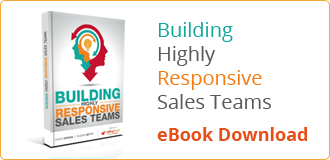
Topics: wittyparrot inbound sales responsive sales
1 min read
The Need for Speed in Inbound Sales
By Mark Gibson on Tue, Oct 22, 2013
I now make best efforts to respond to an inbound leads inside 5 minutes of receiving it. So far I have been able to reach 80% of contacts directly on the phone if I call within the first 10 minutes. I'm having at least an order of magnitude more constructive conversations with prospective customers than using my prior approach.
I wrote two blogs on this subject in the past week: -
The Quick and the Dead: Why Responsiveness Matters in Sales featured on the HubSpot Website.
The other, Responsiveness and the Dawn of a New Era in Sales Enablement featured on the WittyParrot site.
If you are interested in your team speaking with more leads to initiate more conversations and to improve the number of qualified leads in your pipeline, then I recommend reading both articles.
In the meantime you may find our Building Highly Responsive Sales Teams eBook of value.

Topics: buyer-seller alignment responsive sales enablement speed in sales
3 min read
Steve Jobs by Walter Isaacson, a book review
By Mark Gibson on Wed, Oct 09, 2013
I was 11 years old and to this day I don't know why I cried. I knew nothing of American politics and I had only seen scant television clips of the President on one of the 3 stations on the TV, that broadcast from 4.30PM till station close at 11PM. I knew he was a great man however and admired by Australians and my school teachers.
When Steve Jobs announced that he was resigning from Apple in August 2011, I knew the end was near for the great man and I felt a lump in my throat. The day after his death, I was walking in Pebble Beach and I met a neighbor. We stopped chatted for a few minutes and Steve Jobs death came up in conversation and we both started crying. Steve Jobs was a great man, whether you liked him or not.
I never met Jobs, but I knew about Apple, having owned a Mac a couple of years after they were introduced. Stories of his unusual behavior were already legend in Silicon Valley when I moved here with Sun MicroSystems in 1991. Sun Microsystems kept close tabs on what Jobs was doing with NeXT as the Sun UNIX workstation began it's meteoric rise.
I listened to the Walter Isaacson Steve Jobs biography over a couple of weeks on my commutes to the WittyParrot office in Bay Area, (I am an investor in and advisor to WittyParrot, a new Silicon Valley Software company) and was riveted by the story and the storytelling skill of Isaacson.
When I arrived at the office I would share the latest insights I had gleaned from listening to the Jobs story with the design team at WittyParrot and I sent several emails with condensed insights and suggestions on the design and out-of-box experience.
For entrepreneurs, designers and engineers, the Steve Jobs biography is a case study in the importance of thinking outside-the-box, simplicity and elegance in design, and execution.
From the numerous true anecdotes throughout the book, it is clear that Jobs was a tyrannical leader, ripping subordinates to shreds and firing people summarily. He did however build a team of “A” players who were extremely loyal and believed in the Jobs Apple mission… which was to change the world.
His reality distortion field influenced and inspired others to do what was previously thought impossible. He would look subordinates in the eye with an unblinking stare and exclaim “this is shit” on being show work or programing that was less than breathtaking, to see if they believed it was less then their best.
Steve Jobs changed our lives in the same way Edison did a hundred years earlier. He was inventor like Edison, with more than three hundred patents in his name and like Edison, he was a visionary. Jobs obsession with creating technology products that incorporated art in their design gave us products that redefined the look and feel of consumer electronics and computer retailing.
Every reader of this article has been touched by the experience of using Apple products. It’s worth recalling the breakthrough products that Jobs and Apple gave us, here are a few that changed the World:-
- Apple-2 one of the first mass produced personal computers.
- Apple Lisa and Macintosh, Mac - the computer for the rest of us, which heralded a new era of computing and introduced the GUI, the mouse and beautiful fonts
- iPod, - a thousand songs in your pocket
- iTunes – a new spin on music
- iPhone – The Internet in your pocket
- iPad – "The iPad is…”
- Apple Stores– the most profitable stores on the planet
- The App Store - More than a thousand apps. One simple new way to get them
- Pixar Animation – Toy Story and many others.
Topics: book review steve jobs walter isaacson apple
4 min read
The Highs and Lows of Business Travel - and what you can do about it.
By Mark Gibson on Mon, Sep 30, 2013
My wife and I had been undecided as whether to attend a winetasting in Santa Barbara, CA. this weekend and made a late decision to go. At the last minute, accommodation options in Santa Barbara were very limited and we made a booking for Saturday evening through the Extended Stay America hotel website direct on Thursday.
My wife received email confirmation of the booking on her cellphone on the dates she had booked, but she did not open the email on her desktop email system that indicated that the hotel was booked for Thursday-Friday. Neither did she check to see if there was a booking confirmation number on her cellphone email
After a 4 hour drive and afternoon of wine tasting, we were looking forward to a restful stay at our hotel a few miles from the winetasting venue. The first inkling that there could be a problem was when we got to the hotel desk and heard the clerk advising a couple that there was no availability and that everything in Santa Barbara was sold out.
Our turn at the desk came and I got that sinking feeling when the clerk began questioning us to the possible names the booking was made under and asked if we had a reservation number. My wife opened her cellphone email and found the booking for Saturday evening, but there was no confirmation number. On her desktop email, the booking was confirmed for Thursday and Friday on the day she made the booking. Clearly there was a problem with the booking.
At this point we have two options, either get mad at the clerk and vent our frustration and demand that they solve the problem on the spot, or call the hotel company and get mad at them and demand that they solve the problem while we fume on the phone, threatening never to use their services again and slagging them off on social media.
The other alternative is to shrug your shoulders and say bummer, - and begin to create options for yourself to solve the problem that don’t involve you becoming enraged and upsetting others.
While my wife was on the phone with Extended Stay, I chose the latter and asked the clerk for a Wi-Fi password and began looking at alternatives. After a few minutes we found a hotel 30 minutes up the road we had already traveled and made a snap booking as there were very few available options remaining.
We spent the night in a Motel-6, not our first choice for accommodation, but it was the last room within a 30 minute drive. We had a good night’s sleep in a room that was clean, where the beds firm, but comfortable and we got a $10 discount on the room… whoopee!
This morning in one of our favorite breakfast places, Andersen’s in Santa Barbara, we had another encounter that we have all seen played-out badly in restaurants.
We arrived at the restaurant at 10AM, were served coffee and juice and our orders taken. The food was taking a long time coming and a clue that there might be a problem was when the people sitting next to us, who came 10 minutes after us, were served their breakfast. Bummer
I inquired as to the whereabouts of our breakfast and the hostess gave us a curt “this is Sunday morning” reply. Fair enough I thought, it’s a busy place and the food is worth waiting for. However it was now 10.45 and still no food. A few minutes later our curt hostess came back to our table and apologized that our order in fact had gotten lost. Bummer
Meanwhile the people next to us were paying their bill.
I was getting a little impatient and could easily have made a scene, passed a rude comment and stormed off; but that would only upset me, the staff and immediate patrons and we would still be 30 minutes away from breakfast. Finally the food arrived at 11AM and we were advised that everything would be complimentary. Whoopee.
Our curt hostess asked if we liked champagne and returned with two glasses… the Sun was over the yardarm somewhere. Whoopee.
I reflected on this experience and recall a humorous talk I had heard from Tim Gard five years earlier at the Professional Speakers Association annual conference in London.
He spoke about the highs and lows of business travel and the potential for things to go wrong – often and right occasionally. The point of his talk was that things will go wrong, it’s how we react to them that sets the tone for the remainder of the encounter or trip. His advice, when things go wrong – shrug your shoulders, say bummer and move on. When things go right, click your heels, say whoopee and be grateful for the break. Tim was no doubt influenced by Viktor Frankl.
Viktor Frankl wrote in “Man’s Search for Meaning” that human beings are the only species with the freedom to choose how they will react in any situation through the exercise of our free will. Life will present many challenges, but our power to shape our response to the challenges determines our attitude and ultimately shapes our experience. His insights came from his experience in surviving the Dachau concentration camps in WW2, when all those that he loved, save for his sister, perished.
Summary and Take-aways:
- Always check to ensure your booking is for the correct dates and that you have a reservation number when you receive email confirmation of an Internet travel or accommodation booking.
- In business travel and in life things will go wrong, it’s how we react to them that sets the tone for the rest of the event.
- If things go wrong – say "bummer" and begin to create options to solve the problem instead of getting mad.
- If things go right and you get that room upgrade or last seat in business-class, click your heels, do a little dance and say "Whoopee"!
- If you haven’t yet read Man’s Search for Meaning, it could be time you did.
Topics: business travel viktor frankl tim gard
3 min read
An Architecture for Responsive Sales Enablement
By Mark Gibson on Mon, Sep 16, 2013
Responsive Sales Enablement
The Inbound Marketing model pioneered by HubSpot has been proven by nearly 10,000 companies to efficiently lower the cost of acquiring new customers. The next logical steps in this evolution, articulated by HubSpot CTO and co-founder Dharmesh Shah at the recent #Inbound13 event in Boston, are Inbound Sales and Inbound Service.The idea of flipping the sales model of calling cold, or even warm prospect lists on its head, to real-time engagement, while or within a few minutes of prospects visiting your Website or opening your email is a smart approach to facilitating buyers who start their journey as an inbound lead.
Think about it, would you rather be contacted by a vendor salesperson to ask if you need help, two days after your visit to their Website, when you are in the middle of something else - or within 10 minutes of being on their Website?
I would rather get that call while it’s still fresh in my mind… whether I decide to take action or not.
Context
Context is required for a meaningful conversation with prospective customers, based on their buyer's progress in the IMPACT buying cycle. The HubSpot Contacts system provides excellent context to facilitate this conversation in the form of prior behavior and precise details of interactions.Responsive Sales Enablement
A responsive sales enablement system is required to quickly provide salespeople with the information they need to have a meaningful conversation with a prospect when they receive a Signal that a contact is on their Website or has opened an email. The ability to follow-up the conversation immediately with an email with links and resources the buyer can use, while the conversation is still fresh in the buyer’s mind is an under-developed opportunity in most companies.
What is WittyParrot?
WittyParrot is a responsive sales enablement platform.
WittyParrot helps you find, assemble, share and track digital information and makes it available in a widget that sits on your computer desktop, tablet or phone, whether you are on-line or off-line.
WittyParrot is like iTunes for information. It enables you to quickly find and share content by simply dragging and dropping it into the target application, email tool or document. And like iTunes it keeps track of what gets used and what's relevant in your context.
In a couple of clicks, you can find, drag content chunks from the widget into email, letters, documents, and web pages. This solves a universal problem – consistent communication.
Through a unique combination of sales and marketing messaging alignment, inbound marketing tools, real-time Signals, and sales enablement support, facilitated by WittyParrot, this vision has become a reality. (Full disclosure, I am an investor in and marketing adviser to WittyParrot).
Having an always-on, searchable desktop Widget, populated with most-used sales enablement material provides the context that salespeople need to have relevant conversations with prospective buyers and to immediately follow-up the call with a relevant note and resources.
WittyParrot enables salespeople to instantly access appropriate stories and other supporting material (scripts, presentations, pdf’s, buyer personas, capabilities, website links, videos, pricing) from a Desktop Widget and drag and drop them onto the desktop for use in phone conversations, or into email, Word docs, or PowerPoint presentations for follow-up.
We are working with a number of innovative technology companies to prove the Inbound Sales/ Responsive Sales Enablement concept and while it's too early to declare victory, early results are promising and interest from enablement professionals and thought leaders in marketing is very high.
Advanced Marketing Concepts is now delivering responsive sales engagement solutions for our B2B clients. We create the aligned sales and marketing messaging within WittyParrot and share the atomized messaging elements, content creation templates and sales ready messaging to sales, marketing and enablement teams. WittyParrot is an enabling technology to make sales and marketing alignment a reality
Opt-in to keep abreast of this responsive sales enablement thread, find out more about WittyParrot and get early access to WittyParrot product.
Topics: wittyparrot inbound sales responsive sales enablement
4 min read
Perspectives on HubSpot Inbound13 User Group and Partner Conference
By Mark Gibson on Sun, Sep 01, 2013
With 5300+ confirmed attendees, more than 1300 partners and outstanding keynotes, HubSpot made a very strong impression that they have arrived as a corporation to be reckoned with.
Beyond Inbound Marketing
Co-founder, Dharmesh Shah indicated a broader future for HubSpot beyond the traditional Inbound Marketing theme. The customer HubSpot seeks to serve wants inbound everything, not just Inbound Marketing and they want to be delighted with the experience of interacting with your company. While this wasn't a product announcement, Inbound Marketing, Inbound Sales and Inbound Customer Support make up the new end-to-end, human-focused experience.... watch this space.The HubSpot Methodology
HubSpot’s progress in the past 12 months
Co-founder Brian Halligan reviewed the achievments for the prior year.- R&D investment up 58% YOY,
- 300 major product enhancements including custom lead-scoring, email A/B testing, iPhone and Android Apps, Social Publisher, Custom Reporting App. Product quality better, UI better
- Doubled investment in support. Av. support wait time 1 minute.
- 600 HubSpot employees
- 2 acquisitions in Chime and PrepWork for IP and people for bottom of funnel developments
- 10,000 customers in just 6 years – and Brian still calls HubSpot a start-up.
Major product announcements:
- New Content Optimization System (code for CMS), this is the first of a new wave of CMS’ that will offer contextual personalization based on buying cycle maturity and responsive design to optimally render on any device.
- Social Inbox, a very powerful way to pull the needles out of the social media hay and to give context to the communication.
- Signals, a product incubated inside HubSpot that runs independent of HubSpot, to provide near real-time alerting. Signals is a freemium product that enables users to be notified when the email is opened, when a link is clicked, or when a lead or customer visits your Website. You can download Signals and start using it in a minute or two and prove its value.
Social Inbox
Context is a core theme for Hubspot's offering; today’s social media apps are all hay and no needles. Very early adopters of social media tools, reimagined how they work to match the modern buying experience.- Easy to use, Brian demoed it. Listening for HubSpot on Twitter, lines next to pictures indicate context, prospect, lead, customer
- Create a stream – Who do you want to listen to? – Reuse lists in Contacts app.
- What do you want to listen for? “Inbound marketing” or “HubSpot”
- How would you like to be notified? Email, email digest, login to app?
- Awesome new social media stream, - orange stripes are leads… drill in and get additional context, who is rep, what contact record looks like. Get context, forward tweet to rep (who has context) to respond.
- Runs on iPhone.. Droid in a few months.
- Social Inbox created on top of Contacts - contacts is core to all HubSpot new apps.
- Set up list of leads per rep, keywords mentioned, get alert!
The Content Optimization System
Wildly competitive content management industry… no context. Then and Now.Visitors keep getting the same experience regardless of #visits or status. Applies to 99.99% of Websites.
- Websites can't tell difference from complete stranger or customer or where you came from iPhone or computer (13% of HubSpot visitors from Mobile)
- Re-imagined for modern buying experience, optimized for where they are in buying cycle and what device they come from.
- CMS turns your brochure into a Website, COS turns your Website into your best sales rep
- Helps marketers accomplish the mission of thinking about the visitor as a human.
- Conversion rates much better for COS vs. static CMS - others in the market will follow HubSpot's lead.
- Demoed personalized landing page with context to give 3 different experiences for first time visitor, lead, customer.
- Demonstrated responsive design and difference between mobile and desktop versions of blog
- Complaints from designers in past with difficulty of designing on old CMS – (agreed)
- New COS, designers will love it,
- Context creates the inbound experience.
Signals
- Big gap in sales technology available and what’s needed.
- Most technology built in 1990’s – how to enable reps to have context when context wasn’t even an afterthought in designing those tools .
- Dramatic power shift in sales - salespeople are now facilitators in the buyers journey, little control.
- Sales process – a problem for sales - lack context and ability to keep up - in sync.
- Signals was developed as Startup inside a HubSpot. HubSpot bought 2 companies this year to infuse context into sales.
- Signals lives inside other apps. HubSpots’ existing technology for lead revisits can take 20-30 minutes to deliver lead revisit notification into a browser. Signals does it in a minute. (Works in Outlook on Windows, not on Mac, works in SFDC and Gmail) Rep gets notified when the email is opened, notified when link is clicked, notified when a lead or customer visits the Website. When a salesperson picks up phone to call a prospect, know so much, more context, then ever.
- Don’t need anything to make it work, go to getsignals.com. Call to Action: Get sales and service set up on Signals. Basic version for email $0, SFDC and HubSpot $10/mo.
HubSpot Partner Program Highlights
Exciting changes for Hubspot partners building on the success of the existing partner program that leads to 18% higher customer retention.- HubSpot partner strategists will work with Partners to help move prospects through the buying process.
- Content to help generate leads has been expanded and enhanced for easier partner co-branding to drive more inbound lead conversions.
- Co-marketing with HubSpot and editorial support for partner featured articles on HubSpot main blog and social media to increase reach.
- Shared landing pages on HubSpot main Website for registered leads to leverage HubSpot content and landing pages for nurturing for middle and bottom of funnel prospects.
- Automatic lead registration connectors for HubSpot leads and synchronization with HubSpot to enable tighter collaboration for partners who install the software.
Topics: hubspot inbound 13 brian halligan dharmesh shah
3 min read
The Icarus Deception - Book Review
By Mark Gibson on Tue, Aug 27, 2013
Seth Godin is a visionary with a powerful message for anyone who will listen.
Godin shows us how it’s possible and convinces us why it’s essential." excerpted from the Amazon page.
I’ve been a Seth Godin fan since reading Permission Marketing about 10 years ago. His blog email is one of the few emails that I anticipate and read every morning.
I have often wondered if Seth has a team of geniuses writing on his blog as it is an endless stream of amazing insight that almost always caused me to think. I was recently advised by people who know him, that it’s just him writing it. He gets out of bed every morning and writes whatever comes into his head. If you don’t already get his blog email, you can subscribe here.
Topics: seth godin icarus deception do the work
3 min read
Whiteboard Selling - Book Review
By Mark Gibson on Tue, Aug 06, 2013
I Wish I Had This Book 2 Years Earlier
I wish I had this book when I started working with WhiteboardSelling in December 2010, as it would have accelerated my learning curve.I learned the craft and art of whiteboarding by observation, sitting with Corey Sommers as he went through each aspect of the Whiteboard Selling process, including:
- Kicking off the session with the client,
- Conducting the brainstorming message workshop,
- Coming up with the initial visual concepts,
- Scripting out the whiteboard story,
- Getting the whiteboard approved, and
- Training the sales teams to do the whiteboard.
The book is well-written and well worth the meager investment for anyone interested in whiteboarding.
Here's why you should buy it.
Get Clear About Your Value Proposition
In the two years with Whiteboard Selling, the typical client-messaging baseline for developing the whiteboard was 5/10 for clarity.Messaging existed in the form of PowerPoint, .pdf’s and ideas in various contributor's heads. The process of defining the whiteboard story is clearly outlined in the book and helps the whiteboard author to clarify the buyer’s issues and to focus conversation on relevant product or service capabilities using the right whiteboard structure for the buyers maturity in their buying process.... this is important!
There is a difference between a "Why Change" whiteboard story for a first call on a prospective customer and a "Why Me" whiteboard story at a closing meeting on a prospective new customer.
The differences are spelled out in the book and will help salespeople go from a 5/10 for clarity to a 9 or a 10 by the time they complete the whiteboard development process.
Whiteboard styles and design templates are included for each stage in the buying process.... these are invaluable for rookie whiteboarders.
Get Salespeople to do Product Training with a Whiteboard
Despite best efforts of product managers in sales kick-off training sessions, very little is retained from a typical PowerPoint based product training session. The only thing memorable most salespeople bring home from a typical sales kickoff event is hangover.Magic happens when you engage salespeople to do the product training using a whiteboard. The process of iterative role-playing - of presenting and watching and listening to the whiteboard development repeatedly, engages the whole brain and all of the senses.
I observed thousands of salespeople walk into training rooms having never seen the whiteboard story and doubting their ability to whiteboard. The same salespeople left four hours later capable of delivering the whiteboard the next day - they owned the message in just four hours.
Summary
- This book outlines the path to creating a sound whiteboard story that can be used to get everyone in your sales and channels team on message and to make it stick.
- Unless you happen to be a visual and cognitive genius capable of inventing images and story on the fly, don't expect some magical force to guide your pen.
- You'll never get up to the whiteboard and create something meaningful if it does not already exist in your mind.
- WhiteboardSelling methodology and process IP are now owned by Corporate Visions after they acquired the company in August 2012.
- David Jenkins and Corey Sommers have both moved on, however they have left an indelible entry in the canon of selling literature and their book Whiteboard Selling is highly recommended. You can order it here.
Topics: whiteboardselling visual storytelling whiteboarding
4 min read
Upbeat - A Review of a Little Yellow Book with a Great Big Message
By Mark Gibson on Mon, Jul 22, 2013
I'm Upbeat about Upbeat
During our second meeting, he gave me a copy of a little yellow covered book, which he wrote in 2009, called " Upbeat: Cultivating the Right Attitude to Thrive in Tough Times".Prior to our the second meeting I checked out Rajesh's personal Web page and read his extraordinary story.
If you haven't seen the movie " Slumdog Millionaire", it's a wonderful story about the experience of an Indian boy who escapes the desperate poverty and circumstance of being born in the slums of Bombay. His story is told through his travels and his life is enriched by his experiences (good and bad), where he acquires a general knowledge well beyond his station that he ultimately uses to complete the journey of a hero and win a million dollars TV show quiz game formatted on "Who Wants to be a Millionaire". That is fiction, but it's a good story.
Rajesh Setty writes fiction and he writes a good story. His own story is a worthy and compelling read. Rajesh had read several hundred books by the time he was 9 years old, when he decided to try his hand at writing his own book. I know people who have read hundreds of books in their first 10 years, but I don't know anyone who wrote their first book at 9 years of age and despite 150 rejection letters, finally got it published at age 13.
Rajesh has written dozens more since in both a serious business tone, as well many fiction books in the crime mystery genre, however the fiction works were written in India and have not been translated into English.
A Small, But Powerful Gift
When Rajesh gave me his little book, I thanked him, put it in my bag and opened it in bed that night for a quick read before going sleep. That quick read turned into an hour and a monologue with my wife, punctuated with quotes, exclamations and references to particular insights and points of brilliance.I have reread it twice since and feel compelled to write this review. Even though this book was written and published in 2009, as a shot in the arm for the general population feeling shell-shocked and helpless in the recession,
timeless and relevant now, as it was then.
"Upbeat" is a slim volume of 90 pages, you should be able to read it in an hour or so, but don't let size fool you, it's packed with practical wisdom from someone who is in the field and current, an entrepreneur taking risks in the arena and relishing the spoils and disappointments that life brings. If you've read Viktor Frankl and like Seth Godin's writing and thinking, you'll like what Rajesh has to say.
Rajesh suggests "For those of you who are thinking about doing something and you have been sitting on the sidelines, here is my $0.02 - if you want to grow at breathtaking speed and become someone that you will be proud of, the marketplace and the World has provided an opportunity again. Get off the wall and jump in."
The book is about personal growth and the daily decisions and attitudes that we take that determine our short and long term future. Broken into 5 main chapters; The Trap, The Discipline, The Network, The Strategy and The Actions, each section has subsection headings like; The Daily Conversations, I Need a Shortcut, Be Accountable to Yourself, You Better Get "Better" Help, and Spend Less and Spend More.
The nuggets of wisdom in these paragraphs can only come from reading widely and playing the game at the highest level and they inspire you to think hard about some of the choices you make every day.
Rajesh writes, "I Need a ShortCut, - The paradox in life is that shortcuts always take longer and or/cost more - though it has not prevented people from trying them all the time." How true this is… in our popular American culture, we are taught winning is everything - no prizes for second, (what happened to being in the arena and playing the game with a straight bat?).
This distorted thinking creates a "do whatever it takes" approach to winning. What comes from this thinking is an inevitable fork in the road; the hard way or the shortcut – one of my former hero's Lance Armstrong is our current poster-boy for the short-cut....who's next - everyone's favorite runner?
Rajesh Setty's little yellow book "Upbeat" is a timeless tonic for anyone interested in playing the game (of life) at a higher level than they are currently and is highly recommended. You can order it here.
Topics: rajesh setty upbeat personal development
5 min read
Boring Your Prospect to Death? Revive them with a Story
By Mark Gibson on Thu, Jul 18, 2013
The subject of capturing proof points and formatting them to tell stories came up during the messaging workshop and I want to use a story to illustrate the point of using a storytelling and to describe the discrete steps in the storytelling format. I partner with Mike Bosworth and use his Story Seekers method in formatting and telling stories. The format is universally understood and follows the basic "hero's journey" format that powers so many of the scripts in our popular film culture.
The people in the company I'm working with are World-class thought leaders in their field, they have a great product for a well-defined niche, but they are struggling.
Their messaging clarity was 3/10 and their website unclear and they got few inbound leads. Like many other emerging technology companies, they were using outbound cold calling and spamming lists to generate interest and not surprisingly had very little success.
An additional problem was that the few leads they got often proved to be unready for sales contact. We ( Kuno Creative and Admarco) were hired to help clarify their messaging and to transform their Website and implement an inbound marketing methodology.
After clearly identifying their capabilities or Win-Themes and applying them to their Buyer Personas in the messaging workshop, I asked a couple of the top salespeople to role-play with me around the buyer persona issues, using the capabilities we had developed.
What happened next is happening in sales teams all over the World and explains why so many salespeople are struggling. They have plenty of success stories or proof points, but they don't have the stories in a usable storytelling form … and salespeople don't have the skills to relate their story.
(The barrier or status quo in the last sentence is the fact that they don't have the stories in a usable form – at their fingertips; the complication is that they don't have storytelling skills - even if they had the stories.)
But let me get back to the story and role-play.
- Their salespeople who know so much about the problem proceeded to tell me what I needed (to use their product), - I immediately felt my personal space being invaded when being told what it was that I needed to do and I felt like I wanted to push the salesperson away. It felt like I was being sold and I pushed back hard and gave them an objection, I felt I was under pressure - like every buyer does. No-one likes being sold... it's offensive. ((Telling is the STATUS-QUO delivery mode and a BARRIER to success for most salespeople))
- The other issue this sales team has is that their market has nuances that are subtle and they cannot be 100% sure they are "on-message" when making a recommendation – because typically they are premature in making it. Salespeople who have seen the problem dozens of times before, often can't wait until they fully understand the buyers story, before suggesting a solution. This is also known as premature elaboration. ((Market nuances are the COMPLICATION))
Storytelling Stucture
1. We reversed the roles and I played the role of the salesperson and asked if I could share a story of how we had helped another VP in a similar company (same role) to solve a similar problem. SETTING.2. I described the status quo - they had Oracle and lot of reporting tools to do the job… but the barrier was that they couldn't see the problem with their existing tools, despite having spent a lot of money on technology and decision support. STATUS QUO/BARRIER - Setting the Stage.
3. I then introduced the complication, which meant that because managers couldn't see the problems in their standard reports, they had to work Sundays to prepare for Monday morning meetings using a data dump and Excel to try and spot the problems. COMPLICATION/Constraint + vulnerable/human… we can relate to the pain of working Sundays.
4. Next I introduced the unique product capability and our insight which helped to identify the problem and show the customer how they could use our tools to see the issues and take action to solve the problems. TURNING POINT.
5. They adopted the solution and now the problems are made visible in reports that we generate automatically from our system and managers get to share Sundays with their families. RESOLUTION.
6. To add concrete evidence, I used the quote about the impact of the software on productivity extracted from a CEO's Quarterly Wall Street briefing = OUTCOME.
This was a watershed moment for my client and the sales team.
Summary
- Stories give us the natural ability connect emotionally with buyers in a non-threatening way and to accelerate trust.
- Stories need tension and emotion/vulnerability to connect emotionally with buyers.
- Stories are boring without emotion and contrast to bring them to life and are quickly forgotten.
- Salespeople need to be prepared to be vulnerable and go first with a story and then to carefully "tend" or listen to the buyer’s story.
- The “Who I’ve Helped Story” starts with the setting and introduces our buyer and the status quo.
- The journey begins with Barriers that describe what's preventing the buyer from achieving their goals.
- Complications/constraints are emotional factors that bring our story to life and give it tension through struggle, resistance to change and ultimately this is the point of human connection.
- The turning point is the insight we bring with our expertise and the use of our software to help the buyer see the problem in a new light.
- The resolution is the successful outcome and if possible, some hard ROI evidence
- Stories are the most powerful connective link between salespeople and buyers to convey insight in a way that buyers want to receive it. Just about everything else can be gotten from the Website.
Conclusion and Calls to Action
Storytelling is not yet mainstream and too "touchy-feely" for most mainstream sales leaders. Individual salespeople and early adopter sales leaders looking for competitive advantage in how they sell could start their journey by;i. Aligning sales and marketing messaging to clarify their value proposition,
ii. Capturing and formatting their "Who I've Helped Stories" in the above manner, and placing them in the hands of salespeople when they need them.
iii. Training sales people in storytelling.
Topics: sales & marketing alignment messaging workshop storytelling
4 min read
Life after Powerpoint - Using Stories for Engagement
By Mark Gibson on Tue, Jun 25, 2013
The night before the messaging workshop my client requested that we use a different approach to creating the messaging, which made my PowerPoint deck redundant. Fortunately the client had a whiteboard and a flip chart handy.
Starting a Meeting with a Story
To kick off a 3-day workshop, I still needed engagement and buy-in from the audience. My sponsor in the messaging workshop and I had worked on a similar messaging and sales enablement project several years earlier, which was transformational for his company and he introduced me and told his version of the "Who I've Helped Story" of our prior engagement, from the customers point of view, which was fantastic as this story is always more powerful coming from the customer, vs. the supplier.Since many of the participants did not know me, I started with my "Who I Am" story. In 90 seconds I told the story of the past 10 years of my professional life as a consultant. It wasn't a story about how fantastic I am - it was about the journey, the struggle and the lessons learned, that give me unique insight.
- In 2003 I was staring down the barrel of a 2nd lay-off in 2 years. (setting stage & vulnerability)
- Realized customers had changed and I hadn't. (journey begins)
- Didn't have 20 years selling experience - really had 1 year experience repeated 20 years over. (vulnerability)
- Started a search for new ideas, journey of discovery - (call to adventure)
- (Joke) My wife heard me practicing my story - she said "keep looking" (humor)
- Moved to UK, started a sales training consultancy (transition)
- First graduates could get meetings with CXO's, but when they got there would revert to "product-speak" - Realized they needed messaging to help engage buyers around their issues. Started messaging which has been a part of every engagement since. (struggle + Insight)
- In 2008 we had customers, but no leads - introduced to HubSpot and started creating content and generating leads and has become a part of our DNA. Messaging now used to drive content marketing. (experience + lightbulb moment)
- 2010 relocated back to USA and met Corey Sommers at Whiteboard Selling, invited me to work with him to use my sales training experience and messaging skills to create visual stories. (relevant experience)
- 2013 connected with Mike Bosworth and learned story telling, come full circle - that's why were here - capture your message so everyone can tell your story. (call to action and resolution)
Using a Curiosity Hook for Enrolment
After I told my "Who-I-am" story, I drew three large numbers on the flip chart.I asked the audience what they thought the
Then I revealed the question mark with a question ...How clear is your sales team in positioning the value of your technology solutions on a scale of 1-10, where 1 is terrible and 10 is crystal clear.
The final number 10% had everyone stumped. This is the percentage of sales meetings with salespeople that buyers rate as actually worth having, where the vendor brought insight to the table.
If you are interested in learning to tell your story in an engaging manner and in more effectively listening to the buyer as you tend their story, you are invited to join us at the forthcoming Open Storyseekers workshops in Seattle.

Topics: mike bosworth sales training marketing messaging storytelling
5 min read
Revelations on Story Telling - Survey Results
By Mark Gibson on Tue, Jun 11, 2013
Topics: mike bosworth storytelling visual storytelling
4 min read
10,000 Reasons to get Clear about your Value Proposition
By Mark Gibson on Wed, May 29, 2013
I asked both of them, how many times they expected to pitch their "big-idea" and "what-we-do" stories in the next year.
Rajesh suggested that he would probably pitch his story 2000 times in the next year, the other entrepreneur about 500 times. Let's pick a point in between, say 1000 and multiply this by 10, because both companies have about 10 employees today. Most are engineers, but all are going to be interacting with the above networks of partners, prospects and strangers.
One entrepreneur rated the clarity of their value proposition at 1/10 and explained that he currently has a consultant working on helping him clarify it, Rajesh rated his message at 6/10 and a work in progress. The image below represents what is created when you are less than 7/10 for message clarity....pollution!
How then can a start-up, or an F500 company for that matter, address the problem of unclear messaging? If you have read this far I think you’ll agree that it’s important. The answer to the question is that it’s not easy.
I believe there is an opportunity to create a software as a service product to create and maintain messaging that resonates with buyers, that everyone from entrepreneurs to marketing managers in F500 companies can use and I’m in the process of building it and we are interested in talking to early adopters in our customer discovery phase of development.
We helped an Israeli technology company re-launch their Infrastructure as a Service product at a critical time in the evolution of public and private cloud solutions and it was transformational for the company. They weren't looking for a consultant to help with messaging, but recognized they were about 4/10 for clarity in their value prop at the time. We began by creating buyer-persona’s around best guess use cases.
We helped to create a messaging architecture that identified the relevant capabilities and grouped them under logical positioning pillars.
We then generated sales ready messaging for the sales team to use when engaging prospects over the phone and in person and trained the sales team to use it in consultative conversations.
The marketing team used the messaging to transform their Website message from product-centric gobbledygook to buyer-relevant copy. Marketing managers in each country began to use the messaging in creating blog articles and they quickly began to generate new visitors that converted into inbound leads and new-name customers in the first 6 months after the messaging workshop.
Since this engagement, we have added visual storytelling to our methodology, to capture the value proposition in a meaningful visual confection where both salespeople and buyers can quickly "get", remember and communicate your “big idea” and value proposition.
Take-Aways
- It's never too early to get clear about your value proposition.
- If you can't nail your value proposition for the users you are trying to attract and sell to, how can you expect to get them excited about using your product or service?
- The sales cycle starts in marketing with content creation and if the content you create doesn't resonate with your target buyers, they won't come.
- If you cannot answer the next three questions with absolute simplicity and clarity so your ideal prospect can understand it, you have work to do.
- So-what-is-it-you-guys-do-then?
- What is a metaphor for an existing product idea, service or capability could you use to help a buyer who does not know your product or company to instantly understand how they could use your product?
- Why should I buy from you?

Topics: value proposition messaging architecture message clarity big idea
4 min read
Why Salespeople Fail- Failure to Listen & Premature Elaboration
By Mark Gibson on Tue, May 21, 2013
I cannot easily summarize the 2.5 days in 600 words, but I can give you a couple of core ideas.
I've been a Mike Bosworth fan since I read Customer-Centric Selling in January 2005, but I had not read his prior work, “Solution Selling” published nearly 30 years ago, based on his experiences at Xerox and involvement in the SPIN project. Mike was one of the most successful reps in Xerox history at the time and gained much experience in selling, managing and training salespeople before most of us started our sales careers.
While reading his latest book, co-authored with Ben Zoldan, entitled, "What Great Salespeople Do", I could feel myself nodding as I could either see myself in the stories, or agreed with his ideas and training philosophy.
One of Mike’s startling revelations in the opening of the training course is that after nearly 30 years of sales training in both Solution Selling and Customer-Centric Selling (and most of the other mainstream sales methodologies), not much has changed for the bottom 80% of the sales force, who sell 20% of the revenue.
The outcome of these training courses was that the best salespeople got better from using the techniques and processes, but the core group typically stopped using the techniques within a month or two of the training and reverted to prior behavior. Mike points out that in fact the old 80/20 rule is no longer true in fact it’s now 13% of salespeople selling 87% of the business. (Sales Benchmark Index)
Why?
The answer to this question is not masterful use of the CRM system; adherence to the 9-box questioning model, or the number of connects per day or the ability to dazzle with presentation and demonstration skills. These are table stakes in the old process oriented, logical “left-brain” training paradigm for sales professionals.It turns out that great salespeople are able to forge strong emotional connections with buyers, either through a natural or learned ability to quickly create rapport, listen empathically and connect emotionally with buyers, typically through story.
Top salespeople are able to connect emotionally with buyers quickly, which the Franklin-Covey organization refers to as “speed of trust”. This is one of the most critical skills in today’s buyer-seller relationship, where the salesperson’s “at-bat” opportunities are fewer and meeting duration is shorter.
Status-quo thinking with sales leaders is that right-brained empathy and rapport skills can’t be taught. “It’s too touchy-feely for our hard-bitten sales team” We are looking for sales leaders who are willing to challenge that belief, who understand that these skills are probably the most important and most underdeveloped in the core group.
Storytelling is as old as mankind and no one ever turns down an opportunity to hear a good story. When you tell a story and expose your vulnerability in the process, you invoke a reciprocal emotion in the listener and create an opportunity to tend (draw out) the other-person’s story and this is what builds trust. This is not a story about how great you are as a salesperson; how big your company is, or how wonderful your products are. These are the stories most salespeople are telling today to buyers who haven’t asked to hear them - most of the time.
Truly listening to the other person, reflecting their words and emotions, (without thinking about what you are going to say next, interrupting, mentally counting the commission, or trying to qualify in or out), is a skill and it can be learned and mastered with deliberate practice.
Mike used an expression “premature elaboration” to describe how salespeople - who are experts in their field and familiar with the buyer situation are too keen to tell the buyer what they need.
Neil Rackham created an expression that still holds true today as a result of his research in the SPIN project.
EXPERTISE + ENTHUSIASM = ENEMY.
This is premature elaboration and most of us in sales have been guilty of it at some point in our careers. If you put yourself on the buyers side of premature elaboration, it feels like you're being told and then sold and that's what gives salespeople a bad name. Learning to truly listen and tend the buyers story will help you to learn more about the buyers issues before you offer your solution.
The Story Arc
We created and learned to tell three stories in the workshop;- Who Ive helped,
- Who I am,
- Who I represent,
All stories we created follow a similar story arc and we used this story format to tend the stories of others. On the evening of the 2nd. day, our homework assignment was to call someone we love and ask them a question and tend their story using the skills we had learned in class and the story arc to help tend the conversation. I called my 17 year old daughter, Olivia and we had a conversation for about 40 minutes, unlike any we had had before.
We are looking for early adopters in sales leadership willing to pilot a Story Seekers Storytelling workshop for struggling reps who they would hire again (competent + character).
Join us for a live Storytelling Webinar with Mike Bosworth

Topics: mike bosworth story seekers sales enablement storytelling
3 min read
Using Visual Storytelling to Get Your Next Job - Case Study
By Mark Gibson on Thu, May 16, 2013
Ever been laid off? I have - and chances are that at some time in your life it could happen to you. Layoff's happen, it's a fact of life in our time and it's no big deal. Companies re-organize, merge, get acquired, have a bad quarter and suddenly, headcount becomes a problem.
After 9-11, there were hundreds of thousands of sales and marketing professionals in the Bay Area suddenly unemployed. Long gone is the era of my parents (grand-parents for many readers), when you joined a company and expected to work a lifetime and retire on a pension at 65.
What happens when you do get laid off? How do you get back into the workforce and perhaps more importantly, how do you win the job you really want, when there are potentially dozens or even hundreds of others applying for the same job? Hint - be different!
Wil Loesel (www.linkedin.com/in/wloesel) worked for Time Warner Cable as a sales manager and was recently laid off due to a restructuring. Wil visited my Website earlier this month and viewed our " Your PowerPoint Presentations Suck Webinar" and decided to apply some of the ideas he learned in the Webinar to differentiate himself in his job search.
Wil's Story
"I had an interview for a B2C Manager position on May 5th. I had prepared a presentation a week earlier for another company I was interviewing at and was working on tailoring it for my interview the next day. I watched your webinar the evening prior to my interview and decided I wanted to change my entire presentation.I stayed up all night (until 8am) revising the presentation. I then slept for 2 hours, woke up and kept working, all the way until my interview. I wrote and memorized talking points and stories for each slide (keeping the slides visual, using only a word or two and a picture) and let my voice present the story."
Wil's Before Slides
There is nothing wrong with Wil's before slides, it's just that they are typical, the same meaningless graphics, too much information and have a memory retention lifecycle for the viewer of one mouse-click.This is one of the worst slides in Wil's old deck, but it's so familiar. I've seen something like this many times and when I see it my eyes glaze over it and move on. The slide below is popular at the moment. I have seen a derivative of this several times at industry conferences and Webinars already this year. It is unreadable and has too much information to be presented effectively.
Wil's After Slides
I have reduced the size of Wil's "after" slides to cover the points in his management philosophy section, because I can... you will still be able to get the key idea from each slide that Wil wanted to discuss, when the slides are shrunk. The images are clean, one main idea per slide, are easily understood and the images create meaning to support his point. It's Wil that is talking, the slides are doing their job as visual aids.
Topics: sales powerpoint visual storytelling
7 min read
The B2B Buying Cycle and How to Influence it, pt 2
By Mark Gibson on Mon, May 13, 2013
The first article in the series, "A Guide to Aligning Marketing & Sales Engagement with Buying Process" discussed buyer behavior and how it is affected by risk. Last week's article, The B2B Buying Cycle and How to Influence it, pt. 1 is an in-depth review of the formative stages in the buying process and the role of sales and marketing in early adopter engagement as well as the risks to the supplier.
Phase 4: Assessment
Congratulations, you made it through Position, the graveyard of most opportunities. Chances are you are well on your way to a sale to an important new customer, but don't put the champagne in the fridge yet, it could be months before a formal transaction.The Assessment phase is a necessary step in a post Enron-world and the era of corporate accountability to satisfy that due diligence is carried out, compliance issues are met and risks are properly considered.
In the assessment phase the organization is weighing both the upside and the risks in implementing early stage technology. Qualitative and quantitative performance information is sought, as well as assessment of upside, risks, plus all costs. Assessment involves assembly of a project team, proof of concept or pilot to create evidence & gather data.
Role for Marketing
I asked John McTigue from Kuno Creative to contribute the three marketing segments on this blog as they are engaged with a number of current customers on exactly these deliverables.Marketing automation is more than sending an email to a list of buying stakeholders and tracking form submissions. It starts with aligning your sales and marketing teams so that they are on the same page with respect to:
- Understanding the sales funnel concept and how it aligns with buying-cycle stages,
- Understanding the demand generation and lead nurturing process,
- Agreeing to criteria for buy-cycle stages, including lead scoring thresholds and sales-ready events and triggers,
- Understanding and agreeing to the definition of a sales qualified lead and handoff between marketing and sales with respect to criteria and CRM integration,
- Feedback (or closed loop marketing) to the marketing automation system (and team) based on sales engagements and status updates,
Role for Sales
- Work with mentor/champion/buyer to implement a sequence of events for the assessment/evaluation,
- Support the proof of concept; where possible, seek to influence the construction of the assessment,
- Work internally within the supplier organization to support the assessment and provide technical support resources,
- Do not commence an assessment unless you know what the outcome of a successful evaluation will be.
Risks for Sales
- Pilot or proof of concept not properly specified or outcomes unclear,
- Internal adversaries influence the assessment criteria to make it hard for the supplier to succeed,
- The product doesn't work or deliver the anticipated result. (When this happens, it may be time to find another job.)
Risk Mediation
- The sales team needs to lead the client "let me share with you our process that has helped others make the transition...".
- Influence the construction of the assessment.
- Get your best minds focused on this vital task.
- An assessment takes time, effort and resources and exposes the supplier to considerable risk.
Phase 5: Case
The
Case phase converts the Assessment into a project to acquire the product or solution.
The case phase involves creation of a formal business case, assignment of internal resources and budget.
- Uses the output of the Assessment phase,
- Possibly includes analysis of alternative solutions to arrive at final cost estimates and an ROI,
- Likely to use 3rd party analyst data if available and independent comparisons of vendors and costs
- In this phase, the Case is pushed back and forth between the mentor and the sponsor (champion) until the sponsor is happy all relevant business and political goals are served.
- Budget is applied and the acquisition made public to potential suppliers.
- The buyer may issue an Invitation to Tender (ITT) or Request for Proposal (RFP) to satisfy purchasing rules. At this stage the case could be passed to purchasing to formally engage suppliers in the procurement process
Role for Marketing
Marketing's role is to assist the buyer in their journey towards becoming a customer.- It starts with buyer persona and messaging that addresses buyers directly at each stage in their personal decision process.
- Demand generation campaigns tuned to buyer needs at the beginning of the journey (top of the sales funnel) attract new leads that are pre-qualified by virtue of targeting and messaging.
- Lead nurturing campaigns keep potential buyers engaged and help them to become introduced to your products and services at their own pace.
- Calls to action at each step in the lead nurturing chain enable buyers to move forward when they are ready.
- Marketing is responsible for creating the content that maps to each buyer persona and decision stage and for developing marketing automation workflows for demand generation and lead nurturing campaigns.
- Ideally, sales and marketing work together to define lead scoring criteria for buyer behavior and to develop workflows for managing leads and handing them off to sales reps when they are ripe for purchase via CRM.
Role for Sales
- Set the agenda for the RFP/ITT or expectations/outcomes in a Term-Sheet, or Memorandum of Understanding (MOU) if the transaction is informal.
- Working through the needs analysis with the client and understanding the issues, goals and concerns of each constituent in the buying group.
- Generate business support for the Case by demonstrating (if appropriate), that your product can help them achieve goals and overcome these issues.
- Providing assistance with cost/Return On Investment (ROI) models.
- Provide relevant examples and proof points via case studies and where appropriate, through reference calls with satisfied customers.
- Use briefing books, white-papers, Webinars and presentations to circulate ideas
Risks
- Insufficient executive sponsorship (salespeople have only one key player on their team and their champion leaves).
- A late-coming competitor engages internally though their champion and cleverly changes the ground rules at the executive level.
- You receive an inbound inquiry asking for information on your products, and pricing. There is a sense of urgency and the buyer is not sharing with you all of their issues.
Risk Mediation
- Meeting key stakeholders involved in the decision is mandatory,
- Fight the battle on your terrain, fight to influence the assessment and the outcome of a successful business case,
- Beware of the Inbound Inquiry with a short time to respond; you may be invited to compete to make up the numbers in a deal where your competition has been working for months to set the agenda and you are being invited along for the ride.
Phase 6: Transaction
The transaction phase confirms project details to all internal and external stakeholders. Procurement may become involved for a formal acquisition.This could require competitive tendering, a short-listing of possible vendors, demonstrations and selection committees, the conclusion of which will be the award of the contract to the successful supplier.
Role for Marketing
In the final stages of the buy cycle, marketing also plays an important role in providing Sales with the lead intelligence and content they need to overcome objections and close the sale.Bottom funnel content such as case studies and video testimonials can help to sway buyers on the fence, and lead behavior monitoring can signal their intentions to the sales team so that they can prepare the most effective approach to closing.
Once the sale is finalized, feedback from buyers as well as sales reps arms the Marketing team with valuable information for reaching new leads and nurturing them throughout the buyer cycle.
Role for Sales
- Close the sale at the best possible price. If the answers to the following two questions are not yes and yes, do not begin to negotiate price.
1. Are we the chosen vendor?
2. Is price the only remaining obstacle to doing business?
(Customer Centric Selling, Bosworth and Holland) - Execute a Sequence of Events where the outcome is an order on completion of a successful assessment and business case.
- Salespeople should strive to time the order outcome other than at the end of quarter.
Risks
- Insufficient Stakeholder coverage results in your offering being marginalized by vendors aligned with more powerful executive team members,
- You get outflanked by a competitor who has blind-sided you and cleverly changed the ground-rules of the evaluation,
- Your champion or executive sponsor leaves or is transferred,
- A late-coming competitor drops their price through the floor and the client uses this as a lever to get big discounts,
- The buyer delays the transaction until the end of quarter and engages the purchasing team who are trained in negotiating pricing concessions and compensated on reducing vendor margins,
- There is an announcement that the company is making a strategic acquisition or is being sold or merged. (Not much you can do about this one - usually means a minimum of 6 months before the opportunity will be revisited - if ever; - back to the drawing board.)
Risk Mediation
- Use a project plan or sequence of events which is timed to conclude in an order, other than at the end of quarter,
- Ensuring you have met with, understand and to the extent possible, satisfy the needs of key stakeholders,
- Keep your mentors and champions involved in the machinery of the purchasing process; this is particularly important if you have proven a business case, established ROI and the purchasing team is being very aggressive in their negotiation stance,
- Be prepared to stand your ground against professional purchasing teams; call in your champion,
- Be prepared to walk if you cannot close the transaction on acceptable terms.

Topics: killer products buying cycle b2b buying process
9 min read
The B2B Buying Process and How to Influence it pt. 1
By Mark Gibson on Tue, May 07, 2013
The B2B Buying Process - and how to influence it.
Buyer behavior has changed radically in the past 5 years; sales process unfortunately in most companies has not adapted and marketing has been slow to adapt.I first noticed these changes 10 years ago, when buyers would come to meetings knowing more about the products and competitive approaches that I did. I began working on aligning buying and selling processes after meeting Dominic Rowsell, author of "Why Killer Products Don't Sell", on which much of this work is based.
This article is the second in a series of articles on aligning marketing and sales with buying behavior and it will be of value to sales and marketing professionals who wish to adapt their process to align with buyer behavior. Last week's article "A Guide to Aligning Marketing & Sales Engagement with Buying Process" discussed buyer behavior and how it is affected by risk.
The beauty of this approach is that it's universal, simple and based on actual buyer behavior. When you understand each of the steps, you can ask buyers where they are in their buying process. Salespeople typically think that the sales opportunity is one or two steps in advance of where the buyer actually is in the buying cycle and this is a primary contributor to forecasting inaccuracy.
Phase 1: Idea or Identify
The buying process starts with an idea at Identify.The Idea phase is usually an internal customer activity, as a result of an executive off-site meeting and blue-sky thinking, brainstorming opportunities or as a result of a strategy session. Business executives are constantly looking to identify trends in segments and markets which may yield opportunity.
A buying cycle can be initiated in answer to CXO questions like, "how can I grow revenue, expand reach, or contain cost", etc. Similarly business leaders look for economies of scale, acquisitions and to identify i mportant customer groupings as well as emerging technologies that could help them become more competitive. Think about the last time you bought something of value...it was likely months after the idea came to you that you actually made a purchase.
Role for Marketing
Most B2B buying cycles now begin with an Internet search, but it's probably not a search for product in the first instance. Developing Mind-Share is the imperative for marketing and to get found in a Google search in response to the type of query your target buyers are using to identify possible approaches to solving the above problems.Marketing's role is publishing fresh and engaging ideas in various forms of content in blogs, videos, article marketing, social media. Thought-leadership content takes time and intellectual-effort to create, but is worth the effort as it creates an ongoing legacy of Web pages that create brand awareness as well as providing an evergreen source of ongoing referral traffic.
Role for Sales
- Understand the Value-chain of the customer's business - this is research and may not involve customer contact.
- Engage CXO's in existing accounts in mindshare development in strategy sessions (not product related), but designed to truly understand the customer's business and to share ideas.
- Building connections with the visionaries in client organizations through social media - read their stuff, make comments on and retweet their ideas.
Risks for the Supplier
The likelihood is that salespeople will not be engaged in this phase, unless the sales team is working a multi-level strategy and senior execs are engaged at the top level of the client organization and the account team is proactive in running executive briefings.Other risks include:
- The prospective client finds an innovative alternate approach through Google that leads to a competitor when doing "big idea" research,
- Unvalidated market analysis...this means basing your marketing plans and growth assumptions on the size of the opportunity, customer propensity to buy, the price, or any number of factors, based on incorrect assumptions. Get out of the building...read Steve Blank's HBR "Lean Startup Changes Everything"
- Lack of evidence to compare with your offering/idea....this problem is a big issue for start-ups with discontinuous technology.
- The prospect found your Website, but clicked away because they did not understand you or your offerings due to lack of clarity.
Risk Mediation
If you have a novel product/technology and you are not blogging and using social media to spread your ideas and build mind-share, you are at a distinct disadvantage, regardless of the merits of your technology.At the outset you are not selling, you are sharing ideas on the Internet and in responding to early stage leads, you are looking to provide help and ideas in conversations of possibility.
Phase 2: Mentor
This phase is about finding and enrolling a Mentor or evangelist in the buying organization to run with/or who is already running with the idea. The Mentor is typically a senior manager or analyst who works with executive team, but is a recommender, not the decision maker.The Mentor's role is to scope and test feasibility, credibility, acceptability of the idea. The Mentor works with a small team; the idea is still under wraps and not for public consumption in the business.
- Typically will use the Internet to gather ideas and research.
- May use informal meetings with suppliers to get ideas
- Could use an RFI to gather ideas, but typically will use social networks and Google to gather ideas
If accepted the Mentor will start to plan how the breakthrough idea can be implemented as an initiative, how it will be presented and to whom and the route through the political maze.
Role for Marketing
Effective Content Marketing activity generates mind-share and inbound inquiries through publishing buyer-relevant, keyword rich content and placing it where it will get found on blogs, syndicated and curated Websites and in social media specialist groups.Marketing Messaging across the Buying Cycle
Role for Sales
The role for sales is to field these inquiries and engage the buyer in a conversation of possibilities. These are early stage inquiries from customers gathering ideas and information.- Develop a high level engagement plan; this is not a detailed account plan or a blue-sheet; more an outline of the possible opportunity, the key players involved and the next steps for both buyer and supplier. (Mind-mapping is a perfect way of collecting and sharing high-level ideas).
- Risk analysis on customer vs. opportunity (are they the right fit, are they innovators, do they have money, can you access decision level, etc.)
This means sales managers need two green lights; one from the client that there is an opportunity for further investigation, and one from salesperson that there is indeed a worthwhile paid engagement (proof of concept, feasibility study) as a next step. - Develop conversations with prospects, - (you are not selling, you are consulting at this stage of the process). Visual confections are excellent tools for sharing big ideas, getting buyer to tell their story and getting buy-in from a wider audience in the prospective opportunity.
- If you are engaging existing accounts, sow seeds, share your ideas via hand written notes with relevant articles attached. (Emails get deleted, hand-written notes get read).
- Salespeople should try to understand buyer goals and the high level problems they are seeking to overcome.
Risks for the Supplier
- If the salesperson is only talking to one person in the opportunity (which is the case most of the time), and that person is a weak mentor and is not giving them access to a champion or to key decision makers on the team, then you are wasting your time.
- The customer wants you to do free work - this is a tricky call for many salespeople. As a rule in selling to the early adopter, all consulting on feasibility, product modification prototyping, etc., MUST be paid for; the supplier can refund if absolutely necessary on conclusion of a successful deal.
- Salespeople are too aggressive in trying to close a deal, instead of engaging in fully understanding the landscape of the account and the needs and goals of the key players in the decision process.
- Over-enthusiasm; the salesperson sees an opportunity and starts building expectation in the selling organization around it, without sufficient diagnosis and qualification
Risk Mediation
- Salespeople need to engage powerful sponsors - politely demand it. Use the qualification confirmation letter after each meeting with a buyer. If the buyer fails to respond within a week to your meeting summary letter and confirm that your summary of the meeting is correct and follow through on next steps, (which may include access to stakeholders), they are not a prospect. This letter really works - download the template and use it.
- Identifying key players in the decision process is mandatory (also known as Stakeholder Mapping)
- If the customer is unwilling to pay for consulting on feasibility, proof of concept, or product modification, they are not a prospect.
Phase 3: Position
Public discussion occurs within the key players on the executive team to make resources and funds available. The Mentor works hard to drive the project and their own personal credibility.If the supplier's product is disruptive, this will arouse emotions and the positioning discussion will become POLITICAL; Change = Emotions.
Without executive sponsorship at this stage, the idea is unlikely to survive the internal battle for resources and funds.
Many potential opportunities fail to turn into projects because they are killed off at the Position phase by competing priorities or strong adversaries who are either fighting to maintain status quo, are aligned with alternate approaches, or simply don't understand your offering and by default, oppose the idea.
The transition from Position to Case is the specification for a project for the internal assessment of the idea.
Role for Marketing
After a Website visitor has converted into a lead on your Website, the process of building trust and credibility begins. Lead nurturing is the process of sending the right message to the right prospect at the right time and in most cases, this is hit and miss.Lead nurturing is a science and it takes dedicated effort and often professional help is needed to set-up and generate meaningful results that justify the investment in the marketing automation platform.
Email is the preferred vehicle for lead nurturing, based on sending appropriate content to segmented lists of your leads, based on buyer persona role, company demographics, interest areas and sundry other criteria.
Each email should follow a logical path to educate the buyer on the issues and advantages in your approach and move them to take action. Typically top and middle of the funnel content presents an opportunity to read a new article or download a white-paper or e-book.
Role for Sales
Position is make or break time for salespeople, although few ever know when or how it occurred. Typically, (80% of the time), the buyer goes radio silent and disappears and the opportunity is over for now.- Support your mentor and find a champion
- Generate business support for an Assessment, meet key players
- Use the meeting summary and visual confections as well as providing links to relevant examples and proof points.
- Use white papers, eBooks and presentations to circulate ideas to stakeholders.
- Understand the politics and work with the mentor/champion to develop a sequence of events to fully scope the idea.
Risks
- Strong adversaries aligned with the status-quo or alternate approaches,
- Competition for scarce resources means your idea may not survive without sufficient emotional commitment from key stakeholders,
- Behavior or process change are strongly resisted by the "USER" stakeholder of the innovation,
- Weak or no champion to fight for your solution,
- The opportunity loses momentum and client goes "radio-silent"
Risk Mediation
Any work must be a paid engagement - if the idea is worth doing, it's worth paying a little to be sure. Work the key stakeholders, understand their roles, issues - create vision as to the value of your approach.
Topics: killer products buyer-seller alignment B2B selling buying behavior
5 min read
A Guide to Aligning Marketing & Sales Engagement with Buying Process
By Mark Gibson on Thu, May 02, 2013
This happens a lot; according to Scott Santucci of Forrester, at least 80% of the time leads fail to make it through the sales process. There are many possible reasons why leads die, but I suggest that most early leads don't make it past the critical internal "fight for funds" (Positioning) phase in the buy cycle.
Buying behavior has changed permanently and way faster than most sellers and marketers have been able to adapt their processes and their business. Much recent debate about the point at which salespeople are engaged in the buying process leads me to believe that an in depth review of buying-selling process is required.
The Book that Launched a Thousand Others
"The Diffusion of Innovation," by Everett Rogers is a hugely influential study on the process by which innovations are adopted or diffused into a population. This work, now in its fifth edition was first published in 1962 and has spawned dozens of books like "Crossing the Chasm," by Geoffrey Moore, "The Tipping Point," by Malcolm Gladwell and many others.This series of article will help you understand why most early stage opportunities die, how buyers buy and how you can better influence a buying cycle in your favor. The articles are based on a collaboration with Dominic Rowsell, co-author of " Why Killer Products Don't Sell" and adds a layer of understanding from the buyers perspective on how they go about buying innovative or disruptive technology and how risk affects vendor engagement.
Understanding the buying process will help sellers to engage and optimize their value chain. This is new thinking for most sales teams and with insights gained from this work, we can adjust our selling process to serve our customers according to how they buy - which is governed by their tolerance for risk.
Why do People Buy?
People buy for many and varied reasons; our role as sales professionals is to find out the underlying motives of the buyer and once in possession of this knowledge, do our best to satisfy the buyers needs.
People buy technology solutions and consulting services for dozens of reasons, however most of these can be distilled into the following four business drivers, or buyers compass.
- To grow top-line revenue
- To reduce cost and improve profit
- To create competitive advantage to attack new opportunities
- To reduce risk exposure to the business
How do People Buy?
There is a pathway or process that all organizations and individuals follow to reach purchasing decisions. This pathway is universal and does not vary by culture or geography as it is inextricably linked to human nature. What changes from one company to another is the speed at which organizations or individuals travel through the process.Every purchase goes through the IMPACT cycle, either formally or informally, - with or without the supplier.
Whether an airline is buying a fleet of Boeing Dreamliners, a small business is buying an innovative new software service, or a family is buying a new laptop computer for the home, every purchase goes through the same process. For a Boeing 787 it may take 20 people two years to decide, for a Laptop in the home, it might take a discussion with your partner, a visit to a few Websites and a couple of hours in total.
The six steps in the buying process use an acronym which is easy to remember as it has huge I-M-P-A-C-T on organizational performance. Every purchase goes through all six phases, with or without the supplier.
Engagement and the Cycle of Adoption
The Cycle of Adoption shown in the visual confection below, layers the cycle of adoption over the universal buying process IMPACT and introduces the four buying behaviors and the point during the cycle of adoption that they engage buyers.
Topics: buyer-seller alignment buying cycle
5 min read
Tower Data Brand Messaging Update and Website Revamp Project
By Mark Gibson on Tue, Mar 26, 2013
TowerData Background
TowerData helps companies increase the performance of their email marketing by validating email addresses for improved deliverability, providing intelligence about email leads and subscribers, and increasing size of the email list. TowerData has been in business since 2001 and has helped thousands of customers improve their email marketing results and take their email list to the next level.We created the new TowerData brand message in partnership with enterprise inbound marketing agency, Kuno Creative (Kuno), who created the redesign and new content and managed the website transformation project. Kuno is managing the content marketing, demand generation and marketing automation program for TowerData.
TowerData is a HubSpot customer and has already been successful with its demand generation activities, generating a predictable volume of inbound leads and doing well with keyword rankings. As a next step, TowerData wanted to attract and convert more qualified sales leads by improving its brand messaging and content.
Goal: Brand Update and Website Revamp
Tom Burke, CEO of TowerData stated, “the project was driven by a need to update and focus our brand and revamp our 6-year-old website.” Prior to the redesign the TowerData Website, although functional, looked dated and the message did not clearly identify how TowerData served its clients or what differentiated their services in a highly competitive market. TowerData sought to make its core service strengths readily apparent and easily understood by website visitors.Complication: Prior History
TowerData had already identified a redesign and branding vendor who proposed a traditional approach of interviewing stakeholders, including TowerData customers, to understand the business, and pull out the themes and message from there. Our approach would involve more than a brand refresh.Resolution: Create a Messaging Architecture
TowerData selected Admarco and Kuno for the messaging and Website transformation, and we began the project with the development of the TowerData Buyer-Persona, which details the roles and thought processes of representative buyers. The messaging process was done entirely over the Internet to save time and money and we used the MindManager tool from MindJet.com to capture the information in a brainstorming session attended by Kuno and top TowerData stakeholders.With the Buyer Persona created, we moved to developing the Messaging Architecture and began brainstorming the Win Themes and Positioning Pillars.
The Messaging Architecture is developed by identifying product usage Win Themes, i.e. how the products are used to create value, solve problems and help buyers achieve their goals.
Win-Themes are self-describing information chunks that encapsulate feature, function and benefit in a meaningful sentence. In other words a Win-Theme describes what the product or service is, what does it does for the buyer when they use it and what that means in terms of value for the buyer. The brainstorming and review process required five Web Conferences to complete and took around about 10 hours to capture and edit over a period of 2 weeks.
Positioning Pillars are used to position the product in the market vs. competition. Some of our clients are unsure of their Pillars at the start of the process, but in TowerData’s case they knew they wanted to position around Email Append, Email Intelligence and Email Validation.
Content Creation Templates
Content Creation Templates are used for generating content from the Messaging Architecture and Buyer Persona. For TowerData, we created more than 20 templates, one for each target buyer goal.The template development process starts with selection of the buyer goal and we populate it with the related problems and consequences from the buyer persona. We then select the appropriate product usage Win-Themes, and write the solutions summary, highlight the keywords and an attention grabbing Hook that can be used in an email header or call to action. Templates are completed with a proof point to support the product usage scenario and the value contribution.
Content Creation templates are the key to creating consistent content that can be used across the organization by people who were not involved in the messaging development process. Content Creation templates enable professional writers quickly generate Web page and blog content that is keyword rich, technically accurate, resonates with buyers and highlights the value in using the products/services. There is no limit to the number of templates that can be generated and combinations of Win-Themes can be used to fine-tune value messaging for very specific buyers.
Lessons Learned:
- The Internet-only brainstorm process was less than ideal as the Mindjet tool interface and screen painting process over the Net was slow and difficult to follow as the brain-pattern became more complex. (We are creating a SaaS Messaging development tool to enable collaborative real-time data entry to improve the message-capture process and hosting of the Messaging Architecture. Messaging is not static. As new buyers and needs are identified, new product capabilities are added, new market segments entered and market conditions change, your messaging needs to change. Our goal is to enable our customers to manage their own messaging on completion of the project).
- This was the first time we have used the content creation templates and they served as a critical link in extracting intelligent copy from the Messaging Architecture and formatting it for reuse by others not invoved in the brainstorming process to generate quality copy.
- Key-word rich Win-Themes are high value deliverables that can be reused countless times throughout marketing and sales messaging and serve to reinforce the brand value and align sales and marketing conversations.
- The proof of the pudding is in the eating and we will report in a few months on the results from the project in a comprehensive case-study.
TowerData CEO's thoughts
Tom Burke, TowerData CEO, remarked on the process, “Rebranding was much more to us than a new logo or graphics. We wanted someone who could help us articulate and crystallize our message and positioning, and then convert that into engaging content. The Admarco process provided a comprehensive view of our services from the buyer’s perspective and a robust structure that we can use with Kuno Creative to develop our content.”A Final word from Kuno Creative
John McTigue, Kuno’s EVP and Co-Owner, has been guiding this process from the Kuno Creative side. “What’s often missing from any brand refresh or website redesign project is understanding who the customer is and what they want, then tailoring the entire content strategy to fulfill their needs.Admarco’s interview and modeling process provided a structured way to develop buyer personas and easily turn their needs into product-usage Win-Themes to drive a content marketing strategy and editorial calendar. We plan to incorporate this process into many of our enterprise inbound marketing client accounts to help them achieve success faster and more efficiently.”

Topics: messaging architecture brand messaging content creation towerdata kuno creative
4 min read
The Challenger Sale - A Management Consultant's Perspective
By Kathleen Carr on Wed, Mar 13, 2013
The Challenger Sale
This book was a breath of fresh air with insights on how customers buy, what they value from a professional sales person and how today's top performing sales professionals behave.The Challenger Sale: Taking Control of the Customer Conversation, targets the aspiring sales professional and sales leader. However, it is much more.
The book’s message is one of marketing strategy and tactics - how to attract, build and sustain customer relationships that result in sales. You may have a killer product, but we all know they don't sell themselves and success in the market through getting your killer product/service sold is the critical factor for survival.
Old Wine in New Bottles?
The skeptic surfaced in me as I began reading the categorization of sales behavior types, - everything old is new again, but I disciplined myself to read on. The findings are consistent with my experience in sales and as a management consultant....but again this is hardly earth shattering.The book describes, in detail, the attributes that define “Challenger behavior.” As I read on, I found the research evidence to be insightful, credible and compelling and it resonated with me.
Reframing the Sales Training Argument
The Corporate Executive Board has been effective in applying "Challenger selling" methods to the sales performance industry and is indeed disrupting the status-quo thinking and established players in the market, even though it is one of a number of marketing and sales companies with a "disruptive" sales message and method.Based on the evidence, there is a compelling case supporting the development of Challenger capabilities in sales organizations within B2B technology and services companies.
Changing Sales Behavior Requires Investment and Effort
In my 20+ years of management consulting, working on large corporate change initiatives and business start-ups, I often encountered dysfunction and disconnect between Sales and Marketing.In complex B2B sales, building a professional sales capability is a competitive advantage.
As a consultant, I worked with business leaders who believed they could impact results, simply by turning the “quota and commission dial.” Without investment in a marketing capability to generate leads and the knowledge and skills to engage, influence and generate sales, the result I witnessed was a loss of people, customers and earnings.... and subsequent dismissal of the executive in question.
A professional sales capability is an investment. Where and how to invest and ensuring the company functions with a killer sales capability is the business of the “C” suite.
Challenger Requires a Shared Company Vision
Later chapters in The Challenger Sale examine the factors for effective sales leaders and link the Challenger attributes to what is required to coach, develop and enable success in sales.“The CIO Executive Board found that between 2007 and 2009, the percentage of business leaders rating their IT departments as “effective” at applying IT capabilities to business needs actually declined”. . . . “In a 2009 survey of more than 5,000 end users, we found that a stunning 76 percent disagreed with the statement their job performance had improved because of new systems delivered by IT.”
Could this perception be an expectation that the system is the solution?
Functions in silos are leading to disconnects in implementation of technology.
Conclusion
In my early 20s, I discovered a sales role was the way to advance my career.I believe The Challenger Sale: Taking Control of the Customer Conversation is a blueprint for building success in the marketplace. It may not be easy – it will be effective!
Kathleen Carr is an experienced International Management Consultant.

Topics: challenger sale challenging status quo complex b2b
3 min read
Using Brand Positioning and Content Creation to move into New Markets
By Mark Gibson on Thu, Mar 07, 2013
It was a very interesting meeting. The company leadership recognized they are not addressing the need for mind-share development to enable them to move into new markets with their existing product suite.
"Why Me?" Messaging
In other words, they are doing a great job messaging to their existing markets with “Why Me?” product messaging and content and are effectively taking a larger share of the pie."Why Change?" Messaging
This is where a “Why Change?" message, coupled with opportunity and attuned to the buyer’s strategic imperative for change is required, to get visionaries and early adopters to pay attention and to grow the pie.The opportunity to move into enterprise markets will enable the company to sell order of magnitude larger deals to customers looking to create competitive flexibility vs. fulfilling the need for a single unit of their solution into a department that has identified the need.
Positioning
According to Wikipedia, “ positioning" is the process by which marketers try to create an image or identity in the minds of their target market for its product, brand, or organization.”The marketers I met with are 4-year veterans of marketing automation platforms HubSpot and Marketo and mature in their understanding of demand generation and marketing automation and the direct link between quality content creation attuned to the buyers needs and goals and higher search engine rankings.
Mind-share is Linked to Search Engine Positioning
They understand that in order to achieve positioning in the mind of the buyer, they first need to achieve page 1 search engine positioning for the key-phrases their new audience is likely to be using… and this means generating quality content attuned to buyers needs and goals.I didn’t need to sell them on the need for a structured approach to marketing messaging or the need for a messaging architecture to enable content creation across the company that resonates with what buyers are trying to achieve, -they are actively seeking it.
Product Training isn't Enough
Similarly they recognize that their direct sales team is well equipped with product knowledge to respond reactively to growing demand, where the salesperson responds to an RFP, configures the solution, submits a pricing proposal and processes the order…. hopefully.They admit their salespeople are poorly equipped to have proactive “why change” conversations with enterprise buyers however.
What’s Wrong with this Picture?
There are many who might say that there is nothing wrong with focusing on their existing market and full speed ahead with sales and marketing. However with a disruptive innovation, the creation of mind-share in new markets is a marketing imperative in addition to those they plan to dominate.Kodak is an excellent example of the “innovators dilemma” – they grew to dominate every segment of their highly profitable silver-halide film processing market and nearly went under because they failed to adapt their business to digital image processing.
Connect Buyers to your Big Idea

Topics: inbound marketing marketing automation brand positioning b2b marketing demand generation
3 min read
Why Join.me is a smart choice for Inside Sales, SMB's and consultants
By Mark Gibson on Thu, Feb 28, 2013
In the past 18 months I have used Glance, Fuze, Webex, GotoMeeting, Adobe QuickConnect and Join.me, either as a tool provided by the company, or as a personal subscriber. I have no financial affiliation with any of these providers. This assessment is application-specific based on my work profile and may not be relevant in your work environment.
If you require fast screen-sharing and hassle-free, download-free interaction with prospective clients and customers, then tools that require a downloadable client are sub-optimal. I don't use a Webcam in my conferences, so I don't need the higher-end video capabilities that come with Webex and Gotomeeting. If I want to do a face-face Web meeting I will use Skype, but the dynamic is usually social with a friend or acquaintance and the connection set up in advance.
Containing costs
Containing cost is important in a small business and the overhead of CRM, web conferencing, phones, survey software, marketing automation, and all of the other ancillary monthly subscriptions can quickly run into thousands of dollars a month. High cost and an intermittent usage profile that is what led me to explore alternatives to the conferencing heavyweights Gotomeeting and Webex I had used in the past. My subscription to Gotomeeting when I canceled was $39.00 per month. Join.me is free for up to remote 10 viewers."I'd like to share my screen with you now"
If you have a prospect on the phone and you determine that it is appropriate to show them a demonstration screen, report, visual confection or some form of sales aid, you need a tool that will in a matter of seconds, enable your prospect to view your screen, regardless of the browser, firewall or security settings on either computer. This is where Join.me shines. Join.me has evolved from LogMeIn, which you may have experienced if you have had a specialist provide remote support to diagnose a problem on your PC or Mac at some point. A brief story to illustrate.Frustration
Have you ever had a Gotomeeting or Webex with an important prospective customer and you just couldn’t get both parties to communicate over the link?Well it happened to me. I had developed a one page visual confection to show the prospective customer how their sales team could tell their story on a one page visual, instead of using their traditional 10 slide PowerPoint sales deck.
The first 20 minutes of our scheduled 30 minute meeting were wasted as we tried multiple video conferencing tools and browsers….nothing worked, no visual communication through their firewall.
Resolution
This does not happen with Join.me, because there is no client download to install on the other end and there are no network or browser dependencies. The prospect is viewing your screen.Let's continue our example. "Ms. Prospect, are you sitting in front of a computer? You are, - great. I'd like to share my screen with you to illustrate the point I would like to discuss. In your browser can you go to Join.me/rmarkgibson and I will start a session". I click on the Join.me logo in my toolbar and a session starts and as soon as the client arrives at my Join.me address they "knock" to request entry and I begin to share my screen.
If your client is on a tablet or smart phone, they will need to download a viewer, and this applies to all of the conferencing services.
Join.me is free for up to 10 users. I elected to use Join.me Pro and am paying less than $12 per month for a vanity URL (join.me/rmarkgibson) and it allows me to share my screen with up to 250 others. Audio is via VOIP or a non-toll free number.
Join.me does not have recording capabilities, but if I want to record my Webinars I use Screen-Flow to create them as my experience with the quality of recorded Webinars using high-end tools has been mixed.
Here are several reviews of Web conferencing tools that may be of interest.
http://lifehacker.com/5878067/five-best-online-meeting-services
http://www.networkworld.com/reviews/2012/102212-desktop-videoconferencing-test-263197.html
http://web-conferencing.findthebest.com/compare/42-66/WebEx-Meeting-Center-vs-join-me
http://web-conferencing.findthebest.com/compare/1-66/GoToMeeting-vs-join-me
Topics: sales presentations effective presentations inside sales
2 min read
I've no time for a PowerPoint Sales pitch, Just Give me the Big Idea
By Mark Gibson on Tue, Feb 19, 2013
I'm interested in comments from sales leaders on their experience with this metric as I have been unsuccessful in finding any hard evidence to support a change in buyer behavior that has reduced sales call duration.
We are aware that buyers are fully capable of exploring options on their own and don't need salespeople to convey product information.
Similarly I have not been able to identify any productivity improvement studies where salespeople have used technology to reduce the average length of a face-face or inside sales calls.
Do Web Conferencing tools enhance personal sales productivity?
While, Web collaboration technologies are advancing at a rapid pace, I have personally encountered connectivity, firewall, slow response and browser problems with Web conferencing and collaboration tools like gotomeeting and Webex, that have negatively impacted sales call productivity.The heritage of these tools is in marketing Webinars and they have a great feature set and recording capabilities to support this application. I believe they are less effective as personal productivity tools for salespeople.
What about sales calls where the buyer’s time is limited?
I have no empirical data, other than personal observation, but my experience is that sales calls can be run in a fraction of the time they once were using a traditional PowerPoint approach, if the salesperson is prepared and has the appropriate skills and visual aids.Well it happened to me and I had an epiphany as a result. I had developed a one page visual confection to show the prospective customer how their sales team could tell their story without their traditional 10 slide PowerPoint sales deck.
With 10 minutes left I generated a .pdf of the image I had created and emailed it to the prospective client. With 5 minutes remaining before he had to leave for another meeting, he opened my email.
Now for first call meetings over the Internet, I refer people to the many high quality visual confections on my Website and I engage the buyer in discussion.
Topics: powerpoint visual confections big idea selling
9 min read
The State of the Union between Sales and Marketing
By Mark Gibson on Wed, Feb 13, 2013
The state of the union between sales and marketing is imperfect, but growing stronger and the hard work and dedication of the pioneers is beginning to deliver quantifiable results. It is our unfinished task to ensure that both sales and marketing teams are served by the sales and marketing alignment process, not just a vocal few in sales.
The changes in buyer behavior are permanent and both sales and marketing must unite and adopt a new vocabulary, new methods and embrace new technologies to more effectively serve buyers, achieve revenue goals and to lower the cost of acquiring and servicing customers.
We need to recognize that for sales and marketing to best serve today's Internet savvy, socially connected buyer, we need to evolve one contiguous and tightly coupled revenue generation process. The outbound "hunter" B2B sales role as we knew it, is giving way to scientific methods of lead generation, lead nurturing and scoring, marketing automation, free trials and light-touch engagement across the IMPACT buying process.
Inbound Leads vs. Traditional Outbound Leads
Mark Roberge, VP Sales at HubSpot is a 10 on a scale of 1-10 of the smartest sales leaders I know. When he talks about sales and marketing alignment, I listen.Topics: inbound marketing hubspot sales & marketing alignment content creation lead scoring
6 min read
Your Sales Problem is not the Problem, it's in Marketing
By Mark Gibson on Tue, Feb 05, 2013
The Symptoms are not the Problem
I have detected a pattern in our inbound lead generation that indicates a typical problem in mid-sized SMB technology companies. The problems can be rectified within a few months and relatively inexpensively, once it has been correctly identified and stakeholders are on-board. The outcome from fixing the problem will positively affect the future of the company. I'm going to describe company X, a lead that came in last week with the problem and how we go about identifying the cause and solving the problem.Company X founders have long since moved-on and the company is no longer the darling of the investment community and is possibly owned by a Private Equity company who are interested in flipping it as soon as possible.
The business is hard-won and the methods are traditional. Revenue growth has flat-lined and every quarter is a struggle, as is hiring and keeping good sales talent. Multiple CEO's, sales VP's and many salespeople have passed through the halls of Company X in the last 2 years. New agile competitors are attacking the installed base and leads are few and far between.
Do you have enough Leads? - No
The inbound inquiry (lead) I receive in my HubSpot Inbound Marketing system comes from the sales leader typically, although it can come from the marketing director. The inquiry is usually for a sales performance related whitepaper and symptoms of the problem are nearly always "sales aren't making their numbers" or "weak pipeline". The first question I ask is, "what is the problem that is causing the weak sales effect?" The answer is often silence or head-scratching and then I ask if there could be a lead generation problem....to which the answer is nearly always - yes.A quick look at our visitor's Website and I form an opinion that is then validated through running a couple of reports. Do the following describe your Website?;
- A Scrolling montage of smiley faces, screen shots and captions that are coupled with abstract product features or benefit statements that presume the visitor has prior knowledge of the company products and services.
- There is no Big-Idea where I can "get what the company does" and how they create value for their customers.
- Drilling down on menu items indicates the markets they serve, but it leads to more product-centric capabilities and I still can't figure out what the company does and why I would want to work with them. I can download a whitepaper, but why would I?, - other than curiosity, there is no compelling reason to.
- There is no blog, so I look at the news to get some insight, and the last article was published 6 months or more ago.
- Finally I revert to customer testimonials and out of the mouth of one of the customers comes the product-usage value statement.
Suspicions Confirmed - it's a Marketing Problem
I then run a marketinggrader report and my suspicions are confirmed as the company scores a Website grade of less than 50/100...in Company X case they scored 38/100.I know after reading this report that the company is getting very few inbound leads. They are virtually invisible on the Internet to potential prospects who are looking for products with similar capabilities to Company X to solve problems.
I also know that if we examined the effectiveness of their keywords, that their few traffic producing keywords would contain the company product name and their product names, few others. What is really distressing is that the company typically has really solid technology products, backed by great pre-sales and support people.
There is no marketing VP and the marketing director is pulling her hair out or looking for another job. The company is spending a lot of its marketing budget on pay-per-click ads and also uses a 3rd party to generate appointments for the sales team.
They may have a marketing automation platform installed, but t hey admit they are underutilizing its capability and p aying too much for it considering the meager flow of leads. I t is basically being used as an email engine blasting to their installed base and lists they acquired.
Where to From Here?
When I ask Prospect X to rate the clarity of the company message, it's usually a 4 or 5 out of 10....but they want to be a 9 or a 10.Then I ask how they rate the sales teams ability to clearly communicate value to the prospective customer and the answer is typically 3-4 out of 10, but they want to be an 8-9/10. Now we have a problem we can deal with.
- The reasons salespeople fail are myriad, but what if they had a stream of well qualified leads?
- What if instead of just a few talented members of the sales team succeeding, everyone on the sales team could communicate clearly and confidently with propects?
- What if the money being spent on sourcing appointments and the non-functioning marketing automation platform could be diverted into a proven Inbound Marketing platform and sustainable methodology for generating and nurturing quality leads?
- It is difficult to imagine spending lavish sums on rebranding or a marketing agency to redevelop the company X message, where every marketing dollar is closely scrutinized, but what if the message could be made to resonate with buyers with a little outside help?
- What if the sales team had a compelling value-creation story they could all tell and skills to engage prospective buyers that did not rely on the use of PowerPoint?
Brand Messaging and Positioning
Al Ries in the book "Positioning" suggests rather than try and create something new and different in the mind of the buyer, we need to manipulate what is already there and retie the connections that already exist.A methodology for consistent value messaging that resonates with buyer needs is built from the bottom-up, based on connecting value-creation to buyer-needs. The chart below represents our latest thinking on this important subject.
- Start your journey to clarity in messaging value with a sales and marketing messaging alignment workshop. The output of this process is Messaging Architecture that will help marketers and salespeople position capabilities and engage buyers in conversations around their problems vs. the product features.
- Identify your buyer-persona's and their roles, goals, issues and problems that your products/services can address
- Next, map your relevant capabilities that can help buyer persona's solve their problems
- Group Win-Themes into logical clumps and abstract the positioning pillars to create clarity in positioning vs competition.
- At this point we will have enough information to form the basis of a visual confection and visual story that salespeople can use to engage buyers in conversation around their issues.
- With the Value Proposition in place, the Brand Message including mission-statement, tagline, corporate positioning and corporate story can easily be derived.
- Content Creation Templates extract Win Themes and Buyer Persona issues and appropriate keywords and are used to develop consistent content for both blogging and Website pages by insiders as well as external writers.
- Creating a "Mission Statement" that helps employees connect their daily toil with company vision, revenue, profit and customer satisfaction goals will resonate with customers more than "to be good corporate citizens" and "to maximize stockholder value".
- Creating a positioning statement identifies the market segment you wish to occupy in the mind of the buyer and why your product/service is different and valuable.

Topics: messaging architecture brand messaging website messaging
3 min read
5 Steps to Creating Marketing Content that Resonates with Buyers
By Mark Gibson on Wed, Jan 30, 2013
Weak Marketing Kills Dreams and Companies
Innovation in our culture is constant, with exciting products created in start-up companies, or incubated in existing corporations, that promise to enhance our productivity and enjoyment of life.Most of these companies won't make it out of start-up mode and the underlying IP will either get sold for pennies on the dollar, or product sales will limp along until the product is finally killed-off.
There are myriad possible causes for failure, but one common thread is a lack of awareness in the potential buying audience, because the problem solving capability or potential to create value is invisible in Internet searches. If keywords containing your brand and product names are the primary sources of the little organic traffic you do get, then you have a problem, because buyers who don't know your brand or product cannot and will not find you.
This problem is not reserved for start-ups, I have seen it dozens of times in Silicon Valley in SMB companies ranging from ten million to half a billion dollars in revenue.
Sales and marketing fiefdoms and a lack of collaboration on messaging can lead to two different and fuzzy languages being spoken to the customer and buyers being left to figure out for themselves how the products could create value in their environment.
Today there are very effective ways of getting products into the hands of buyers and
Topics: marketing messaging messaging architecture content creation templates
2 min read
Visual Confections that Sell (video)
By Mark Gibson on Wed, Jan 23, 2013
The video requires no registration form to play and runs for about 14 minutes.
It will be of interest to a broad audience who want to communicate their ideas more effectively in a shorter space of time. It will be of particular interest to those interested in leading with an opinion, supported by a visual confection, to disrupt status-quo thinking.
If you would to download the visuals and script or discuss converting your PowerPoint presentation into a visual Confection, or give feedback on the video, please complete this Let's discuss Visual Confections form.
How Visual Confections Create Value in Selling
- Visual Confections help sales people convey their value creation story, creating confidence that leads to better buyer engagement.
- Visual Confections combined with visual storytelling technique, help sales people get their big idea across more effectively in conversation.
- The process of of creating Visual Confections aligns sales and marketing messaging and brings value creation into clear focus.
- Visual confections when used in sales training can help reduce sales ramp time and foster stronger message ownership, leading to improved sales results.
Topics: sales and marketing alignment visual confections brain rules visual storytelling
5 min read
Can You Send me a Sales Proposal? - I'm Sorry, we Don't Do Proposals
By Mark Gibson on Thu, Jan 17, 2013
Why Responding to Proposals you did not Influence is a bad idea
In sales we get the opportunity to learn lessons by making mistakes and those lessons usually serve us well through our careers.Occasionally we get to learn the same lessons over again, either because it was so long since the last time it happened and we forgot, or maybe we moved into a new line of business and went along with the buyer's request, because we were learning the ropes in the new market.
In December, I received two proposal requests; an inbound lead and an inbound phone call from seemingly genuine and very nice people. I typically generate about 50 inbound leads per month, but these are not proposal requests, they are downloads of ebooks or whitepapers or webinar registrations.
I don't advocate salespeople selling complex B2B products sending proposals when they are solicited by prospective customers and they come out of the blue. Why?
But what if the buyer has been reading your blogs for a while and follows you on Twitter....what's wrong with sending a proposal?
To understand my reasoning on this point we need to take a closer look at how customers buy and I will use the IMPACT cycle from the book Why Killer Product's don't Sell, by Dominic Rowselll and Ian Gotts to illustrate this point.
The Universal Buying Process IMPACT
There is a pathway or process that all organizations follow to reach purchasing decisions. This process does not vary across industries or even regions of the world, because it is inextricably linked to instinctive human behavior. It is just the speed that organizations or individuals travel through the process that differs. The process is called IMPACT.Identify - Mentor - Position - Assessment - Case - Transaction
The IMPACT process may be followed in a formal way or it may be tacit and informal. It may involve large numbers of people, both inside and outside the organization, or it may be driven by one individual. It is guaranteed that any idea which leads to a purchase in an organization, be it corporately or personally driven, has followed this process.
The six key phases of the process are easy to remember as they have an enormous IMPACT on your company’s performance:
Every purchase goes through all six phases, with or without the supplier's assistance. What differs between the four different buying cultures is the point at which the supplier is given permission to engage with the customer and this is governed by product maturity and risk. If you are selling commodity products, you will be engaged at transaction. If you have a hot new disruptive technology product, early adopters looking for a jump on the competition will seek you out and you will be engaged at Mentor
The reason that most salespeople don't recognize this process is because the customer goes through the process on their own, and only invites the supplier in for the last one or two steps. This correlates strongly with current research that indicates the buyer is 60-70% through the buying process when they first contact vendors. But more of this later. First, let’s understand the IMPACT process.
Phase 1: Identify
The identification of ideas for changing or improving a business that are good enough to warrant investigation. This is the ideas phase. This may be the executive team going on an offsite with strategic consultants to plan its future. The executive team will be looking for ways to grow revenues, create competitive advantage, increase shareholder value, contain or reduce costs. That is, it is “blue sky” thinking looking out into the future to see how technology will help the company become more competitive or impact its markets.
Phase 2: Mentor
Enrolling a mentor (evangelist) to the idea to validate it. The executive team will take the breakthrough ideas or big bets and give them to someone in senior management to act as a mentor for the ideas. These ideas are not for public consumption, and the mentor should only work with his close team and trusted advisors to ratify the thinking. The mentor will be scoping and testing the ideas, reading thought leadership articles, downloading whitepapers and looking for feasibility, credibility, and political acceptability as much as he can without drawing undue attention. If the decisions are not accepted then the ideas get buried forever. Mentor is the point of engagement for Value Created selling and the point at which The Challenger salesperson seeks to influence through insight.
Phase 3: Position
The public decision to make resources and budget available to invest further in the idea. Buy-in is the big challenge because it involves managing politics. But why do politics play such a major part in this phase? The answer is simple.
The announcement of a new initiative is an announcement of impending change. And change will always produce an upsurge of emotions, both positive and negative. The mentor will need to find a sponsor, because to move forward into the next phase will require resources (money, people, time) to assess the value of the initiative. The sponsor will be the person or body of people with enough political muscle to get the resources.
Phase 4: Assessment
The assessment of the good and the bad in the idea. The Assessment phase plays a very important part in the post-Enron corporate world where legislation now ensures company officers are held accountable for their decisions. Particularly ones involving investment and strategic direction, which has made the Assessment phase a big hurdle. But the Assessment phase is not about cost justification, it is an evaluation of everything, both quantitative and qualitative. And some executives would see this as personal insurance, keeping them out of prison.
Phase 5: Case
The creation of a quantified business case and assignment of resources/budget to it. The mentor will use the output from the Assessment phase to build a business and investment Case, possibly including solutions. Then, the Case can have a budget actually assigned to it and will be made public. If the organization requires that all external purchases are done via competitive tender, then this is when those tender documents are created and distributed.
Phase 6: Transaction
The confirmation of the project to all internal and external stakeholders and to the suppliers. Procurement will raise a purchase order and negotiate contracts for the solution put forward in the Case. Depending on the solution, market and company approach procurement may need to drive a formal procurement with competitive tendering, beauty parades, and all the fun and games that this entails.
Conclusion
If you have not influenced the buying process prior to Case and you are selling complex B2B technology, then the chances are that someone else has. The fact that the transaction is about to happen and you receive an invitation to respond typically means that someone else has been influencing the buying cycle and the customer is ready to make the buy. Because the buyer needs three bids, the usual suspects are rounded and up with whispers of promise from the buyer are suppliers are enticed into providing a quotation.Your quotation serves as a benchmark against which the chosen vendor will be asked to compete on price. Unless you are selling commodities, say no to RFP's.
Get the book, Why Killer Product's Don't Sell, it's a very good primer on buying behavior and may help your company realign the way it serves its customers.
Download the Killer Products Whitepaper

Topics: killer products buyer-seller alignment sales engagement
4 min read
Lessons from a Sales Legend - The Vern Getman Story
By Mark Gibson on Mon, Jan 14, 2013
Where I Learn Sales Lessons From One of the Best, Vern Getman
My first job out of college was at a subsidiary of the company that had acquired my Dad’s company. It was a lighting fixture manufacturer based in New Jersey.I was hired as an Inside Sales rep. We had an office environment in the front and a factory in the back. My job was to work with outside rep organizations who called on electrical distributors that carried our line of products. One of these guys was Vern Getman who covered upstate NY from Albany to Buffalo. He had been in the business forever and, in the parlance of today, was absolutely crushing it!
And it was an organization consisting of only him and his wife. He routinely outsold other rep organizations with far larger numbers of reps and, on paper, richer territories. He was a legend around the company. One of the rites of passage for every Inside Sales guy was to spend a week with Vern. So, after getting my bearings and learning the biz a bit, it was time for me to take my turn.
My Week with Vern
The way this worked was that I drove up to Vern’s house on a Sunday evening. Vern and his wife hosted each of us on a pull-out couch in their home. A bit unusual, but I didn’t have enough experience at the time to see it this way. Of course, this was all part of Vern’s plan to better size me up. I just thought they were being super nice and hospitable.We get up on Monday morning to start the week at 4:30am. Mrs. Getman has prepared breakfast and packed a huge cooler full of sandwiches and drinks for the week. Seriously. We pile into Vern’s car - an absolutely huge late-60’s Mercury - and set off for our first call.
Oh, by the way, ol’ Vern has a unique style - he has a “high-and-tight” standard Army-issue flattop haircut and a uniform. Black suit, white shirt, and a red clip-on bow tie. I kid you not. In fact, he has a box of bow tie’s in the trunk. One gets dirty, he tosses it and gets a new one. He orders by the gross. He hasn’t worn anything different for work in nearly forty years. His biz card has a little caricature of him and his red bow tie. His card says, “Getman Sales, just ask the guy in the red bow tie.”
Every stop we make it’s the same thing. We walk in and everyone greets him with a smile and a big “Vern!” He knows everybody’s name. If there’s a new employee who he doesn’t know, he makes a point of stopping and chatting them, learning their name, asking about their life and congratulating them on their new job and giving them a nice word of encouragement. And he gives them his card and a bow tie. Even if they’re female and have zero intention of wearing Vern’s fashion statement. They only cost him thirty cents each but, as he says, the memory of getting one’s first Getman bow tie is priceless.
Remember that we’re calling on electrical distributors. They sell stuff to electricians and building contractors. They’re wearing Carhartt work pants / overalls and flannel shirts and stuff. And there’s Vern in his black suit, holding court and roaming through the stockroom looking for low inventory and checking on how much of the competitor’s stuff the supply counter is selling, and so on.
Basically, he comes up with the order and brings it to the owner or manager to sign. He NEVER gets resistance or a question about his judgment of what the guy orders. He ask only about the local business climate, housing starts, and so on. He talks about new stuff coming from the factory but only if asked by the customer. Or as a seemingly off-hand remark as part of shooting the shit about how biz is going for the customer.
The orders he gets are strong, but they’re not padded....which he could easily do. He knows that’s not only wrong and a violation of the serious trust he’s built up over the years, but it’s also not in his best interest long-term. He simply checks every possible SKU, not just the high-margin stuff or fast-moving inventory. And he’s ALWAYS asking how he can help in any way. This goes on for a solid week. First calls at some supply house at 6:30AM or so, last call twelve hours later. Same routine.
At the end of the week he’s got scores of order sheets and he knows that he got everything there was to get, he solidified his reputation, and left the customer happy. And I’m exhausted and I’m 22 and he’s forty years older than me! Amazing!
Lessons Learned
- Doing what Vern does, has nothing to do with what most people think of as sales.
- Vern would hand them the sheet for the customer to sign....Vern was deeply embedded in the customer’s business, he was a trusted partner - he was more help to the business than the other guys....they outsourced the buying to Vern...he was more helpful and more valuable to the business than the others.
- The industry is in denial about the empowerment of the buyer and the disenfranchisement of the salesperson.
- What would Vern do today?
Topics: inside sales salesmanship trusted partner
2 min read
Visual Storytelling Survey Yields Startling Results
By Mark Gibson on Wed, Jan 09, 2013
The findings reveal a lack of visual storytelling techniques among marketing and sales teams, and specifically, that only 13 percent of salespeople use an interactive writing surface such as a whiteboard to support their customer conversations.
To determine what role whiteboard selling techniques play in marketing and sales teams who work in complex B2B selling environments, Corporate Visions presented questions about the use of whiteboards, how they are created, by whom and why they are used. Notable findings from the Q4 survey include:
Whiteboards are barely used
Respondents noted they use whiteboarding just 13 percent of the time to tell a visual story as part of sales conversations. The other tools mentioned most often were PowerPoint (33 percent), phone (26 percent) and in-person conversations (27 percent), which employ little to no visual components. This means salespeople are losing out on the opportunity to present ideas in a more engaging way, and to differentiate their messages, conversations and presentations to customers and prospects.Whiteboarding is not an on-purpose effort
Of those who actually report using whiteboards, 51 percent say they create them ad-hoc or borrow them from their peers. Only 24 percent are pre-built and approved as part of a strategic marketing and sales support program. For whiteboarding to be effective, marketing needs to develop the messages and tools alongside the sales team to make sure everyone is delivering a consistent, high-quality message. By pre-building whiteboards, salespeople are given the ability to deliver a simple, repeatable story with confidence and create a differentiated experience in the buying cycle.Whiteboards, when used effectively, can be leveraged in various ways –
Respondents who use whiteboards specified they are essential to the buying cycle in a number of different ways, including:- 25 percent – presenting/differentiating their solution from the competition
- 17 percent – illustrating the business impact of their solution
- 8 percent – demand generation
- 6 percent – explaining the implementation process
In fact, recent research by Aberdeen Group found that 53 percent of best-in-class companies identified creating more meaningful conversations as a top priority for increasing and sustaining revenue in an uncertain economy.
Furthermore, the firm found conducting an interactive whiteboard conversation (as opposed to a static presentation) leads to a 50 percent higher lead conversion rate, 29 percent shorter time-to-productivity and 15 percent average shorter sales cycle – helping to combat the meaningful conversation problem among businesses.
Aberdeen Group Whiteboarding Survey Dec 2012
"It's clear from the results of this survey that visual storytelling techniques like whiteboarding are alarmingly underutilized by both marketing and sales teams," said Tim Riesterer, chief strategy and marketing officer, Corporate Visions. "87 percent of today's companies are using static techniques, rather than having intimate and visually interactive conversations, which is what whiteboarding allows companies to do. Marketing and sales teams need to work together to create pre-built whiteboards that are going to differentiate themselves in the sales cycle, which in turn, will help them close more deals."
Topics: visual storytelling whiteboarding corporate visions
2 min read
Presentation Rules using Visual Storytelling to sell Big Ideas
By Mark Gibson on Thu, Jan 03, 2013
Brain Rules
I've just finished reading Brain Rules, by John Medina. It's an interesting and easy read and has a whole lot of insight on how we perceive and process information. This book could have easily been entitled "Presentation Rules" as it covers important visual perception concepts relevant for salespeople making presentations in PowerPoint.Here are few relevant points:
- The typical PowerPoint slide presentation has 42 words per slide.
- Words and orally presented information suffer in comparison to the use of images;
- If information is presented in bullet form with oral comment, typically 10% is remembered after 3 days
- Simply add a picture and recall goes to 65% - In one study, subjects were shown 2500 images for 10 seconds each and could recall 90% of them within several days and were able to remember 63% of them one year later.
- The brain is doing orders of magnitude more work to get the meaning from a sentence than a picture - words are in effect lots of small pictures that the brain needs to reconstruct and sequence to derive meaning from.
- Pictures are stored in the brain as complete entities and available for instant recall. You don't have to construct an image of a clock-face nor a light bulb in your mind to recognize it, mere mention of them conjures the image that is already stored in your brain - so use more images.
- Stories that evoke strong emotions at the time of the learning help with the encoding of that learning in memory and with the transfer of information from short-term memory to long-term memory.
- The brain/mind is easily bored.
- You have 30 seconds at the start of the presentation to hook your audience.
- A hook is a story or anecdote to engage the audience emotionally.
- If you haven't engaged them by this time, then you are sunk as they will begin to occupy their mind with other things and pay scant attention to you and your presentation.
- You should structure your presentation in 10 minute chunks, because after 10 minutes the mind begins to wander. At the end of the 10 minute chunk we need to use another hook to re-engage the audience for another 10 minutes.
Take-aways:
- If you want your big idea to be remembered, then create a simple images to convey it.
- Structure your presentation into 10 minute content chunks and tell brief stories for 30 seconds every 10 minutes to re-engage your audience.
Visual Storytelling Webinar
Relevant ideas from Brain Rules have been incorporated into a new visual storytelling webinar published in late December 2012, entitled "Your PowerPoint Presentations Suck - and what you can do about it", and I invite you to view it.This Webinar consists of the three 10 minute content chunks,
- Visual Perception
- Storytelling Basics
- An introduction to visual storytelling.
Topics: visual confections brain rules visual storytelling
4 min read
Using Stories for Sales Engagement - What Great Salespeople Do!
By Mark Gibson on Thu, Dec 27, 2012
When Mike stated recently that the old stuff isn't working any more and moved away from these generally accepted sales process models to start an entirely new business to teach salespeople to tell stories, I took note and I bought his new book, What Great Salespeople Do.
One astonishing statistic published in the book reveals the unfortunate truth in the sales profession and that is, now just 13% of salespeople are responsible for 87% of the revenue (*Sales Benchmark Index). This led Mike to the realization that despite decades of conventional sales training, the core group of salespeople had not improved their performance. That is, decades of sales training made the best salespeople better, but the bottom 80% did not improve. On closer examination of the 13% who were selling 87% of the business in his own organization, Mike found that they all had the ability to forge real emotional connections with their customers.
Topics: mike bosworth storytelling rapport and emapthy
15 min read
Challenger, Insight and Consultative Selling vs. Transactional Sales
By Mark Gibson on Wed, Dec 19, 2012
10 Trends every Sales Exec Must Know for 2013 - CEB
This is the second part of the CEB article published several weeks ago, entitled "10 Trends Every Sales Exec Must Know For 2013"
This is an important article and worth reading. The remaining 5 points excerpted for our discussion below, were published in this article on the CEB main blog, The Last 5 Trends Every Sales Exec Must Know for 2013.
The key insights in this current article:
6. Your customer becomes your biggest competition.
More specifically, your customer’s ability to learn what their business needs are, and options to act on those needs. We call this the “1 in 3” problem and here’s why: customers that are now able to learn on their own (or with a consultant’s support) are also able to arrive at a requirement set without supplier input. For example, they dictate the uptime requirements, the performance thresholds, the expected SLA's, and other criteria. They winnow a list of potential suppliers down to the top 3 that best meet these performance thresholds. Then they call you in to present. Congrats you’re in the consideration set! And so what do you do? You highlight your performance against their criteria. “Well we see that you require 95% uptime, we can deliver 98%. And we see that you need 30,000 units output, but our innovative technology delivers 33,000.” To which the customer replies, “yes, we already know that, but we only need 95% uptime and 30,000 units output, and all the companies in consideration deliver that. So……let’s talk price.” In this world, consideration equals commoditization. There are two vitally important takeaways from this trend:First, this underscores why the Insight Selling Method™ is so important. Insights which you can teach customers are differentiated, and have the ability revise the purchase criteria, mitigating the “1 in 3” problem. I’ve discussed this in trend #1 and my colleague Brent Adamson has explored this challenge extensively here (this is another must read once you’ve finished this post).
Second, this highlights how the customer has taken this new information advantage and used it (as they should) to their benefit. If they can rely on social networks and third party consultants to force us into a price war, they’d be foolish not to do that.
We are losing this information game to customers.
The best sellers, however, are taking this information disparity right back to customers. Our data shows us that the best reps are conducting deep opportunity/account due diligence with one specific goal: learn something about customers that the customers themselves haven’t realized. This isn’t information in the public filing statement, annual review, or company website.
This is information that exists in the deep inner workings of customer organizations. Information that “Talkers” dish out. Information that purchase consultants divulge. [NOTE: This is NOT unethical information or insider secrets.] It is a much deeper understanding of what’s happening in the customer business that often requires outside intervention to even realize. When this context is combined with powerful insights, customers have little choice but to at least listen and learn from suppliers. And that mitigates the “1 in 3” challenge. Sellers who choose to arbitrarily “spray” insights at customers risk harming the relationship permanently, but those who properly tailor those insights in a meaningful and economically-grounded ways will beat the “1 in 3” problem.
Salespeople in the future will behave more like consultants
We have heard and seen plenty of horror stories of sales reps spraying insights that have no relevance to the problems or goals of the customer or their organization. This is just poor preparation and poor technique. Challenger or not, these reps are on the path to exiting the profession without coaching, new tools, techniques and behavior change.True insights require deep knowledge of the customers business that cannot be easily derived from public sources....it has to come from within. This means due diligence could take weeks - instead of a few hours prior to a sales call with a key executive. Sourcing insightful information from peers, outsiders, former employees, underlings and even corporate purchasing....anyone that could help give you insight. Dominic Rowsell refers to this as a "deep-dive into the World of the buyer" in his book Why Killer Product's Don't Sell, which analyzes the new buyer behavior and defines value-created selling as the way to engage buyers early in the buying cycle, when they may be unaware of the opportunity or are researching directions, ideas and risks in the Identify and Mentor phases of the IMPACT buying cycle.
Value Created Selling Definition: The supplier reveals unforeseen risk or opportunity for the customer (thus creating new value for them) and will assume some kind of responsibility to realize the return.
Topics: challenger selling insight selling value creation selling
4 min read
HubSpot Inbound Marketing Performance Review - Year 4
By Mark Gibson on Fri, Dec 14, 2012
In our 4 th year as HubSpot customers, this review will by necessity examine the advances in the HubSpot platform as well as what we have achieved in using it. Prior reviews are available.
Hubspot Review – Year 1
HubSpot Review Year 2
HubSpot Review Year 3
This year HubSpot took some very big steps in product usability and capability which established the product in a new market, where it is able to compete directly with marketing automation vendors Pardot, Marketo and Eloqua, but with some fundamental and important distinctions in that it is a robust and easy to use inbound marketing platform.
HubSpot accelerated growth and now has more than 8,000 customers in 46 countries. During the year HubSpot placed itself on the path to IPO by adding key executives and raising a further $35M in a funding round to bring the total funding raised to $100M.
Admarco.net Traffic and Leads
This year we increased our inbound traffic by more than 100%. We generated nearly 700 leads and published more than 50 content pieces. Our Website was redesigned by KunoCreative to give it a brighter and more accessible look and feel, with a design spec inspired by a visit to the Apple Store.Our average visit-lead conversion rate decreased to 1.5% after we reworked all of our landing pages and increased the number of fields on the form, which has had the desired effect of improving lead quality.
We have 35 landing pages, with an average conversion rate of 17%.
Major HubSpot Improvements
The HubSpot product got a lot better this past year. For our purposes, the Email and Contacts applications are the most important and useful innovations.Analytics and dashboard.
The analytic engine was rewritten this year and is more robust and comprehensive and the Dashboard landing page after login provides a particularly useful snapshot of performance vs. last month and a jumping off point for all applications.Contacts
The contacts system allows us to segment by any attribute or combination of attributes in a beautiful, easy to use interface. This has been very useful in identifying the various interest groups who have converted into leads over the past 4 years.One insight that was particularly interesting was learning more about our most frequent visitors - those with the highest lead score. The contacts with the highest lead scores are nearly all consultants and competitors in the sales and marketing performance improvement business and this highlighted the need to negatively weight these visitors in the lead scoring algorithm.
Smart CTA’s, Smart Forms and Landing Pages.
These three innovations make it much easier to develop once and re-use elements common to Blog, Email and Website content creation. For instance I reworded a Call to Action for an email I sent out recently and changed the link to a new landing page. The CTA was used on a dozen other pages and the simple update to the text and the new landing page link published immediately to all other pages.Workflow Engine and lead nurturing
This is an area we still need to exploit and I plan to take few days over the XMAS vacation to read the tutorials and rework our major lead nurturing paths. It takes time and effort to think these through and to create the necessary content to make them work.Areas for improvement - HubSpot CMS and Blog
The blog and CMS are the weakest part of the platform and long overdue for an upgrade. I believe the rewrite is nearing completion on the blog and this will be welcomed by the community using the HubSpot CMS and blogging platform.Ten Rules for Inbound Marketing Success
- Figure out who your ideal customers are and develop buyer persona's
- Get clear about how your products create value with a messaging architecture
- Work with an inbound marketing partner for much higher odds of achieving the results you are seeking
- Redesign your Website and navigation with a fresh, clean and uncluttered look
- Create a content inventory and develop a content publication strategy
- Create conversion offers, landing pages, cta's
- Generate content based on the interests and issues your target buyers are facing, based on the Messaging Architecture and publish it in forums your ideal persona's are likely to find it
- Connect into the social networks of your ideal persona's
- Nurture leads
- Analyze and repeat.

Topics: inbound marketing hubspot review marketing performance
5 min read
2013 - the Beginning of the End of the Gun-Slinger Sales Era
By Mark Gibson on Tue, Dec 04, 2012
This article gained positive comments from industry heavyweights and the essence of Adam's argument was echoed in the Corporate Executive Board's main blog last week, entitled "10 Trends Every Sales Exec Must Know For 2013" This is an important article and worth reading. We have further comments to make to bring the CEB points to life and include the original paragraph and our commentary. Points 2,3,4 are excerpts from the original.
2. Sales culture gets an overhaul.
We can claim this because we are currently studying it, intensely at that. Anecdotally, we’ve seen that organizations heavily invested in driving new selling behaviors through the traditional means of training, coaching, and hiring are seeing some gains but those are often short-lived. The investments these organizations make in driving a new sales behavior are for naught without the right (and, we believe, very different from most) cultural foundation.It’d be a cliché to say that sales culture matters when driving substantial transformation. But when you pry beyond the idea and accepted importance of sales culture, you find little evidence or understanding of what this really means. Social science that can help sales leaders better understand what good sales culture and good social norms look like in today’s selling environment simply does not exist. Frankly, our data is suggesting most sales organizations embodying a cultural profile that overly emphasizes compensation, individual contribution, and near-term outcomes.
We think those cultural norms are a distant cry from what today’s best sales organization should embody. Stay tuned as we have more to come on that front… For our member organizations, be sure to participate in the 2013 Sales Culture and Transformation Survey to understand the cultural profile of your sales organization, and how that is helping or harming your efforts to sell to today’s highly informed customer.
RIP Glengarry Glenross
The culture is broken because the traditional means of training, coaching, and hiring are broken. No other operational area of a business worships such icons as the movie “Glengarry Glen Ross”, fondly repeats clichés like “dialing for dollars” and “sales is a numbers game”, routinely gets away with celebrating reaching 80% of their goal.We agree that models of good sales culture and good social norms in sales organization do not exist. And yes, that most sales organizations embodying a cultural profile that overly emphasizes compensation, individual contribution, and near-term outcomes are critical problems that lead to severely compromised performance, results, job satisfaction, etc.
The fundamental roadblock to driving new sales behaviors and embracing new cultural foundations are very people who should be the agents of this change - today’s sales leaders. They are stubborn, entrenched, selfish, and powerful guardians of the status quo. They, and the ideas that they espouse, stand squarely in the way of a better future for the profession and for the fortunes of their organizations.
Stop the madness...we need drastically new sales training, we need to stop hiring the “Alec Baldwins” (e.g., manipulative, ‘roid rage psychos, lying-cheating-greedy-egocentric types) into sales, we need to sweep out the current crop of sales leaders who have their heads in the sand.
3. Individual performance takes backseat to network performance.
Closely related to trend #2, we believe a fundamentally new organizational dynamic will drive sales productivity – and it’s not based on making individual reps more effective in their sales-related tasks. This trend is based on research our sister team at the Corporate Leadership Council spent the better part of this year conducting. Their publically available research summary is a must read. The punch line of their research is that peak organizational productivity is driven by both:- individual task performance: an employee’s effectiveness at achieving individual tasks and outcomes, as well as
- network performance: an employee’s effectiveness at improving others’ performance and using others’ contributions to improve his or her own performance
In fact, firms that were able to proper balance network and individual performance saw a 10% improvement in profitability. This underscores how important the creation of not just formal, but informal networks within your sales organization is becoming.
In sales environments, CEB suggests that the “right balance” is closer to 44:56 in favor of individual versus network performance. Most sales organizations, however, are nowhere near that ratio, drastically over-representing individual performance.
A Sales Team is an Oxymoron
It’s about freakin’ time that this issue is addressed. The sooner we embrace the fact that there is no such thing as a “sales team”, the sooner we can begin the process of healing and change.Here’s the visual: sled dog team vs. sled cat team
Sales leaders LOVE to use sports analogies to describe sales & sales management. And football tops the list. The problem is that these analogies usually feature the quarterback as the model. We would be far better off if the offensive lineman became the model instead. These guys are the “poster-boys” of balancing:
- individual task performance: an employee’s effectiveness at achieving individual tasks and outcomes, as well as
- network performance: an employee’s effectiveness at improving others’ performance and using others’ contributions to improve his or her own performance
4. Sales comp gets an overhaul.
Related to both trends #1 and #2, we believe the backbone of most sales organizations – the comp plan – is drastically outdated for today’s sales environment.Team performance, information sharing, collaboration and peer support are being forsaken at the cost of driving individual rep productivity. Our good friend and member – Mitch Little, Head of Sales at Microchip – is moving aggressively on this idea and has shifted sales compensation away from the traditional quarterly incentives, highly-variable comp model towards a team performance model that resembles traditional salaried positions.
And Mitch isn’t alone. In fact, I’d say one of the most common questions we’ve been getting from our most progressive heads of sales is on this very topic. I don’t think we are prepared to proclaim an end to the coin-operated era in sales, but all the evidence and research in the space of human motivation sure does signal that comp design needs to be revisited, and not just to tweak it, but to potentially overhaul it.
This is another trend for our members to stay tuned to as both our team and our sister council, the Corporate Leadership Council for Compensation, further research the implications.
Money, Money, Money
It always comes down to money and this is clarion call that harks many people into sales in the first place. Today’s commission-heavy comp plans and other current incentives (spiffs, President's Clubs) are worse than just drastically outdated for today’s sales environment. They are wasteful, divisive, and discouraging. Most (if not all) comp plans merely give lip-service to concepts like team performance, information sharing, collaboration and peer support.And “achievement clubs” do far more damage to an organization than promote achievement.

Topics: B2B selling sales consultative selling training
2 min read
Its Sales Kickoff Season – A time of Rah Rah, Renewal and Hangovers
By Mark Gibson on Fri, Nov 30, 2012
I'm in one of America's premier convention cities as I write this, having attended a sales Kick-off and sales enablement event for a major technology company. This event, like many prior events I have attend was a lot of fun and a great time was had by all.
Topics: sales kick-off whiteboard enablement
5 min read
B2B Selling: The NCR-MSTR OEM Partnership - Pt 3 Finding a Deal
By Mark Gibson on Mon, Nov 26, 2012
In the first episode of this story, Scorched Earth, I described the situation leading to my being hired at MicroStrategy into an OEM sales role and the problems in overcoming relationships that had been soured by my predecessor.
In the second episode, Defeat, Adam Zais and I explored the changing fortunes of B2B sales professionals and I describe the events leading up to my being given 30 days notice of termination. This article covers the 90 day lifecycle of the deal itself.
Finding a Champion
Much has been written in B2B sales literature around the need to find a champion for your cause inside the company you are trying to engage. A champion can literally take you to the top of the organization, influence strategy, engage decision makers, acquire funding and make things happen in weeks that could take years, or may never happen without their support.You will recall it had taken more me than 2 years to overcome the scorched earth from my predecessor, execute the joint marketing agreement that led to the value-added reseller agreement, which led to a couple of 7 figure NCR-Teradata-MicroStrategy sales to major US retailers, that saved me at the 11 th hour from being fired.
Everything that went before the pivotal meeting with NCR-Teradata in Vienna, VA., in mid 1999 can be described as grunt-work, relationship building, building influence and gathering intelligence.
Selling into a major corporation in B2B, or partnering with a major technology company in an OEM role, is like orchestrating a chess game, - lots of activity with pawns, but nothing of consequence happening without engaging the major pieces. When Rocky Blanton attended our mid-year NCR-Teradata briefing, I knew we had found our major piece, a “Queen” to champion our cause.
Rocky Blanton was VP of sales and senior member of the NCR retail team, - he was also on the NCR-Teradata strategy committee. At our meeting, we reviewed our initial joint success with major retailers and discussed the pipeline of opportunities and the future technology roadmap for MicroStrategy products. It was during the discussion on strategy that Rocky revealed an interest in moving our partnership to the next level, - OEM.
I remember the excitement as we took a break in our meeting and I literally ran down the hall and burst into MicroStrategy COO, Sanju Bansal’s office to tell him the news.
Finding a Deal
The OEM partnership potential between NCR Teradata and MicroStrategy was obvious, even for our customers. The combined toolset was ideal for customers wanting to get answers to SKU–level business questions from extremely large relational databases. With more than 40 customers in common, it was surprising to many that it took so long to reach a formal OEM agreement.The initial suggestion for a deal came from Sanju and it was for a $5M pre-pay. This did not sit well with me and after 3 years, I knew where all the skeletons and opportunities lay at NCR and felt that there was far greater potential for an accretive deal.
With Sanju on vacation in India the following week, I used the opportunity to pull together an outstanding group of MicroStrategy sales VP’s, Steve Foley, Ray Tacoma and Dan Shoemaker, with MicroStrategy CEO Mike Saylor for a big-deal brainstorming session. I briefed the group on the potential pieces to a deal and the objective was to build a deal-engine with a bunch of levers that we could both manipulate in order to find a best-fit deal.
It was July 1999, the Dot.com boom was accelerating toward its zenith and the landscape for an OEM partnership deal was as follows: -
- NCR Teradata owned the lion's share of the high-end retail data warehouse market and still do today. Teradata was omnipresent in the World’s largest data warehouses in the retail, telco, airline reservations and financial services markets.
- NCR believed they needed dot.com references for their Teradata data warehouses.
- MicroStrategy had just released MSTR7 and for the first time, had a strong product suited for VAR’s and OEM’s.
- The 3-year NCR Teracube development effort was proving technically challenging and was still not reference-able.
- MicroStrategy had IPO’ed a year earlier at an offer price of $12 and a year later the stock had doubled. In the heady days of the bubble, a joint marketing agreement or press release for a new customer announcement would cause the stock to move up a dollar. We knew we were in a bubble… this was a once in a lifetime opportunity.
- Every full-time MicroStrategy employee was an MSTR stockholder and there was a tremendous sense of destiny in the future greatness of the company. CEO Mike Saylor’s vision was well understood and we drank the cool-aid - as well as a lot of alcohol on the MicroStrategy cruise every year.
- Mark Hurd, was NCR’s dealmaker and SVP of the national solutions group. Mark Hurd is a great salesman and he loves doing deals…. (I bet HP wishes they had him back).
Big Deals Have their Own Momentum
It was almost 90 days exactly from the Rocky Blanton meeting, until the MSTR-NCR OEM agreement was signed. If you have ever been surfing you will know that you have to put yourself in the right position in the swell to catch the break and then paddle like hell to get up on the wave. Once you are on it, it’s a fast ride with tremendous momentum, it’s exhilarating, exhausting and requires total focus.The first change in the relationship as we started to work on a deal was the appointment of an experienced hand in Tom Crooke to run the NCR side of the deal. Our deal team consisted of myself, Sanju, Mike Saylor, CFO Mark Lynch and our legal counsel, Adam Ruttenberg, with Dan Shoemaker running the scenarios.
Once we had identified all of the deal elements in our deal engine, the roles changed and I became a supporting player as the executive teams on both sides took over structuring and negotiating the deal through a series of increasingly significant meetings in Dayton OH., and over the phone, culminating in the NCR-Teradata – MicroStrategy OEM partnership.
Success has a Thousand Fathers, Failure is an Orphan
Just over 3 months earlier, I was an orphan, a failure and a waste of 3-years investment and had been given my marching orders with 30 days notice. How sweet the savor of success, after having tasted defeat.The NCR-Teradata - MicroStrategy partnership was structured as follows;
- NCR signed a $27.5 million, 3 year OEM agreement for MicroStrategy’s entire suite of Intelligent E-Business™ products and services,
- MicroStrategy purchased an NCR Teradata Warehouse worth $11 million to power the Strategy.com™ network
- NCR became a master affiliate of Strategy.com
- MicroStrategy agreed to purchase NCR’s TeraCube™ business and all related intellectual property in exchange for $14 million in MicroStrategy stock
There were many people who contributed to the success of the OEM partnership and ongoing business relationship. As I mentioned in the first part of this story, in OEM sales, it’s best to park your ego at the door. It’s a long haul, and when success comes, you will be one of many who contributed.
To be continued in Part 4. Aftermath
Topics: B2B selling ncr teradata oem sales complex sale
5 min read
B2B Selling: The NCR-MSTR OEM Partnership - Pt 2 Defeat
By Mark Gibson on Tue, Nov 20, 2012
In the first installment of this story, Scorched Earth, I described the situation leading to my being hired at MicroStrategy into an OEM sales role and the problems in overcoming relationships that had been soured by my predecessor. This episode is about the events leading up to my being given 30 days notice of termination and reflects on the changing role of salespeople in B2B selling.
The Disintermediation of B2B Sales Professionals
Prior to the Internet, B2B salespeople were the conduits of information for customers. They were an essential part of the landscape in selling complex B2B products and services.Their role however is changing fast, driven by unrelenting productivity improvements and innovation in the way companies buy, market and sell products. I was discussing this point with Adam Zais VP of Business Development at Wistia recently and we agreed that the role of salesperson is morphing into the part-time facilitation of a buying process.
Salespeople are not needed in many cases to sell B2B products. Neil Rackham rightly forecast the end of transactional selling 13 years ago in "Rethinking the Sales Force" and his prescient direction to sales managers to focus their direct sales teams on creating and capturing value for the customer. A preview of The Challenger Sale I believe, echoed in the Value Created and Value Captured Buying behaviors, outlined in the book, Why Killer Products Don't Sell.
Prospects can research potential suppliers, identify products and services, download whitepapers, read case studies and peer reviews, configure and price systems and make a business case without ever speaking to a salesperson. When it does serve buyers to engage salespeople, it is to lower the purchase price. The method is to invite several vendors to a "bake-off" or "beauty contest", where the salesperson's role is to discount the product or service and make other concessions in return for the order. The reverse auction is the ultimate desination for the purchase of commodity products and services and salespeople are not needed for this function.
This may sound slightly cynical, but unhappily it is reality. Having arrived a this conclusion, the discussion with Adam turned to where salespeople are actually needed and where they do contribute to the complex sale and the segments in the industry the top-guns will gravitate toward in the future, - for the big commission checks.
Adam continued, "I believe that I have a more cynical view....I believe that B2B "sales" professionals are "history" as it relates to "contributing to the complex sale" if that sale is thought of as a "deal" instead of a line-of-business or channel or partnership. I also think that the days of "big commission checks" in exchange for what sales people have done traditionally are over.
Here's an example of what I mean: once-upon-a-time I did two deals with telecom companies for a very complex / very technical piece of software. In reality, the sales were made because of my SE....NOT (as much as I hate to admit it) because of anything I really did. Sure, I did some qualification of the prospects and set up meetings / demos and such. But I didn't really deserve to be paid far more than the SE. He could easily have done everything I did.
In a nutshell, the company could have saved themselves a shed-load of money, gotten much the same results, and properly motivated the correct person. Again, I really think that variable compensation for the function we still refer to as "sales" needs to end. To my mind, this perpetuates behavior that we should not longer wish to have....too much thinking about the individual (the rep) versus the team / company / etc.
I do think that we want the "top-guns" to be attracted to OEM / Channel / Biz Dev. type roles. The complexity of these roles, which is what I think you mean by "the complex sale", DOES require high-end "sales" skills. I believe these are the only sales roles that are appropriately matched to the type of variable compensation plans that generate "big commission checks." Every other "sales" position should only involve variable compensation if that compensation is essentially the same for any other position in a company if that company decides to have such a compensation plan. Oh, and one more thing, the concept of the "Sales President's Club" needs to be confined to the dust-heap of history ASAP!
I want to be clear, I am not saying that we should give up on B2B. It's more about what the future needs to look like in terms of expectations on the part of sales professionals, how they should be managed and compensated, and most important how they should be trained."
When you are truly ready, the Channel will show up
Until the release of MicroStrategy7, the product was probably the largest Visual Basic executable in the BI industry. From a reseller or OEM's perspective it had very low appeal; no API, no SDK, poor documentation and it broke your software with every new release. I felt sorry for our early partners and they certainly let the executive know they were not happy. Clearly, the MicroStrategy product was not channel-ready prior to release 7 and the channel sales model was push not pull. When you are truly ready, the channel will show up.That did not stop the channels team at MicroStrategy from selling it however and Scott Hughes hired a strong team of experienced salespeople to sell it....and they did. Like many well meaning channel sales efforts, the software got sold, salespeople got well compensated and the software sat on the shelf and was never implemented.
You are being given 30 days notice to perform - (you're fired)
After 3 years, hundreds of meetings and nothing to show other than a bunch of joint marketing agreements with IBM, Sequent, Tandem and NCR, and a nascent reseller agreement with NCR, frankly I was not surprised that my time was up. My boss Scott Hughes, whom I respected and like, was straight up with me and I recall responding that I understood why and that I would be very adult about it, but I just needed a bit more time as the ship was turning.The ink was barely dry on the reseller agreement with NCR and I wasn't going to let some Johnny-come-lately walk in and reap the rewards of all of my effort. A couple of months earlier I trained the NCR Teradata retail sales team on how to and where to sell MicroStrategy7 and they were generating a lot of activity and were teeing up a couple of 6 figure MSTR sales with their major retail customers.
I recall walking into VP Sales, Ray Tacoma's office and pleading for another 30 days, as I knew things were about to change. Within 2 weeks of being put on notice, NCR Teradata came in with a big sale and then shortly after that, another one.
Saved by the bell!
Continued....in part 3. Finding a Deal

Topics: channel sales B2B selling sales performance
3 min read
B2B Selling: The NCR-MSTR OEM Partnership - Pt 1. Scorched Earth
By Mark Gibson on Thu, Nov 15, 2012
The Element of Luck in Selling
Luck is an element in every sales person’s career, you may get assigned a territory when a major propsect or customer is in the right moment of a purchasing cycle to need you and your capabilities and you step up and make the sale... the hero of the hour.Unless you are working in an early stage technology company, you can bet that the territory you have been assigned has had the low hanging fruit plucked by your predecessor, or if it’s a new territory carved off an existing sales person’s territory…. It’s been well worked for opportunity.
In my sales career, I’ve been lucky several times to land a territory where a good salesperson had been developing opportunity and was promoted out of the role and I stepped in. In these cases success came quickly….but that was not the case on joining MSTR.
Rule: expect nothing from your new territory, it’s the opportunity that you personally create, that you get to harvest, anything more than that is luck.
I was hired into MicroStrategy (MSTR) from Informix Software, where I met Sid Bannerjee and members of the MicroStrategy West Coast sales team. I happily introduced them and they were successful selling into some of my retail accounts – we needed applications to run on the Informix data warehouse software.
Sanju Bansal, COO of MicroStrategy interviewed me and asked me to come on board. He said they needed an experienced salesperson with “some brass” to go after the major relational database companies with the goal of partnering and getting them to resell MicroStrategy software and so began a 6 year stint with MicroStrategy.
Rules for anyone thinking of going into OEM sales.
Creating OEM partnerships with big fish like MicroSoft, IBM and NCR Teradata can take years, therefore:- Park your ego at the door; you are an orchestrator and part of a bigger team than in direct sales.
- Be prepared for the long haul, it could take hundreds of calls and meetings to get there.
- Make sure you have the support of your management and their commitment to back you through a multi-year journey.
- Negotiate a comp plan based on MBO’s, not revenue, or you may starve in the first year or two.
Scorched Earth
Several times during my career I have also had the misfortune of inheriting a territory where my predecessor had actually harmed the relationship and created adversaries in the prospective customer base.It happened to me at Sun in the UK at a meeting with top FOREX broker, Tullet & Tokyo, when Sun workstations were selling by the semi-trailer load for Trading room workstation applications. I well remember pulling the gas relief valve on my chair and sinking slowly under the table for some comic relief, when the IT director told us that he would never buy from Sun, thanks to my predecessor Dan and his mate, an underling at Tullet and Tokyo, who had totally botched an executive level relationship, between the Sun MD, Bill Passmore and their CEO.
And it happened at MicroStrategy.
My predecessor had developed a strong adversarial relationship with his counterpart at NCR and they had spent a year prior to my arrival, not negotiating a joint marketing agreement. The problem was that he was now my boss and the adversarial relationship continued.
It became clear to me that I had to outmaneuver my boss and his counterpart before we were going to make progress with NCR and so I wangled a transfer to a new manager, Scott Hughes, who was running the VAR program and things improved rapidly from that point for me. Similarly, NCR appointed a new relationship manager and we eventually signed a joint marketing agreement.
Building a Relationship, brick by brick
Creating an OEM partnership with the behemoths of the industry is like building a house, brick by brick. Every meeting is another brick in a wall, a step forward hopefully. Sometimes set-backs occur.I recall a meeting with MSTR CEO Mike Saylor with the NCR technical leadership in San Diego, when they told us that they were developing their own in-house OLAP product, which they were calling Teracube and we left the room with our butts on a plate. I found out why they were building their own product a year later in a revelation that for some reason had not been shared with me.
Despite the fact that the NCR Teradata team were developing a competing product, the Teradata Retail team was selling big Teradata Data Warehouse systems into major retailers for SKU level analytics and their customers wanted MicroStrategy for the decision support front-end.
Eventually after more than two years, numerous set-backs and a hundred or more calls and meetings, we inked a Value-added reseller agreement.
Click here to read Part 2. Defeat
Join us for our Webinar - How to Create Visual Confections that Sell

Topics: channel sales B2B selling sales management
5 min read
Creating Visual Storytelling Images to Empower Sales Communication
By Mark Gibson on Fri, Nov 09, 2012
If your sales letters and proposals look visually boring and are chock-full of features and benefits, and “product-speak” that’s all about you, then it's time to stop sending them and re-assess what you are trying to achieve.
Do the images you use on your Website, in your sales letter, proposals and sales conversations create clarity or confusion and cause the buyer to turn off as they try to unpack the meaning of all the chart junk, drop shadows, text boxes and block arrows?
A picture is worth a thousand words - and it truly is when it comes to communicating your ideas on your Website, in-person, over the Internet and in a sales letters and proposals.
Why?
More than 50% of the brain is dedicated to processing information in the visual field. The brain processes images differently than it processes words. Simple images are stored as complete objects, no reconstruction or thought process is required to recognize them or understand their meaning.
Collections of images tell stories in context and pre-date written language, with man’s earliest visual images painted on cave walls at Chauvet Cave in the South of France, some 45,000 years ago. These images give an inkling of the sophistication of the human brain and the power of images alone, to tell a story.
Introducing Visual Confections
According to Edward Tufte, Visual Confections are “structures that consist of a multiplicity of image events that illustrate an argument, organize information, show and enforce visual comparisons; they should be transparent, straightforward, obvious, natural, ordinary, conventional…with no need for hesitation or questioning on the part of the viewer.”When I create a whiteboard story, I am effectively creating a visual confection, consisting of hand drawn images, words and numbers that tell a story, that is ideally meaningful without any explanation.
A day in the life of a Visual Confection used in sales
The exquisite beauty of visual confections is their scalability and adaptability for a multitude of sales and marketing purposes.Topics: visual confection trade-show tufte visual storytelling
3 min read
The Newton Klotz Story (An amazing sales story & what you can learn)
By Mark Gibson on Mon, Nov 05, 2012
Actually Adam wrote this one down and quite a few more in a collection of sales stories and what we can learn from them....and we plan to publish them in a book next year.
Introducing Newton Klotz, Electrolux Salesman
One day my Dad calls the local Electrolux store to ask about buying a new hose for his vacuum. The sales guy, Newton Klotz, says, “Sure. I’ve got one of those in my car. About $15. I’ll drive it over...be there in about 15 minutes.” This totally delights my Dad so he says, “Sure, come on over.”Conversations, not Presentations
The Klotzmobile shows up at the house as promised. It’s a well-used Oldsmobile Vistacruiser station wagon jammed full of all sorts of parts and new & used vacuums. He rings the doorbell and greets my Dad with the part he wanted to fix the vacuum, but he also has a brand new, top-of-the-line Electrolux as well.My Dad invites him in and thus begins the amazing stuff I promised you at the beginning. Old Newton is no fool. He knows that my Dad just wanted the new hose...a $15 sale. Not bad, in that selling the new hose is giving the customer exactly what he wants. Good on the karma scale, but not much commission. That only comes with the sale of new vacuums. But instead of launching into a hard sales pitch, our intrepid sales pro starts in on a line of conversation around how the hose wore out, which led to a discussion of lifestyle, kids, home-ownership, sports, you name it. Anything and everything EXCEPT vacuums.
Demonstration and Use of Props
After Newton has established a great deal of rapport with my Dad, he determines it's time to ask permission to do a demonstration.Newton innocently asks my Dad if he wants to see something really cool and amazing. Sure says Dad. Newton throws a pocketful of dirt on the rug at my Dad’s feet. Holy shit!
No worries says Newton and he proceeds to vacuum it up with the aforementioned brand-spanking-new, top-of-the-line unit. Dad is suitably (and predictably) impressed. To make a longer story a bit shorter, old Newton departs after my Dad has bought not one, but two new vacuums! One for upstairs and one for downstairs. Oh, and Newton threw in the new hose “just in case”. Total? Over 900 bucks!!!
- Did Newton pressure my Dad into buying? No.
- Did Newton manipulate my Dad into buying? Nope.
- Did Newton wear my Dad down until he bought just to get him out of the house? Not in the slightest.
Lessons Learned
- Rapport opens the door to sales conversations.
- Seek to understand before opening your mouth about product.
- Seek permission to introduce the product and to demonstrate it.
- Newton had great interpersonal skills, learned and honed through experience and practice, not by memorizing "closing lines".
- Through their conversation, Newton discovered (is learned a better word?) that my Dad really did want two new vacuums. Mind you, I did NOT say that my Dad needed two new vacuums, let alone one. He WANTED them.
- If all Newton did was sell the replacement part, he never would have learned this and made the larger sale.
- If all Newton did was to do the high-pressure sales thing....same result.
- Simply by having a conversation, not a “sales” conversation and not according to some pre-defined “line-of-questioning” put forth by some Sales Process mind you, did all this become possible.

Topics: sales qualification discovery rapport
3 min read
The Bonfire of the Challenger Salesman - my worst sales call
By Mark Gibson on Wed, Oct 31, 2012
Background
MicroStrategy in the late 1990's and early 2000's was successful in selling Business Intelligence software into the retail vertical and had secured a number of high profile retail customers. I had been successful in data warehousing sales at premium supermarket operators on the US West Coat at Safeway and American Stores and had worked with partner NCR in the retail market for the past year.Flush with the success of engineering the biggest deal in MicroStrategy history, an OEM deal to NCR and recent success in the supermarket business at Safeway, we visited the CIO of a rack and stack supermarket operator.
The meeting goal was to introduce MicroStrategy and share how our retail clients were using data warehousing and analytics in their supermarket business using MicroStrategy analytics in partnership with IBM to better manage their inventory, avoid stock-outs and improve margin.
After the greeting formalities, I opened the sales call with an introduction to the recent work we had done in data warehousing at high-end retail customers and the investments they had made and the results they were seeing. I could see the buyer getting uncomfortable in his chair before I had finished my introduction.
He then launched into an angry tirade about how they were a pennies on the dollar retailer and they had no interest in doing what Safeway or anyone else were doing. Their customers wanted to buy groceries at the lowest cost. They had no interest in category management or householding or market-basket analysis. Their business model was to buy low and sell low….at which point he got up and walked out of the meeting….the meeting had lasted less than 5 minutes.
What Happened?
- My selling style has always been assertive and it has at times been deliberately provocative, which is why The Challenger Sale caught my attention.
- In this call on a retailer at the opposite end of the market to my former clients, Safeway and American Stores, I came across as arrogant and condescending in my brilliant and challenging opening.
- The Challenger Sale is great in theory. In practice you need empathy and sensitivity or it can blow up in your face, just like it did for me.
Lessons learned
- Before you open your mouth about product or launch into your Challenger idea, you had better have established rapport to the point the buyer is ready to listen to your message.
- Know your customers business… it was clear that I had not done sufficient homework on the customer….they were technology laggards and data warehousing was still in the early adopter phase. IBM invited us into the meeting, but it was a meeting we should never have attended.
- Empathy is a natural human trait, but for some, it is undeveloped or suppressed due to circumstance and environment and has to learned in a voyage of self-discovery. My wife told me I had no empathy and this call triggered a journey of self discovery, starting with a series of sessions with a psycho-therapist.
- Communication and rapport skills are assumed to be innate for anyone in sales; in reality, most salespeople grossly overestimate their ability to connect at an emotional level and truly listen.
- NLP Practitioner training would be a good start for anyone in sales or presales struggling with empathy, sensitivity or connecting emotionally with others and it will serve them well outside their business life.
Click here for a free trial.
Topics: challenger sale sales soft skills rapport empathy
4 min read
How to Succeed at Inbound Marketing and then Totally Fail
By Mark Gibson on Mon, Oct 29, 2012
Inbound marketing works and has been proved in thousands of instances to lower the cost of marketing and to create a content legacy that keeps on generating mind-share, traffic and leads for both very small and very large companies.
We can now assign rules for the execution of a new inbound marketing project to ensure the likelihood of a positive outcome and rapid return on the investment.
The purpose of this article is to highlight the effort required to be successful with Inbound Marketing, not to lay out the rules for inbound marketing success, that is another article.
I have excerpted a passage (in italics) from a recent article, Inbound Marketing Benefits by the Numbers, by John McTigue at Kuno Creative to identify the effort and costs of inbound marketing success.
Topics: inbound marketing hubspot inbound leads
1 min read
CSO Insights 2013 Sales Performance Optimization Survey - A Survey for You
By Mark Gibson on Wed, Oct 24, 2012
Research is their core business. Each year, they survey thousands of Chief Sales Officers to learn the challenges they see as most critical.
Last year I invited sales managers and business owners to participate in CSO Insights 2012 Sales Performance Optimization Survey and the pool of respondents of more than 2000 sales executives provided an extremely insightful and valuable set of benchmarks for companies in different industries.
“Anyone looking for key trends and advice around Sales Performance Optimization should reach out to Jim Dickie and Barry Trailer at CSO Insights. Both have a wealth of knowledge and experience in this area.” -George Roberts, Partner, OpenView Partners, Venture Capital
The survey itself is completely confidential and takes about 15-20 minutes and you and your company can remain anonymous if desired.In return for completing the survey, you will receive a complimentary copy of the survey (retail value $795) in late January or early February next year. As an added bonus, you will receive an instant download of the 2012 Key Trends topical report that summarizes the survey findings.
The survey is divided into the following areas:
- Key trends in 2013
- Hiring and Compensation
- Sales Cycle
- Sales Strategy
- Sales Execution
- Sales Process
- Account Management
- Sales Management
- Core CRM
- CRM 2.0
- Sales and Marketing Alignment
- Going Forward.
I'll take the survey!

Topics: CSO Insights sales performance sales and marketing
5 min read
Why Sales needs to align with Product Management to win more business
By Mark Gibson on Mon, Oct 22, 2012
Quarter-inch drills or quarter-inch holes?
Despite relying on each other for the success of their products, the Sales and Product teams often have a jarring relationship. This is far from ideal. By looking at where things go wrong we can identify a better way of working with each other. The prizes on offer: shorter sales cycles, more easily achieved targets and customers who are always happy to hear from you.Where do things go wrong?
“What we’ve got here is a failure to communicate” ( Cool Hand Luke, 1967)The strongest business relationships are built on three pillars:
- A shared appreciation of the differing needs and priorities of each
- A genuine desire to help the other to achieve the best outcome for all
- Trust in the other’s integrity
While we’re looking at how Sales and Product Marketing work with each other, it’s worth remembering also that each has a relationship with the customer (or prospective customer). This customer focus provides a way to align the Sales and Product teams around value creation.
The illustration below is my perception of the relationship from the
customer's perspective and highlights the disconnect between product
management and the customer.
Positive disruption
“People don’t want to buy a quarter-inch drill. They want a quarter-inch hole.” (Theodore Levitt).It should be so simple: customers need something, Product builds it, Sales sell it to the customer, everyone’s happy.
Why is this so difficult in practice? A common mistake made by both Sales and Product is that the customer wants the widget, gadget or solution that they’re selling. Wrong! What the customer really needs is an outcome, for their problem to vanish as simply and easily as possible. Your widget, gadget or solution is just one way to cause that problem to vanish. Sometimes what the customer needs is very different from what they want.
A good Product team should be concerned with uncovering the outcomes that customers need, establishing the value of that outcome (i.e. how painful the problem is to the customer), then creating a solution that achieves that outcome in the most effective (and profitable) way.
The most successful products have always been those solving problems that customers didn’t realise they had. These are the products that positively disrupt the market. As Henry Ford famously put it:
One of the best ways that Sales can help Product build the thing that customers really need is to have a healthy sense of curiosity. When you meet with a customer, they will probably tell you what they want, perhaps without realising what they need. This is understandable: the customer may not know that they have a problem in the first place, let alone know how to solve it. This is where you come in. Keep asking “why”; eventually you’ll get to the customer’s underlying pain points and understand how painful they are.
At this point you should conclude one of three things:
- This is something we can help the customer with right now. Great! Show the customer how to reach their desired outcome there and then. Laser-sharp focus is needed here – digressing into irrelevant features and benefits at this point will dilute your message.
- This is something we could potentially help with in the future. Bring the information you’ve gathered back to the Product team, but don’t commit to the customer at this stage. You’re not yet sure whether a solution is possible or when it could be delivered, and broken promises are a sure-fire way to kill a healthy customer relationship.
- This is not something we can (or want to) help with. If you go to a car dealership and ask for a speedboat, the Sales rep will politely show you the door and possibly direct you to an optician. If it’s clear that you can’t help the customer with a problem, move on to one you can help with. Do provide feedback to the Product team regardless. You never know, it may be time to diversify!
A market of one, some or many customers?
This leads us to one of the main differences in priority and driver between the Sales and Product teams. We’ve explored how the Product team benefits from you being curious and asking the customer “why” to uncover those painful and profitable problems to solve. But they’re working not just with you solely, but with the Sales team as a whole, as well as having their own direct dialogue with customers.With all these sources of information, the Product team ends up with many problems to solve, all competing for a constrained set of resources (time, people, budget). Their goal is to achieve the best outcome for the company by focusing on the best outcome for the target market. To do this, they need to prioritise the entire set of problems they could solve into a smaller set that they will solve.
This filtering process is necessary and means implicitly that not all customer problems will end up being solved. Remember: the dealership sells cars, not speedboats! Don’t take it personally if they occasionally say “no” to you – they’re balancing the needs of the whole market against the needs of an individual customer and taking into account the long-term and short-term gains of what they will deliver.
Alignment delivers results
The good news is that when Sales and Product Management/Marketing are closely-aligned and both focused on the needs of the customer, you’ll see the following results:- You’ll be having more and better quality conversations with prospective customers who have problems you can solve there and then.
- You’ll be empowered to quickly home in and demonstrate how you can solve their problem and let the product sell itself.
- Once you’ve established a track record of success, you’ll be working in partnership with the customer to solve their problems so they’ll start to bring them to you, rather than you having to uncover them over time.
About the author
Jock Busuttil is a Senior Product Manager and an alumnus of Advanced Marketing Concepts. He has worked in B2B enterprise software for over twelve years for companies such as Zeus Technology (now part of Riverbed), Iron Mountain and Experian.Jock is the author of imanageproducts.co.uk, a blog for product managers and marketers, and provides training and mentoring for product people. He holds a degree in Classics from the University of Cambridge, UK. You can find him on Twitter and on LinkedIn.

Topics: sales and marketing alignment marketing messaging product management
10 min read
B2B Sales and Marketing in Transition - What's working?
By Mark Gibson on Wed, Oct 17, 2012
Topics: inbound marketing sales and marketing alignment whiteboard selling brain science
3 min read
B2B Sales in Turmoil - Who Needs Salespeople?
By Mark Gibson on Fri, Oct 05, 2012
The series continues with a post on the changing perceptions and realities of the sales role in the B2B buying process with Mike Bosworth. Mike Bosworth is the founder of Solution Selling. From Solution Selling, Customer Centric Selling was born. He is the co-founder of Story Leaders in which he provides workshops and executive coaching, helping people learn how to use the powers of story and empathic listening to connect with, inspire, and influence change in others.
The series concludes with a post from Mark Gibson, entitled B2B Sales and Marketing in Transition, What's Working".
The Product is so Strong it Sells Itself!
Guest Post by Mike Bosworth
Actually the above statement is a myth, complex B2B products still need to be sold, but anyone selling today will confess that it's way more difficult than it was 10 or 15 years ago.The buyer is firmly in charge of the buy-sell relationship and the role of a salesperson in many cases is in the facilitation of a buying process.
In a recent Sirius Decisions Perspective, CIO’s interviewed, solved their problems in the following order.
- Leverage search engines by entering the problem I am trying to solve or an initiative I’m considering.
- Explore a known vendor Website.
- Ask my team or colleagues to come back with a series of options.
At this point in the buy cycle, the buyer pretty much knows what they need to solve their problem and who the players are with viable offerings, what remains is to convince top management they made the best decision for the company and were able get the best price from the vendor they emotionally wanted to buy from, their ‘preferred’ vendor.
With the exception of the top 10-15% of salespeople who typically run most deals, this new buying approach excludes salespeople until the buyer is ready to talk to a salesperson.
The members of this elite group of salespeople, who are able to engage earlier in the buy cycle, are the initiators of deals, the instigators of action, the challengers and the status-quo busters, who are able to connect with buyers.
Once connected, they are able to engage in conversation around buyer issues and develop trust and influence through the insight and industry knowledge they bring as trusted advisors first and salespeople second.
Buyers Aren’t Looking for Relationships with Salespeople
All process and competency falls short if pushed on the buyer before there is an emotional connection. Trust comes from an emotional connection first and demonstrated competence second. If buyers feel connected with you, they will allow you to then demonstrate your competence.We have all had occasions over the years to emotionally connect with strangers who are so compelling to us that we say to ourselves, "whatever she is selling, I'm buying!” Bill Clinton is a great example of someone who can emotionally connect with people. Ideally, a salesperson can gain that kind of trust and influence with a buyer before they bring out their offering.
Buyers used to need sellers for information about new products, technology roadmaps and industry trends and they would pretend to be interested in order to get that information.
Today, they do not need the seller for information. When they get a 'touch' opportunity today, salespeople have to have the ability to get the buyer to want to buy from them as human beings.
If you can connect emotionally with buyers and bring insight to the table that truly creates value, you have can have a relationship with any buyer. Is it any wonder that just 13% of sellers are delivering 87% of the revenue? (Sales Benchmark Index).

Topics: sales B2B selling process buying process
3 min read
Sales and Marketing in Transition- 3 Big Pieces of the Puzzle
By Mark Gibson on Fri, Sep 28, 2012
The series will start with a guest post on the evolution of marketing and PR
PR-consultant-turned-inbound-marketer Ellie Becker.
We continues with a guest post by Mike Bosworth entitled, B2B Sales in Turmoil - Who Needs Salespeople? on the changing perceptions and realities of the sales role in the B2B buying process. The series concludes with a post from Mark gibson entitled B2B Sales and Marketing in Transition, What's Working.
The Marketing and PR transformation.
Guest Post by Ellie Becker
The most radical and positive change in the PR world is embodied in thestatement, “We have met the media, and they are us.”
The channels and the tools have definitely changed. Traditional media – newspapers, magazines, radio stations – are folding their tents in droves. Remaining print media are shrinking along with the amount of editorial coverage they can give.
We now have hyper-local news websites that use a combo of professional and citizen journalism. We send “social media news releases” that include multi-media exhibits and direct links to our websites, in addition to text. We follow and engage journalists in social media. Journalists often don’t need the PR person because they can connect directly with resources/experts online.
Yes, there is still third party credibility in what’s now called “earned media” -- placing news or a feature story on established media. In fact, a placement in the NY Times and other traditional media has more value today because the stories get posted on media web sites and readers can often click through to our own websites or our accompanying video channels, etc.
But, just as in every other instance in our information flooded world, it’s much, much harder to break through. Newsrooms are lean and mean, fewer journalists with more responsibility, less editorial focus, covering multiple industries or topic areas. The great news in all of this change for organizations is that each of us now has the potential to actually BE the media. Through our blogs and other online content, we can go direct to our audiences with a clear and credible message unfiltered by third party media.
We can become the news source, the expert voice, the opinion and thought leader. And if we consistently make our voices heard, the media establishment will find us. Not only that, but our efforts are fully measurable in ways that they never were in traditional PR.
We can analyze just what our communications are taking to the bottom line.
For PR professionals whose world has been disrupted, the good news is that we have honed skills that transfer remarkably well into the online marketing realm. We are great at communications positioning, messaging and differentiation. We can tell a good story with words, images and video.
And we’ve always focused on the non-commercial, human story, which is what’s required to attract online audiences. We understand reputation management, an area that I believe will be getting much more attention online in the future.
We know how to think creatively, how to leverage PR and how to recognize opportunities for tie-ins and strategic partnerships. We’re content creators. And creating quality content is at the heart of successful inbound marketing.
We are eminently capable of delivering the paradigm shift of online marketing: Helping people to buy, rather than trying to sell them something. The key to success in today’s rapidly evolving marketing arena is to recognize the timeless knowledge and skills we’ve developed and then synthesize them with current needs and solutions. Here are some additional thoughts on knowledge and skills synthesis.

Topics: marketing PR communications
4 min read
Inbound Leads - a Critical Success Factor in The Challenger Sale
By Mark Gibson on Thu, Sep 20, 2012
The Challenger Sale Momentum
The Challenger Selling concept is gaining in popularity based on the number of people joining the LinkedIn Group, the rank of The Challenger Sale book, (currently #2 in Amazon sales and marketing category) and the references to the book on the Internet.Last week we saw a spat between sales training profesionals in one of the LinkedIn groups, about the veracity of the Challenger model, caused no doubt by the mindshare "Challenger" is generating in the market at the expense of rival approaches.
The Challenger behavior archetype identified in The Challenger Sale research stands out because Challengers produce better results than any other sales behavior type selling complex B2B products and services. Why? Because these individuals bring insight and informed opinion to influence the thinking of buyers and they exert a degree of control on the outcome of a complex B2B buying process.
When do Challengers engage in the Buying Process?
I was asked this question yesterday by the SVP of a major information services company in conversation about the difficulty of selling a B2B product and services against strong competition in 2012. While I am not affiliated in any way with the CEB, I offered the following.Challengers are able to influence buyer thinking through their expert opinion and industry insight and are capable of exerting control in moving the buying process along.
I'll use the IMPACT buying model from the book, " Why Killer Products Don't Sell", which accurately describes a universal buying process, to discuss engagement points. For an in-depth look at the buying process and how buyer behavior is affected by risk, get an instant download of the Killer Products Whitepaper.
As a vendor, you can be engaged in a buying process at any point in the buying cycle, but the closer to the start of the buying process, the higher the odds of succeeding.
Think about it for a moment. You can get married the week after you meet someone, celebrities do it almost daily - we see them on the cover of supermarket comics at the checkout. But this is not normally the case, most marriages begin with a courting period, followed by a formal engagement. Making a complex B2B sale is like getting married, except if you are a celebrity.
The odds of winning a deal you did not initiate are better than marrying Kim Kardashian after dating her for a week, but they are not great.
Mike Bosworth in Customer-Centric Selling suggests that your chances are between zero and 20% of winning an RFP if you did not initiate the discussion. If you initiated the conversation, your chances of winning are up to 80%. (Any update on these numbers would be greatly appreciated, as I suspect they may have changed in the last 10 years)
So is it easier to disrupt status quo thinking as Challengers do, in the Transaction phase after the RFP arrives, or when the buyer recognizes they need to do something to correct a sub-optimal condition at say IDENTIFY or MENTOR at the start of the buying process? Duh!, it's obvious that it’s easier to influence thinking at the outset and becomes progressively harder as the buying process matures. It's not impossible to turn around an RFP that is written by a competitor, but I wouldn’t want to base my income on winning RFP’s influenced by the competition.
But how to engage earlier in the buying cycle?
How to Engage Early in the Buying Process
We read about Challenger success in the case studies in The Challenger Sale book, but we don't how the salesperson engaged the buyer.I don’t have that data, but I suggest that the best odds for Challengers succeeding are as a result of an inbound lead at the outset of the buyer’s journey or through leveraging a client relationship to upsell or cross-sell into an existing account… it’s all about gaining access.
Buyers will research approaches and gather ideas around solving a problem or achieving a goal through an Internet search, long before they are ready to buy. They download whitepapers, E-books and attend Webinars and conferences in return for exchanging their contact details and opting in to receive your communication… and they become leads in an inbound marketing system
Inbound Marketing Creates Challenger Openings
In about 25% of companies surveyed by CSO Insights in 2012 , it's marketing that creates the opportunity and an opening for Challengers, but typically when these leads first convert on your Website, they are initial inquiries and are not sales ready.At this stage buyers are looking for possible approaches and associated risks, not product. This is the ideal opportunity to begin to influence buyer thinking through a combination of behavior based lead nurturing, until they achieve a “sales ready” lead score, and helpful insight provided by sales professionals who look more like consultants than salespeople to the buyer.
Why is Inbound Marketing Important again? Check these numbers
- 46% of daily Internet searches are for information on products or services.
- 70% of the links search users click-on are organic—not paid.
- 75% of users never scroll past the first page of search results.
Find out if your Website is Capable of generating Inbound Leads
How can you find out if your company Website is capable of generating inbound leads to feed your Challengers? You can run a free Marketing Grader report to see if you doing enough to bring visitors to your website and fill the top of your sales and marketing funnel. The report tells you how you are doing when it comes to converting traffic into leads and leads into customers and what marketing activities are working (or aren't working)?If your Website scores less than 70 on Website Grader, the chances are you are not getting enough leads. If you need to generate more inbound leads, I suggest that you give inbound marketing a try.
Topics: inbound marketing killer products challenger sale
4 min read
Engaging with a Whiteboard and Story when You've Got no Time
By Mark Gibson on Wed, Sep 12, 2012
I've only got a couple of minutes
If you are in B2B technology sales on a trade-show floor, you have 20 seconds to greet a passing visitor, figure out if they have potential and engage them in discussion. The main goal of the trade-show is to have conversations that turn into leads and sales, not to give away coffee mugs or tee-shirts....both can be measured, but only one will turn into revenue.No time for a Presentation
It's amusing to watch salespeople at Tradeshows drag visitors off the floor and back to the booth to give them the 5 minute introductory pitch. I've done it in the distant past and I've created the crisp introductory slide-deck and I can't help thinking of wild animals dragging prey back to their lair to devour them.Scott Santucci, principal analyst at Forrester Research stated in a recent survey, that “88 percent of executive-level buyers believe it’s important that a sales pitch is framed as a conversation, as opposed to a prepared PowerPoint presentation.” Buyers want effective conversations with intelligent salespeople at Trade-shows, not presentations.
Rule: No presentations at trade-shows, focus on conversations.
If you have a great demo and the product capabilities are enhanced by viewing it on screen then OK, by all means give a demo.
Give me the Big Picture
At a trade-show, you are in a less ideal environment for verbal communication; amplified presentations, music, PA announcements, and nearby conversations, make it challenging to be heard and to clearly understand what the visitor is saying. For that reason I recommend using big-pictures and stories to engage visitors.Visual Confections
Visual confections are big picture stories - a single image superset of information that include images, text, numbers and an overarching storyline that can quickly help buyers get your big picture and enable them to focus on their areas of interest.A visual confection is basically a completed whiteboard story and if you are using one at a tradeshow, it should be broad, but specific enough to allow visitors to readily identify with their challenge areas. The goal is to engage visitors in conversation, uncover their concerns, have your capabilities unfold in the course of conversation, qualify interest and get a meeting.
Visual Confections are Differentiators
Here is a reproduction of the whiteboard visual confection I used in our inbound marketing partner, Kuno Creative's booth at the recent #Inbound12 conference in Boston. It stood out in front of the booth, no dragging people off the floor, I pitched them where they stood and plenty of people were curious to know what it was. Total investment $64.00 for 3*2 whiteboard, tripod stand, 4 color dry erase marker set.Visual Confection Trade-Show Best Practices
- Use a whiteboard or paper version of your story already laid out....don't attempt to whiteboard in real time at a tradeshow, there simply isn't time.
- Triage visitors who come thick and fast in the breaks. Be ready to politely send those looking for a stamp or tee-shirt on their way to the next booth. If you take junk to give-away at your booth, you will have plenty of visitors who want it and lots of noise, - is that what you really want?
- Engage visitors with a brief story and establish their role and their interest area...then ask the following question, "what's the biggest problem you are having with....."
- If you haven't engaged the visitor and they are not forthcoming with an interest area, then why pitch them? Give them a hand-out and politely send them on their way, or ask them to wait till a few more people show up that are interested and then tell your whiteboard story.
- Start your story with your "why I'm here story" that introduces the big picture. Whiteboard storytelling is an opportunity to have the visitor interact with the content and you, the presenter....you don't have to start at the start or finish the whiteboard.
- Go as deep as you need depending on the level of engagement, but you will only have 5 minutes at best, as others will likely show up half-way through.
- Check for interest and understanding, ask questions, does this make sense?, would it work for you?
- If interested, they will tell you, or if the conversation is lively and there is genuine interest, you could ask, "would it be OK if I contacted you after the event to continue our discussion", or if they are interested, but not the right person, ask "would you mind if I followed up after the show and if you could connect me with the right person in the organization?" This may sound obvious, but getting permission to contact them is important.
- Write brief notes on the back of the card that will help you remember them - red hair, loud voice, 50 salespeople, has a problem here....this is very important for follow-up.
- I like Mike Bosworth's strategy for tradeshow leads. You put all the business cards of visitors with whom you had a meaningful conversation in one pocket of your jacket, (after you have made notes about your discussion on it) and you put the visitors who dropped in their card for the "prize-draw' in the other. As you leave the show, you put the cards from the prize-draw pocket in the bin and you work the rest.
Topics: visual confection whiteboard story trade-show visual storytelling
4 min read
Your PowerPoint Sales Presentations Suck (And How to Fix Them)
By Mark Gibson on Thu, Sep 06, 2012
PowerPoint Sales Presentation
Sales and marketing industry experts have been talking about how ineffective Power Point presentations are at building audience engagement and accurately conveying information for years now. Perhaps the most vocal critic is Edward Tufte, author of the widely acclaimed "Presenting Data and Information" books and lecture series.So why does it seem that we’re being subjected to more bland deliveries than ever?! PowerPoint’s failings as a medium for sales presentation have already been well-established. When used in today’s standard fashion, Power Point:
- Inhibits engagement and audience rapport,
- Muddles the transfer of information, and
- Diminishes salesperson effectiveness.
At the same time, the physical limitations of a poorly-given PowerPoint presentation diminish rapport and reduce message retention. Because most PowerPoint slides are read – word-for-word – by their presenters, a connection (which is often founded on eye contact and body language) can’t be formed between audience and presenter. The result – as you might expect – is a room full of tuned-out attendees, discreetly trying to check their mobile devices instead of listening intently to your pitch.
Overall, though, the biggest hindrance to salesperson effectiveness is a reliance on Powerpoint to tell their story. In many cases, Power Point encourages comfort-zone selling. After all, there’s no reason to learn and master delivery of your company’s sales message when it’s printed on slides right in front of you!
An illustration of why this matters, imagine two sales people – one who depends upon a PowerPoint presentation to lead client meetings and one who’s embraced his company’s sales message to the point where he’s comfortable expounding upon it in a free-form manner.
Which of these sales people do you think will be better prepared to deliver an effective conversation with a buyer in the face of unforeseen circumstances (for example, a lost USB memory stick or a broken projector)? Which do you think will be better prepared to ad-lib when needed in order to address unique or unexpected questions and concerns brought up by prospective customers?
The bottom line is that, if you’re relying on Power Point to give your sales presentations, you’re leaving an awful lot of opportunity on the table!
So if you can’t use the corporate world’s most treasured presentation tool, what options exist when it comes to delivering engaging sales presentation without Power Point? Consider any of the following options:
Whiteboard Selling
As a partner of Whiteboard Selling, I'm a user of the methodology, author of nearly 30 whiteboards and have trained thousands of salespeople to use the whiteboard to tell their story. I still use Powerpoint from time to time, but merely to project an image...I am telling the story, it's my ideas and me that people have come to see and listen to.The whiteboaring presentation style works because it appeals to both the left and right sides of our brains. The hand-drawn illustrations delight our visual sense, while spoken words and facts give our analytical sides the data they need to be satisfied. The result is a message retention rate that’s much higher than audio or visuals alone – not to mention, significantly improved over traditional Power Point presentations.
As an added bonus, whiteboarding creates more effective sales people. What happens when a company adopts whiteboard storytelling as its presentation and buyer engagement medium? When sales management executives hold their sales team accountable to achieving mastery and then certifies them as competent and confident in delivering the whiteboard story, they elevate the performance of their sales team. When sales representatives know their story inside and out, - I call it the Zen state... they can engage buyers and influence opinions through delivering relevant information in a seemingly-casual manner.
Message ownership means that salespeople can engage buyers in conversations that are relevant to each client’s needs – anytime, anywhere.
Hands-on Demonstrations
Another effective alternative to PowerPoint is the hands-on demonstration.
Obviously, this style won’t be a possibility for all products or services, but it’s a great option if you are selling, hand-held or portable items or software. Marketing experts like to say, “Show me – don’t tell me,” and there’s a reason for that. Giving prospective customers the opportunity to interact with your product in a live environment is one of the most engaging, effective ways to showcase capabilities and guage buyer interest.
Conversations
Conversations where salespeople lead with an informed opinion about the buyer condition are extremely effective. Simply sitting down at the conference room table and telling your future customers, “Let’s talk about your business,” is an easy-to-implement alternative to traditional Power Point slideshows, disarms the buyer and creates wonderful opportunity for rapport and trust to develop.The benefits of this approach are two-fold. Not only do people love to talk about themselves (and will be flattered that you care more about their individual needs than about sticking to a standard or custom Powerpoint whipping), leading with an opinion backed by your and your company experience opens up a World of possibility that you may never achieve in presentation mode.
By taking the time to actually engage your prospective customers – rather than berate them with boring slides and empty talking points – the odds that you’ll be able to build rapport and convey your sales message effectively increase significantly.
Resources
Download the Whiteboard Selling Best Practices GuideRead how the leading Virtualization company transformed its sales culture with Whiteboard Selling.
Get the New Whiteboard Selling Whitepaper

Topics: tufte presentations powerpoint whiteboarding
2 min read
Whiteboard Selling acquired by Corporate Visions - Visual Storytelling goes mainstream
By Mark Gibson on Tue, Sep 04, 2012
Whiteboard Selling is now a part of Corporate Visions.
Effective Friday 31st August 2102, Corporate Visions now owns Whiteboard Selling. Whiteboard Selling co-founders, Corey Sommers and David Jenkins and their affiliate partners have developed over 500 whiteboards over the past 5 years for more than 50 companies. The whiteboard stories are used to help salespeople own their value creation message and to engage buyers in conversation, without using PowerPoint slides.YOUR VISUAL STORYTELLING JUST GOT BETTER
The strength in the Whiteboard Selling approach is in capturing a companies value proposition in a visual story. Whiteboard Selling creates a visual story and synchronized script that salespeople can quickly learn to tell in a 1/2 day workshop, so that they are more confident in front of customers and their conversations are more consistent across the company. A well constructed Whiteboard story will enable salespeople to engage buyers around their issues to answer that question and that makes the conversation compelling for the buyer.
Visual StoryTelling hits a Tipping Point in Sales
This acquisition signals a tipping point in the adoption of visual storytelling in sales and a recognition that the old ways of selling, led by questioning technique that looked for pain, coupled with PowerPoint presentations that laid out the solution to the buyers problem are over.The integration of Corporate Visions messaging process and the Whiteboard Selling visual tools is an ideal fit in a new acquisition for Corporate Visions.
Take a look at Selling Power's Top 10 list of sales training companies in 2011 and drill down on their approaches. About half are rooted in traditional question-based consultative selling which I contend is obsolete, of the other half, some are getting started in storytelling, but very few have the clarity of Corporate Visions, with their focus on messaging and conversations to equip salespeople to disrupt the status-quo, who now have the visual tools to effectively engage buyers.
The Majority of Salespeople are Spectators in the Buying Process
Anyone in selling today will admit that the selling process has given over to the facilitation of a buying process. This means that most B2B salespeople are unwilling spectators in a buying process which has disintermediated all but the salespeople who are able to connect with buyers, engage in conversation around their issues and develop trust and influence as consultants first and salespeople second.But what specifically are the 13% of successful producers in the Sales Benchmark Index report doing that is different from the core group? Research shows that these salespeople have highly evolved interpersonal communication skills and emotional intelligence and are using stories to engage buyers… either because they are story-telling naturals or because they have learned and mastered the techniques.
This is the essence of the Corporate Visions approach and combining visual storytelling tools from Whiteboard Selling gives customers of both companies a complete methodology to help improve the performance of the core group. Naturally nothing happens without disciplined practice, coaching and feedback from sales management teams, and that is also part of the methodology.
Resources

FAQ's
View a Visual Presentation of the Announcement
Topics: whiteboard selling visual storytelling corporate visions
4 min read
HubSpot3 Review at #Inbound12 - Time to get Inbound Marketing
By Mark Gibson on Thu, Aug 30, 2012
#Inbound12
I’m here in Boston for #Inbound12, with 2800 HubSpotters, customers and partners at the World’s largest gathering of Inbound Marketers, for 3 days of meetings, presentations, tutorials and networking with the HubSpot community.View from my hotel of the Charles River and Cambridge
Keynotes from Brian Halligan and Dharmesh Shah, co-founders of HubSpot on Wednesday highlighted the momentum that HubSpot is building in the market and the increasing velocity of the Inbound Marketing movement.
Brian Halligan and Dharmesh Shah took the stage for 90 minutes to announce HubSpot3 and demonstrate the new product capabilities that will enable marketers to easily create marketing that people will love.
The First 6 Years
HubSpot is just 6 years old and has been the leader and visionary in the movement to transform marketing from the traditional interrupt-driven marketing forms of direct mail, advertising, email marketing and telephone solicitation to opt-in, individual inbound engagement.Halligan stated that the first 6 years of HubSpot were all about building a software platform for inbound marketing that would pull people into the sales funnel with great content. In just 6 years HubSpot has created a customer base of nearly 8,000 customers, a partner and services market-place that is now selling and supporting 25% of the HubSpot revenue stream and through the API, delivering nearly 80 value-added applications and completing more than 5,000 service projects.
The Future
In the next 6 years, HubSpot is focusing on how to use context to pull people through the funnel and create marketing that people love, - in the same way that Amazon does… relevant messaging at the right time. Amazon achieves this through the integration of front and back-end processes and has spent hundreds of millions of dollars building the capability.Halligan highlighted the problem in the marketing software industry and the reason why marketers were still using old methods and it's because the software required for doing this is not connected and runs on different systems and it’s just too damn hard to make it work. Then he announced the fruit of the past 12 months of development effort, HubSpot3 and handed the stage to co-founder Dharmesh Shah.
HubSpot3 Highlights
Shah likens Hubspot3 to an iPhone for marketers , everything you need, beautifully integrated at your fingertips, (he also announced HubSpot for the iPhone and demonstrated 3 of the most important HubSpot applications).HubSpot3 boasts 100 new capabilities, some of which were demonstrated in the 6 new applications that form part of HubSpot3. The central capability being a single new contacts database that captures everything about a contact. I have been using a number of the these new capabilities for the past several months as part of the HubSpot Beta program and I love the elegance, ease of use and integration of HubSpot3.
My message to marketers who are on undecided as whether to jump into the inbound marketing water is, now is the time and HubSpot is the platform.
Core applications in HubSpot3 are;
Contacts Database
Capabilities from basic information, CRM and importing data, custom fields, drag and drop, visitor tracking, a Facebook inspired timeline, email and social interactions.Social Publishing
New capabilities include bookmarklets, ability to publish from multiple accounts to multiple networks, suggested times to publish and schedule posts, social analytics, social contacts, retweets, likes and the ability to see who in your customer base is interacting.Landing Pages
The Landing pages module is elegant and creating new landing pages takes minutes, with pre-populated, beautifully designed templates or the ability to import your own, require no coding, are optimized for conversion and development is drag and drop with live preview. Smart forms that remember if you have completed a field in the past and remove it from the conversion form, enabling a visitor to get your offer with just their email address.Calls to Action Buttons
I have been using the new CTA module and it is really easy to create or import CTA’s that look professional. CTA's are located in a central dashboard, with A/B testing that’s super easy to build, along with click and lead tracking analytics. A neat feature if you discover from testing that one CTA converts much better than another is the ability to change out all of the CTA’s you have developed that could be resident on dozens of pages from the dashboard with one click.Workflows
The new workflow module is a killer-app that will really appeal to users of the traditional marketing automation platforms. Users want marketing programmed email and offers that are relevant, insightful and that create value, - they are receptive to the right offer at the right time. While traditional marketing automation platforms have promised this, they are too hard to use and customers have typically spent in excess of $50K on consulting to try and make them work. The new workflow module enables, development of workflows based on behavior from simple form submissions, email interactions, social engagement, offline engagement and will enable you to update the CRM, update a lead score, set a lifecycle stage, or change a call to action.Conclusion
There are plenty of competitors to HubSpot that mimic HubSpot’s language and do pieces of the inbound marketing puzzle - and you can get the job done by cobbling all of them together. But it takes time, effort, coding, developers and I don’t care how much money you pour into your old marketing automation platform, it’s not going to give you what HubSpot does today.Bottom line, HubSpot enables marketers to get more done in less time, with less effort and lowers the cost per lead.
HubSpot is innovating faster behind a powerful vision – “create marketing people love” and delivering software with the power that you need and the ease of use to make it easy. Time to get on board.
Topics: inbound marketing marketing automation hubspot3
4 min read
Sales Qualification Tip to Eliminate “No Decision” Losses
By Mark Gibson on Mon, Aug 27, 2012
Topics: sales productivity qualification confirmation
5 min read
Shelby Cobra - Brand Marketing with Adrenaline
By Mark Gibson on Tue, Aug 21, 2012
Old School - "Mad Men", Top-down Branding
The marketing World is always evolving, and one of the most notable shifts in recent years has been the move from the outbound marketing era's “top down” branding approach to the more inclusive buyer-centric messaging favored by savvy startups, marketing innovators and companies utilizing inbound marketing to drive sales.Topics: messaging architecture marketing message brand message
3 min read
Improve Sales Kickoff ROI - add Visual Storytelling Training
By Mark Gibson on Thu, Aug 16, 2012
Planning Kick-off Outcomes
Billions of dollars are spent in the technology business every year to bring sales and support people together for sales kick-off events to start the new sales year.These events are a celebration of the achievements of the prior year and offer a chance to; recognize individual performers, refresh on corporate strategy, a product update, and often a product training session.
Apart from a good time and hangover to remember, salespeople typically leave the kick-off event with little more than they came with. Despite best intentions of organizers, this is sadly the case and sales and marketing leadership need to take a more qualitative approach to planning kick-off outcomes.
Why Bother with a Kick-off?
This is a good question and one that event planners and sales leaders are finding increasingly difficult to answer. Cisco has saved a small fortune since they scrapped their nation-wide kick-offs, which are now held virtually in regional offices. A day of speeches and death by executive PowerPoint presentations over a videoconference to remember - I'm told (not).Given the huge investment in time and money to stage a kick-off and the risks involved, salespeople should take something home of value that they can use as soon as they return to work, other than the memory of a good time.
Don't Bother with Traditional Product Training
Product training on a newly announced product, a recently acquired companies product, or a refresher on existing product is often a driver for bringing sales team's together for an event and part of the business case to fund kick-off events.The trouble with traditional product training, despite best efforts of the product
management/marketing team is that salespeople will not begin to sell the new product in the volumes the company would like until at least 12 months after introduction - on average.
To get true product ramp time, we need to add the time it takes for the core group to get comfortable selling the new product (6 months), to the time it takes for the sales cycle, from lead to close and let's use 6 months as an average cycle time in our example.
Let's assume that the sales team has an inbound lead conversion system that works and a supply of sales-ready leads are available from the day they are trained in selling the new product. Using a traditional product marketing route it will take about a year to get the core group to sell-though... so at the next kick-off, the product management team will finally start seeing the results they sought in the prior years kick-off.
I looked for a study on ramp-times for B2B software products after introduction and the closest thing I could find was this chart from CSO Insights 2012 Sales Performance Optimization survey of more than 1500 B2B companies.
Visual Storytelling & Role-playing
Question: What if you could cut 90-120 days from the new product ramp time? - what would that do for your revenue and profit?Question: What if you could embed a process into new hire training and use it at your next kick-off to get everyone trained and capable of selling the product, the day after training?
In these enablement sessions, salespeople engage in intense 1:1 role-playing sessions using visual storytelling and a visual confection that is fully scripted and peppered with best practices discovery questions, common objections and counters to those objections.
At the end of the session, salespeople will have seen or presented the visual story up to 9 times and they know the story and can engage customers the next day. We have received numerous emails with feedback from successful salespeople who have used the visual confection in the weeks following the training to identify and close multi-million dollar deals.
Sales Management and Coaching Follow-up
As with any behavior change initiative, disciplined practice, coaching and feedback from sales managers in the weeks and first few months after a visual storytelling event are key to getting ROI and cutting the ramp time for sell-through of new products.Without coaching and regular practice/use of the visual confection and script, salespeople may revert to their comfort-zone and to leaning on PowerPoint to tell their story. We recommend creating an expectation in the sales team that the Visual storytelling approach is here to stay and not an option and they will be required to pass a certification role-play in front of their managers.

Topics: sales kick-off whiteboardselling whiteboarding
9 min read
Is Your PowerPoint Sales Presentation Boring Your Audience to Tears?
By Mark Gibson on Mon, Aug 13, 2012
The PowerPoint Cringe
I’ve developed a conditioned reflex when I know I’m going to have to sit through a PowerPoint presentation. After nearly two years of working on whiteboarding to communicate with buyers instead of presenting to them, I feel a certain uneasiness and find myself shifting in my chair, stomach sometimes churning and often - my jaw clenching when the presentation starts.This is a conditioned response and natural reaction to the way the majority of
sales and marketing presentations unfold; the slides are dense and chock-full of words, the medium is dull, the delivery is product-centric and tedious and the presentation style is generally uninspiring – exactly the type of atmosphere you want to avoid when trying to inspire people to action!
However, I recognize that there are certain situations in which PowerPoint is unavoidable. Conference organizers may require that presenters deliver information using the same slide template; corporations may insist that you use the corporate slide deck or potential customers may specifically request a PowerPoint presentation.
In these cases, how can you use a PowerPoint presentation without boring your audience to tears or losing out on the engagement levels that other delivery styles allow?
Here’s one rule that’s worthy of repeating – “Never give a presentation you would not want to sit through.” (Nancy Duarte)
In truth, it is possible to create engaging PowerPoint slides, but it takes a lot more effort than most people think. Unfortunately, because the vast majority of presentations are created the night before they’re used, preparation is rushed, the ideas are jammed-up against each other and it’s no wonder the majority of them fail to achieve their intended outcomes.
The worst offenders are often our sales and marketing leaders, who beat us over the head with bullet after bullet at the annual sales kick-off meeting. By avoiding their example and adhering to the following guidelines, you’ll increase your odds of both connecting with your audience in a delightful, authentic way and delivering a message that’s both well-received and retained.
Lesson #1 – Be prepared to present naked.
Recently I read " The Naked Presenter" and recommend it for its simple message to all presenters. Here is a partial list of the things that have gone wrong for me as I began presentations in my selling career;- The bulb blows on the projector just as you are getting started and there is no spare
- Your computer crashes on slide 3,
- The projector is weak, just not enough Lumens,
- There’s too much ambient light to make out the slides?
- At your kick-off, the sales people are either jet lagged or hung-over and come in late and fall asleep,
- Or worse still, the buyer comes into the room and says, I'm sorry, something has come up, I've only got 10 minutes.
- You didn't allow yourself enough time to get to the buyers office to complete set-up and test 30 minutes in advance of the scheduled meeting and you are stuffing around with the projector and cables when the buyer and his team enter the room and valuable credibility is lost.
If you think about your presentation objectively, you’ll realize that it’s just a visual aid to help you to convey concepts. In fact, you are the presentation – it’s you they came to see. As a result, you should be able to present your ideas without the laptop or PowerPoint, as you never know what type of situation you’ll encounter when you arrive for your presentation.
To prepare for this, imagine walking into the room naked… It’s just you, but it’s O.K. because everyone else is naked too.
You don’t have anything other than what God gave you – and you’ve got to use these skills to create a connection and convey your ideas without the crutch of Power Point or other tools. To see how this can be done (except without actual nudity), go to the TED Talks website and listen to the passion, emotion, conviction and insight that these speakers bring, using minimal visual aids to make their points.
Lesson #2 – Less is more
One temptation with Power Point is the propensity to add more information than is truly necessary and I think this is part of the problem; PowerPoint is really easy for presenters to use and create slides.Since adding more information is as simple as clicking the “New Slide” button, many presenters fall into the trap of addressing multiple story lines within the same presentation – leading to disjointed, muddled messages and sides loaded with every possible feature/benefit.
To prevent this from occurring, start by outlining what you want to say in your presentation, pen and paper will suffice or even the outline view in PowerPoint, but I prefer using a mind mapping tool. I use and recommend
Mindjet, but there are many tools out there that can facilitate this process.
From the thoughts that you write down, select one major story arc, along with no more than a handful of key takeaway points you’d like your audience to remember.
Ultimately, delivering a single, compelling message will be more effective than going on various related tangents. If you can’t say what you want to say in between ten and absolutely less than twenty slides, you haven’t put enough thought into your structure and slides, meaning that you need to narrow it down even further.
Lesson #3 – Focus on audience members’ emotions
As a general rule, people want to be sold. They come to presentations with both their left- and right-brains open to new information – hoping to be both entertained and informed by a magical combination of your insight, relevance to their situation, core capability to assist and an urgency in your message, underpinned your intellect and emotional connection.The key to developing a strong emotional appeal within your PowerPoint presentation is to figure out what your audience really cares about ahead of time by creating a mini “ buyer-persona,” if you like. By understanding who your audience members are; their goals and challenges and the pressures and issues they face on a daily basis, you can connect to what they really care about, and you’ll be better able to craft an emotional argument that engages both sides of their brains.
Lesson #4 – No “product speak”
Features and benefits are dead. Buyers don’t care about features and benefits – they care about gaining insight from you and getting their needs met. This means tailoring your presentation to the audience. The only relevant information is the capabilities your product or service brings to the table in the context of the buyers problem and your opinion on how they can take advantage of those capabilities to achieve positive results, backed up with proof points.If your presentation doesn’t make these capabilities absolutely clear, you risk losing out to audience members who prefer the status-quo.
Lesson #5 – Address all learning styles
Additionally, when crafting your PowerPoint presentations, keep in mind that people interpret information in different ways. I’m a big fan of using the 4-Mat method for this purpose, as it allows me to address important “Why,” "What," “How,” “When,” and "What If” questions in a logical way to capture audience attention, educate listeners, extend the conversation and refine understanding in a way that different learning styles can all benefit from.Of course, you don’t have to use this methodology. What’s most important is that you account for the possibility that different audience members may take different pieces of information from your presentation if you don’t account for their varied learning styles.
Lesson #6 – Limit text to an absolute minimum
According to Seth Godin, PowerPoint slides should feature no more than six words apiece. If that sounds overly stringent, that’s good – the idea here is to challenge the existing presentation status quo in the way that viewers will best respond!To fill in the blank spaces where your words used to be, add evocative pictures that reinforce the points you want to make on each slide (which should be printed on hand-held cue cards – not on the slides or slide notes sections themselves – if necessary). Using images in this way enhances understanding by creating the cognitive connection that occurs when words and visuals are in alignment.
Lesson #7 – Practice, practice, practice
Once you’ve got your newly-effective PowerPoint presentation up and running, take the time to practice it over and over again until you own it.Knowing your story and slides inside-out will free you from the dependence on Powerpoint to tell your story, enabling better connection with your audience and allowing you to "present naked".
Lesson #8 - Engage your Physiology and Voice to convey emotion.
Check out this great video from Topher Morrison, that demonstrates how to use your overall posture and your hand/arm gestures effectively to convey emotion. The Satir categories work at an unconscious level and are very powerful non-verbal communication cues:Non-Verbal Communication—Satir Categories
Virginia Satir was one of the World’s first family therapists.
She was extremely successful at intervening in family relationship issues and family counseling. She observed and categorized the following 5 patterns which are extremely powerful non-verbal communication gestures that we can use in presentations to connect and convey both emotion and believability when communication with individuals 1:1 or groups.
The Leveler
Physiology: Symmetrical physiology, palms down, moving in a downward direction from inside the trunk profile, then outward and held stationary for a few moments.
Meaning: “This is the way it is”, This is true” (Very powerful when done by Women). Learn to use Leveler to profoundly make a point...don't over-use it or it will lose its power.
The Placater
Physiology: Symmetrical open physiology, palms up, moving in an upward and outward direction
Meaning: “I want to please you”, “I need help”, “ I’m open and honest”. "Help me." Politicians use this one all the time.
The Blamer
Physiology: Pointing finger, leaning forward.
Meaning: "It's your fault” "It's down to you". Be careful with Blamer and never point directly at anyone.
The Thinker (Computer)
Physiology: Hand on chin other arm folded across chest, university lecturer stance, Rodin’s ‘the thinker’, voice flat and expressionless…like a computer.
Meaning: “In the authority”, “I’m reasonable”, logical and sensible”, “here’s the facts." Use Thinker when taking questions.
The Distracter
Physiology: Asymmetrical physiology, incongruent, off centre, goofy
Meaning: “I don't know"," It's not my fault", "Who cares anyway?”
Use this when you accidentally said something you didn't mean to say, to distract the audience.
Take-Aways
If you have to use PowerPoint, then these presentation tips should keep your audience members engaged, while ensuring that your most important points are conveyed, understood and retained in the most effective way possible.If you are interested in exploring an alternative to PowerPoint that uses whiteboarding or digital paper over the Internet and:
- Clearly captures your value proposition,
- Helps your sales team own your message,
- Enables everyone on the team to tell the same story in 3 or 30 minutes,
- Can be used to engage the buyer and briefly explain your story just a few minutes if the meeting is curtailed, then you should take a closer look at the Whiteboardselling process and offerings and we invite you to download the new Whiteboardselling whitepaper.

Topics: sales kick-off presentation skills powerpoint
4 min read
Developing Rapport through Mirroring, essential Sales Skill Training
By Mark Gibson on Tue, Jul 31, 2012
However the scientific community occasionally publishes something that proves and supports the adoption and use of certain techniques that have long been observed and adopted as part of NLP, and when they do - I like to use it so that the skeptics in the audience have the proof they need to take on that particular belief and use the tools.
I have embedded this 2007 Sociometrics video from MIT Prof. Alex Pentland to introduce concepts being discussed in this article. Pentland and his colleagues have come a long way in their understanding of the dynamics of human communication and group interaction since this video was recorded and there are many other videos and studies published and accessible in a few keystrokes.
Topics: consultative selling consultative sales training selling skills
5 min read
The Four Sales Objections & What Buyers Really Mean - Exercise
By Mark Gibson on Fri, Jul 27, 2012
The Four Big Objections
This post explores the nature of objections and examines their meaning and offers an interactive game at the end of the article to test skills in unpacking the buyers objections and fluffy language.There are hundreds of ways for buyers to say no to a salesperson, but there are really only four basic objections and all other objections are variants of there four.
The objections in Table 1. are the type of objection we are likely to see early in a sales cycle and very typically when we on the phone trying to advance the sale and set the next appointment.
Objections typically occur when the sales person is trying to advance the sale beyond the buyer's readiness to move to the next step. "I'm not interested" is a variant of I don't have time and usually occurs when cold-calling and having asked the buyer to something they are not ready to do.
B2C |
B2B |
1. I don't have the time |
The timing isn't right |
2. I can't afford it |
We don't have the budget |
3. It won't work for me |
It won't work here |
4. I don't believe you |
I don't trust you = we don't see a fit |
What Buyers Really Mean
If we get to the end of the sales-cycle in B2B selling and we get objections like the ones in Table 2. below, we are in big trouble.Objections are far more likely to come up in the qualification phase or during evaluation, but when salespeople don't listen and miss the buyers comments, questions and feedback, then these questions or concerns typically resurface as objections.
Objections typically occur as a result of unanswered questions that salespeople missed earlier in the sales cycle, which is why reversing the buyers question is so important.
1. It won’t work for us! |
which means |
you have an adversary in the decision group who prefers the status quo. |
2. We’re not convinced of the ROI! |
which means |
either you did a poor job in diagnosing needs, or you should not be in this deal. |
3. The timing isn’t right! |
which means |
we've been wasting your time |
4. The project is delayed! |
which means |
we prefer the competition and are busy talking to them |
5. We don’t believe you can deliver what we need! |
which means |
we are talking to someone else who can. |
6. We've decided to proceed with a different project! |
which means |
a competitor has cleverly changed the ground rules and they are proceeding with them. |
7. This needs board sign-off! |
which means |
we've been wasting your time |
I'm grateful to Stephen Allott who shared the above chart, based on his experience as president at Micromuse. Having sold B2B technology products and services around the World for more than 30 years, I have heard every one of these more than a few times.
With the above chart there are of course exceptions and when there is a trusted advisor relationship and rapport, the buyer may well be telling the truth. Only yesterday I was told by the EVP of a mid-sized technology company that they had corporate initiative under-way, (code for - we're doing an acquisition), that prevented them from focusing on our messaging and whiteboard story development until mid Q4 = a nice way to say "the timing isn't right".
Overcoming the Four Big Objections
The following excerpt is from Wiki "selling technique" "While many sales techniques offer specific advice on how to handle objections and stalls, Sandler suggests that only the objecting client is able to remove the objection"I'm in complete agreement with David Sandler on this one and am not going to offer specific technique to overcome objections...there are hundreds of entries on Google and Youtube if you are interested.
I am offering an exercise in the use of precision language to get salespeople thinking about how to uncover the underlying reason for the objection, so that a conversation can occur around addressing the buyers concern.
Precision in Language Exercise
The following exercise is excerpted from the Selling Psychology section of our Selling in the Internet Age, Adaptive E-Learning program. It uses a number of linguistic techniques and should be both amusing as well as informative.
Take Aways
- Objections are not neccessarily a bad thing during the sales cycle. I would prefer to have objections, that way I know there is interest.
- The opposite scenario is proceeding through the sales cycle and getting no objections, which often means that you are being invited along for the bake-off and they are actively engaged with another vendor...who is getting objections.
- Language and communication skills are traits of the most successful salespeople. They can be learned and will pay a dividend for those sales people prepared to learn and deliberately practice using them.
Topics: consultative selling listening skills salescraft
2 min read
Consultative Selling Secrets – and other myths
By Mark Gibson on Tue, Jul 24, 2012
Consultative Selling Myths
Sales books, blog-posts and training courses that offer “consultative selling secrets” and magical closing-techniques, constantly amuse me.Most of the ideas in these so-called secrets are common sense and have been in practice since the “Fuller-brush man” came a calling.
If there truly were secrets to success in consultative selling or any other form of selling, then nobody would know them. Another myth is "Consultative Selling is Dead", but I will deal with that one another time...clearly it is not.
The truth is that there is a growing body of knowledge around consultative selling best-practices that anyone with a Web browser and an ability to read can access.
Great sales people are great communicators with strong ego-drive and the self-discipline, to do on a daily basis the little things that average sales people do not, that lead to successful sales outcomes.
Consultative Selling Discipline
What really matters in consultative selling and professional selling in general are the understanding, mastery and daily practice of the following disciplines, skills and techniques;- A genuine desire to succeed (fire-in-the-belly) fuelled by realistic short and long term goals which extend beyond your immediate sales goals. (this is no secret)
- An ability to control your emotional state; - your physiology, language and focus to produce the results you are seeking
- An ability to communicate and to develop rapport with anyone (there are naturals, but these skills can be learned by anyone except those with certain types of autism)
- Learning to listen clearly to what people are saying. This means listening for comprehension first, not for clues to competitors or to disqualify. Then to drill through the intellectual smoke-screen and fluff to understand meaning and intent (the use of language and the ability to listen are skills that can be easily learned)
- A curiosity to learn and discover what makes people tick and to synthesize new ideas to expand your view and appreciation of the World you live-in.
- Diagnostic skills underpinned by the use of best-practices questions that can be learned, which will enable you to chunk the buyer up to get the big picture or chunk down for specificity.
- Strong qualification after each meeting, which commits the buyer to acknowledge they are in agreement with your assessment of their situation and to proceed with agreed next steps
- Formal sales process which commits the buyer at each step of the sales cycle to disqualify non-buyers early and enable accurate forecasting
- Disciplined use of CRM, Knowledge Management and Performance Support tools.
- A reciprocal commitment (give to get) from the buyer at every interaction from asking for a demonstration to negotiating an agreement.
- An understanding of the buying process and tools and technique to help move the buyer through the Positioning phase (where most opportunities die) in the universal buying process I-M-P-A-C-T
- Add to this list, a knowledge of the buyer's business and industry
knowledge, that enables the sales person to come the table as an equal and bring insight and an opnion that challenges the status-quo and gets the buyer thinking differently about their issues and your capabilities.
Topics: killer products consultative selling listening skills challenger selling
4 min read
Brand Value Proposition and your Logo - Nobody Cares except you!
By Mark Gibson on Tue, Jul 10, 2012
What's in a Brand?
- What's in your Brand?
- What can customers expect from your brand?
- Why should consumers choose your brand over that of your competitor?
- Is it important to have a logo as part of your brand?
- Does your logo contribute value to your brand identity?
- Should I even have a logo?
I am prompted to write this after reflecting on the changes we made as part of our recent Web-site redesign project with partner Kuno Creative and after reading this blog article, Brand Logos: The Good, the Bad, and the Ugly from Rachel Sprung of HubSpot last week.
Designing Brand Identity
In her book Designing Brand Identity, Alina Wheeler has helped thousands of companies improve their image and sharpen their brand value proposition. The following excerpts from her book are relevant to our conversation and are worthy reminders of important brand basics.- The best Brands marry intelligence and insight with imagination and craft. (Connie Birdsall, Creative Director, Lippincott.)
- Brand Identity fuels recognition, amplifies differentiation, and makes big ideas meaningful and accessible.
- A Big Idea functions as an organizational totem pole around which strategy, behavior, actions and communications are aligned. These simply worded statements are used internally as a beacon of a distinctive culture and externally as a competitive advantage that helps consumers make choices.
- The right Name is timeless, tireless, easy to say and remember; it stands for something and facilitates brand extensions.
- Creating Value is the indisputable goal of most organizations. A brand is an intangible asset -brand identity, which includes all tangible expression from packaging to websites, upholds that value.
- A Wordmark is a freestanding word or words. It may be a company name or acronym. The best brandmarks imbue a legible word(s) with distinctive font characteristics, and may integrate abstract or pictorial elements
Admarco Branding Redesign Case Study.
Topics: Admarco brand value marketing positioning
4 min read
5 Reasons Why Whiteboarding is a Smart Sales Enablement Investment
By Mark Gibson on Fri, Jun 29, 2012
What is Sales Enablement?
To my surprise, the Wikipedia definition of Sales Enablement has been removed and after a few queries I uncovered this definition from Forrester, which aligns with my take on the subject."Sales enablement is a strategic, ongoing process that equips all client-facing employees with the ability to consistently and systematically have a valuable conversation with the right set of customer stakeholders at each stage of the customer's problem-solving life cycle to optimize the return of investment of the selling system".
One of the many objectives of the sales enablement team is equipping client-facing employees with the ability to consistently and systematically have a valuable conversation with customer stakeholders. Note this does not say a presentation, but there may be a point in a customer's problem solving cycle where a presentation is appropriate, but it is usually well into the buying cycle.
Why Whiteboarding?
1. Compelling Conversations
With the buyer firmly in charge of the buy-sell relationship, when salespeople are given an opportunity to meet a buyer they had better be well prepared for a conversation with the prospect about their business, have a working knowledge their industry, their competitors and be armed with an understanding of their likely issues.According to extensive research conducted by the Corporate Executive Board, published in The Challenger Sale, 53% of the contribution to customer loyalty comes from the sales experience itself and the interaction with the sales and support team...not brand, not price and not features.
These are table stakes in the new go-to-market equation.
A conversation with a buyer around their issues using the back of a napkin or whiteboard to convey key points and concepts is far more compelling than a product presentation-driven approach.
2. Message Clarity
Having worked on more than 50 messaging alignment projects, most clients prior to commencing a project will rate their messaging clarity somewhere between 4-6/10, where 1 its is completely unintelligible and 10 is crystal clear.
When polled after completing a project, they rate their clarity between 8-10/10. Sales and marketing messaging alignment is a typical high priority item in the sales enablement agenda. Whiteboard story development when done effectively will create a clear value proposition that is relevant to the target audience.
3. Message Ownership - Consistency
Lack of message ownership is one of the biggest
barriers in Selling complex B2B products and services. Typical symptoms of a problem with message ownership are;
- lack of confidence in engaging business buyers,
- long ramp times for new hires and longer than expected lead times for new product introduction,
- reliance on PowerPoint to tell the story,
- calling at the level of the user or technical buyer instead of the business buyer...(at least they will understand the product),
- a reliance on pre-sales on sales calls (because the conversation dives into features instead of focusing on the business problem), that contributes to higher cost of sale and longer sales cycle
Practice makes perfect and in the weeks after the role-playing sessions it is important for sales managers to have the sales team continue to practice doing the whiteboard.
4. Leveraging the Whiteboard story for marketing purposes
A well constructed whiteboard story is easily repurposed to offset its
development cost. If the story that drives the whiteboard is well constructed and truly aligned around capabilities that create value in solving the buyers problem, then it can be used for marketing and on the job training.
Video-scribing is an exciting new of way repurposing existing whiteboards as it captures attention and engages while the story unfolds. These hand-scribed videos can be posted on the company Website and viewed by customers for marketing purposes and salespeople for training purposes on smartphones and tablets.
Find out more about converting your whiteboard story into a hand-scribed video
5. Behavior Change - Coaching and Certification
The goal of sales enablement is more than just creating communications and engagement tools, it's to produce a positive behavior change across the whole sales team that drives improved sales results.Too often enablement and sales training investments fail to produce the desired results.
The key to behavior change is getting people out of their comfort zone in the first place and then using practice, spaced repetition and coaching and feedback from managers and peers until the new behavior becomes comfortable and is ingrained in the individual and the sales culture.
To maximize the value of an investment in the development of a whiteboard story requires an ongoing commitment to behavior change. Certification in 60-90 or 120 days after any training event is an excellent way of forward tensioning the behavior change and getting sales reps to
practice and learn the story.
Certification when used in the induction process at a sales training boot-camp can drastically shorten ramp time of sales reps as they are able to engage buyers in their story from the first call.
Topics: sales enablement video scribing whiteboarding
3 min read
Learning to Listen - the most Important Sales Skill - (video)
By Mark Gibson on Thu, Jun 21, 2012
In our Selling in the Internet Age sales training courses, I ask individuals to rate their listening skills at the outset of the program. Typically salespeople rate their listening skill as above average. We then videotape a listening exercise to calibrate actual skill level. Having trained thousands of salespeople we have observed that most salespeople’s listening skills are average at the start of the program. Naturally the top performers stand out with highly developed skills, but for the core group, this is a priority area for development.
I rate my own listening skills as an area for development and I am aware of this problem as my wife reminds of it often, which is why I tuned into a recent McKinsey video excerpt of AMGEN’s CEO Kevin Sharer talking about his own epiphany when it came to listening and how he became a good listener.
Topics: consultative selling soft skills selling in the interent age
3 min read
An Inbound Marketing Website Design Inspired by an Apple Store Visit
By Mark Gibson on Thu, May 31, 2012
Our Website is critical to generating inbound leads for business and our prior design was overdue for an update, it was text heavy and I was not happy with the look and feel and the CTA's were clunky and hard to read.
The Apple Store Experience
The first thing you notice when you walk into an Apple Store is howclean, light and well organized the place is.
There is no clutter, lot's of white-space and it feels good to be there. Take 15 paces into the store and you are greeted by an enthusiastic person who politely inquires as to your interests.
If appropriate the person will handle your inquiry themselves, or if a specialist is required, you will be introduced to the right person to handle your inquiry.
If it's really busy, you may have to find your own way to the product section of interest, but this isn't really a problem, because all of the products are arranged in separate areas and it's obvious where to go.
Getting Advice and Making a Transaction
Ten years ago I owned 2 Sony TV's, 2 Walkman CD's, a waterproof Walkman cassette player, a Sony PC and a Sony minidisc player. Buying all of the Sony stuff was a consumer experience, I dont think I bought any of it at a Sony Store.They are all gone, replaced by:
- 3 Macbooks
- 1 Macbook Air
- 1 iPAD
- 1 iTouch
- 3 iPODS
- 1 27" Apple monitor (great).
Which model do you choose when buying a new MAC or iPAD? The answer is, it depends on what you need and I have found the advice from Apple sales assistants to be helpful in making a decision and the check-out experience to be excellent.
Only once or twice have I had to wait in a checkout queue and this was a couple of years ago in the UK. Most of the time the sales assistant is able to get you what you need, make the transaction on the spot and email you a receipt, which is in your inbox before you get home. You are thanked for your custom and you leave the store with a smile on your face and the shiny new product in your hand.
New Website Design Criteria
The visit to the Apple Store was the opening brief with John McTigue of Kuno Creative who did our redesign. The critera for the design was heavily influenced by MECLABS advice and anyone who has attended their Webinars will see a few common themes:- It has to look and feel good when you land on the home page or the blog page.
- Instantly you should feel this is a place you want to spend time and maybe explore a little.
- Well laid out, lots of white-space, bright.
- Easy to navigate to available services, but not too many options to confuse the visitor.
- Clear calls to action with professional look and feel.
- Landing pages that are clear in their offer and easy to complete.
- A follow-up page to thank the visitor for making a download.
- Inside pages, blog and landing pages all share same bright look and feel.
I'm interested in your feedback on the Website, if you like it, or otherwise, please comment.
If you want to generate an increasing quantity of better quality inbound leads in a scientific way on your Website, then you might find the Inbound Marketing Whitepaper of interest.

Topics: Kuno Creative; HubSpot; inbound marketing
3 min read
Ten Tips for Effective Whiteboard Sales Engagement
By Mark Gibson on Tue, May 29, 2012
Having trained several thousand sales and support people in the Whiteboardselling methodology over the past 18 months, my observations on the most valuable aspects of whiteboarding as an enablement methodology are:-
- Creating clarity in your value proposition and building it into a story that everyone can tell is an excellent initial win. Most companies confess that their messaging is somewhere between 2-3/5 for clarity when we start the process.
- Message Ownership - in 1/2 a day Whiteboardselling training Symposium salespeople either see or do the whiteboard up to 9 times using an active learning method and on the very next day they can give the whiteboard, - they know it.
- Consistency and confidence in telling the story are the knock-on benefits for individuals and this is important in creating differentiation in the mind of the buyer - when the competition are saying the same things you are.
A pre-requisite for salespeople to whiteboard effectively is a visual story that centers around what the buyer is trying to achieve, that salespeople can use to engage the buyer in conversation.
A Simple Visual Confection - the Whiteboardselling method
My observations in riding shotgun on many sales-calls as a sales trainer are that salespeople can often get a meeting, but when they are face-face with senior executives, often don't know how to engage in a business discussion and thus revert to where they are more comfortable - discussing their products, and the meeting terminates shortly thereafter.
Ten Tips for Effective Whiteboard Engagement
- A whiteboard session is a conversation aid to help you engage the buyer, - not a presentation....if you feel yourself going into presentation mode, stop, ask a question and get the buyer talking.
- Learn the script and practice the opening, if it is well constructed, it will use a challenging opening and positioning statements to engage the buyer immediately.
- No "marketing-speak" or gobbledybook when you whiteboard. For example, instead of the word "redefine" use "change"; instead of "revolutionary use "different" ...people don't feel like they are being sold when you use plain English.
- The goal of the whiteboarding session is to engage the buyer in conversation and have your capabilities unfold naturally in conversation - not to demonstrate your prowess as an artist or orator.
- Learn the whiteboard story and practice it in private and when you are ready, practice with your peers and your managers until you own it, ask them for feedback to improve technique, (it will take 20 iterations until you own it).
- Get the buyer's issues out in red on the whiteboard and drill down on them, quantify them and figure out together if they are worth solving and how to solve them.
- You don’t have to start the whiteboard at the start, you don't have to strictly adhere to the build sequence and you don’t have to finish the whiteboard. You only need to engage the buyer around one or two issues to get a commitment to advance the sale to next steps.
- Carry a BIC 4 color pen and your own set of whiteboard markers with you, so that you can tell your story on any surface or in case the markers in the meeting room are dry or missing.
- Carry a visual confection (your completed whiteboard story) printed on high quality A-3 paper into the meeting, folded in half in your note book. Use it in the following situations;
- there is no whiteboard or it's full of writing already with "do not erase" written on it,
- your meeting is cut short and you need to get key concepts across in a couple of minutes,
- you are at lunch and there is no writing surface,
- Follow up by sending a meeting summary that embeds the completed whiteboard visual confection in the letter outlining their issues and how your capabilities can solve their problems - and agreed next steps.
Topics: visual confections whiteboard selling whiteboarding
2 min read
Creating Powerpoint Visual Confections using a Wacom Bamboo Tablet
By Mark Gibson on Mon, May 21, 2012
Visual confections are excellent sales aids for inside sales and field sales professionals selling complex products and services. A completed Whiteboard is a visual confection in itself.
I'm a Mac user and had been toying with the idea of buying a tablet PC so that I could more easily create visual confections in PowerPoint. Up till now all of my whiteboards have been created using either objects from WhiteboardSelling's pre-populated style gallery or created on my Mac using an external touch pad.
An example visual confection below is the Message Strength vs. Clarity graphic below. It contains words and hand drawn images to quickly convey an idea around the effectiveness of your Website message in attracting visitors in the first place and then its clarity in conveying meaning. If you missed the original message strength article you can click on the image to read it.
Message Strength vs. Clarity, an example visual confection
Topics: visual confections Wacom Bamboo whiteboarding
2 min read
A New Guide to Selling Killer-Products the Way Customers Buy (video)
By Mark Gibson on Mon, May 14, 2012
These 6 short videos (hosted on Wistia) were produced by Dominic Rowsell of Hot Rivet. Dominic is author and copyright holder of " Why Killer Products Don't Sell".
In this series, Dominic provides new insights on buying behavior as he explains that there are four and only four buying cultures and suggests how to adapt B2B selling to match how customers buy. He explores the IMPACT (Identify-Mentor-Position-Assessment-Case-Transaction) buying process that every B2B transaction will go through, from initial idea to a purchase order.
If you are interested in The Challenger Sale method, you will see some very clear parallels in the Value-Created Selling model as the Mentor phase in the IMPACT buying process is typically where Challengers engage.
Regardless of your company and its stage in the technology adoption life-cycle, the IMPACT cycle and four buying cultures are relevant and useful for marketers and sellers to understand how people buy and what is needed to move a deal through each stage in the buying cycle.
Introduction to the Four Buying Cultures
Topics: killer products challenger sale selling early adopters
3 min read
10 Symptoms of a Mid-Life Marketing Crisis in B2B Technology Companies
By Mark Gibson on Thu, May 10, 2012
The business is more than 5 years old and great news - you got out of start-up mode quickly with the discovery of a scalable business model and ramped marketing and sales to achieve revenues in excess of $25M (or $50M or $100M).
According to business lists on Manta, there are more than 500 mid-size technology companies in the US with revenue between $20M and $500M.
Our Objective is Revenue and Profit growth.
I have met with leaders in a number of mid-market technology companies over the past year and nearly every one I met has an aggressive growth objective for the next 12 months. Growing at 30+% is easy to say, but not so easy to do.- Achieving aggressive growth targets in an established market means taking market share....what are you going to do differently to achieve this?
- Achieving aggressive growth goals in a nascent market is about developing mind-share; finding and selling early adopters in a value-created way and working your way across the chasm, one deal at a time.
- Would your company get found for the ideal Google query from someone with an idea looking to solve a problem that your company is perfectly placed to fix today?
- If leads are the oxygen of any B2B company, then competent sales execution is the muscle tissue. Somewhat surprisingly, leads - or the lack thereof and poor sales engagement and execution are the biggest barriers to success in many mid-size technology companies, it's seldom the product. These companies are old before their time and are facing a mid-life sales and marketing crisis.
I need more leads
The two biggest problems in the quest for mind-share and market-share are not solved by the traditional approach to marketing pursued by many mid sized technology companies. As HubSpot's co-founders eloquently state in this brief video, the traditional approach to technology marketing is not working. Aside from social media marketing, not much has changed in Silicon Valley in the past 4 years.Let me replay a sales call I made this week in Silicon Valley on a mid-sized technology company to see if there are parallels in your company.
I received an inbound lead from the VP Product Management around this post on measuring clarity in messaging. After an initial telephone dialogue we agreed to meet in their offices.
In our conversation the following issues came to light.
- We are not getting enough workable leads
- We have a strong brand, but plenty of competiton in our product markets.
- We get 50,000+ website visits a month. (Subsequent analaysis reveals that 95+% of the search traffic arriving at the site is based on a keyword with either the company name or product name in the search string. This means that potential prospects doing research to solve real problems will not find them, but will find their competitors.
- We are paying a lead generation firm to generate leads for us and we are not happy with the quality of the leads or the ROI on this investment.
- We have a marketing automation platform, but we are struggling to overcome a bunch of issues and it doesn't help fill the top of the funnel with new leads.
- Our Website message is fuzzy and it needs a refresh, our market positioning is vague and people can't really understand how our channel creates value through integrating our product.
- We have a marketing person doing social media and have 5000+ Facebook fans and we are active on Twitter with a few thousand fans, but they are not driving leads that turn into customers.
- We do exhibit at tradeshows and they are a good source of leads.
- We have a fairly big Google Adwords budget and this is our primary source of quality leads.
- We publish a couple of blogs per week, but the readership is low and we get few comments or shares.
Topics: inbound marketing marketing methodology inbound leads
4 min read
Measuring Marketing Messaging Clarity and Effectiveness
By Mark Gibson on Wed, Apr 25, 2012
I'd say it's the difference between life and death for start-ups.
Sales and marketing are dependent on the clarity of your message to win mindshare, generate leads; and to engage, diagnose and qualify new opportunities, yet clarity is often an afterthought.
I was prompted to write this article after a call this week with a technology company based in the Mid-West. This company has World leading technology, great vision and is completely failing in marketing.
They are in the red zone. When you arrive on their Website it is not possible to figure out that they do on the home page. Nor is it possible to figure out what they do by clicking on the CTA. You have to click on the product page to find the description of what they do and it's in 10 point font in the middle of the first paragraph. This is not a joke....this is a disaster.
Why Invest in Message Clarity?
Clarity attracts visitors, clarity engages visitors, clarity converts visitors into leads, clarity differentiates, clarity is monetizable, clarity wins new customers, clarity attracts employees, clarity builds mindshare, clarity wins investors, clarity builds market-share. You will see an new and clearer Admarco.net Website in the near future in pursuit of our own message clarity.
How do you measure the effectiveness or signal quality of your message for Inbound Marketing purposes?
For radio operators in the military and other organizations, the signal quality is reported on two scales; the first is for signal strength, and the second for signal clarity. Both these scales range from one to five, where one is the worst and five is the best. The listening station reports these numbers separated with the word "by". "Five by five" therefore means a signal that has excellent strength and perfect clarity — the most understandable signal possible.
This is a good metaphor to explore how well you are communicating over the Internet.
A Guide to the colors
I propose the following as a basis for discussion on the effectiveness of your messaging for Inbound Marketing purposes.Green Zone: The leaders in dark green have invested and continue to invest in messaging excellence as a primary driver of their business.
Light Green: The Challengers believe in messaging and are working towards excellence.
Black: The status-quo need help with their messaging, but for one reason or another, it doesn't get done. It's not terrible and it's not great, the sales guys will have to make more calls.
Orange: Weak messaging is costing your business. You will fail over time and will be overtaken by your competitors unless you institute a program to improve your Google rankings and update your messaging urgently. You get no inbound leads and are dependent on trade-shows, word of mouth and cold-calling for lead generation
Red: This is the land of lost opportunity. It doesn't matter how good your products and services are, if buyers can't find you and your message is opaque, you are headed for failure...soon. Urgent action must be taken in the short term.
Desert Islands: It is highly unlikey that a company will have a crystal clear message and be invisible on Google. Similalry it is highly unlikely that a company will have excellent Google rankings and have a completely unintelligble message....but there may be a few out there on desert islands.
Dead Zone: Self explanatory
Signal Strength = Google Ranking for primary keywords.
5 = You rank on Google Page 1 for more than 20 primary keywords4 = You rank on Google Page 1 for more than 5 primary keywords
3 = You rank on the first 3 pages for more than 5 primary keywords, but not P1
2 = You rank on the first 10 pages of Google for more than 5 primary keywords, but not on first three pages
1 = You are practically invisible on Google and only 1 primary keyword appears on first 10 pages, but not on first 3 pages
0 = No matter how hard I try I can't find your site through any keyword combinations on google - you are invisible
Messaging clarity = What is it you do and why should I bother?
When someone arrives on a Website with a clear message, they should be able to figure out what you do in the first 3-7 seconds while they make their decision to stay and explore more or leave.Therefore I propose the following five point scale
5 = I get what it is you do and what it will do for me in 3-7 seconds.
4 = I get what it is in 3-7 seconds, but it takes me 10-15 seconds to figure out what it will do for me
3 = It takes me 10-20 seconds to figure out what it is and what it will do for me
2 = I can't figure out what it is, but I click on a CTA and it becomes clear what it it and what it will do
1 = I can't figure out what it is, I click on a CTA and I still can't figure out what it is, but I try the product page and there it is buried in 10 point font in the first paragraph.
0 = I can't figure out what it is or what it does, it's all gobbledegook
If you are in the red, orange or black, we can help.

Topics: sales and marketing alignment marketing messaging messaging architecture
4 min read
Ten Presentation Rules for Sales People to Improve Engagement
By Mark Gibson on Thu, Apr 12, 2012
This was an excellent workshop that helped me identify the core elements of my story. I came away from it with the basis for a story that will resonate with a much broader audience and that I expect will improve my engagement and the outcome of meetings.
Getting your ideas to Resonate with the Audience
I have been using ideas from Nancy Duarte's book Resonate for about a year, but the workshop brought my story to life. The techniques learned will change the way I present myself and my services in future. I am applying my brain in idle moments around how these ideas can be applied to any communication, not just presentations.My Story Map created in the Resonate Workshop
10 Rules for More Engaging Sales Presentations
The course was presented by Michael Pacchione and it was about story; we created our own story, step by step as the day progressed, but we talked a lot about presentations, because presentations without a story are boring.The first rule for this eclectic but important list of ten presentation rules for salespeople is Nancy Duarte's Golden Rule.
- Never give a presentation you wouldn't want to sit through yourself. Such good advice, most presentations are boring because they lack story, or the sales person, product or the company is the hero of the story, instead of the buyer. Presentations turn into an ordeal when they fail to engage the customer's imagination and emotion, usually because they are all about you and your stuff.
- Spend the time prior to a meeting researching the client's company, instead of customizing their presentation, you will sell more. This is a new rule based on feedback from Laura Olsen on a blog post comment from http://www.tinyurl.com/leave-the-laptop-behind
- If a salesperson gives a PowerPoint presentation on the first meeting, they won't get a second one.
- Bullets Kill - One idea per slide and no bullets, Edward Tufte
- Simple hand drawn images and a story work way better than complex PowerPoint geometry with bullets, boxes and drop shadows. This image is from Dan Heath's Switch presentation. It took 10 minutes to draw on my touch mouse.
- Guy Kawasaki rule.
Maximum 10 slides, Maximum 20 minutes, Minimum 30 point text.
- Seth Godin's 5 rules
- No more than six words on a slide. EVER. There is no presentation so complex that this rule needs to be broken.
- No cheesy images. Use professional stock photo images.
- No dissolves, spins or other transitions. (Prezi users take note)
- Sound effects can be used a few times per presentation, but never use the sound effects that are built in to the program. Instead, rip sounds and music from CDs and leverage the Proustian effect this can have. If people start bouncing up and down to the Grateful Dead, you’ve kept them from falling asleep, and you’ve reminded them that this isn’t a typical meeting you’re running.
- Don’t hand out print-outs of your slides. They don’t work without you there.
9. You are the presentation, the client wants to know what you know and how you can help them, the medium is secondary. Know what you want the outcome of the meeting to be, know who's going to be there and their issues/interest areas prior to the meeting.
According to extensive research conducted by the Corporate Executive Board, published in The Challenger Sale , 53% of the contribution to customer loyalty comes from the sales experience itself....not from your presentation.
10. Do not present when a conversation is possible - unless you are specifically asked by the client to present and you know what the outcome of a successful presentation will be.

Topics: resonate powerpoint visual storytelling
3 min read
Eliminate Culture Barriers in Sales Training with Visual Storytelling
By Mark Gibson on Wed, Apr 04, 2012
The Early Days at Sun - Framemaker presentations
I have led product sales training events for Chinese and Korean native language speakers when at Sun Microsystems. The outcome of the Whiteboard Symposium in Cologne could not have been more different than the outcome from one of my former Sun training days.Despite my best efforts to speak slowly and clearly when training for Sun and a lot of effort in creating material-in English, I expect that less than 30% of my material was understood. I recall working very hard on rapport and asking questions to check comprehension and was often greeted by blank looks and silence.
The audience would sit passively, attentive, trying to understand my accent and decode the slides....they were created in Framemaker on a Sun Workstation as in those days, former Sun CEO and co-founder Scott McNeally banned the use of Microsoft products....there were images (clip-art) and a lot of bullets (I cringe when I think about it).
Comprehension is the Presenters Problem
Lack of comprehension was not the fault of my audience, it was mine as the trainer. 20 years ago I was a missionary in getting our resellers to start selling Sun Servers. I did not speak the language, and although we had cultural sensitivity training, on my own assessment, I did a poor job of communicating the value of the Sun Server offerings for banks.This is still how a large percentage of product training is done, although it is probably translated and presented in PowerPoint by a native speaker today. The audience sits passively through a product presentation, answers a quiz, leaves with a brochure and the URL of the sales portal where the material including .pdf's and presentations reside.
Sales Training using the Whiteboard Selling Symposium method
At the Siemens event I was asked if the during the role-play workshop, team members could deliver the whiteboard story in their native language and the answer was an emphatic yes.Salespeople formed groups by native language when the role-playing began.
As the facilitator, I did not have to understand the native language to judge comprehension because I could see the whiteboard story develop and observe the interaction among the team members. During the workshop each sales person either drew and told the story or watched and listened to the whiteboard develop up to 10 times.
The outcome of the training was that salespeople could engage clients and use a whiteboard to tell their story the next day, although it may not have been perfect, their comprehension and mastery of the story was such that they knew it and could do it.
Doing the rounds of the role-play groups I heard presentations in Swedish, French, German, Chinese, Spanish, Portuguese and English.
It was interesting to observe the interaction between buyer and seller in the role-plays and the way different ethnic groups presented. Some more formal and reserved and others lively, interactive and funny...others completely departing from the whiteboard story design to create their own version of the story.
Accelerating Ramp Times
Slow ramp-time for new-hire sales people is the #1 problem for sales managers in onboarding. Similarly, new product launches seldom deliver the sell-through results marketing planners anticipate.Using traditional product training approaches it takes months longer than most sales managers would like before salespeople are confident enough to engage senior executives.
- What would happen to your sales results if your sales team learned your top 3 product/service whiteboard stories at new hire? Net-App new hires learn and are tested on 3 whiteboards before they go on their first sales call.
- Would it be useful if when new hires make their first call they are confident in telling your story, know what the likely objections might be and how to handle them and know what questions to ask in discovering the client issues?
- Would it help if the core group of salespeople could differentiate the value in using your products/services and could engage senior executives in conversation around their issues and have your capabilities unfold naturally in that conversation?
Take-aways
- Active Learning using role-playing, whiteboarding or other participative methodology is key to comprehension in sales training
- Encourage native language presentations to build comprehension and mastery of the material
- Why not give whiteboarding a try at your next sales conference or regional get together
Topics: sales training whiteboard symposium whiteboard selling
4 min read
Why Prospects Lie to Salespeople and how to change their minds
By Mark Gibson on Mon, Mar 26, 2012
Why lie?
"We're not going to buy a car this month, my husband wants to wait..." and then you see them driving a new car from that other dealer, the one with the lousy reputation.
Spot the Genuine Smile
Prospects (people like us) lie in many situations, because when we announce that we've made the decision to hire someone else, or when we tell the pitching entrepreneur we don't like her business model, or when we clearly articulate why we're not going to do business, the salesperson responds by questioning the judgment of the prospect.
In exchange for telling the truth, the prospect is disrespected. Of course we don't tell the truth--if we do, we're often bullied or berated or made to feel dumb.
Is it any surprise that it's easier to just avoid the conflict altogether? Of course, there's an alternative, but it requires confidence and patience on the part of the seller and marketer.
Someone who chooses not to buy from you isn't stupid. They're not unable to process ideas logically, nor are they unethical or manipulated by others.
No, it's simpler than that: Given what they know and what they believe, the prospect is making exactly the right decision.
We always make our decision based on what we know and believe. That's a tautology, based on the definition... a decision is the path you take based on what you know and believe, right?
The challenge, then, it seems to me, is to realize that perhaps the prospect knows something you don't, or, just as likely, doesn't believe what you believe.
Your job as a marketer is to figure out what your prospect's biases and worldview and fears and beliefs are, and as a salesperson, your job is to help them know what you know.
If you keep questioning our judgment, we're going to keep lying to you." Seth Godin, March 04, 2011.
Salespeople are paid well to Change Minds
Great insight on the reasons why most people including you, me and all of the readers of this blog think its OK to lie to sales people. (think back to the last time you bought a car...were you perfectly honest with every salesperson you met in the process?)Our job as salespeople is to change minds through having insightful conversations. One of the most valuable insights in the new book by Matt Dixon and Brent Adamson, " The Challenger Sale" (TCS), is that changing minds is exactly what the most successful salespeople (The Challengers), are doing to be successful. The really great news is that anyone with appropriate coaching, enablement tools and support can do this.
Topics: the challenger sale hero's journey messaging methodology
4 min read
10 Reasons to Leave the Laptop and PowerPoint behind on a sales call
By Mark Gibson on Thu, Mar 22, 2012
I've been working with sales and marketing teams for the past 8 years as a consultant to help align sales and marketing messages and create clarity around value creation. With one or two exceptions from the hundreds of presentations I've seen, they all follow the same format.
It's all about me, my big office, my stuff, my awards, my customers (slide 4), my partners, my products, my compelling features and my unforgettable and highly differentiated benefits.
It's like there was a gold standard master PowerPoint presentation written 20 years ago and every presentation since has inherited the format....only the buildings and the names change.
If you want a good laugh and some introspection take a look at the Chicken, Chicken, Chicken video below (Thanks to Neil Warren for making me aware of this).
Topics: presentation skills powerpoint visual storytelling communication skills.
4 min read
The Challenger Sale - Book Review
By Mark Gibson on Thu, Mar 15, 2012
Unlike many other "how-to-sell" books based on theories and ideas on improving sales performance, The Challenger Sale is underpinned by rich and extensive data from more than 6,000 sales professionals from more than 100 member companies, gathered over the past four years.
You are a Prospect for Challenger Sales Training
I don't have a problem (other reviewers did have), that TCS is produced by the Corporate Executive Board (CEB) and that the CEB is a member organization providing for-profit sales training for its members. They want to sell you Challenger Sales Development Services...in the same way every other author of sales performance literature wants to sell their services. It happens that we are very much aligned in our view of the sea-change that has occurred in buyer behavior and the need for new approaches in engaging buyers at the moments of truth when face-face.If you are selling complex software, enterprise hardware or services in a B2B environment and haven't read The Challenger Sale yet, then perhaps this article might convince you it's worth reading at least once...regardless of where you get your sales development services.
Topics: sales performance challenger sale B2B selling process
5 min read
Transactional Analysis in Sales - Manipulative or Necessary?
By Mark Gibson on Tue, Feb 28, 2012
Selling Psychology: Why it pays to know Transactional Analysis in Sales
I read David Sandler’s book “ You Can't Teach a Kid to ride a Bike at a Seminar” in 2002 and was intrigued with some of his ideas. David Sandler, to my knowledge was the first sales trainer to recognize the value and popularize the use of Transactional Analysis techniques (TA) in sales.Sandler started out selling sales training programs on 78 records. He made thousands of calls and observed that it had become an accepted belief in Western culture, that sales-people are fair-game.
Sandler believed the use of TA and other manipulative techniques were the only way salespeople could level the playing-field in a relationship that was heavily tilted in favor of the buyer.
Sandler died in 1995, but his "negative reverse selling", and "struggling child" are pure Transactional Analysis techniques applied to selling situations and live on through generations of Sandler training professionals.
The following is a brief introduction of the ego-state model and a Flash video of a scenario for using a complementary transaction.
The Ego-State Model
At any given time, a person experiences and manifests their personality through a mixture of behaviors, thoughts and feelings. Typically, according to Transactional Analysis, there are three ego-states that people consistently use:
Adult: a state in which people behave, feel, and think in response to what is going on in the "here-and-now," using all of their resources as an adult human being with many years of life experience to guide them.
Parent: a state in which people behave, feel, and think in response to an unconscious mimicking of how their parents (or other parental figures) acted, or how they interpreted their parent's actions.
Child: a state in which people revert to behaving, feeling and thinking similarly to how they did in childhood.
We experience constant movement between all the ego states in response to thoughts, events, people, and memories.
Transactional Analysis - Complementary Child-Parent Transaction "The Struggling Child"
Topics: david sandler selling psychology consultative sales training
3 min read
Online Whiteboarding with Paper-Show to Enhance Visual Communication
By Mark Gibson on Tue, Feb 21, 2012
Paper Show consists of an over-sized pen with an infra-red camera in the nose. The pen uses a blue-tooth transmitter to communicate its precise position on the A-4 sheet to a USB receiver key which holds the Paper-show application and all of the drawings you have created in Paper-Show.
The pen is positioned in the paper-Show application on the computer screen in the same location as on paper so that when the screen is shared in a video conference, a real time whiteboarding session is enabled. The digital paper comes in books of A-4 paper sheets. The Paper-Show starter kit which includes the pen, USB key, A-4 paper pad and Letter size paper for printing and uploading graphics sells for $172 on Amazon, or at a number of commercial stationers. Replacement A-4 books are about $25.
Online Whiteboard
I have been working with Paper-Show for Online Whiteboarding for over a year now and have found it to be extremely powerful for engagement and enhanced visual communication.How do I know it is effective? - every time I close a Paper-Show session with a prospective client, I ask them what it was like to be on the receiving end of the whiteboarding session and I have never once had anything other than positive feedback.
Topics: visual communication paper-show online whiteboard
3 min read
Start-up Sales VP Regrets - I wish I had done this 2 years ago
By Mark Gibson on Wed, Feb 15, 2012
They now have 6 people in sales globally and their resellers are starting to sell their product, although she mentions it was a painful process in getting there.
Cash-burn and Unpredictable Revenue
The problem isn't lack of revenue as much as predictable revenue; it's that in one quarter we have a million dollar deal and blow the number out and the next quarter we're scrambling to bring in $500K....does this sound familiar?The big problem now is cash-burn and with 40+ people in the company and investors who want to accelerate the growth, she is feeling the pressure.
Slow out of the Gate
"We were slow out of the gate. We have great technology, but it was disruptive 3 years ago and still is. There was no demand for the product and no buying category, so we had to create it, one deal at a time. Since then the smartphone market has exploded and most of our sales now relate to mobile and we are starting to get inbound leads."Leads from Investors, Cold Calls, Trade Shows
I asked how they went about generating early leads. "In the first year we relied on introductions from our investors, who are very well respected and connected in the Valley. We also worked our personal connections and found our initial set of customers who validated our approach and gave us really good feedback.We had a Wordpress blog from the outset, although it was all about us and the product, and it wasn't generating many leads. Targeted trade-shows were useful in generating leads, particularly with OEM's and resellers. The second year we hired a couple of sales people and started calling who we thought would be high probability customers."
I asked about how the sales team engaged prospects "Today the sales process starts with a free download of the tools. The sales team will then follow the lead up with a conversation and if qualified a short PowerPoint presentation to stakeholders in IT. If that goes well we then put together a proposal.
When I explained how we help companies to create clarity in positioning and capture the value in using complex products and services for both inbound marketing purposes and for visual storytelling using our Visual Storytelling method, she exclaimed... "I wish I had done this two years ago."
Take-Aways
- It's an order of magnitude easier to resegment an existing market than it is to start a new one. Steve Blank
- Selling discontinuous technology to early adopters requires a different sales approach than selling mainstream products. Early adopters have a higher tolerance for risk and are prepared to engage potential suppliers earlier in the buying cycle. The big question for most start-ups with novel technology is, would they find you in a Google search?
Click on the image to learn more about the Four Buying Cultures, the IMPACT buying process and view the Webinar, "Why Killer Products, Don't Sell" - It's never too early to start Inbound Marketing. Technology companies can easily put together Websites and link them to social media, but too often I hear we're doing all this Marketing 2.0 stuff, but nothing's working.
Using an inbound marketing strategy on an integrated inbound marketing platform like HubSpot can accelerate growth, create mindshare in months and typically produce 5-times the inbound leadflow within the first 6 months. - Kill PowerPoint. You learn nothing when you are presenting. In a start-up every sales call is a learning opportunity. Get everyone in the company using visual confections to tell your story. Figuring out your value proposition early (even if it's a hypothesis) and creating visual stories will help win new clients, recruit new employees, win new investors and recruit partners.
- Putting it all together.

Topics: inbound marketing visual storytelling lean startups steve blank
3 min read
Visual Storytelling, PowerPoint and Memory
By Mark Gibson on Tue, Feb 07, 2012
Visual Storytelling is the future of presenting
Users of PowerPoint like it because it's easy to create and modify presentations and that's the good news. The bad news is when you are on the other side of the presentation - in the audience as a salesperson at a kick-off, or as a prospective customer in a sales or marketing presentation or in a business setting.
Topics: whiteboard enablement whiteboardselling visual storytelling
4 min read
Downton Abbey - Great Storytelling and its Importance in B2B Selling
By Mark Gibson on Thu, Jan 26, 2012
It's the best TV drama I have seen for a very long time and a welcome departure from the US election news; I'm a huge fan and recommend it to anyone interested in quality entertainment.
For those who have not yet seen Downton Abbey, Series 2 is playing on Masterpiece Theatre on Sunday evening in the US, on the PBS channels.
Downton Abbey has enormous appeal across age groups from 10 years old to 100 and is being shown in 100 viewing territories. It is hugely popular in the US, UK and is the biggest television hit in Spain for 10 years.
Downton Abbey is a beautifully written and visually compelling story from a time of tremedous social upheaval, World War 1. The characters are fully developed; the aristocrats restrained and rule-bound by the mores of the era and the servants, subjugated by dutiful obedience. The superb grounds and the setting of Highclere is stunning.
The essence of great storytelling is our ability to identify and connect with the aspirations and frustrations of the characters in the story as they confront their personal challenges. The tension and excitement in the struggle to overcome them as the story unfolds makes the next episode a compelling must-watch event and a reason for staying in on Sunday evenings.
How can we apply these lessons in selling?
John Kotter, Harvard Business School professor, and author of "Leading Change" who comments on the power of visual storytelling states , "Over the years I have become convinced that we-learn best-and change-from hearing stories that stike a chord within us. Those in leadership positions, who fail to grasp or use the power of stories, risk failure for their comanies and themselves".Salespeople are leaders running their own business franchise and John Kotter's advice is highly relevant.
Top Salespeople are Natural Storytellers
I'm currently working on a whiteboard story for a leading technology company and have received contributions from some of the sales and marketing stars in the company over the course of its development.What struck me about a number of the salespeople and marketing team members is their use of story in discussing their products.
- They use anecdotes and simple, yet powerful metaphors when talking about how their products are used.
- Use cases come alive through examples that are relevant and compelling.
- They create tension in their discussion around the use of their products to differentiate themselves from the competition.
- They have figured out how to tell their story naturally....without a script.
Bottling your Story
Our goal in creating Whiteboards is to capture and bottle the magic from the top performers and create a story around how the products are used to overcome problems with the status-quo and have everyone on the customer-facing team learn it and have fun telling it.When the buyer is at the center of your story vs. your products and the story captures their current situation and their struggle, then you are well positioned to have your capabilities unfold naturally in conversation.
Combining Visual Imagery and Story
The earliest evidence of Visual storytelling is 35,000 years ago in the paleolithic cave paintings in Chauvet Cave, South of France. With the advent of the slide projector and then PowerPoint, we forgot how to tell stories and let the bullets and slides do the talking.The best presentations in sales communication successfully integrate simple images with product value-creation and weave a story around the buyer condition.
When we use whiteboards to tell our story vs. PowerPoint bullets, we use simple hand drawn images (that are immediately meaningful in the context of the discussion), interwoven into a story around issues that the buyer is potentially struggling to overcome.
In a WhiteboardSelling enablement symposium, everyone on the customer-facing team learns to draw the whiteboard and to tell their story and in half a day, they will have learned the story well enough to use it with prospective customers the next day...although they may be somewhat uncomfortable until they have mastered it.
There is massive difference in the level of cognition in the audience between an un-trained novices scrawled notes on a whiteboard and the whiteboard created by a person trained to present a visual story and to use icons to convey meaning.
Buyers will often remember a well constructed whiteboard story months after the interaction; scrawled notes on a whiteboard will not be stored in our brain in the same way a poor PowerPoint presentation is discarded from our memory.
Take-Aways:
- The essence of selling is effective communication and the most effective communication uses simple visual images interwoven into a story.
- For those who enjoy British humor, a spoof of Downton Abbey for last year's Red Nose Day charity fundraising event is hilarious. Links below.
http://www.youtube.com/watch?v=r5dMlXentLw
http://www.youtube.com/watch?v=p3YYo_5rxFE - PBS Interview with the producer and cast members
- Learn more about the science behind WhiteboardSelling Enablement.
Topics: sales downton abbey sales & Marketing effectiveness visual storytelling
2 min read
Hubspot Review - Year 3 a 250% increase in leads, ROI of > 60:1
By Mark Gibson on Thu, Jan 12, 2012
We had a record year last year, which we attribute to increasing inbound traffic more than 50% and doubling our average visit lead conversion rate. Our ROI on HubSpot license fees last year in terms of revenue directly attributable to our inbound marketing activity is more than 60:1
Topics: inbound marketing hubspot hubspot review
2 min read
Selling your Solution to Early Adopters - Visual Stotytelling Video
By Mark Gibson on Tue, Jan 10, 2012
Buying Behavior is dependent on Risk Tolerance
Early adopters of new technology are prepared to accept more risk when buying technology than the majority of buyers. Despite the success of SaaS as a concept and the wholesale adoption of cloud based applications, the vast majority of SaaS software fails to achieve commercial success because the innovation never makes it across the chasm from the early adopters into the early majority mainstream market. The consequent massive uptake of the SaaS innovation has eluded all but a small percentage of aspiring entrepreneurs.The following Flash videos are a 2 part series and run about 7 minutes.
Part 1. The Four Buying Cultures and the Technology Adoption Life-Cycle.
This video introduces the four buying cultures and how they map onto the Technology Adoption Life-cycle. Will be of interest to sales and marketing professionals selling B2B technology solutions or professional services based engagements.
Insight Selling is Value Created Selling
This series offers insight into buyer behavior and the process of getting your challenging idea/solution through the buying process.
Topics: killer products selling to early adopters visual storytelling
2 min read
Three Must Read Books to Improve Sales and Marketing 2012 Results
By Mark Gibson on Tue, Jan 03, 2012
The Challenger Sale
This is an important book for B2B sales and marketing and will be of interest to sales and marketing leadership as well as sales professionals. The research in this book has uncovered new insights into what works in our current B2B buying climate and debunks a lot of commonly held views and practices.You are going to hear a lot about the Challenger style of selling in 2012 and beyond as it is the most effective mode of selling complex B2B products and services.
The good news is that Challenger Selling is a behaviour and skill-set that can be learned and with the appropriate messaging and whiteboarding skills, anyone who wants to, can achieve Challenger Sale results.
Here you can read a more in-depth review of The Challenger Sale.
Predictable Revenue
This is a powerful little book that caught me by surprise and I have to thank co-author Marylou Tyler for sending it to me, as I am confident that it will have an impact on my own sales results in 2012.This book is for sales VPs' or operations executives responsible for growing sales revenue.
If you are in B2B sales and your team generates inbound leads, there is a system in this book that will help you generate new business by systematically mining your cold leads far more effectively than through cold calling new prospects.
What's really exciting is that you can begin to explore this method with just one person and build it as you prove to yourself and your management team that it works.
The approach was pioneered at Salesforce.com by Aaron Ross and has been implemented very successfully at fast growing companies like HubSpot and many others. When I saw HubSpot's VP Sales, Mark Roberge endorse Predictable Revenue on YouTube, I took notice and so should you.
Conversations that Win the Complex Sale
This book was written by a competitor of mine Tim Riesterer and co-writer Erik Peterson and I recommend it for both marketing and sales professionals wanting to differentiate their sales conversations and make more impact in sales calls.This is Tim's second book and like his first is themed around creating messaging that drives effective sales conversations in B2B selling. I like this book for the technique and integration of well researched ideas like visual storytelling, the hero's journey, leading with a distinct point of view, creating tension and contrast.
Topics: sales conversations the challenger sale predictable revenue
4 min read
Lessons Learned from a Month on the Road with WhiteboardSelling
By Mark Gibson on Tue, Dec 27, 2011
I ran WhiteboardSelling Enablement events in Melbourne and Sydney in Australia, Cologne in Germany and here in Silicon Valley CA. The smallest group was about 25 and the largest was about 90 people.
In every case, the WhiteboardSelling Enablement method was very well received and sales and support people had learned and could tell their story after this half day session.
To illustrate how well this enablement method works, a new hire Pitney Bowes product manager who participated the WhiteboardSelling Symposium in Melbourne, gave a great Whiteboard demonstration to lead off the first session the very next day in Sydney. Our executive sponsors were well pleased with the training outcomes in every case.
Whiteboard Selling Insights
1. No Whiteboard survives contact with the field
No matter how smart the development team is that created the whiteboard story, there is always a new perspective, relevant insight or an anecdote from the sales team that we learn at the Symposium that will enrich the whiteboard story.For this reason we like to hold a feedback session immediately following the enablement symposium to capture suggestions to improve the whiteboard. We have added an additional echo-back into our Admarco best-practices whiteboard development process to incorporate changes.
2. No Whiteboard Survives contact with the customer
In the same way that no battle plan survives contact with the enemy, no Whiteboard story survives contact with the customer and salespeople need to know the whiteboard so they can give it in any order and develop the customer conversation.A comment we ofter hear during the symposium is that the Whiteboard script is too prescriptive. We want participants to learn how to draw the whiteboard and tell their story and recommend the following;-
- to follow the script initially,
- to get to know the script (we take a lot of time to figure out the best way to capture value creation),
- then to forget the script once they have internalized it and become competent in telling the story.
In real life the customer is going to say and do things that are unexpected and for this reason we suggest that salespeople practice the whiteboard and that their sales managers have them present on a weekly basis for the month following the Symposium to master the whiteboard.
3. You don't have to start at the start and you don't have to finish the Whiteboard
PowerPoint is a linear method of presenting that was designed to make it easy for the presenter to create and give presentations. Most PowerPoint sales presentations are by their nature fixed in structure and focused on the supplier and their products. The WhiteboardSelling Enablement method is a rapid way to capture and enable salespeople to know and tell their story.In every Symposium we see individuals exercising creativity in telling their story...there is only one story, but you can tell it a thousand different ways.
- We coach salespeople to follow the buyer in conversation and let the whiteboard story unfold naturally from that dialog.
- Don't sweat if you don't finish, you may only cover half of your story in the time allotted and still achieve your meeting goal.
- Once you know the Whiteboard, you may not even have to do a whiteboard at all....just engage the buyer in conversation and stay in the moment.
4. Group participants by local language in the Symposium
When faced with an International multi-lingual audience in the training environment, we recommend grouping tables of 6 by native language.The WhiteboardSelling Enablement Symposium may push individuals beyond their comfort-zone into the panic zone in the first round of presentations and having them present in their native language will reduce the stress of having to translate the whiteboard while trying to learn it.
5. Get the red stuff out and on the board
I have found whiteboarding to be a very natural way of engaging buyers. Compared to PowerPoint there is a much more natural flow in the conversation. The use of color plays an important part of the whiteboard development and WhiteboardSelling uses the following convention;Black = Current state - the "as is"
Red = Challenges and problems with the current situation
Green = Future state - "as it could be"
Blue = Proof points, next steps.
Salespeople should encourage buyers to talk about their challenges once rapport and trust are established and capture those challenges in red on the whiteboard.
Getting the problems out and in red on the whiteboard enables the conversation to focus on the issues that are important to the buyer and to have your capabilities unfold naturally in conversation.
6. What if it's not Going Well
We have all been in situations where for some reason the meeting is not going well and the buyer is not engaging in the conversation. I often get asked what to do in this situation. My advice is to bail-out.You could ask the buyer, "I get the feeling that now is not a good time for this conversation.....would you prefer that we reconvened at another time or with another group?". It may save you and the buyer time and if the buyer really is interested, they may re-engage.
Topics: whiteboard enablement whiteboardselling
2 min read
Top 5 Sales and Marketing Performance Improvement Blogs for 2011
By Mark Gibson on Fri, Dec 23, 2011
Relocating back to California has been a great move for me and my family and we look forward to a promising 2012.
A Guide to Engaging Sales Presentations - Do not use PowerPoint
Thoughts on Powerpoint usage in sales presentations, following Edward Tufte's 1 day course, "Presenting Data and Information" in Los Angeles on 9 Feb.Avoid these 5 Pitfalls for effective Whiteboard Sales Presentations
In making great whiteboard presentations, there a few things to avoid. Get them right and you will be very successful.Selling from Home - Here's an Updated Sales Communications Setup
If you are in sales or consulting, live in the USA or Canada and work from home, the following advice on home telecommunications could worth a read.Time to Bring Outside Sales Inside - A Guide to Virtual Selling
The Internet is quickly eliminating the need for in-person selling in favor of virtual or inside sales. A 5-step guide to inside sales performance.Product Training Doesn't Work- Get Sales to DO Product Training
Article discussing the old way of product training vs the new way of product training. The new way gets sales people to DO the product training.Topics: sales presentations whiteboardselling sales and marketing
3 min read
The Challenger Sale - Who paid for your last sales call?
By Mark Gibson on Tue, Dec 20, 2011
What Price or Value was your last Sales Call?
Would your prospect have paid you for the value they received from meeting with you or one of your sales executives on your last call with them?This is a vexing question and it's one of many vexing questions that have been on my mind since I read the "Challenger Sale". It's a question that should be keeping B2B sales enablement professionals, sales managers and sales professionals up at night.
This question is vital in a World where buyers can find everything they need to know about your products and services without having to speak to you.
On your last call, did you bring the gift of knowledge and insight? Did you educate the buyer on an industry issue or sub-optimal condition that you are aware of because of your domain expertise, view of the market, knowledge of their company and your unique understanding of how your capabilities can create value?
Alternatively, would the buyer have invoiced you for 40 minutes of their time that they felt you robbed from them on your last sales call because you occupied their time, but failed to bring any value?
I will introduce a couple of related concepts to begin to address the value of the sales call question.
Challenger Selling is not new to Top Tier Consultants
The Challenger Sales type has been identified as the most effective in selling complex B2B products and services. When we examine theTopics: consultative selling value proposition challenger selling value created selling whiteboarding
3 min read
How to Connect Brand Messaging to Sales Conversations
By Mark Gibson on Mon, Nov 14, 2011
1. How important is clarity in messaging your value proposition?
2. How would you rate the clarity of your message on a scale of 1-10, where 1 is "opaque" and 10 is "crystal clear"?
Messaging Clarity Analysis
Green Zone
If your answer to question 1. is extremely important and the answer to question 2. is better than 7/10 you are in a fairly exclusive club and may be familiar with many of the concepts in this article.Orange Zone
This is where we encounter most opportunity; sales and marketing leaders recognize the importance of clarity in their Website messaging to drive inbound leads and high value sales conversations; and that there is room for improvement and they want to do something about it.Red Zone
I have met and worked with marketers in the red zone. They recognize that messaging is important and that they have a lot of work to do...or they are mistaken about the relative importance of clarity in their message and need to be shown how an improvement in messaging clarity can impact their business.White Zone
I would expect to encounter very few marketers in the white zones; they view their message as unimportant, but crystal clear; or that it's super-important and completely vague. If the latter describes you then please request a messaging assessment and we can discuss an approach to urgently correct the situation.Dead Zone
It's hard to imagine meeting a B2B marketer in the bottom left box. They have low expectations for their marketing messaging and have failed to achieve them.Disconnected Branding
I met the CEO of an early stage company last week, who wanted outside help with branding; creating mission statements, articulating a vision and to position their new mobile product in the market.What I found unusual about their approach was that the team were not interested in connecting this positioning message to the daily conversations of salespeople...."this is something we'll worry about in future". Meanwhile the sales team will struggle to translate the output the new top-down message and PowerPoint presentation into daily sales conversations with prospects and the company will have failed to capitalize on a golden opportunity.
This situation is prevalent in early stage companies and is one of the principal causes of death for emerging technology companies with killer products.
Bottom-up beats top-down B2B Brand Messaging
I have been involved in more than 40 B2B sales and marketing messaging projects to date that have varied from extremely complex, taking many weeks, involving multiple technologies, through to whiteboard storytelling where product value propositions are more focused and easier to derive.It seems obvious to me that sales and marketing should be using the same messaging and that everyone in the company is saying the same thing, whether in print or in person...that is why we have developed a bottom-up messaging methodology that starts with buyer needs and flows through the website to the conversations sales people have with clients.
One clear message that everyone knows back to front, from the CEO to the office administrator to the least outgoing engineer will help drive the company forward in the following ways;
- generate inbound leads,
- drive sales conversation that grow sales,
- recruit new hires,
- communicate value with potential partners and suppliers,
- communicate your value to potential acquirers, investors and the board
Rules to connect brand messaging and Sales conversations
- Must incorporate role-based buyer persona,
- Must incorporate best-practice diagnostic questions,
- Must relate how capabilities are used to solve business problems relevant to the buyer role
- Must include proof points that are relevant to the buyer persona,
- Must be built for purpose, based on buyer behavior, i.e. the Message required to support value-created (consultative) conversations is different to that of a value-offered (transactional) conversation.
- Must enhance sales productivity i.e. sales people will want to use the messaging until they have integrated it and use it unconsciously.
Since this article was written, we have integrated the messaging alignment methodology to drive Website SEO and content creation and to enable salespeople to use the messaging in visual storytelling.

Topics: messaging alignment brand value
3 min read
Creating a Visual Value Proposition to Drive Sales Conversations
By Mark Gibson on Mon, Nov 07, 2011
Connect your Value Proposition to Sales Conversations
The Visual Confection below contains a lot of information and can convey a complete understanding with minimal explanation. This is our own visual value proposition. We have integrated the following ideas, tools and methods to produce results for our clients. As you look at this series of images, think of how you could represent your own capabilities and value proposition in pictures.Moving the Needle to Create Sustainable Sales Improvement
Most sales training efforts fail to produce real value (dotted red line), whereas the goal is to move the whole quota distribution curve to the right...green curve. This is our mission.Four Buying Cultures
There are only four buying cultures that govern the point of sales engagement in the buying process. The closer to the start of the buying process, the higher the value in the relationship and higher profit potential.Topics: value proposition visual confection brand value
1 min read
CSO Insights 2012 Sales Performance Optimization - A Survey for you?
By Mark Gibson on Tue, Oct 25, 2011
Research is their core business. Each year, they survey thousands of Chief Sales Officers to learn the challenges they see as most critical.
Last year I invited sales managers and business owners to participate in CSO Insights 2011 Sales Performance Optiization Survey and the pool of respondents of more than 2000 sales executives provided an extremely insightful and valuable set of benchmarks for companies in different industries.
“I have been completing your surveys now for several years and would like to thank you for the amazing work you are doing. I am STILL digesting the last SPO survey - amazing source of information!!!” -Paul Hamilton-Smith, Partner, Procesos Commerciales
The survey itself is completely confidential and takes about 15-20 minutes and you and your company can remain anonymous if desired.In return for completing the survey, you will receive a complimentary copy of the survey (retail value $795) in late January or early February next year.
The survey is divided into the following areas:
- Key trends in 2012
- Hiring and Compensation
- Sales Cycle
- Sales Strategy
- Sales Execution
- Sales Process
- Account Management
- Sales Management
- Core CRM
- CRM 2.0
- Sales and Marketing Alignment
- Going Forward.

If you are in marketing, please bring this survey to the attention of the sales leader in your company.
Topics: CSO Insights sales performance
3 min read
Three Tips to Overcome the Channel Sales Enablement Blues
By Mark Gibson on Mon, Oct 24, 2011
Channel Sales Enablement
Channel sales enablement is an ongoing process of messaging, training, marketing, communicating, coaching and leading by example and when implemented correctly helps reseller sales teams to succeed in selling your products and services.Success starts with a crisp and clear value proposition, essentially a pact between you and the buyer: i. How is it exactly that you create value for your prospective buyers, ii. What can the buyer reasonably expect from using your products or services?
I recall the early days in the channel at MicroStrategy, prior to the release of MicroStrategy7 and our first proper API; when not only our message was vague, but our code-base was vaguer; - a huge Visual Basic executable that was a bear for partners to interface their applications. We had a commissioned sales team pounding the streets signing up anyone who would meet with us and 90% of the partners we signed didn't open the box....sound familiar?
Lots of activity, but no pull through - you may have the channel sales enablement blues.
When You Are Truly Ready, The Channel Will Show Up
In retrospect, I believe the channel will show up when your product is mature enough and your company is ready to support a channel, and here are some key indicators if your company is ready or not:- The entire company from the HR Department to the mail room is fully on board with your direct sales approach.
- Your sales team only has time to handle inbound leads and has no time to think about finding their own outbound leads.
- You are producing a complete product that your customers love. Essentially, your conception of your value proposition is the same as your consumers, and you are meeting this expectation.
Avnet Case Study
Avnet created WhiteboardSelling stories for their 3 top selling products (independent of the vendors) and trained 3,000+ partners globally to tell the story.Avnet implemented WhiteboardSelling, an interactive sales enablement solution that gives salespeople the ability to convey their organization’s message and value proposition visually – on a whiteboard or any other writing surface – in a compelling, confident and consistent fashion.
Avnet worked hand-in-hand with WhiteboardSelling to launch the Pro Series Whiteboard Symposium, a program aimed at offering training and development to VAR partners in 10 countries worldwide.
Avnet and WhiteboardSelling created custom, interactive whiteboards for three Avnet product lines, including NetApp and Oracle, which they used to train sales professionals at their VAR partners. Based on feedback from the participating sales professionals, the whiteboarding sessions helped them to better position and differentiate the products in the market.
The free, half-day training sessions were offered in local languages to sales teams around the world. Read the whole case study
Take-Aways
- Triage support for existing partners and define, focus, attract and recruit "Ideal Partners", who may be non-traditional software resellers if they are SaaS sales channels.
- Implement an Inbound Marketing system and methodology to increase lead quality and quantity and co-market and share leads with partners,
- Create effective messaging and train your partners to use it. I have been selling for nearly 30 years and have seen many sales training and enablement efforts fail to deliver sustainable results. Whiteboard visual storytelling that captures the core value from using the products and engages buyers in dialogue around their issues produces culture change and is highly recommended for channel sales enablement.
Topics: channel sales whiteboardselling enablement Avnet
1 min read
Whiteboard Selling Best Practices Group started on LinkedIn
By Mark Gibson on Mon, Oct 17, 2011
Whiteboard Selling Best Practices
If you are interested in Whiteboarding, you are invited to join a new LinkedIn group set up to promote and share Whiteboarding best practices, tips and to advance the art of whiteboarding in sales.Whiteboard Selling Best Practices is an open group created to share and disseminate Whiteboarding tips, ideas and best practices.
WhiteboardSelling alumni and sales, marketing and enablement professionals with an interest in using whiteboarding techniques for in-person and remote whiteboarding are most welcome.
The goal of this group is advance the art of whiteboarding so as to improve engagement, discovery and differentiation through visual storytelling.
Click on the whiteboard to go to the group.
Topics: whiteboard selling visual storytelling whiteboarding
4 min read
PowerPoint Vs. Prezi - Guy Kawasaki and Dan Heath Tell Stories
By Mark Gibson on Thu, Oct 13, 2011
This post started at the insistence of a colleague who knew of my work with WhiteboardSelling and wanted me to check out Prezi as an alternative to PowerPoint.
Topics: effective presentations whiteboard selling powerpoint
2 min read
Put the Clicker down and Step Away from the Powerpoint Projector
By Mark Gibson on Mon, Oct 03, 2011
The best advice I can give to sales professionals whether starting out or with 20 years experience, is to put the clicker down and step away from the PowerPoint projector.
There may be a time toward the end of the sales cycle when the buyer actually wants to see a presentation of your proposed solution... then it's OK to present. If you want to use Powerpoint, then please use the resources for creating engaging PowerPoint presentations....otherwise I recommend that you learn to use a whiteboard to tell your story.
Topics: discovery sequence of events whiteboard selling whiteboarding
1 min read
Whiteboarding with IdeaPaint beats a Whiteboard hands down
By Mark Gibson on Thu, Sep 29, 2011
I've been using the same whiteboard in my home office for the past 15 years and I was happy with it until the HubSpot event. Now having seen IdeaPaint in action, my whiteboard looks small and dull; flat surfaces in offices I visit loom as a potential surfaces for visual storytelling.

IdeaPaint is a urethane-based paint that comes in a 50 Sq. ft. kit, with roller and requires only one coat. It's the invention of two young Boston entrepreneurs who conceived the idea of creating paint that could cover any smooth surface and turn it into a surface for dry erase markers.
Think of any smooth surface, curved or flat; table top, bench, door; literally anything can become a whiteboard. Use IdeaPaint to help you make your work space work, whether you are in sales, marketing or a student interested in using a whiteboard to capture ideas and write down your thoughts.
IdeaPaint position their paint as more cost effective, easier to apply, longer-lasting and works well with all dry erase markers. In addition it provides:-
- Larger dry-erase surface for less money
- Goes on in one coat
- Erases effortlessly
- Warranty-guaranteed
- The most environmentally friendly dry-erase product on the market
Topics: whiteboard selling visual storytelling whiteboarding
2 min read
Using a Whiteboard to Improve Discovery and Qualification
By Mark Gibson on Tue, Sep 27, 2011
My client who asked to remain nameless, works in a technology company and has been using a whiteboard to tell her story for about 6 months; she is a fan of Paper-Show digital paper for remote whiteboarding as she does most of her selling virtually.
Using the WhiteboardSelling Methodology, we worked with her team and created a powerful whiteboard story and helped her team develop mastery over the material in a Whiteboardselling Symposium.
Recently they started using the whiteboard during the introductory call to capture the client issues and it has made a big difference in their ability to qualify.
In the past, they held a 15 minute telephone call to understand the client's issues and to qualify them better before inviting them to a whiteboarding session. If qualified, they would then schedule a whiteboard session using Gotomeeting and these whiteboard sessions were usually well received by clients.
I asked Shirley what she thought of their new process.
"In the introductory call we don't talk about our products or service at all, except for the big-picture to frame the conversation, this is pure discovery.
Our top reps have complete confidence in telling our story and pretty much own the message; this means they can focus on the interaction with the buyer, rather than worrying what to say next.
Since we started using the whiteboard to capture the initial conversation, discovery has improved dramatically and our pipeline quality has improved. Not all of our reps have adopted the whiteboard in discovery yet and are sticking to the telephone only approach for the first call."
Lessons Learned.
- Using a whiteboard at the outset of a sales call for discovery disarms the client and they are typically intrigued by the interaction.
- Capturing client issues on the whiteboard and asking questions to drill down on problems and goals helps the client to open up when they might otherwise remain silent.
- Using the whiteboard for the discovery conversation, before telling your story improves diagnosis and qualification and increases pipeline quality.
- Instead of jumping in to your story, which most sales reps love to do, you are capturing the buyers story and drawing them out on the issues that are important to them. Let me ask you a question...Which is more valuable at the outset of the buying cycle?
- A whiteboard is an excellent way of creating consensus around next steps and gaining commitment to taking action.
- If you have done a good job with the discovery session, it will usually run over the time allocated and the client will want a copy of the whiteboard.

Topics: diagnosis and qualification whiteboardselling whiteboarding
4 min read
Hubspot triples R&D, gets a B+ for 2011, sets bold course, #HUGS2011
By Mark Gibson on Sun, Sep 18, 2011
#HUGS2011 Report
I was in Boston last week for #HUGS 2011, the 2nd HubSpot User Conference and this is my report.Last week in Boston there was even more for marketers and HubSpot customers to get excited about than at this event a year ago. HubSpot’s community has grown in the past year to more than 470+ partners and 5000+ customers and more than a thousand of the faithful gathered for the second Annual User Group Meeting. You can read my report on last year's event HubSpot 2010 user group meeting here.
HubSpot was founded just 5 years ago by Brian Halligan and Dharmesh Shah (pic on stage taking Q&A at HUGS 2011), with a grand vision to make marketing easy for everyone. It is clear with the recent funding from mainstream V.C. firm Sequoia, as well as Salesforce.com and Google that the bets the founders made in Inbound Marketing are beginning to look extremely valuable.
Hubspot’s Inbound Marketing method and product suite are very much what the market needs and wants as evidenced by the rapid adoption of the Inbound Marketing methodology and dramatic growth of the company.
Co-founders Brian Halligan and Dharmesh Shah reviewed progress made in the past year and outlined the strategic direction for the company. (Disclaimer; - we are a San Francisco Bay Area Hubspot Value Added Reseller, focused on creating clarity in marketing messaging to drive inbound marketing and sales performance and have been using the system for nearly 3 years.)
HubSpot 2011 Report Card
HubSpot is a tool that almost everyone in the user community uses every day; the founders use the product in same way as customers and experience the same frustrations with the product imperfections.Co-founders Dharmesh Shah and Brian Halligan reviewed their progress over the past 12 months against the goals they set in 2010, based on qualitative and quantitative evidence and rated their performance as follows.
HubSpot Self Assessment Report Card
| Fewer Bugs; bugs/customer/month reduced from .12 to .06 |
A- |
| Page Loads reduced from 4-6 seconds to < 2 seconds |
A- |
| Call wait for tech support from 220 secs to 43 secs |
A |
| Application Maturity |
C+ |
| Middle of the Funnel (MOFU) |
B |
| Throughput on Idea implementation |
A |
12 Month Product Plans
If you’re a HubSpot user you will be delighted with what is coming. Hubspot is tripling its investment in R&D and has grown the R&D team from 15 last year to 70 this year and will grow to 130 people in the coming year. This means; -- Tighter integration between applications in the existing product
- Improved usability and functionality of applications
- Rewrite of the Content Management System
- Better social media integration
- Snappier performance
- Integration of the Performable functionality in the platform to enrich Middle of the Funnel. The vision here is very exciting and with the implementation of Performable, Hubspot intends to Leap-frog the competition in functionality in the marketing automation space
Big Ideas
A Market of 1
Brian Halligan framed the big idea that will drive the innovation and medium term direction of the company. In the same way that Amazon, Netflix and Google learns more about its customers with every transaction and presents highly attuned offers to increase conversions, HubSpot’s goal is to create a platform that will allow mere mortals to be effective in marketing to a market of one, whether via the Website, email or social media interaction.Outbound to Inbound:
HubSpot started with the goal of changing marketing from Outbound to Inbound and the team is delivering on this vision. Inbound Marketing is the future of marketing and the changes HubSpot has championed are already being felt in most parts of the industry.Application to Platform
The product is a currently an integrated set of 19 core applications that work together to improve productivity in performing the tasks required to execute the Inbound Marketing Methodology.Over the past 12 months, the API has been opened up to partners with the goal of platformization.
3 rdParty applications integrated today and available in the HubSpot Marketplace include:-
- CRM
- Blogging and content creation
- Content Management System
- PR News feeds
- Webinar lead capture
- HubSpot productivity applications including social, search, benchmarking, keyword and search analysis.
Software System to Ecosystem
HubSpot was quick to recognize that success is dependent on an effective and vibrant partner channel. The HubSpot Services Marketplace will enable the VAR community and service providers to market and deliver their services via HubSpot and for their performance in partner projects and implementation to be delivered, analyzed and, rated within HubSpot.Take-Aways
- Like great software companies before it, HubSpot has a vision that is changing an industry and is attracting lots of really smart people to make the journey with them. Don’t bet against HubSpot or Inbound Marketing.
- If you are thinking about HubSpot, or on the fence waiting for a bolt of inspiration from the blue, what else do you need to convince you to make the leap?
- Don’t have the time or the manpower to do Inbound Marketing yourself? – don’t worry you can hire in certified talent and make it happen from the HubSpot Services Marketplace.

Topics: inbound marketing hubspot hubspot user group
3 min read
3 Critical Success Factors for SaaS Channel Sales Success
By Mark Gibson on Wed, Sep 14, 2011
Justin has managed the largest SaaS group on LinkedIn over several years and has adjudicated over thousands of articles on the subject of SaaS. He works at Mimecast and leads Social and Community Marketing. He has first-hand experience in engaging their channel to help them succeed, enabled from spending the majority of his career in the channel.
Mimecast provides Cloud services that augment Microsoft Exchange; Email Archiving, Continuity and Security, whether for on-premise, hybrid or cloud. Mimecast is one of Europe’s largest and fastest growing SaaS companies with growth around 60% a year, fuelled by 400+ channel partners.
Most important ingredient for success of a SaaS Business
As a warm-up question, I asked Justin - aside from product and team, what the most important ingredients for success of a SaaS business. “Outside of those two - Marketing is probably the most important component in making a SaaS business successful - much more so than in previous generations of software. Which makes process and an integrated inbound marketing strategy much more important. If you are not crystal clear in your value proposition and DOING all of the activities to help you get found on the Internet, convert visitors into leads and nurture leads into sales ready opportunities, then you are doomed to fail.”Selling Software is Typically not in a SaaS Channel Partners DNA
We then discussed the critical channel success factors in a SaaS business and his answers are core tenets to Mimecast business and the foundation for their success.“The first thing you need to recognize is that a typical Channel partner probably has a million and one things on their plate- so unless they have an immediate need you fulfill- it’s not going to be a priority for them…so you need a belt and braces approach to help your channel to be successful. The second factor to consider is that a typical channel partner is used to large up front margin and is not always as motivated by recurring revenue….”
Justin’s Core Tenets for SaaS Channel Success
Relentless Focus on Channel Partner Success
- Staffing a channels team with the bandwidth to talk to, motivate and lead partners
- Joint marketing and access to inside sales resources, marketing expertise, presentations, email templates and use of our logo as well as joint marketing funds to successfully run partner campaigns
- Protect and nurture the channel with lead registration to prevent channel shopping and a sophisticated portal where partners can self-serve.
Constant Education
- We are constantly running Webinars, creating training content, presentations and material that will help our channel to sell our product.
- The trick is to keep the cadence high without overwhelming your partners. You have to remember, most partners will have many other products in their price-list and finding the right balance is important.
Events
- Every quarter we host an event here in head office and run frequent partner Webinars.
- We actively encourage our partners to come in to our offices, meet our exec and partner teams face-face and participate in networking and group learning as a way of staying top-of mind.
Take-Away’s
- The secret to success in scaling a SaaS business is a channel where partners can add value and extend
 your capabilities and augment your services with specialist expertise
your capabilities and augment your services with specialist expertise - SaaS channels require the same amount of attention, education and support as a direct sales team and this requires real people and real money.
- Helping your channel to clearly articulate your value proposition and jointly become successful in marketing your products may be the most valuable contribution you can make to their success. Get started on the process by reading the messaging alignment and content reuse ebook.
Topics: sales enablement saas channels
3 min read
Looking in the Wrong Place for Sales Performance?
By Mark Gibson on Tue, Sep 06, 2011
Topics: inbound marketing sales and marketing alignment sales performance whiteboarding
3 min read
Waterboarding Clients with PowerPoint? Try Whiteboarding Your Story
By Mark Gibson on Wed, Aug 31, 2011
If you want to read more about Waterboarding, please follow this link, or if you feel strongly about the ill-treatment of foreign prisoners in US custody click on this link, as the rest of this story is about the misuse of PowerPoint by sales, marketing and technical people in front of innocent audiences.
Having to sit through bad PowerPoint presentations can seem like a mild form of torture for the audience, inflicted usually by a sales or marketing person under the guise of presenting a solution or informing the prospective client in more detail, the worth of your offerings.
I was at the recent Marketing conference in San Francisco, attended by high caliber marketing professionals and saw a lot of bad PowerPoint presentations delivered by marketing executives. Presumably the excuse for the poor presentation being, I didn't have time to create a stunning presentation for this one-off industry event, so I created this one on the plane on the way over, anyway they were peers not prospects in the audience. What constitutes a bad PowerPoint presentation?….many factors, I like Seth Godin's take on really bad PowerPoint, but let's agree that you know you are in one when it's happening.
PowerPoint is a great presenters tool, but terrible for the audience unless handled with great care, preparation and rehearsal, yet we still do PowerPoint to our peers and ourselves, laboring lengthy, bullet-laden, text heavy and product-centric rants that fast become boring and invoke deep smart phone trances.
What’s wrong with a Product Presentation?
Product presentations have been carried forward as part of a marketing and sales culture that pre-dates the Internet. Up until about 15 years ago, buyers would invite sales people in to hear about capabilities of new products and technologies, because they had problems to solve and the salesperson, brochures and slide presentations were the medium for the message.Today the concept of the product presentation as part of the sales process is obsolete, yet it’s alive and thriving in its post-Internet form in millions of PowerPoint presentations. Buyers no longer need or want product presentations because they can find out all they need to know about your product and how it's rated with couple of mouse clicks.
The reality is that nobody cares about your products or services - except you, and maybe your colleagues. People really care about getting their needs met, solving their business problems and achieving their goals.
The Purpose of a Sales Presentation
What are you trying to achieve with your presentation?If you are in sales, I'll give you my definition. "The purpose of a sales presentation is to have the audience interact with both the presenter and the material to engage, transform and activate the audience to create change."
Why Visual Storytelling
Visual storytelling is as old as our civilization and cave-man drawings are our link with pre-history. Simple images, coupled with a story that engages the buyer in conversation and creates a fabric of understanding are an order of magnitude more effective than the average PowerPoint product presentation.Using Whiteboarding for Discovery and Storytelling
The best presentations are conversations and the best way to start a conversation is in a discussion around issues affecting the buyer. Using a whiteboard is a wonderful way to capture the elements of that conversation, to document the trends and issues affecting the buyer and capture the challenges facing the buyer in achieving their goals. A whiteboard is also an excellent tool for opening a discussion with an opinion about the buyer condition to provoke a response and engagement.
Having established the buyer condition and the need for your product or service you can tell your story using simple images on the whiteboard, adding relevant facts, proof points and all the while confirming with the buyer that your story is relevant and your capabilities are of value. If during the discovery process you learn that the buyer does not have a condition that you can help solve, then it will be a short meeting and you won't deliver your story.
Which meeting would you prefer to be in as a buyer? The PowerPoint whipping or the whiteboard conversation?
Topics: value proposition whiteboardselling powerpoint
3 min read
What's in Rolls Royce Brand? - What is your Brand Value Proposition?
By Mark Gibson on Mon, Aug 22, 2011
On Tuesday afternoon about 200 cars were on display in Ocean Avenue, Carmel for the non-paying public to get up close and kick the tires (I don’t think so). With so many wonderful machines from the past century of motoring in better than showroom condition, I was given to ask, “What is the most prestigious and enduring brand for any motor car, for the past 100 years?”
There are only a handful of manufacturers still around around after 100 years that are still going, let alone one that is 97 years old and one of the World's Superbrands. One brand in my opinion rises above them all - and that is Rolls Royce. I then asked myself the question, “what’s in the brand Rolls Royce…what does it mean to own one, who buys them and why?”.
A bad photograph of a beautiful pre-WW2 Rolls Royce drop-head coupe that inspired this article.
Topics: messaging value differentiation messaging architecture branding
4 min read
A Challenging Whiteboarding Sales Encounter
By Mark Gibson on Thu, Aug 11, 2011
I thought I’d relate this story because I’m sure you’ve probably had something that has challenged you in your sales or marketing career, where compounding events have conspired to prevent you from being successful, but you came through under pressure and delivered your best anyway.
Situation
The photo is the view from my bed, taken last Friday in hospital recovering from surgery for a collapsed lung. I got home from hospital on Saturday and have been working from home in the mornings and resting in the afternoon; it’s relevant background for the story to know that I’m not 100%, while this story unfolds, (when you are a consultant working from home, you never stop working).
About a month ago, I received an inbound WhiteboardSelling lead on my HubSpot Inbound Marketing system from a marketing manager in an important "brand-name" technology company and after several email exchanges, we set this up this morning’s 9AM meeting, prior to my prospect going on long leave.
Complications
Yesterday, I received a note in the mail from the power company that there was going to some urgent overhead cable work and there would be a power outage in our area from 7AM-3PM today and to plan accordingly. It was too late to change our meeting as the prospective customer lives in Europe so I decided to try one of the local hotels to see if I could use their foyer for a breakfast meeting and access their WiFi.I’m a member of a sports club associated with the hotel, so the Inn at Spanish Bay kindly accommodated my need for WiFi for my breakfast meeting and I set myself up on a sofa and coffee table in a quiet corner of the lobby, next to a fireplace and adjacent to the piano.
I needed a table to rest my computer on, so that I could see the screen while I was doing the WhiteboardSelling discovery and demonstration session using a digital pen and paper called “ Paper-Show”. (Paper-Show is a fantastic tool that enables me to whiteboard very effectively over Webex, or any other Web conferencing tool; for $180, its one of the most valuable sales tools I’ve ever used).
Since I was using the sumptuous hotel lobby for the meeting, I could hardly grumble or ask them to turn the Musak down which consisted of smooth swing jazz vocals from Ella Fitzgerald, Frank Sinatra, etc….but it was there and it was a distraction.
Another problem was the cellphone reception; where I was in the hotel, I could only 1, 2 or no-bars and I dropped connection twice waiting for the call to start. Fortunately the phone worked perfectly for the whole call and my Bluetooth headset had enough charge in it to continue for the work….I had the phone charging overnight, but forgot to charge the headset.
The presentation was going well until a couple of guys from hotel facilities came over with a 60” TV on a stand and put it next to my sofa, then stood around and started scratching their heads and then began climbing around me. I offered to move and had to get up while they moved the sofa and wired in the TV and this took longer than it should, but that’s probably my imagination.
Meanwhile I’m listening and whiteboarding, but I can't see the screen. The presentation was going well, great dialogue, learning lots about the client situation and it was running over the hour, which wasn’t a bad thing.
Next thing, this guy with a meter of some sort and a toolbox comes past and plonks himself down at the piano about 10 feet away. I continued with the presentation and looked up when I heard the piano going, - he was the piano tuner….and it was my lucky day.
Resolution
I’m pleased to say that the Webex went well, we have a positive set of action items and despite the challenges, the outcome was positive. I’ll let you know who the prospect was if we get to do business and they allow me to mention their name.Take-Aways
1. No matter how serious life appears to be, we shouldn't take ourselves too seriously…its never a bad time for a laugh.2. If you're in sales or marketing and planning a kick-off training event next year, then you might want to think about DOING some WhiteboardSelling training.
3. My brother sent me this Youtube Redneck Duck Shooting video this morning and I laughed so much it hurt, so I took another pain-killer. (Warning contains mildly offensive lanuage)
Topics: whiteboardselling inbond lead hubspot inbound marketing whiteboarding
3 min read
Planning a Kick-off in 2012? - Let's DO Whiteboard Sales Training
By Mark Gibson on Wed, Aug 10, 2011
Sales Kick-Off Planning
Are you involved in the planning of a sales kick-off event to occur in January through March 2012?Topics: sales kick-off whiteboarding whiteboard sales enablement whiteboardselling affiliate
6 min read
Avoid these 5 Pitfalls for Effective Whiteboard Sales Presentations
By Mark Gibson on Tue, Aug 02, 2011
What happens when you give a salesperson the same opportunity?
Typically nothing - unless salespeople have been trained and are practiced in delivering the whiteboard....they will be more comfortable with PowerPoint and will default to this method of presentation...why? - because regardless of how bad the PowerPoint is, they can let the slides do the talking.
This article is not about PowerPoint, but if you would like, here is a link to access some best practices PowerPoint resources.
This article is prompted by a comment made on a blog by David Baga, VP Sales at RocketLawyer.com.
"In my last firm we had to learn a number of whiteboards. But the way they were going about it was totally wrong. We were trained to stand and deliver the whiteboard in a virtual replacement of the Powerpoint. There was no interactivity and when we were done drawing out the whiteboard and reciting the script we asked questions."
I'm keen to set some ground-rules for effective visual storytelling that sellers and marketers can use for better outcomes. As a primer for this conversation, I recommend you view the Visual Storytelling Webinar
Whiteboard Mistakes that Will Hurt You
1. Reproducing a PowerPoint Presentation rote on a whiteboard.
Bad Whiteboard presentations are just as bad as bad PowerPoint presentations. A lot of B2B companies I have worked with over the past 7 years as a consultant are strongly product focused. You know you're in for a PowerPoint product whipping when the first few slides follow this traditional form.Slide 1. Opening Slide - Welcome
Slide 2. Agenda
Slide 3. About Us
Slide 4. Key Customers
Slide 5. Partners
Slide 6. Awards
Slide 7. Solution/Product Overview
I dont care how sexy the graphics are...so far its all about you. At this point I haven't been engaged, except maybe for the salesperson asking my goals for the presentation....I'm already bored, I could have gotten all of this stuff off the Web and I don't have time to sit through a product rant.
Why then would you want to reproduce this structure in a whiteboard? The purpose of a whiteboard is to engage the buyer in conversation and discover their issues that are relevant, it's not a one-way product pitch.
I also dislike the word pitch as it harks back to the era of carnival touts. If the buyer has issues that your product or service will solve, then these will surface during the whiteboard discussion and you will have the opportunity to introduce how your products could be used to solve the problem in context.
Tip: Start the whiteboard session around your buyer, not you or your products. Use a brief positioning statement to establish your credibility and immediately engage the buyer in conversation.
2. Not having a story
It's OK for a pre-sales engineer to get up and draw out a few concepts on a whiteboard, but many salespeople will be reluctant to get up and whiteboard without a story.- Whiteboarding is a skill that needs to be practiced....just writing on the whiteboard and speaking at the same time takes practice. Drawing and layout takes practice. Learning the script takes practice
- A whiteboard consists of a visual confection and a narrative and it takes process and intellectual effort to capture the essence of your value proposition and create a story around likely buyer issues.
- We use a variation of the Hero's Journey to explore the buyer's current state, or "what is" and the challenges presented through not taking action. We introduce the future state, "what could be" around how others use our products, with proof-points and a call to action for the buyer to change.
- Whiteboard presenters need to learn the script, know the script, then forget the script, once they have it under their skin.
- Knowing both the story and the whiteboard enables salespeople to focus 100% on the buyer instead of worrying about what to say and what goes where on the whiteboard and in what color.
3. Talking too much - not asking enough questions
Running off at the mouth is a problem for novice whiteboard presenters as well as salespeople in general. We have learned the story and can't wait to tell it.The way we develop a whiteboard is in a modular fashion with a clump of text and images to relate a concept that we call a module.
RULE 1: Whiteboarding is a totally interactive interchange with the buyer and if you are not asking discovery questions when you transition from one module to another, you are missing a major opportunity...similarly asking the buyer for feedback when you have presented a module will help you qualify interest.
Rule 2: If you become aware that you are doing a lot of talking, ask a question.
Tip: When you are whiteboarding you are doing discovery at every step in the process. If you are introducing an important concept or transitioning to a new module, get objective information by asking the following questions, which consultants call the "E's and the I's".i. How Important is .......to you and your business. How do you do it today?
ii. Assuming the buyer responds that it is important, follow-up with, On a scale of 1-10, 1 being terrible, 10 couldn't be better, how Effective would you say you are at .......?
iii. Rarely will the buyer answer a 9 or 10 to this question, which provides a golden opportunity to ask "What you like to be", "How much is it costing you to live with a 6?", etc.
4. Finding out what the likely outcome of a successful whiteboard will be, prior to starting.
This is so obvious, yet so few sales people ask this question. A buyer's typical response to this question is, "I'll have to discuss it with my boss, team, etc".Unless you like giving multiple presentations, a good response from the salesperson to this answer is "I know you're really busy and so am I, so does it make sense that we ask your boss/other stakeholders to join our presentation so that we can decide if it makes sense to work together?
5. Not understanding their objectives and checking how much time you have.
Getting the buyers objectives onto the Whiteboard at the outset is a best practice and allows you to figure out what points to emphasize, also to tell the buyer what you are not going to cover.It also allows you to go back over their objectives at the end of the presentation and place a check mark alongside the ones you achieved and an opportunity to discus what they did not achieve.
Rule: I ask this question at the outset of every call. "you've had some time to think about our meeting today and I wonder if you could share with me any top of mind thoughts and what you would like to achieve from today's session." follow this up with, "We are scheduled for one hour, are we still OK for this?"
When we know the Whiteboard visual story and the script, we canstart the whiteboard anywhere, focus where the buyer is interested and we don't have to finish it....unlike PowerPoint which follows a sequential structure.
Proof Point: I had a critical 30 minute Whiteboarding demo. session set up with a SVP of a major information services company and in anticipation a problem, I invested my time in advance of the meeting to create a draft whiteboard of the buyers situation and potential story.
It so happened that we couldn't get the video conference working and with 10 minutes left, I created a .pdf of the Paper-Show whiteboard and emailed it to the buyer. He popped open the whiteboard .pdf and I was able to take him through the structure and flow of the story in a couple of minutes....which led to another meeting and we are in discussion on doing business together.Rule: If you are presenting a whiteboard over the Internet and it's a super important meeting, use a visual confection. A completed Whiteboard is a visual confection and contains a superset of information; it's a powerful visual and possible to explain it and completely comprehend it in a matter of minutes.
Topics: value proposition whiteboardselling powerpoint
4 min read
Kill these 10 Words from your Copy to Improve Marketing Performance
By Mark Gibson on Mon, Jul 25, 2011
The technology business is rife with words in Website, whitepaper copy and bad PowerPoint presentations, that I call "product-speak".
Write from your Best Customer's Point of View
When people read your copy, visit your Website or sit through your presentation, they are doing so because they have pressing issues or problems that they need to solve. When you write - start from the point of view of your buyer's needs, not your "ground-breaking" product, unless you want to sound just like your competition.David Meerman Scott calls these words Gobbledygook and he wrote a brilliant E-Book that you can download instantly called The Gobbledygook Manifesto.
You can even run your copy through a content analysis tool called Gobbledygook Grader, to identify text that could be improved.
You might find David's blog "The Four P's of Marketing" that topples one of the pillars of marketing literature worth a read...and a laugh!
If you need help in translating your "product speak" into something that your visitors will want to read, then we can help.
In our work with technology companies in creating website messaging and whiteboard stories, we see the following words or phrases frequently.
My Top 10 "Product-Speak" words.
Topics: marketing messaging marketing positioning gobbldygook
5 min read
Time to Bring Outside Sales Inside - A Guide to Virtual Selling
By Mark Gibson on Tue, Jul 19, 2011
Findings from the CSO Insights 2011 Telemarketing/Inside Sales Performance Optimization survey set the stage for our conversation. The big Aha in the 2011 survey is that nearly 50% of inside sales are selling independent of field sales.
Inside Sales - No Longer a Junior Partner
The perception of inside sales as the junior partner, being confined to lead-gen, appointment setting and qualifying is changing, as inside sales increasingly handle the complete sales cycle and create trusted adviser relationships with clients. Soon this will become the dominant mode of selling.Inside Sales Effectiveness Focus in 2011
Inside Sales Priorities
Once again the top priorities for sales leaders in the CSO Insights survey are to align sales and marketing and to increase lead generation.These two objectives are inextricably linked, only in my view, sales leaders have them in the wrong order and I propose the following priorities.
1. Sales and Marketing Alignment
- As a first step, we need to align sales and marketing messaging around product usage and value creation; features and benefits selling is dead and most marketing teams have work to do to translate features and benefits ("product-speak") into something the sales team can actually use to engage prospects.
- Aligning sales and marketing also means agreeing on the definition of what makes a sales-ready-lead. Innovative companies like HubSpot have established service level agreements between marketing and sales and both groups are tightly aligned in their objectives.
2. Enhancing Lead Generation
Once you’ve established a value proposition that is built on product usage and value creation, you have something that both sales and marketing can use. Creating content that prospects value attracts interested visitors to your Website; engages and converts them into leads using an Inbound Marketing process.David Baga
I spoke to David Baga, VP Sales at hot SFO-based RocketLawyer last week about his challenges in running a rapidly growing inside sales team. (RocketLawyer is a fast growing startup designed to make legal services easy and affordable for individuals and SMBs)
"The #1 challenge is connect rate....getting the prospect on the phone is becoming increasingly difficult. Cold calling is virtually impossible in today’s environment and would be a crude waste of time and money compared to an inbound marketing engine.”
Inbound Lead Generation Requires a Technology Foundation
Baga continued, “We need interested prospects to raise their hand and Inbound Marketing platforms like Marketo and HubSpot make this possible and the performance predictable.Our lead generation is dependent on an integrated technology fabric consisting of:-
• Inbound Marketing Automation platform (Marketo)
• CRM systems (Salesforce.com)
• Cloud-based call center technology with predictive dialers, ACD (auto-dialers), IVR (Interactive voice response) (Five 9’s)
Putting this stuff together and delivering the right content at the right time is hard to do; we’ve been at it 9 months now and are just beginning to realize the benefits of our efforts”
3. Revising Sales Team Structure.
There is a perception in sales that inside sales earning potential is limited. This is no longer the case and it is possible to achieve income parity with outside sales reps in many inside sales positions.“We have chosen to centralize our sales team so that we can provide them with technology, education, collaborative support and sales management needed for high productivity. The productivity gains alone make it advantageous over individuals working out of a home office”, added Baga
Salesforce.com, like RocketLawyer and HubSpot have created very successful, centralized inside sales teams. Salesforce.com has created various roles and specializations for their inside sales team to provide a career path for advancement and to lower customer acquisition cost.
A typical Inbound Sales team structure is;
• Lead Development – work inbound leads, responsible for lead qualification, pass lead on.
• Small Business Representatives - quota carrying, responsible for a territory
• Account Executives - responsible for major accounts; travel from time-time to meet customers
4. Revising Sales Process
BANT - Discovery and Qualification, the Achilles heel of selling.
If salespeople spent less time talking about their products and more time listening to the buyer's answers of their insightful questions, they would improve their diagnosis of the client condition.Without a strong qualification process like BANT, underpinned by skilled diagnosis and discovery, pipeline reviews and forecasting are a magical and mystical event.
Using a whiteboard to Create Buyer Vision
On the minus side, inside selling means salespeople must work harder to develop rapport because the visual dimension is missing in the communication feedback loop.The good news is that there are new tools that can really help in creating a dialogue and engaging the buyer around their issues. My WhiteboardSelling customers are spread across the World and 95% of my sales calls are virtual. I prefer to sell this way now.
Using the Paper-Show digital whiteboard and GotoMeeting or Webex videoconferencing service enables me to engage buyers in a whiteboard discovery session and present our approach to the prospect’s sales and marketing challenges using a whiteboard and to gain excellent feedback at every transition in the process.
I follow up the meeting with a qualification confirmation letter with the whiteboard from our session embedded as a .jpeg in the letter. This has a huge impact on forecasting accuracy as the qualification confirmation process eliminates non-buyers at the outset and makes it much easier for your mentor or internal champion to build and position your case against competing projects.
5. Facilitating a Buying Process.
Shift in Power in the Buy-Sell Equation.
The relationship with buyer has shifted from managing the sales process to facilitating a buying process…prospects buy when they are ready to buy.“We spend a lot of time and effort with our middle funnel process generating relevant information that maps to buying needs/process once the visitor has converted into a lead by completing a form.
With the buyer in control, lead nurturing is essential to manage and establish a trusted relationship and stay top of mind until the buyer is ready and to measure online behavior and interaction. Leads are scored based on activity and routed to sales at the right time.” said Baga.
Take Aways:
1. Sales and Marketing alignment is step 1 on the journey to improved sales performance for Inside sales.2. Inbound Marketing underpinned by a tightly integrated technology fabric is no longer an option – it's essential to Inside Sales Success.
3. Lead nurturing is the way to stay top of mind and build a relationship with prospective customers until they are ready to buy.
4. Skilled whiteboarding can restore the communication imbalance in a virtual environment.
5. You don’t have to sweat closing deals if you have done your job in discovery and qualification.

Topics: inbound marketing CSO Insights value proposition inside sales whiteboarding
3 min read
Visual Storytelling and Presentations that Sell
By Mark Gibson on Wed, Jul 13, 2011
Selling with Pictures and Emotion
What makes a great sales presentation and what's the difference between a good presenter and poor presenter?Lets get crystal clear about the purpose of a sales presentation.
Here's my new definitiion, "the purpose of a sales presentation is to have the audience interact with both the presenter and the material to engage, transform and activate the audience to create change."
The best presenters successfully weave a story around the buyer's current condition... "what-is"; they engage emotions and lead the buyer to understand "what-could-be" as a result of using your products/services and conclude with a call to action or logical next steps.
Great presenters make the buyer the center of the story. Great presentations are delivered in a true dialogue with the audience....images and props serve as visual aids - where appropriate. It's not about Powerpoint slideshow technique or bullets.
Steve Jobs' 2007 iPhone announcement is continually referenced as an exemplar presentation. Steve uses emotion, humor and props as well as dramatic music.... his images are simple and powerful and add clarity and weight to the point he is making. His timing is perfect and he knows the material and this comes from rehearsing the presentation more than 20 times.
The Hero's Journey Story Structure
In the development phase of a whiteboard story or visual storytelling structure we loosely follow the Hero's Journey structure to create contrast between "what is" and "what could be" and engages the buyer in conversation around the challenges of the "now".The Hero's Journey from Nancy Duarte's Resonate
Topics: effective presentations visual storytelling whiteboarding
3 min read
Using a Whiteboard to get your Killer Product Across the Chasm
By Mark Gibson on Wed, Jun 22, 2011
Early adopters of new technology are prepared to accept more risk when buying technology than the majority of buyers.
Topics: killer products whiteboarding lean startups
4 min read
Mark Gibson finally posts his long overdue news update
By Mark Gibson on Tue, May 31, 2011
A few things that might be of interest.
It's the official start to Barbecue season here in California with the Memorial Day holiday weekend. Much has happened over the past 8 months since arriving in the US; including buying and renovating a house and settling in Pebble Beach and working as an affiliate with WhiteboardSelling.
Topics: hubspot whiteboarding
3 min read
New Trade-Show Best Practices - Present from a Visual Confection
By Mark Gibson on Wed, May 25, 2011
- Do you love tradeshows or hate them, or do you see them as a necessary evil?
- How good were the leads you got from your last tradeshow?
- Is the tradeshow on the wane, or is still a viable marketing investment?
- What's your tradeshow strategy as a vendor...are you like HubSpot and shun them, or do you select the best ones and invest in them?
- Do you just talk to the visitor or you do a quick demo and hand out a brochure?
- Do you have a 3-5 slide PowerPoint presentation with just the elements of your story?
- How do you sort out the visitors who just want a stamp so they can enter the draw for the iPad from a potential prospect?
You have 20 seconds to hook the visitor, 3 minutes to engage, tell your story, qualify and get permission to follow-up
Visitors come thick and fast during the breaks and at lunch and drinks sessions. You have a 20 seconds to hook the visitor and between 2-4 minutes to discover their top issues, tell your story, qualify their interest and get permission for follow-up.Topics: qualification visual confections whiteboard selling
3 min read
Product Training Doesn't Work- Get Sales to DO Product Training
By Mark Gibson on Wed, May 18, 2011
Getting Sell-through
I asked 10 people in B2B product marketing or product management the same question "How long after new product training does it take for you to get meaningful sell through of the new product?"Sell-through varied from 6-12 months and in one case, 18 months, with a lot of head shaking, groans and frowned expressions from responders.
In a more detailed conversation, I spoke this week with a prospective client running sales operations in the medical software field, regarding their planned sales training and certification program.
I asked if they had introduced any new products in the past year and if they had issues in getting sell-through.
This is his response, " We introduced the product with a strong message and clear value-prop into a market we are represented in strongly. Unfortunately we have only achieved 40% of the $3.4M we expected to sell in the first 6 months after introduction".
I asked if he could describe their product introduction process....does any of the following sound familiar?
THE OLD WAY OF PRODUCT TRAINING
1. "Our Product Management team had worked for months to create and package the new product, ready for training at the Kick-off in November.2. At the event, the product was presented in a PowerPoint presentation, followed by a demonstration. This was followed by presentation on use cases and ROI impact analysis. It was a strong launch.
3. Subsequent regional training and group Webinars were held to ensure the sales team understood the product.
4. Product management created supporting PowerPoint presentations, .pdf's and created a resource center in Salesforce.com to support sales efforts.
5. The Website product messaging was consistent with the sales collateral."
I then asked what went wrong and why he felt they had they fallen so far short after such a strong launch.
"Some of the sales guys have gotten it and are doing well with the new product. The majority are not hitting their numbers, and these reps have a tendency to rely on PowerPoint to do the selling and their conversations are all around product instead of getting the business conversation on the table."
If the old (current) way of product training doesn't work, what does?
Having been through many of the traditional product training events described above in my career, and for the past six months, experiencing the new way of product training with some of the smartest sales enablement teams in the industry, I have some good news.
Instead of frustration in product management andsales enablement at salespeople doing their own thing and disappointing new product sell-through, there is a much better way of introducing new products.
GET THE SALES TEAM TO DO THE PRODUCT TRAINING
In our typical Visual Storytelling training session, each person will either see the Visual Confection, or whiteboard presented up to 10 times and give the presentation a minimum of six times each in the training session.They will be able to meet new clients the next day, engage buyers around their issues and use the visual confection in a conversational style.
If you want the sales team to learn a new product and get them to sell it quickly, then get them to DO the product training.
Topics: sales performance whiteboard enablement product training
4 min read
Positioning Statements - Best New Sales Technique of the Year
By Mark Gibson on Tue, May 03, 2011
If your sales team is cold calling, you might try this technique
I read a lot of books written by other sales training professionals and attend professional development courses every year. When I find an idea that I think will work I'll try it.
Topics: sales performance positioning statements dave kurlan
2 min read
Top 2011 Sales Problems - Show Benefit/Value, Differentiation
By Mark Gibson on Fri, Apr 29, 2011
This year's, top sales performance problems that sales leaders are investing in solving are - ability to show benefit/value, closely followed by differentiation from competitors.
Topics: value proposition differentiation messaging buyer-persona
2 min read
Whiteboard Sales Training vs Traditional Product Training
By Mark Gibson on Wed, Apr 20, 2011
Readers of this blog collectively will have sat through tens, if not hundreds of thousands of hours of product training in their sales and marketing careers.
Topics: cross-sell whiteboard selling product training
1 min read
Transforming Marketing - Time to put up that Facebook page?
By Mark Gibson on Fri, Apr 01, 2011
Here is an awesome and comprehensive summary of the transformation under-way in marketing. If you're in sales and struggling for leads, you might want to pass this on to your marketing colleagues and your exec team.
Topics: inbound marketing hubspot effective presentations
3 min read
HubSpot Hits the After-burners in $32M Funding Round
By Mark Gibson on Tue, Mar 15, 2011
The HubSpot $32Million series D funding round from new investors, Salesforce.com, Google Ventures and Sequoia Capital, with all original investors doubling-down is old news by now, but the ripples are now being felt in all parts of the marketing automation industry.
Topics: inbound marketing hubspot
3 min read
Training 3200 to Sell Differently in Four Hours using a Whiteboard
By Mark Gibson on Wed, Mar 09, 2011
I was in Las Vegas last month with a team of eight sales enablement professionals from WhiteboardSelling to facilitate a Whiteboard Selling Symposium as part of a global sales kick-off event for over three thousand front line sales and presales support people. Our client, a major player in the virtualization business (I'm writing this as an affiliate partner of WhiteboardSelling) will remain nameless as we are under NDA.
Topics: whiteboard enablement whiteboard selling
4 min read
Selling from Home - Here's an Updated Sales Communications Setup
By Mark Gibson on Wed, Feb 23, 2011
Selling from a Home Office
I've been working from a home office since 1995 and have had a variety of communication set-ups and have tried a number of different telephone service providers including Pac-Bell, Sprint, Nextel, British Telecom and T-Mobile.In setting up my new home office, I had planned to use my cellphone as my only phone with T-Mobile— they have an all you can eat voice and data plan that is (un)reasonable...but I'm stuck with it. Unfortunately the signal in my office is very poor and a non-starter for professional communication, so I needed a plan "B".
Quality Matters
When I ordered the Internet service I went to the local cable company, Comcast, as they have upgraded their technology and service level and offer a competitive introductory rate for broadband. I declined their phone service at $60 per month however as I knew I could install VOIP myself for a lot less.I had used Vonage for six months and Skype for about six years in the UK and tried Skype here for a few months, investing in a high quality USB microphone and a noise cancelling headset, but found voice quality very choppy and plenty of times would just get cut off or the sound quality was not good enough for sales conversations.
It's hard enough to get someone on the phone — when you do, static on the line and garbled communication is intolerable. I was spending about $40 per month on the Skype service and was not happy with service, although Skypetogo was useful in speaking with overseas family members on my cellphone for the price of a local call when out of the office on my cell.
Ooma Telo
I did some homework on DECT phonesto connect to the VOIP system and went my local BestBuy to buy a set and get a couple of recommendations on VOIP. After more homework I opted for the Ooma Telo VOIP system at the basic level and paid just over $200 for the device. The Ooma Telo system (pictured) gives you unlimited phone calls in the US and you pay a fee in advance for International calls at similar International rates to Skype (1.5 cents/minute), but there is no monthly fee, except for local taxes - about $3.00 per month in my case.
Integrated Bluetooth Headset and Mobile
I bought a Bluetooth enabled Panasonic KX-TG6581 DECT 6.0 system with a desk unit and 2 handsets...this is a great phone, optional upgrades are a DECT repeater and extra handsets.Already the owner of the excellent over the ear Plantronix Voyager Pro Bluetooth headset with a boom microphone, I paired this with the handset.
I installed the Ooma system, connected up the DECT phone in about 10 minutes and after the new number was provisioned, started making calls within an hour....crystal clear calls.
I've had the system for over 9 months now and the quality is excellent most of the time (which is the same for most VOIP providers), my cell phone usage has dropped in half and I have renegotiatied my rate down with T-Mobile. The ROI on this total investment was less than 6 months. If I had been using Comcast phone services my ROI would have been less than 3 months. The Bluetooth on the Panasonic supports my Android mobile phone so that when a call comes in on my mobile I can pick it up on the Panasonic DECT system.
Take-aways
1. There is no room for compromise in quality of your voice communication when selling over the phone .2. The Ooma Telo system works great and will pay for itself in months.
3. Bluetooth headsets have come a long way and I wear the Voyager Pro all day...I dont even notice it is there.
4. The Panasonic DECT 6.0 phones have a long battery life, work extremely well with Bluetooth and have everything you need.
Addendum
Since writing this article I have added my old Polycom Soundpoint Pro speakerphone into the mix as I record a lot of my whiteboard messaging conference calls and wanted the best possible audio reproduction. I simply added a split jack onto the analog port on the back of the Ooma.The sound quality on this analog speakerphone is unbeatable.
I also highly recommend the Roland R-05 voice recorder from The Sound Professionals. I have bought a ton of professional recording gear from them over the years and found them to be an excellent source of high quality gear and sound advice. The one in the image has superseded the unit I am using, but I use it in nearly every meeting as it is extremely valuable to have a recording to refer back to when a reference is needed and weeks have passed since the conversation.
Topics: sales communication
4 min read
A Guide to Engaging Sales Presentations - Do not use PowerPoint
By Mark Gibson on Mon, Feb 14, 2011
On Wednesday last week, I had the pleasure of sitting in a one day course entitled "Presenting Data and Information" presented by Prof. Edward Tufte.
Topics: powerpoint visual storytelling edward tufte
2 min read
Baseline Selling by Dave Kurlan - A Home-run for sales people
By Mark Gibson on Tue, Jan 25, 2011
As a sales professional and sales performance coach, I read a lot of books and invest in some way in my own professional development every year. Recently I purchased a copy of Baseline Selling by Dave Kurlan to complement a recent HubSpot partner sales training course and coaching session.
Topics: sales training differentiation dave kurlan
3 min read
What is the Difference Between Qualifying a Sales Prospect In or Out?
By Mark Gibson on Mon, Jan 10, 2011
If you ask any group of salespeople what the difference is between qualifying a sales prospect in, or qualifying out, you are bound to get an interesting and varied set of answers. If you asked what the impact would be of each of these approaches on their bank balance, you still might get a quizzical look.
Topics: diagnosis and qualification soft skills
3 min read
Creating True Differentiaton in a World of Crappy PowerPoint
By Mark Gibson on Tue, Jan 04, 2011
Topics: whiteboard selling powerpoint
2 min read
Eleven of the Best Things in 2010–Not really a marketing blog
By Mark Gibson on Wed, Dec 29, 2010
- Best Book: Seth Godin's Linchpin really addresses a bunch of personal issues that prevent people from getting the important stuff done.
- Obama's healthcare reforms: mean affordable healthcare coverage for me and my family and the employees of our business...and millions of other small business owners and employees in the US.
- Moving back to the USA...it was a good time to go to the UK in 2003 and it feels like a good time to be back in the US - an added bonus, we missed the coldest, snowiest winter in Scotland for 60 years.
- Becoming an affiliate of WhiteboardSelling provides a logical output of our Messaging Architecture process and translates it into something the sales team will actually want to use and enables me to implement a lot of the Salescraft technique I have developed as well.
- Our Toyota Prius has to be the smartest car I've ever owned and we are averaging 50+ MPG. A real surprise inside, with more leg and headroom than our old Volvo Waggon and a terrific load deck that will carry most stuff we need to haul.
- Moving in to our Pebble Beach home in just 10 weeks from purchase with a complete renovation has to be some sort of record...thanks to my wife, Robin.
- My new Kevin Burns Putter...this is the first putter I have ever owned that is scientifically fitted exactly for my physiology and putting stroke. It is also the finest quality milled putter available and the custom-fitting-machining process that Kevin Burns invented and his practical stroke improvement tips mean that KBGolf putters are the only truly custom golf clubs that actually improve your game.
- Best Work Engagement: Working on implementing Inbound Marketing at hot Cloud Storage spin-out Scality in Paris.
- Best Wine of the year: 1976 Penfolds Grange Hermitage - a majesterial wine, still improving, incredible colour, nose and massive sweet and intense chocolatey red and black fruit flavors that linger for minutes, this wine still has 20 years in it.
- Best Pub: The Central Bar, St Andrews and ask for a pint of my favorite real ale "Bitter and Twisted" from Harviestoun Brewery.
- Best New Golf Course I played: Loch Lomond, Scotland thanks to my host Rick Gardner and the best parkland layout I've ever played - shot a 79 gross.
Topics: inbound marketing whiteboard selling
3 min read
HubSpot Inbound Marketing Performance Review - Year 2
By Mark Gibson on Tue, Dec 21, 2010
We signed up for the HubSpot Inbound Marketing platform halfway through the product demonstration, when we realized that it exactly fulfilled our lead generation requirements and perhaps more importantly had the potential to fulfill the lead generation needs of most of our clients.
If you are interested in our first year experience please visit HubSpot-Inbound-Marketing-Performance-Review-Year-1. If you are interested in how we did in our third year, visit our HubSpot Year 3 Performance review.
Prior to HubSpot we had a second generation "presence" Website of about thirty pages for our consulting and training business, but we did not receive any inbound leads from the Website, although we were creating content monthly for magazine placement and did see a small traffic spike with every article we published.
We updated our sales and marketing methodology by replacing our old outbound lead generation methods with HubSpot and their Inbound Marketing Methodology and our lead generation process is dependent on it today.
Since we started with HubSpot we have generated over 220 leads (a lead is defined as a visitor who exchanges their contact details in return for viewing a joint AMC-HubSpot Webinar, downloading our WhiteboardSelling whitepaper or signing up for a free Marketing Messaging Alignment Consultation.)
Topics: inbound marketing hubspot
4 min read
Whiteboard Selling Trumps Powerpoint for Sales Enablement
By Mark Gibson on Thu, Dec 09, 2010
Death by PowerPoint is a familiar a phrase that I am sure every reader of this blog has both heard and experienced...well near-death anyway. If you are interested in PowerPoint best practices you can read a blog I wrote earlier this year.
Topics: whiteboard selling powerpoint whiteboard enablement training
3 min read
HubSpot Shopify Integration a BIG DEAL for SMB online marketing
By Mark Gibson on Wed, Dec 01, 2010
Big news this month at HubSpot is the integration between HubSpot's Inbound Marketing platform and Shopify's e-commerce platform.
Topics: inbound marketing hubspot
4 min read
Plagiarism - the fastest way to Internet Marketing success?
By Mark Gibson on Wed, Nov 10, 2010
Plagiarism is defined in dictionaries as "the wrongful appropriation, close imitation, or purloining and publication, of another author's language, thoughts, ideas, or expressions, and the representation of them as one's own original work." (source Wikipedia)
Topics: inbound marketing
1 min read
If you just complete one sales survey this year - make it this one
By Mark Gibson on Tue, Nov 02, 2010
CSO Insights is a specialist sales and marketing consulting firm and creators of the annual Sales Performance Optimization survey.
Topics: CSO Insights sales performance
3 min read
We’re doing all this marketing 2.0 stuff, but nothing’s working!
By Mark Gibson on Thu, Oct 28, 2010
Prior to the call I ran a Marketing Grader report and her Website scored above 65% in all three areas of all sites graded for Inbound Marketing potential by HubSpot's Marketing Grader.
The crux of the problem is that you can be doing all this Marketing 2.0 stuff and still failing if you're off target in your messaging and out of sync. with market and using sub-optimal practices.
In this case, the marketing services business is transforming rapidly from the old interrupt driven model of push-marketing, advertising and PR placement, to the opt-in, inbound marketing model of content creation, social networking and community building, underpinned by analysis and testing.
The issues that surfaced during our conversation are common symptoms of the structural change in this sector and they are summarized below;–
- No-one's reading our email newsletters,
- Cold calling is a simply not effective and we're not getting any voicemail callbacks,
- We have a WordPress Blog, but no-one is reading it,
- Our referrals and word of mouth leads have dried up,
- We have a Twitter and Facebook account; what a waste of time!,
- We have inquiry and registration forms on our Website, but we're not getting any leads,
- I fired all the sales guys and now it's me calling and I suck at it.
- No-one has ever heard of us, despite the fact that we advertise, spend a healthy sum on Google AdWords and have been in business for 10 years.
As a consulting firm specializing in helping companies transform from the Old World to the Inbound Marketing model, this conversation is familiar and happily we have clients who will vouch for the sequence of events and methodology we recommend. The other major consideration is that all of the tools in the marketing 2.0 mix need be integrated and made to work together...or productivity will be an issue.
The answers to the following basic questions should serve to focus inbound marketing efforts;
- What is a lead worth and how many leads do you need to produce a year, based on your conversion ratios to hit your revenue goals?
- Who is your target audience, who are the buyer persona's you wish to engage?
- How will you reach your target audience, where do they hang out online?
- In what areas can the agency claim thought leadership; how does the agency create unique value for clients, how does this connect to your brand?
- What are the major marketing messaging themes that will resonate with buyers and what keywords do you want to rank for on Page 1 of Google?
- What is the goal of the email newsletter, how will you track conversions and improve performance?
- What is the goal of the Website and in particular, what is the goal of the home page?
- Have you created compelling content that can be easily shared, downloaded or viewed in exchange for contact details?
- Have you created calls to action that lead to high quality landing pages with compelling offers? ("A Contact Us" page tends to collect more SPAM than leads)
- Is there a blogging platform to amplify thought leadership, that integrates with the main Website, with hyperlinks to and from main Website pages, where content is easily shared....or is the blog stranded, lost Robinson Crusoe style in the vast ocean of the Internet?
- How will you nurture prospective customers that do register as leads, but are not yet ready to buy?
Take-aways
To make this marketing 2.0 stuff, (Inbound Marketing) work, you need the following
- Clear messaging to engage your target audience,
- Proven inbound marketing methodology,
- A toolset that's integrated and productive, that enables small agencies to compete with the big boys,
- Inbound marketing training for Marketing Agencies, (which can be found for free),
- Consistent input, ongoing analysis and optimization, a strategy to drive it and top down commitment to making it happen,
- Easy access to a trusted, skilled talent-pool and services marketplace, to leverage in-house skills.
Topics: inbound marketing hubspot marketing messaging
2 min read
SEO is not a one off event, it's a continuous creative process
By Mark Gibson on Fri, Oct 22, 2010
I have heard this sales objection a couple of times in the past year
from prospects in discussion around providing inbound marketing strategy and services (we are a certified HubSpot partner) and I was going to write a post and share some lessons learned.
In preparing to research this article I ran a number of searches and Google'd up the phrase "SEO is not a one off event" as it perfectly encapsulates the sentiment of the article I was planning to write. A couple of clicks later I came across an excellent article on SEOMoz from 16 year old Fryed7 entitled "The definitive guide to awesome Web content".
This is a long, but excellent article and well worth the 5 minutes or so it will take to read, more if you follow all the links....and maybe you will want to watch the 17 minute Seth Godin video on TED on building Tribes.
I love Ed Fry's jet engine metaphor (an original thought) and although Ed calls it Tribal SEO, in the HubSpot community, creating "manifesto" content is one of corner-stones of Inbound Marketing strategy. Bob Apollo's brilliantly titled blog yesterday social media without thought-leadership is like broadcasting into space echo's this idea.
Take-Aways
- SEO needs to be seen as part of an integrated set of inbound marketing activities, the most important of which is to create interesting and linkworthy content.
- "Definitive content must be remarkable + awesome + white-paper-worthy" states Ed Fry
- Beware of false guru's; - anyone can do SEO, but if you are looking for a real guru with great ideas, then Rand Fishkin at SEOmoz is the genuine article.
- Creating remarkable content with keyword rich titles, URL's and headings is half the battle, then spreading the word to a community interested in your ideas via social media will generate inbound links.
- Ed Fry succinctly captures the old vs. new thinking on SEO and the essence of this post. Instead of “I’m not ranking number 1 - I’ll go and build some links” try “I’m not ranking number 1 - I’ll go and promote manifesto content”
- If your Website is lost on the Internet or you are not getting the results you want from blogging, or need help with creating "manifesto" content to drive inbound traffic, then we would be pleased to discuss.

Topics: inbound marketing
2 min read
Quality Trumps Quantity in B2B Marketing Lead Generation
By Mark Gibson on Tue, Oct 19, 2010
For B2B marketers, quality trumps quantity in lead generation priority and according to a recent Marketing Sherpa poll, generating quality leads is the greatest challenge marketers face.
Topics: inbound marketing messaging value differentiation vs competition
3 min read
Plumbing Supplies Industry Marketing - in the toilet
By Mark Gibson on Mon, Oct 11, 2010
During recent bathroom renovations I had cause to research the alternatives to replacing the wall-mounted toilets in our 1960's California Ranch style house and became aware that some industries are way behind the curve in reaching consumers around their interests and needs vs. the traditional approach of advertising their products...the plumbing supplies industry for example.
Topics: inbound marketing messaging value
3 min read
Hubspot Review – HUG2010 First User Group Meeting
By Mark Gibson on Thu, Oct 07, 2010
Technology companies come and go, but only a small fraction of 1% of founding teams discover a scalable business model and steer their company to an IPO or acquisition with valuation more than $100 million.
Topics: inbound marketing hubspot
2 min read
How to Grade Inbound Marketing Messaging Effectiveness
By Mark Gibson on Thu, Sep 30, 2010
Most of the readers of this blog will agree that Inbound Marketing or Internet Marketing is the future of marketing; but it's a journey, not a one-off event and there is no final destination, because the foundation technology and tools are constantly evolving and the horizon as to what is achievable is ever-expanding.
Topics: inbound marketing messaging value marketing messaging
3 min read
Boost Inbound Marketing Effectiveness - Clean up your Blog
By Mark Gibson on Mon, Sep 20, 2010
We moved from our home of 5 years in Scotland last month as we are returning to Northern California after 7 years away, settling in the Carmel/Monterey area...(also a reason why this blog has been quiet for the last month). We were amazed by the amount of stuff that we had accumulated in that time, stuff we did not need.
Topics: inbound marketing hubspot
1 min read
Convert Inbound Lead Generation into Better Sales Performance
By Mark Gibson on Fri, Jul 30, 2010
Using Inbound Marketing to realize the full potential of your sales team
White Paper Executive Summary
Anyone who has been part of a Business-to-Business (B2B)Topics: inbound marketing sales performance
3 min read
Resources for Creating Engaging Powerpoint Sales Presentations
By Mark Gibson on Wed, Jul 28, 2010
In May this year I posted an article entitled "A Guide to creating engaging Powerpoint Sales Presentations"
Topics: messaging value 4-mat powerpoint
3 min read
Value Creation and Differentiation—Sales, Marketing Achilles' Heel
By Mark Gibson on Thu, Jul 22, 2010
This is an enlightening, yet disturbing survey into the business development behavior of sales and marketing representatives from IT vendors and B2B software companies. It surveys more than 300 CIO’s about their experience with first contact from new vendors and suggests ways that corporations can better defend themselves from unwanted cold calls and SPAM.
The survey interviews 30 sales professionals to understand the problem from both sides and offers enlightened vendors suggestions on how to better engage their target market, and is worthwhile reading for every sales and marketing executive.
The chart in figure 3., excerpted from the report is worth pondering a few moments;
- Sales reps revert to the cold call and telemarketing to generate leads, (despite low conversion rates) in order to satisfy sales managers, who need to be seen to be driving lead generation – this does not serve either organization.
- Lack of preparation and lack of homework prior to a call is just plain unprofessional–period.
- Unsolicited emails are SPAM and are as unwanted and annoying as cold calling to CIO’s; IT executives are actively encouraged to use permission-based SPAM filters.
- Emails and voicemails with no clear value proposition–from the clients perspective, rank in the top 5 DON’T DO list.
“When we want or need a product like yours, we will find you” - is the CIO mantra that sales and marketers need to heed and understand; IT executives are not waiting for your call or your SPAMMY email.
The right approach to engage IT executives is made clear for vendors in figure 9:
- Vendors wanting to make first-time contact with CIO’s should do their homework prior to making an approach; leading with an opinion on value-creation, specific to the company and relevant to the industry.
- They should seek to connect through referrals from trusted acquaintances and social network introductions with a clear and relevant value proposition,
- They should also be prepared to include rather than circumvent the executive administrator (gatekeeper) in the process of calling IT executives,
- They should be prepared to use current technology to reach buyers on a permission basis and track click-through rates to measure buyer interest,
- Vendors should be prepared to use vendor portals and to communicate with a clear and relevant value proposition, coupled relevant proof points.
Conclusion and Call to Action
If the activities of your sales and marketing team rank high on the CIO annoyance scale in chart 3 or if they struggle to communicate value and differentiate offerings as in figure 9., then more of the same Outbound Marketing techniques are not going to help.We believe the top priorities for IT vendors to help CIO’s and IT executives to find you on the Internet, understand your offerings and interact with your sales and marketing team are as follows;
Topics: inbound marketing messaging value differentiation
3 min read
Not a Sales Blog: The 150th British Open and our Last in St Andrews
By Mark Gibson on Mon, Jul 12, 2010
This week marks the 150th anniversary of the British Open golf tournament and our last Open as residents of St Andrews. This is not my normal technology sales and marketing related blog, but a fond memoir to a great 7 years living in a unique and interesting place and you may find it of interest.
Topics: st andrews
4 min read
A Guide to Becoming a Sales and Marketing Linchpin
By Mark Gibson on Tue, Jun 22, 2010
I loved Seth Godin's latest book Linchpin, but Linchpin is not for everyone. There is a certain percentage of the population that doesn't want change; hates the concept of personal development - especially when it comes to them, is not interested in new ideas and prefers to pretend like Candide in Voltaire's novel by the same name that - "all must really be for the best and that hard work, from day to day is what life is about."
Topics: sales performance seth godin
2 min read
Aligning Sales Value and Expertise with The Four Buying Cultures
By Mark Gibson on Tue, Jun 15, 2010
Topics: killer products consultative selling
Magic Software - Sales and Marketing Performance Case Study
By Mark Gibson on Sun, Jun 13, 2010
The Magic Software Case Study has been moved to Sales And Marketing Performance Improvement Case Studies
Topics: inbound marketing marketing messaging sales performance
7 min read
Qualification Confirmation - A Key Consultative Selling Process Tool
By Mark Gibson on Mon, Jun 07, 2010
These metrics serve as benchmarks for sales leaders to evaluate their own performance. In CSO Insights SPO 2012 survey, there was an interesting chart on the outcomes of forecast deals.....nearly 1 in 4 deals was lost to no-decision with a further 28% lost to competition.
Anything we can do to reduce the impact of going the distance in a deal and ending in a lost or no-decision outcome is worthwhile and an imperative for sales leaders.
As a sales consultant I am a reader of sales blogs and books for new ideas and insights and when I came across Mike Bosworth and John Hollands's book Customer Centric Selling in 2004, I read it with interest and recommend it for B2B sales professionals.
Strong Qualification
There is one technique in the book that I have used and integrated into our strong qualification process that I think is very powerful in improving qualification and its called Qualification Confirmation and I recommend it.The Meeting Summary Letter, or Qualification Confirmation as it is referred to in the book, is one of the most valuable process steps in the toolbag for sales professionals selling in the B2B technology space.
Like many sales tools, this isn't rocket science, just better process. One small addition to my follow-up letters has made a huge difference forecasting and eliminated most deals, where a no-decision or loss is a likely outcome.
What the authors realised is that without getting the buyers confirmation of what you understood was discussed and agreed in the meeting and confirming buyer commitment to next steps, a deal is not qualified and effectively the sales person has no control without it.
Regardless of the qualification system you use, if you add this simple technique to your system, it will give you the evidence you need to know that buyer is engaged and interested in next steps. An interested buyer will confirm in writing in an email reply or on the phone, their agreement to your letter, or negotiate variance to your summary or next steps within a few days of the meeting.
When the Buyer goes Radio Silent
When the buyer does not make the meeting you set up to review the letter and goes radio-silent and does not respond to email or phone calls, there is little chance of an outcome and the deal should not be forecast or qualified until this occurs....but don't hold your breathe.I have been using meeting summaries since I first started selling - (a long time ago) and adding this simple statement has made them much more powerful.
Meeting Summary Structure
The structure of the Meeting Summary letter I use is as follows;Desired Results - (Future State)
Impact - (The value to the organization of changing)
Decision Process, Criteria, Budget and Timeframe - (Sets out criteria for evaluation and decision, how they make decisions, how they will fund and buy your solution and a timeframe you can both work toward)
Next Steps - (This is where you nail down who's doing what and ask for introductions to key decision makers involved). The following phrase is the key " please confirm you are in agreement with my summary of our meeting"
The letter should close the buyer with a commitment to a phone-call or in-person meeting to review the letter and discuss any variance or next steps within 7 days. If the buyer does not confirm or correct your understanding in the letter, you don't have a deal. No interest = no deal and you have to go back and find out what you missed.
Summary and Take-aways
- Read Customer Centric Selling, you can order it here.
- Use a Meeting Summary after every meaningful meeting with a buyer to confirm qualification and next steps...this could mean you write quite a few letters in a large transaction, so you need well written proformas loaded in your CRM tool that you can quickly customize.
- The meeting summary, if well written can serve as a selling vehicle for you inside the buying organization.
- The meeting summary is particularly useful in overcoming weak mentors in the MENTOR phase of the IMPACT buying process and gaining access to a champion or decision makers. Understanding the buying process and how to help your mentor position your idea is discussed in the the book Why Killer Products Don't Sell....if you don't want to buy the book, you can download the ebook below.
- Death and taxes are the only certainties in life, and this method is not fool-proof, but if you implement Qualification Confirmation in addition to your current process, it will improve your qualification and close ratio. Effective qualification will give you more time to work on deals that will close and that will improve your sales results as well as improving forecasting accuracy.
Topics: consultative selling diagnosis and qualification
6 min read
The Role of Sales and Marketing Consultants in Start-ups
By Mark Gibson on Sun, May 23, 2010
In the past couple of months I have met with four entrepreneurs, all highly passionate about their products and excited with the potential for them in the market.
Topics: inbound marketing marketing messaging lean startups
2 min read
A Guide to Creating Engaging Powerpoint Sales Presentations
By Mark Gibson on Wed, May 05, 2010
This was as a result of reading Seth Godin's blog-post on "PowerPoint makes us stupid - these bullets can kill", which led to an older post entitled Really Bad PowerPoint.
I didn't get much of a response to my request for ideas on PowerPoint best-practices, so I did some research of my own and came up with my own idea of what a best practices PowerPoint sales presentation should look like.
The following ideas combine to form the structure of my best-practices PowerPoint sales presentation and if you like it, please leave a comment and share it with friends. If you dont like it, I'm interested in why not.
1. I used MindManager from Mindjet to create the mind-map and story-board and highly recommend this extremely useful tool to create new ideas either individually or collaboratively.
2. I used the 4-MAT system developed by Bernice McCarthy for presenting the information in a way that is proven to create understanding for all learning preferences.
- 4-MAT is powerful for conveying new ideas in training, presentation environments and in teaching all ages and we use it to present our Selling in the Internet Age training and ELearning materials
- If you are not using 4-MAT for your presentations, then I recommend you investigate this method. (If you find anything better, please leave a comment)
- 4-Mat answers the How, When Why and What-if questions in a logical order to engage, inform, extend and refine conceptual understanding.
4. The salesperson expresses an opinion very early in the I.M.P.A.C.T buying cycle to initiate the buyer-seller engagement and create opportunity in a Value-created Selling (consultative selling) approach.
5. In this approach we do not present the relevant product features and capabilities of our solution until we have created emotional engagement.
6. If you can't tell your story in under 20 slides then you have work to do to create clarity and distill your message. Try to remember slides are visual aids, not a crutch; we are not training, we are selling. It's up to the presenter to know the script and to bring the images and story to life. A great presenter engages the buyer emotionally at the outset through expressing an informed opinion and asking questions and brings them on the journey as you relate your solution.
7. Remember Seth's rules, pictures convey emotions and engage the imagination, bullets can kill.
8. Finally, can you present without using Powerpoint, using a flip-chart, visual confection, the back of a napkin or some other presentation medium or tools suggested in the comments below.

Topics: messaging value 4-mat powerpoint
3 min read
Get Clarity in Messaging or Get Trampled by the Competition
By Mark Gibson on Wed, Apr 28, 2010
The symptoms of marketing under-achievement are fairly standard and there are tens of thousands of companies Worldwide with good to great products that are under-performing in marketing. Here are a few symptoms of a problem at B2B company, Acme Inc.:
Topics: inbound marketing messaging value differentiation
3 min read
Connecting Brand with Positioning to Create Clarity in Messaging
By Mark Gibson on Thu, Apr 15, 2010
Innovation is happening everywhere as our economy transforms from the 20th century model of mass production and lifetime employment in monolithic corporations to individuals and knowledge workers in small businesses investing in their sweat and ideas to make a living and to live their dreams.
Topics: messaging value positioning lean start-ups
2 min read
Note to Sales - Execution Perfection, FC Barcelona 4 – Arsenal 1
By Mark Gibson on Wed, Apr 07, 2010
Tonight I watched the quarter final of the UEFA European Champions League to see my favorite football (soccer) team FC Barcelona play Arsenal. I have written two prior blog posts on the way FC Barcelona goes about professional training and development of players, plays football and approaches playing and winning the game.


